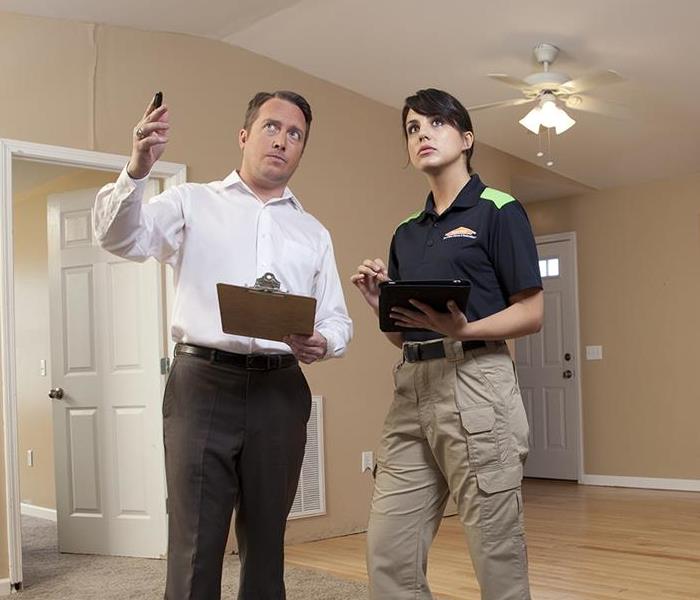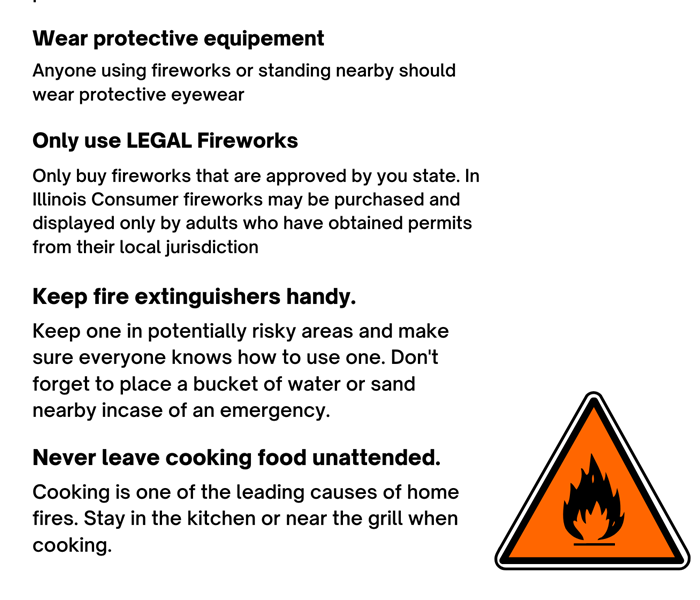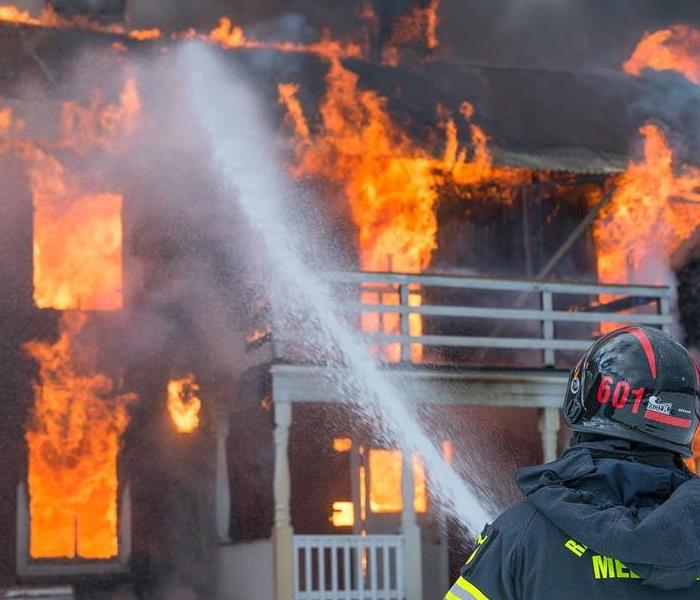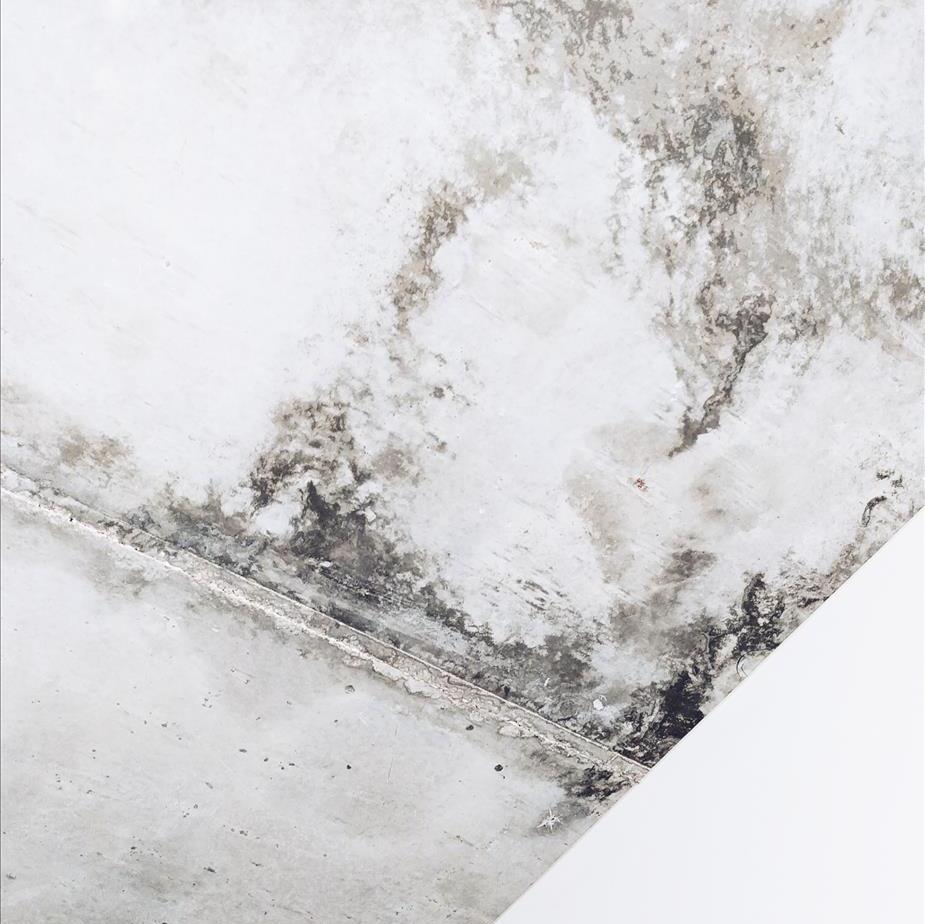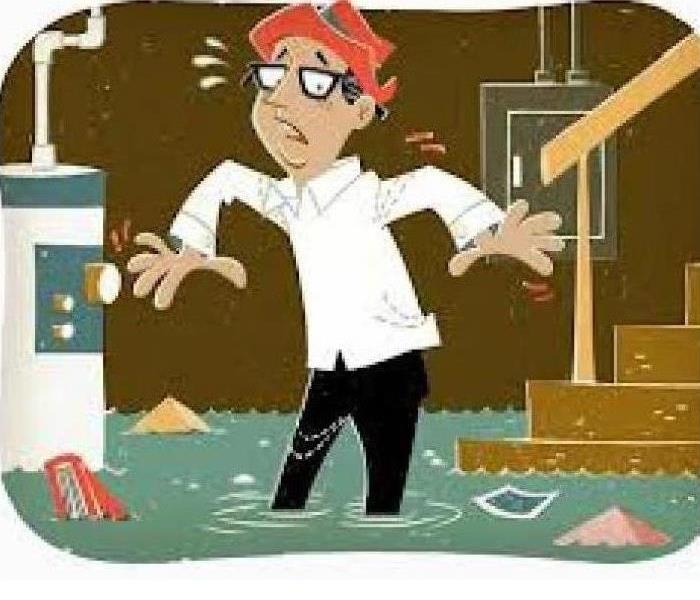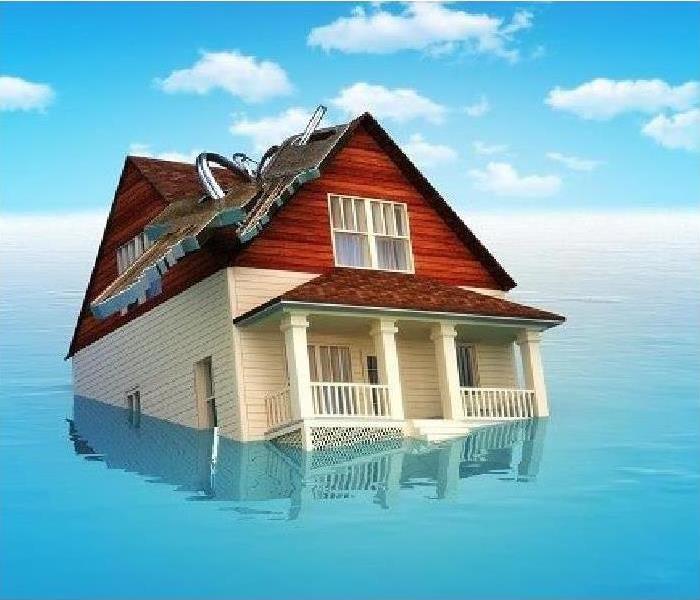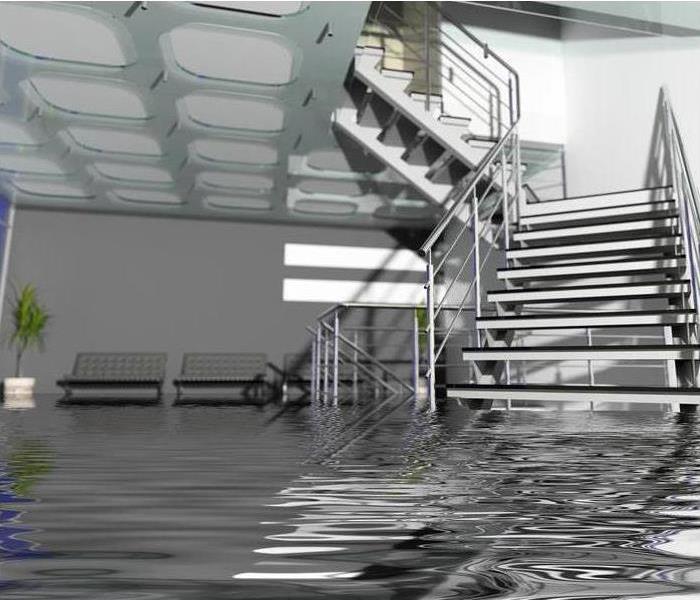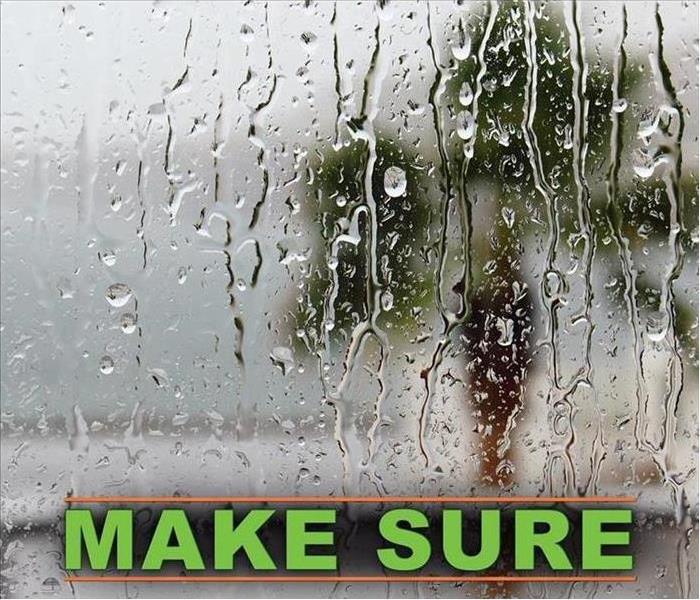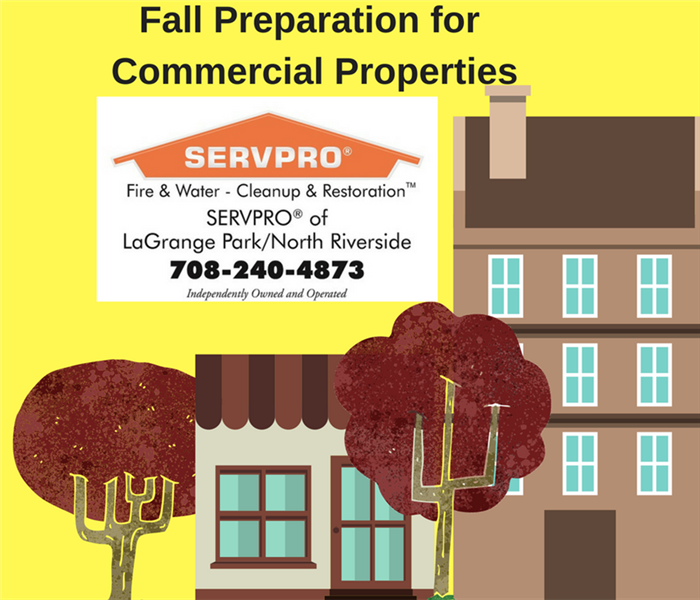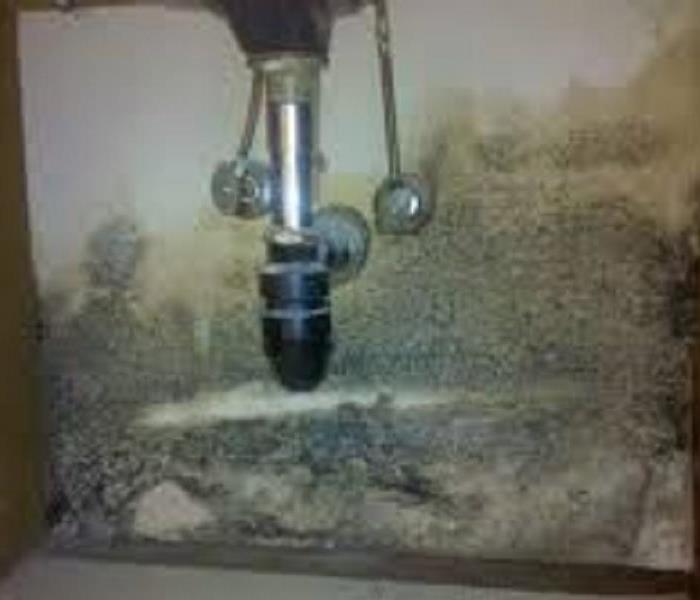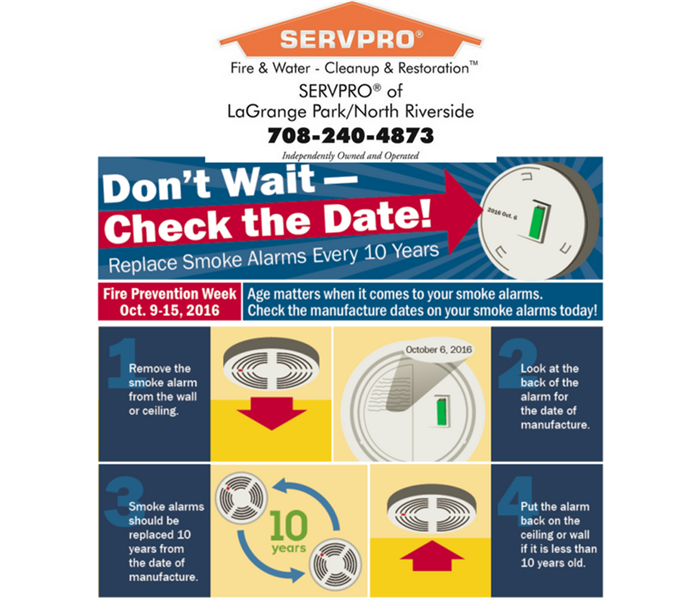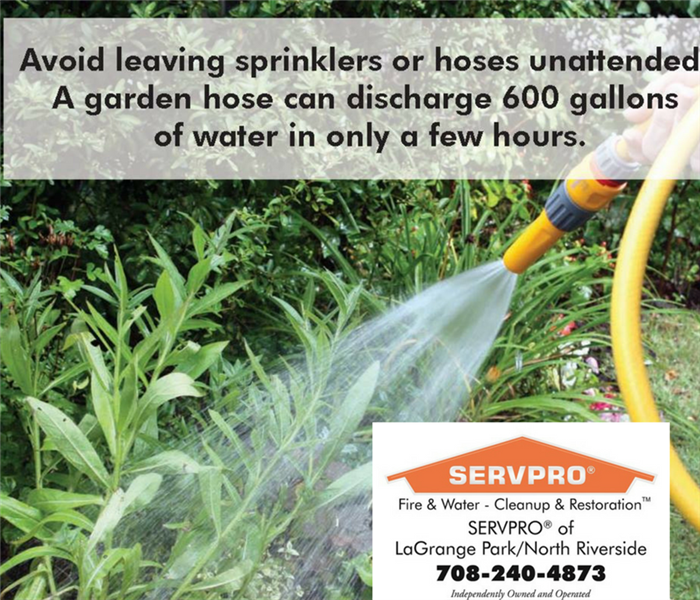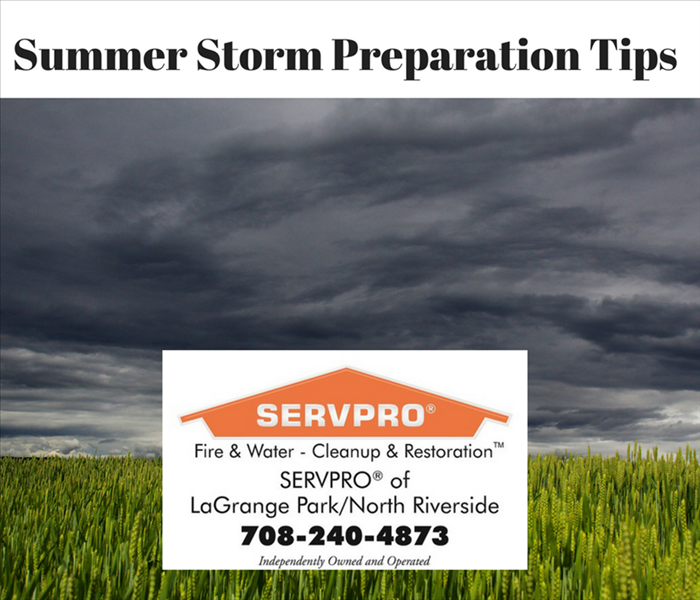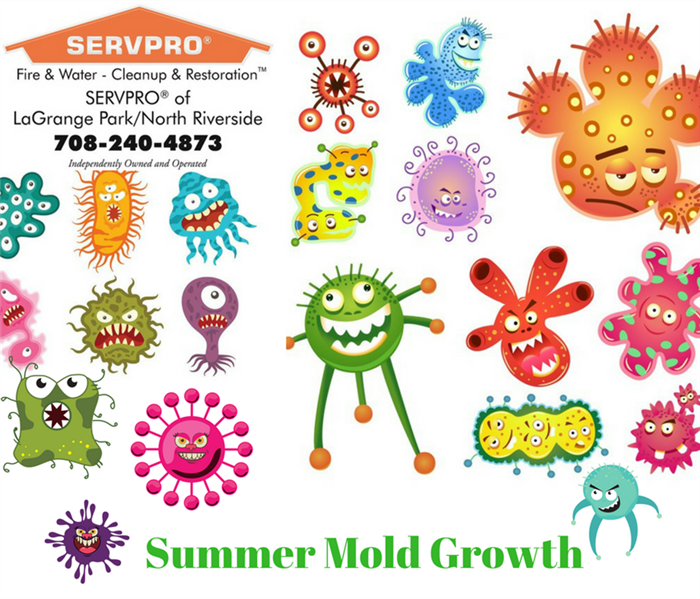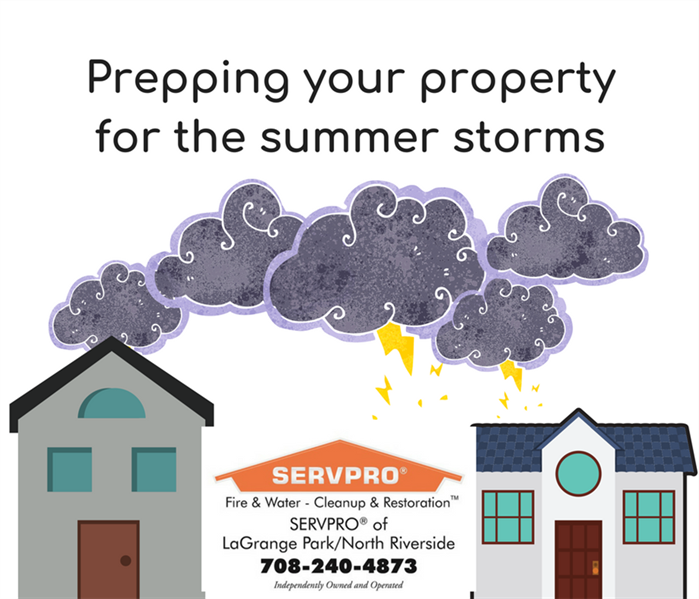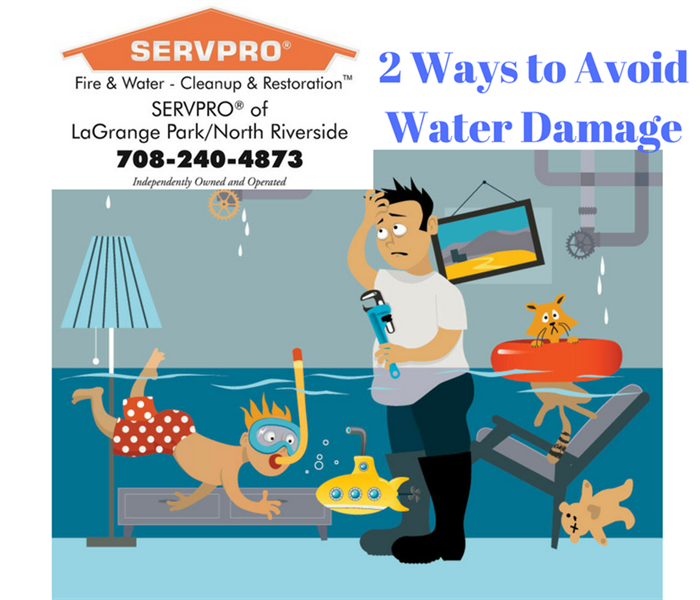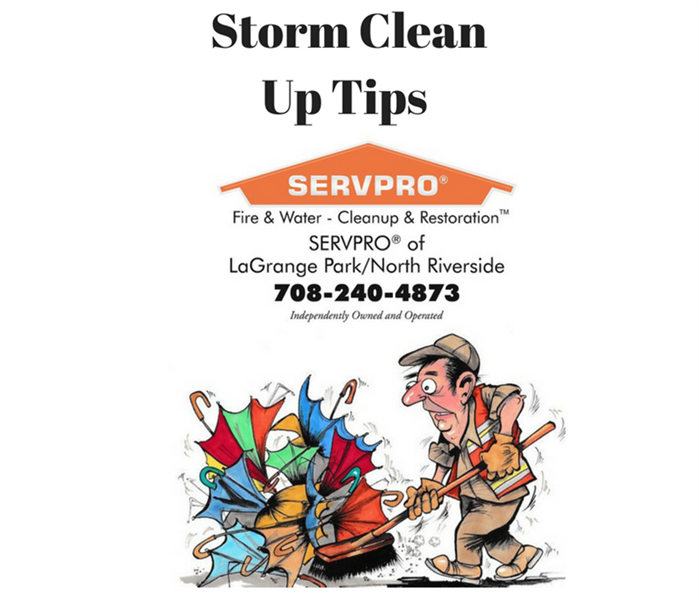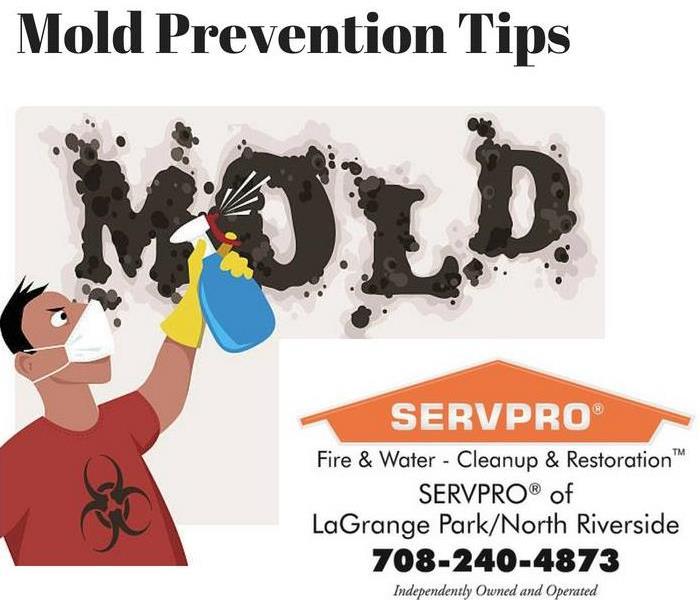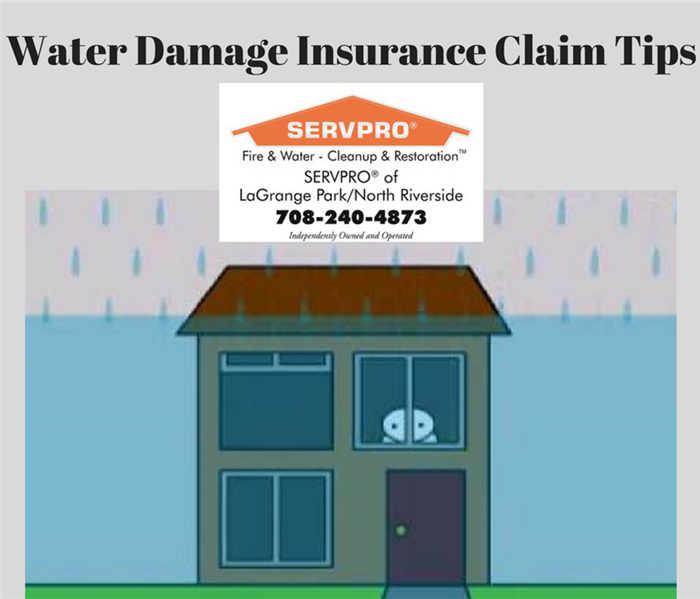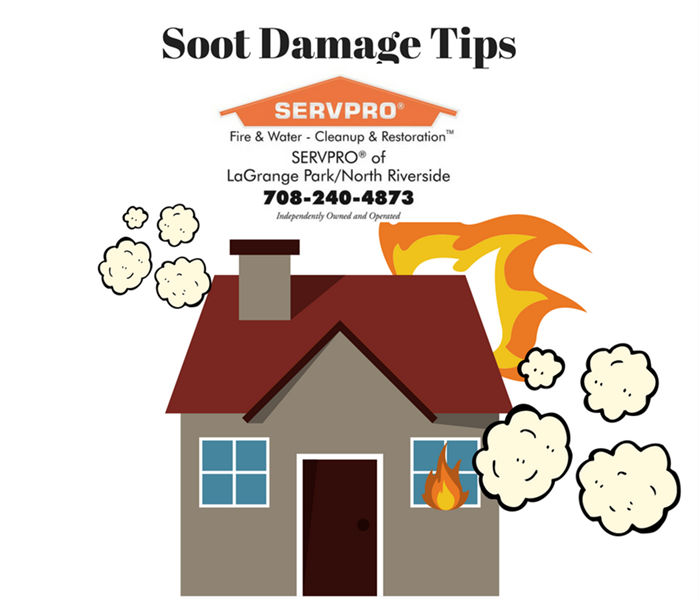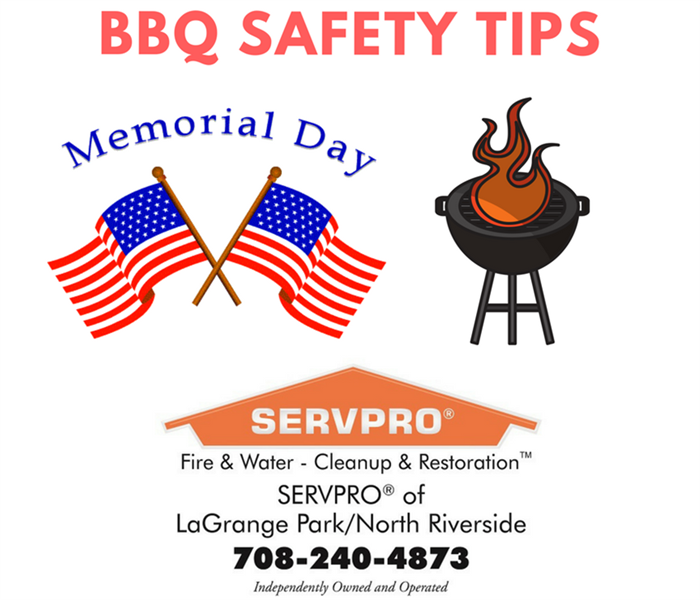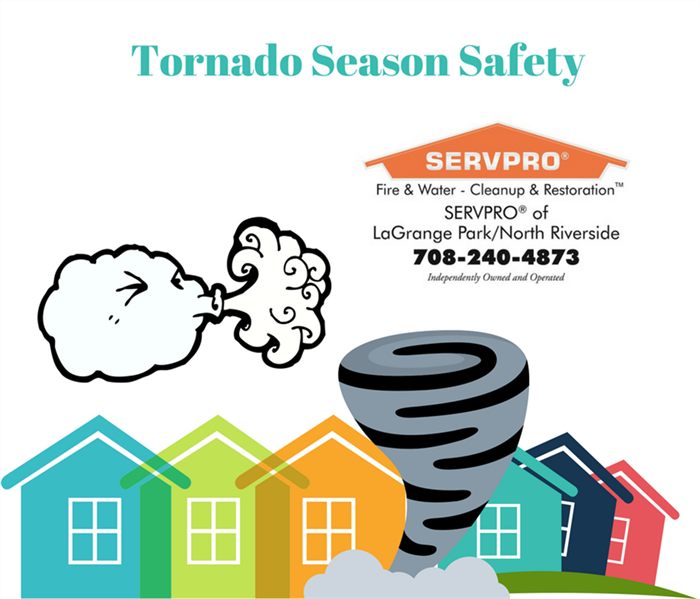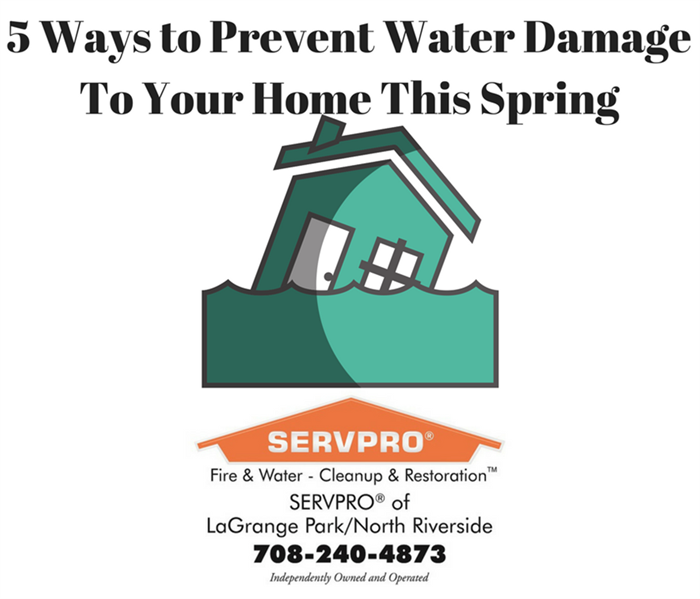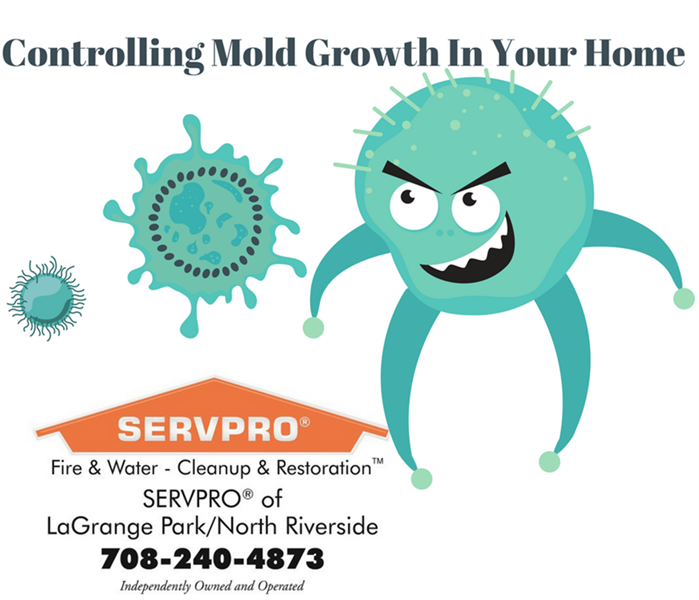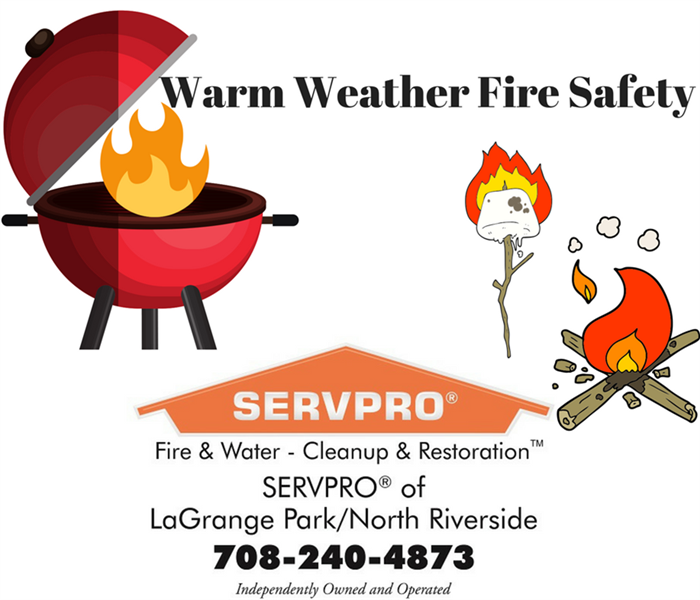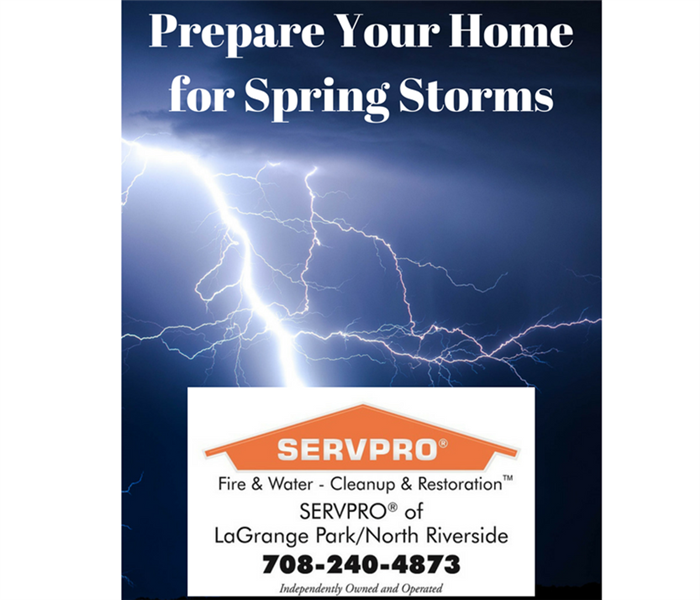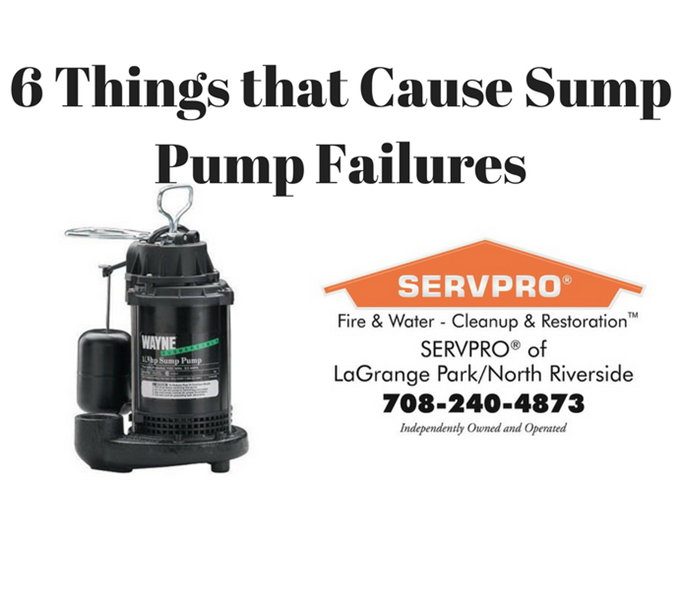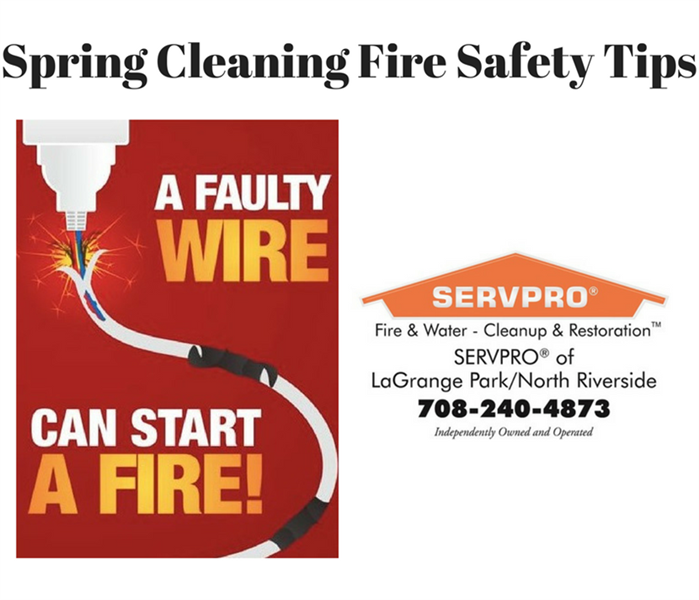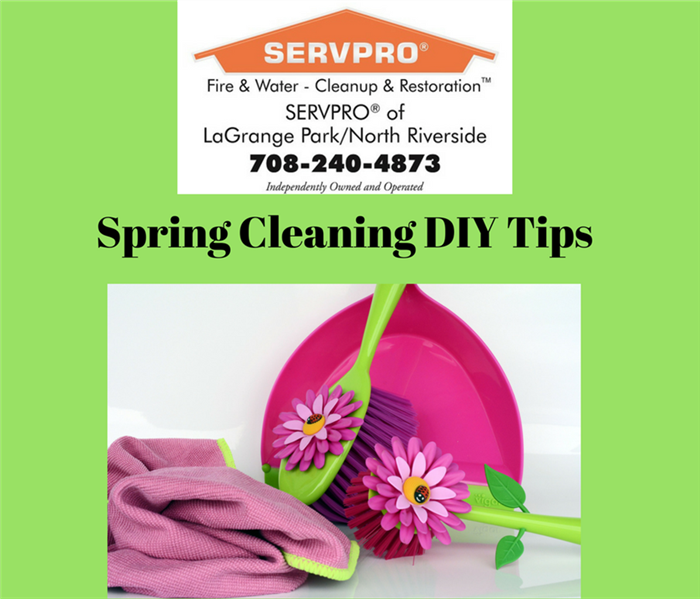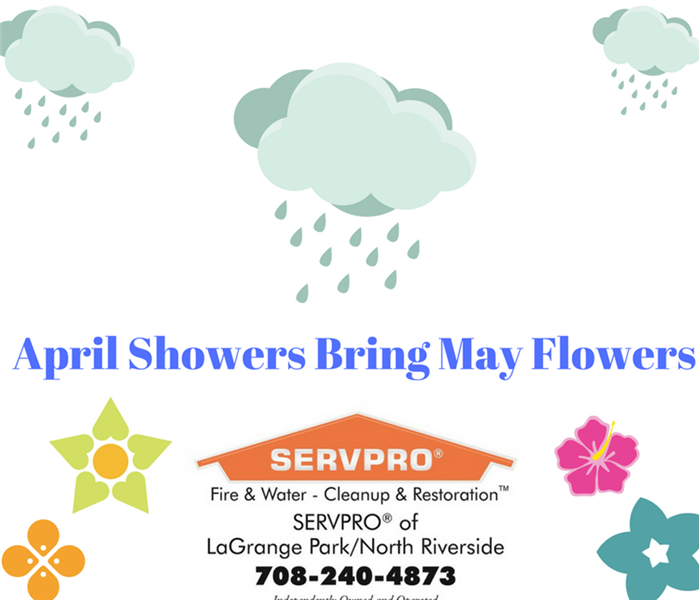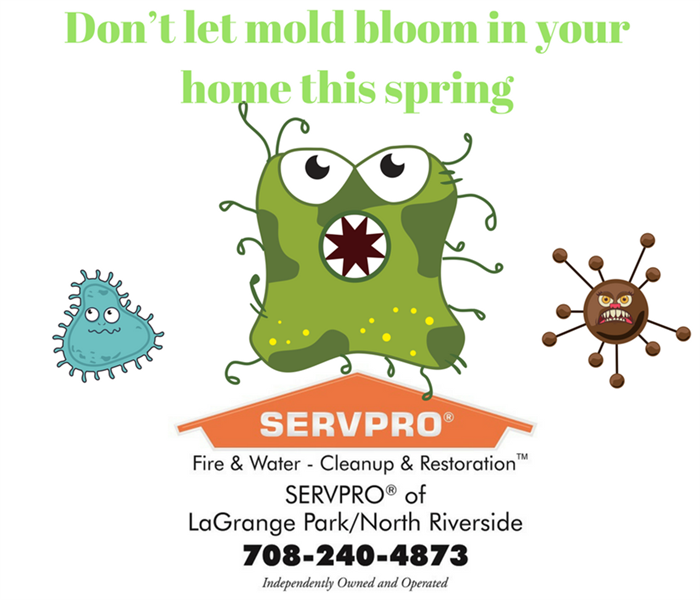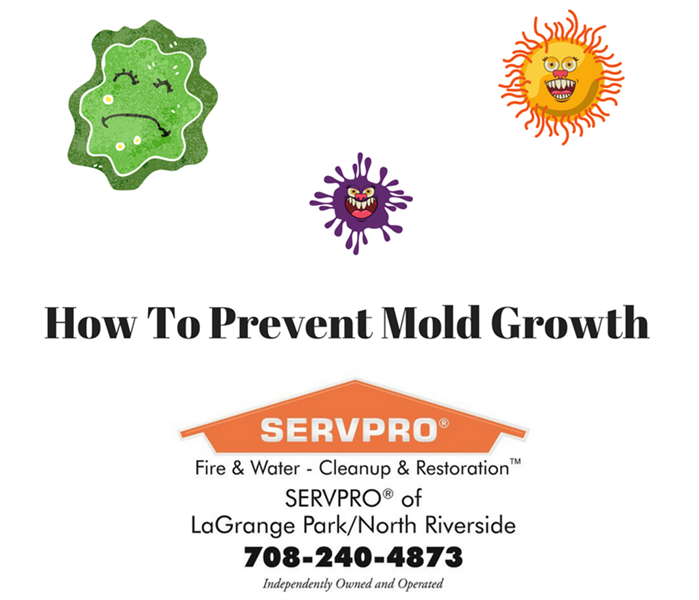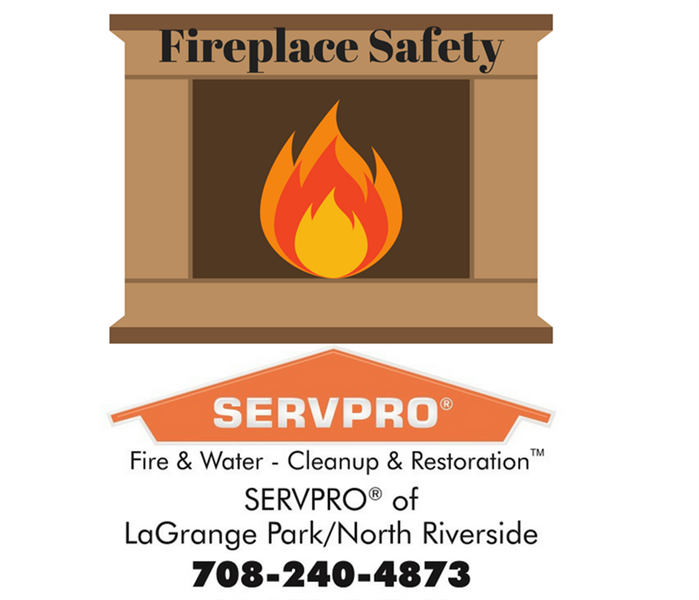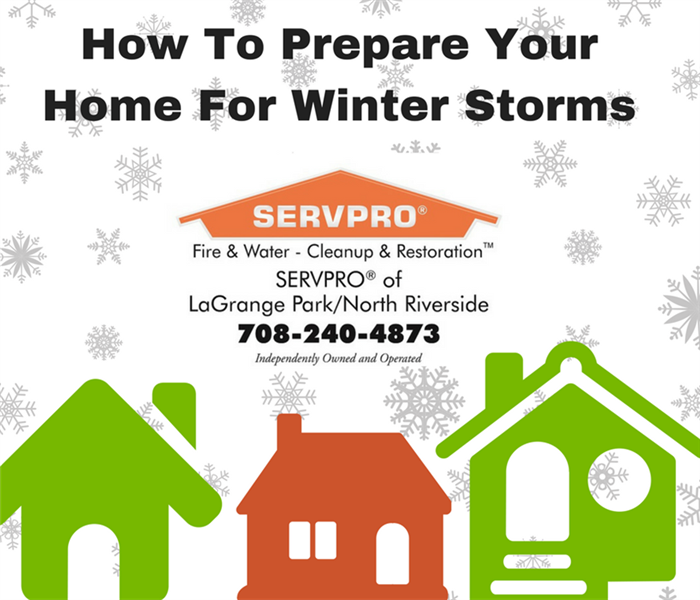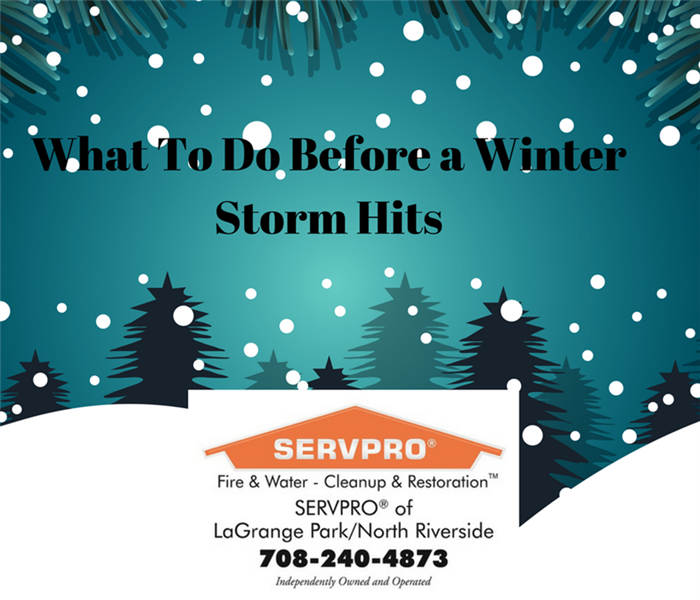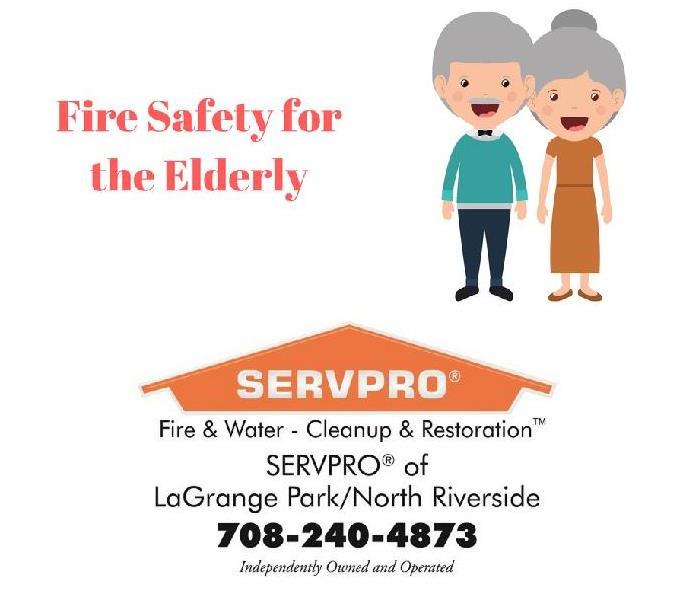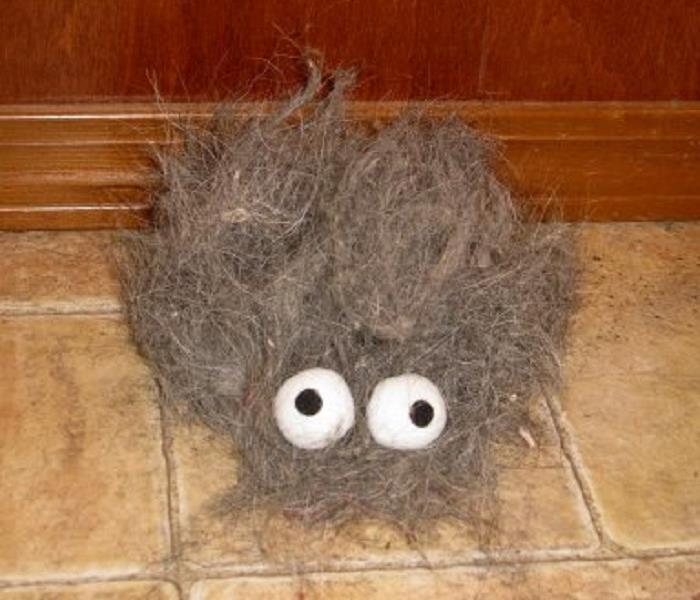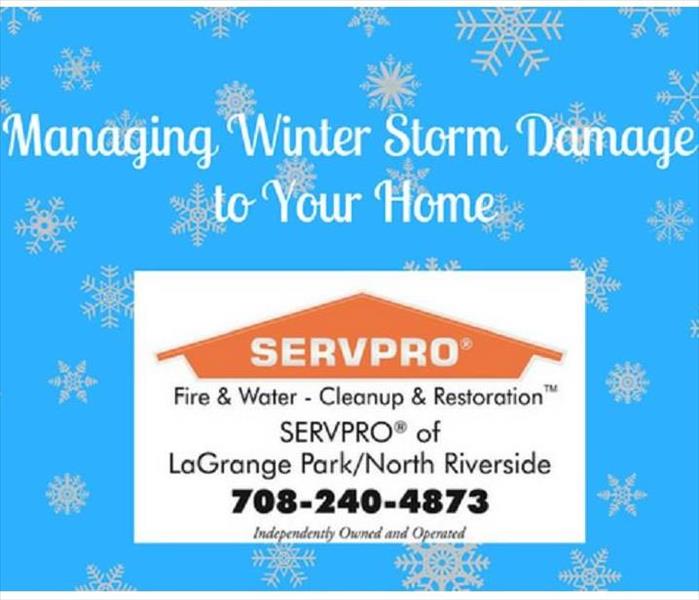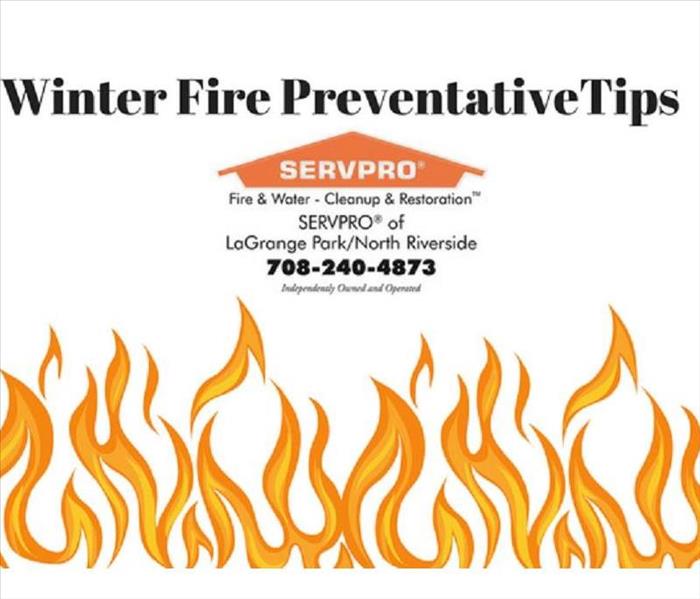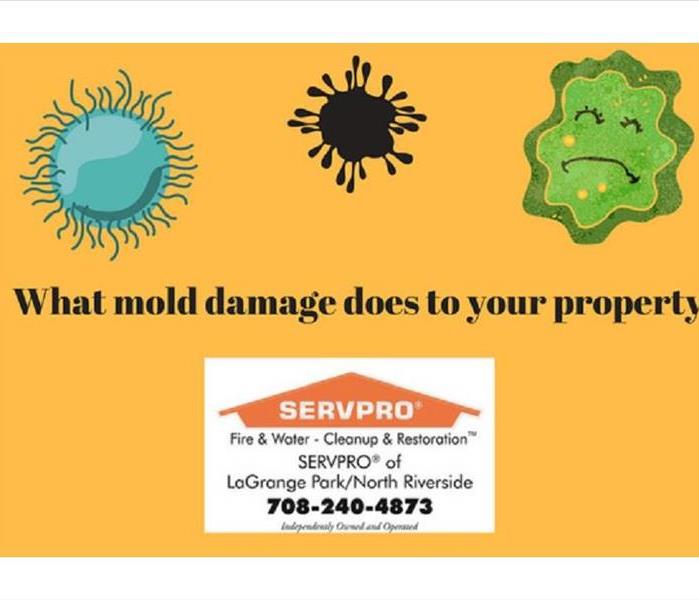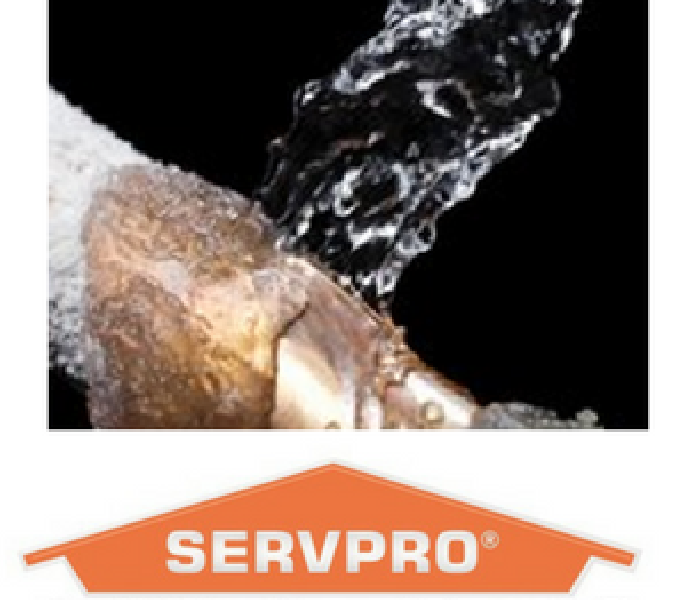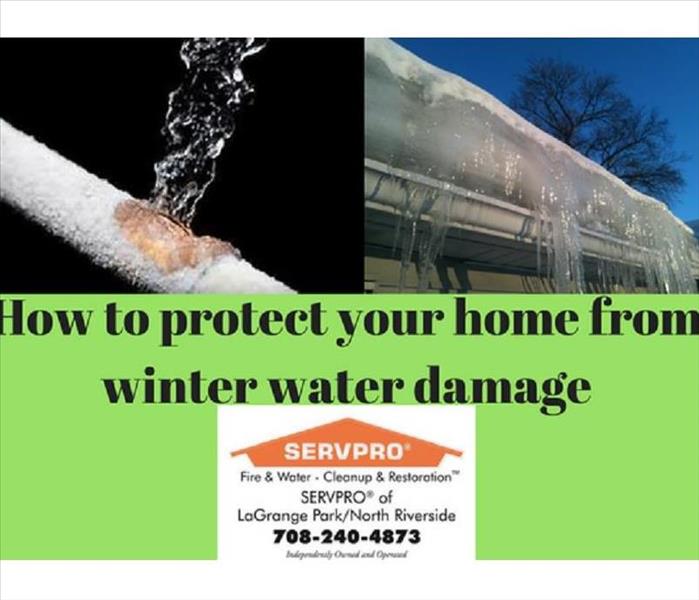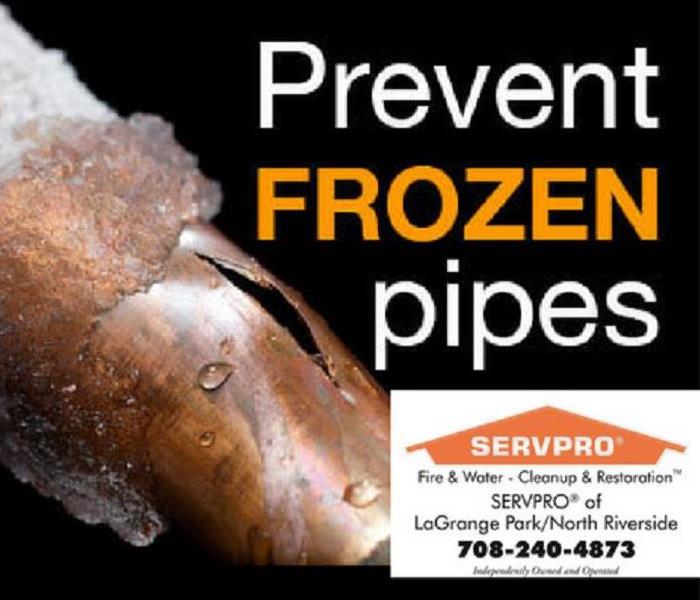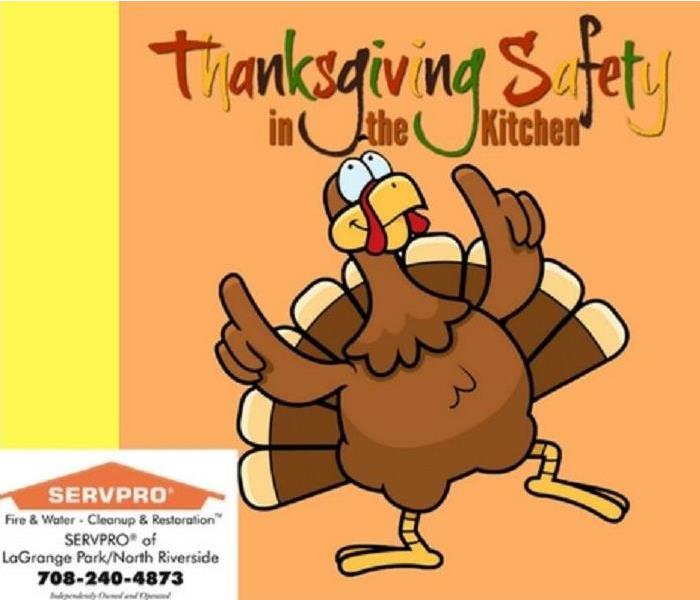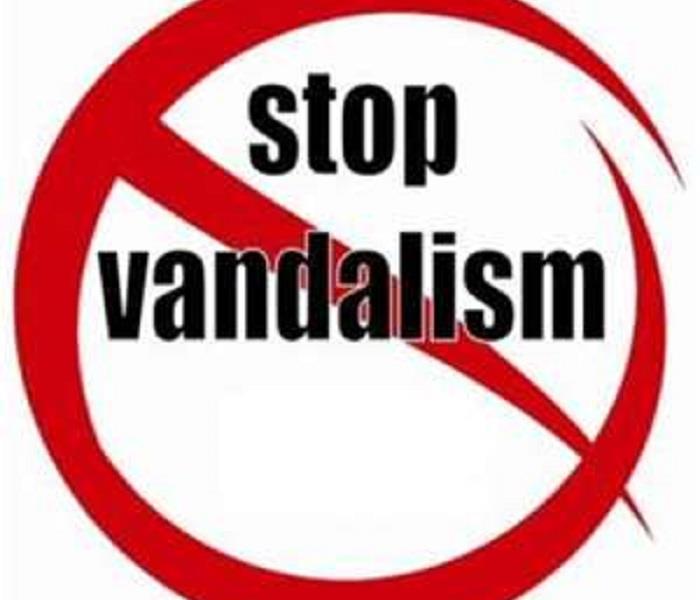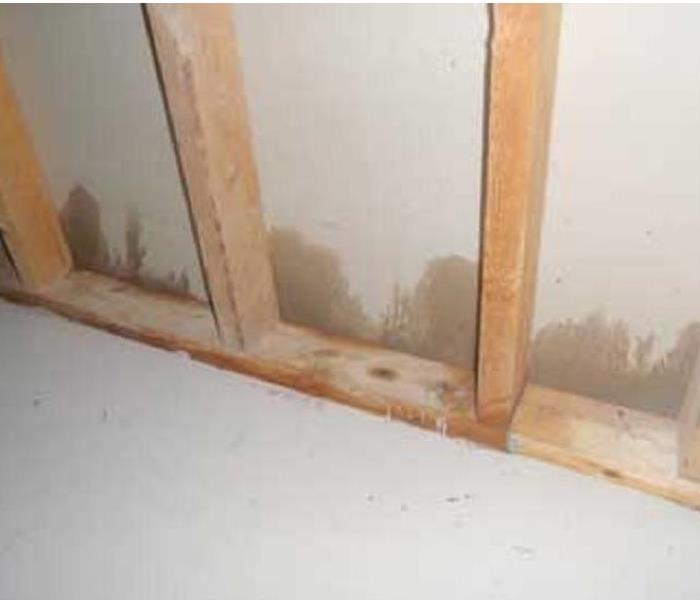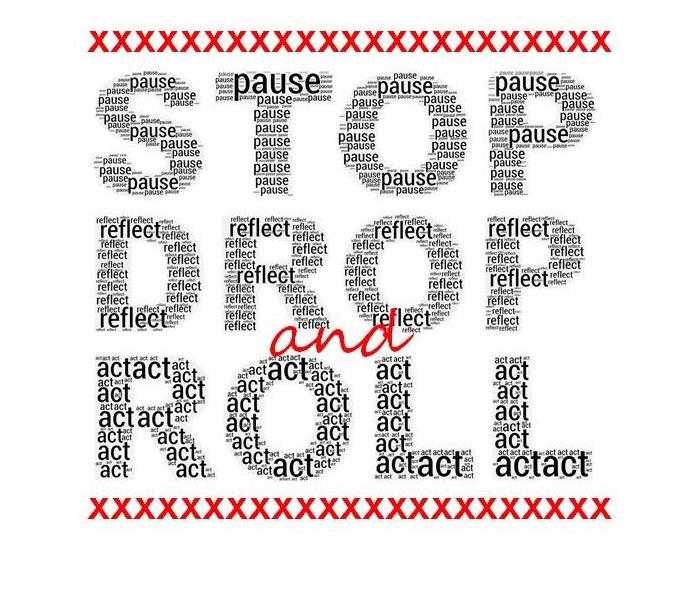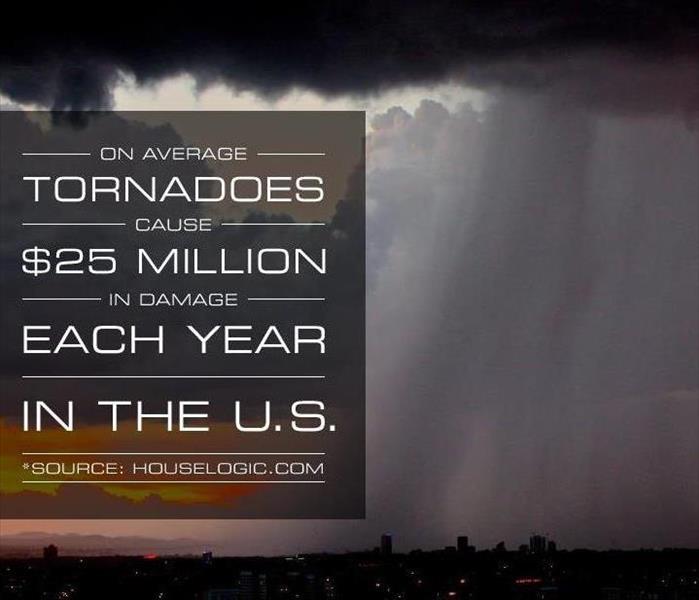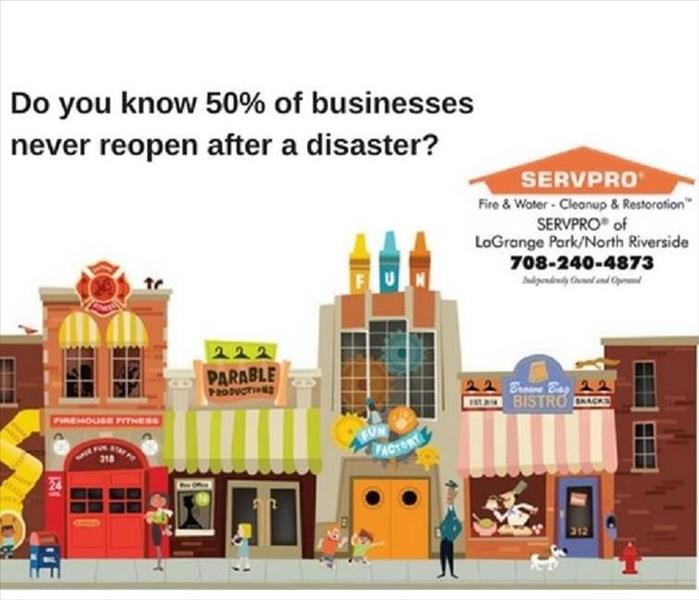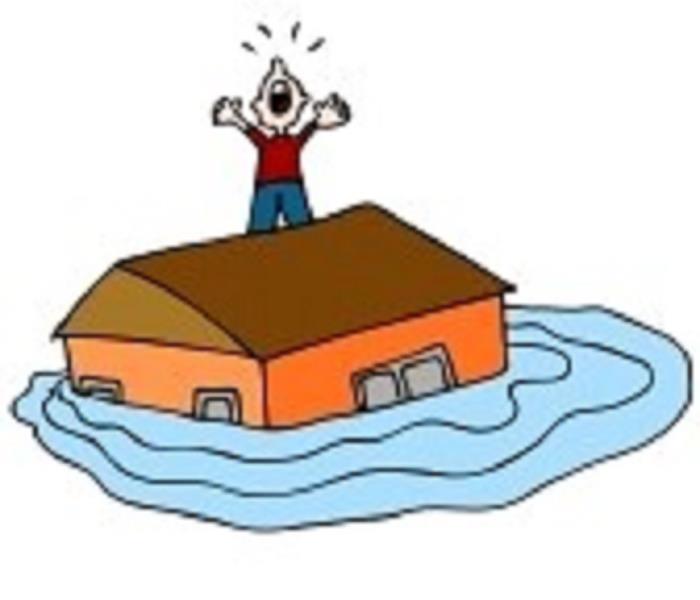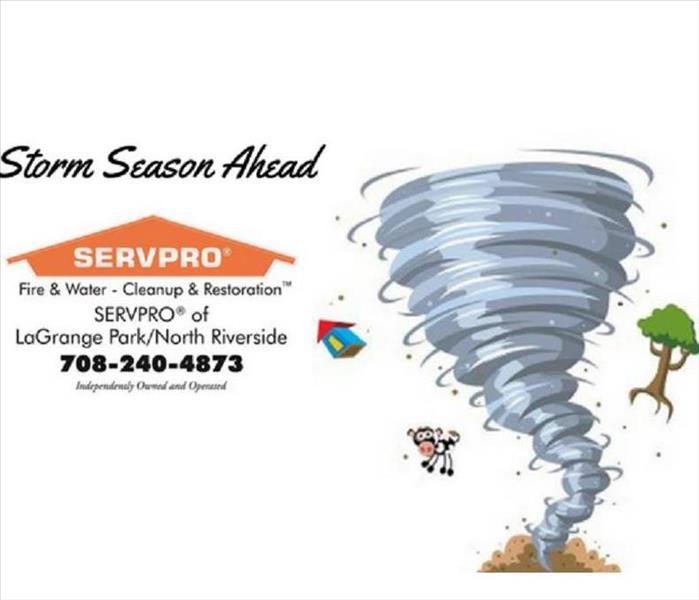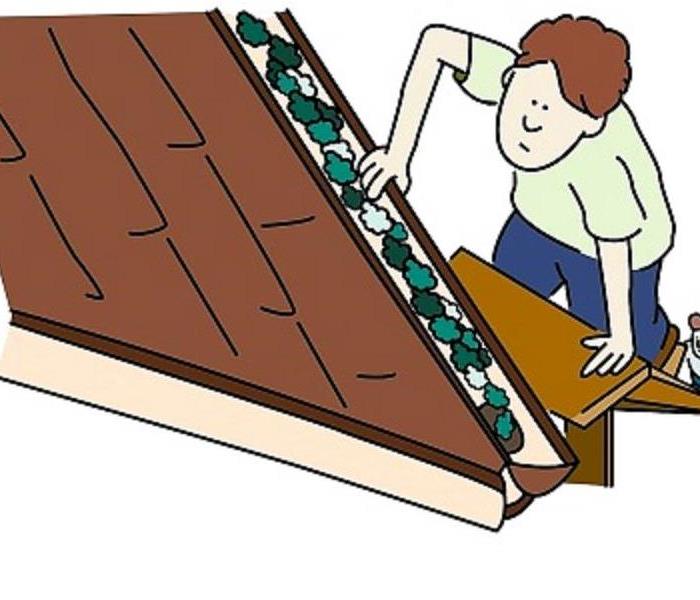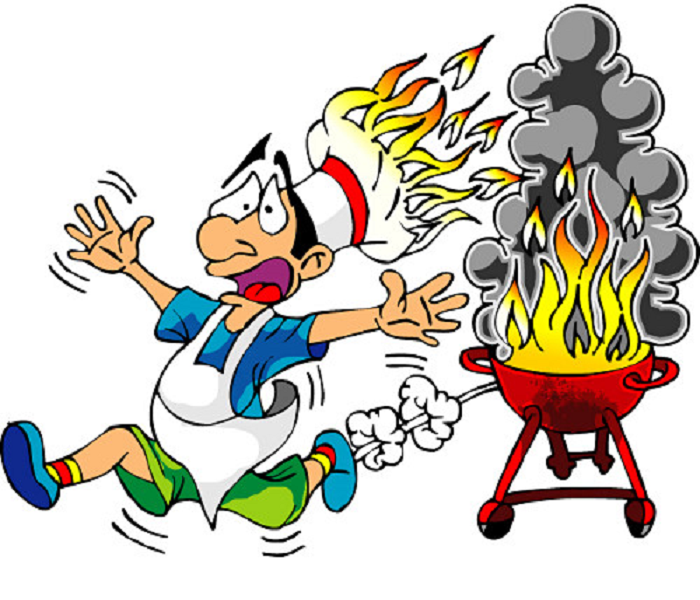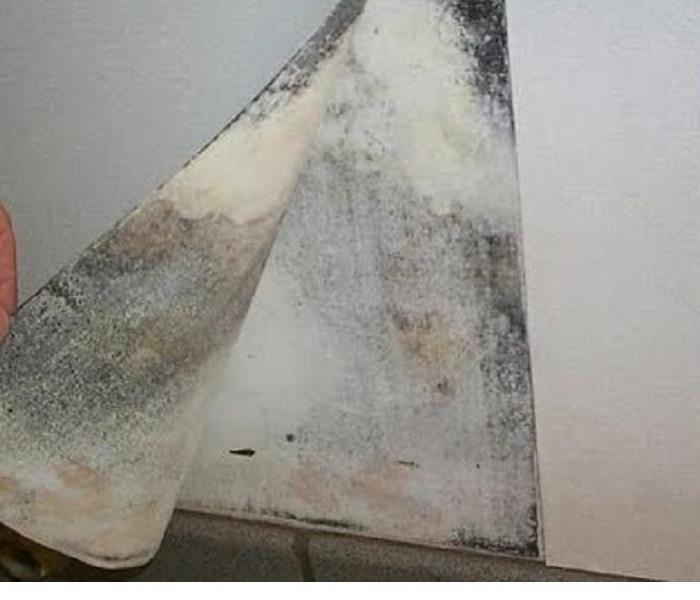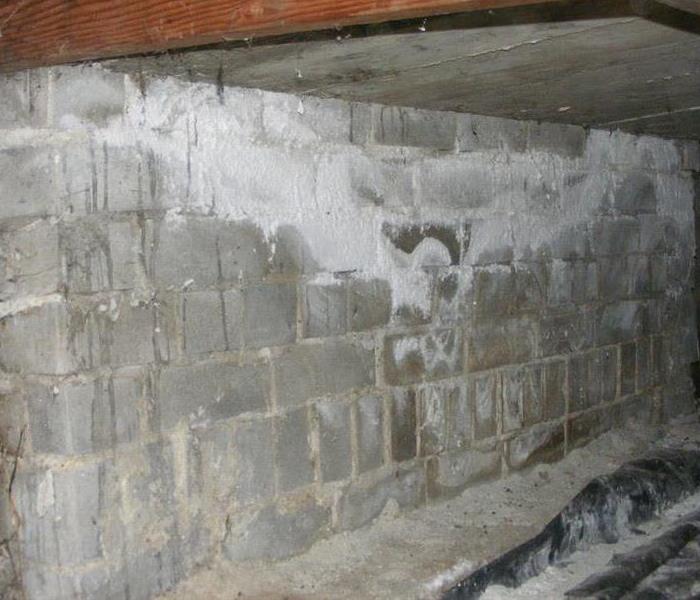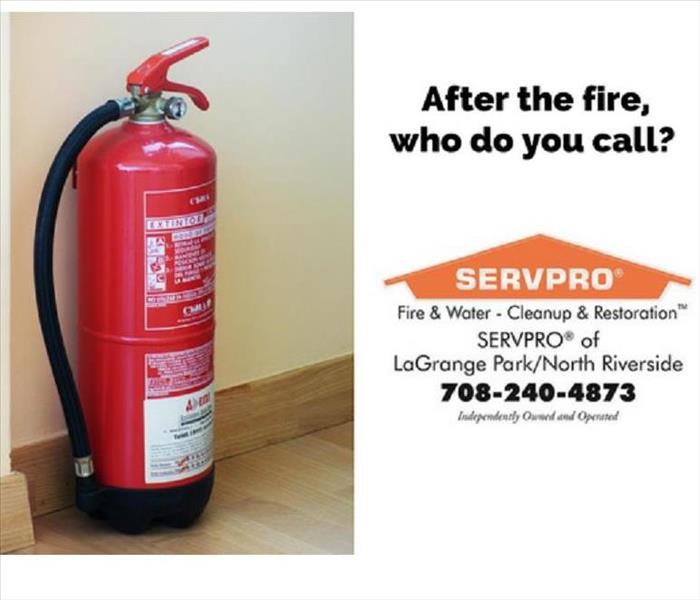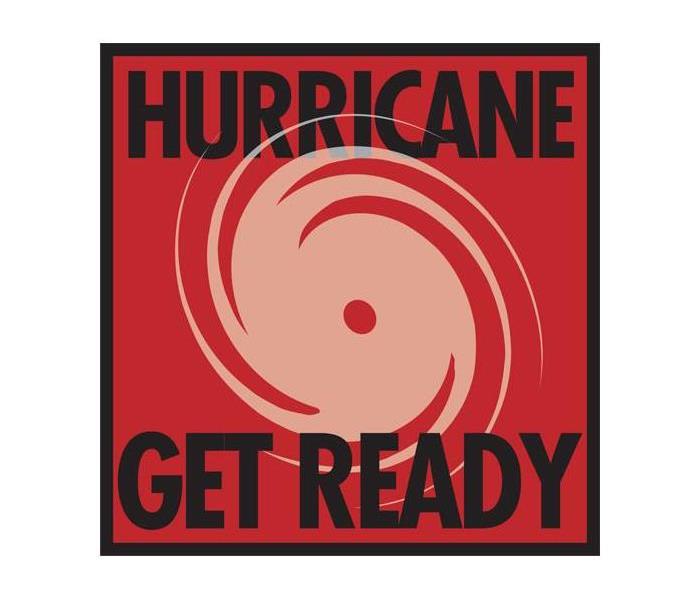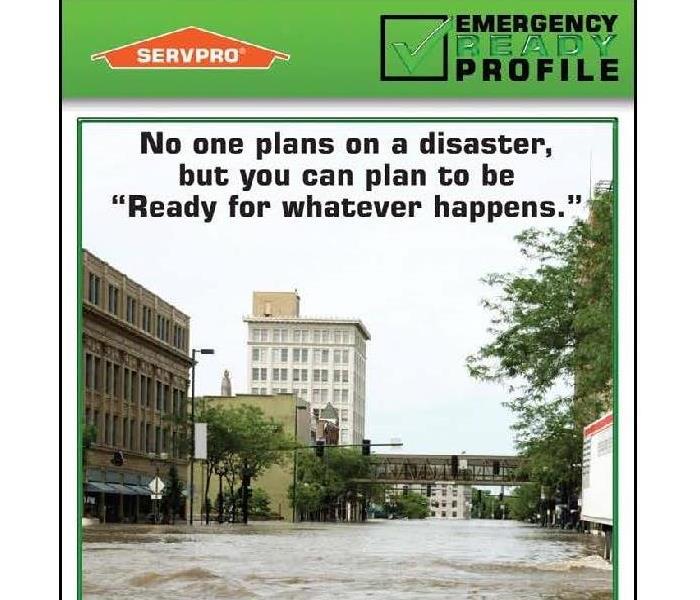Archived Blog Posts
Using your insurance in conjunction with SERVPRO
8/31/2022 (Permalink)
When a disaster strikes your property, it is important to know who to call! SERVPRO of La Grange Park / North Riverside, Arlington Heights/Prospect Height, and Elmhurst is highly trained and experienced in disaster restoration and cleanup. Our team is the trusted leader in the restoration and cleaning industry, and we offer a wide variety of services for your residential and commercial properties. Water damage, fire damage, and mold damage don't stand a chance against our team! Locally owned and operated, we are dedicated to being "Faster to any size disaster!" Available 24 hours a day, days a week for your emergency.
When you experience an unexpected disaster in your home, you may not know how to handle it. After the shock is over, your first thoughts are “what am I going to do?” and “How am I going to pay for this?”. These are two very common questions homeowners ask themselves given the high cost of repairing water, fire, mold or trauma damage. Good news for you, our team of professionals is here to help eliminate that concern.
Here at SERVPRO of La Grange Park / North Riverside, Arlington Heights/Prospect Height, and Elmhurst set ourselves apart from other restoration companies with our seamless design to work directly with most insurance companies while keeping property owners in the loop. Our dedicated team of professionals understands the insurance industry. From knowing how the claims process works, to getting your claim submitted and your repairs documented correctly. One major advantage we use is our advanced technology that allows us to perform very accurate estimates with detailed reports on replacements. Many of our team members have worked directly with insurance agents and adjusters.
As one of the largest restoration and damage remediation companies in the country, we work with hundreds of insurance companies to help our customers get their claims processed quickly and fairly. Many insurance companies know that SERVPRO handles losses professionally and often recommend us to their policyholders.
If you have any questions or are in need of emergency services, don't hesitate and give our SERVPRO of La Grange Park / North Riverside, Arlington Heights/Prospect Height, and Elmhurst team a call!
Podcast from the U.S. Fire Administration
8/23/2022 (Permalink)
Life is getting busier, the days are seemingly becoming shorter, and many Americans are struggling with time management. During times like these it may be more difficult to get your daily news. However, many are combating the concept of time with strategic planning and multitasking.
Many years ago during my studies as a marketer many marketing professionals noticed a decline in audio advertising. This decline had been made consistent and many advertisers began to look for other sources to market their products and services. Them the boom of Podcast begun. Podcast are extremely popular because of multiple reasons. The first being that podcast are readily available during anytime of the day.
No more struggling to get your daily fire prevention and safe new as The U.S Fire Administration releases its eight episode on https://www.usfa.fema.gov/podcasts/. The U.S. Fire Administration Podcasts are dedicated to getting the right message out to the folks on a time crunch. No more will you have have to struggle making it near a radio or television for important news on fire, emergency services and more. The U.S. Fire Administration Podcasts have audio as well as written versions of their podcast online and available at anytime. The podcast can be found at https://www.usfa.fema.gov/podcasts/ or on Apple Podcasts and Google Podcast apps and websites.
Central Illinois and surrounding areas are flooded by storms.
8/4/2022 (Permalink)
Severe storms have been traveling through Central Illinois and Missouri recking havoc on residents leaving hundreds homeless or displaced with flood damage. Historic rainfall began July 25th, 2022 shattering a the 100 year old record. Additional rain and isolated thunderstorms continue to threaten the St. Louis and central Illinois area. Mayor Tishaura Jones declared the city in a state of emergency which should help gain resources the city needs for recovery.
These severe storms and rainfall cause a significant amount of property damage. Luckily, However SERVPRO is on the case. There have been over 30 franchises and 90 crews dispatched on-site in the Illinois and Missouri areas. SERVPRO franchises have traveled from as far a 7-8 hours gaining help from surrounding midwestern franchises. We are all-hands-on-deck in helping the over 2000 new calls for help.
Our highly trained Disaster Recovery Team specializes in property damage restoration, water damage restoration and fire damage restoration. Our team utilizes advanced technologies alongside The Institute of Inspection’s cleaning and restoration industry standards to provide exceptional service. We believe in continuous training from initial and on-going training at SERVPRO’s corporate training facility to regular IICRC industry certifications. Rest assured our staff is equipped for any of your clean-up, restoration, and construction needs.
References:
Woytus, A. (2022, July 26). Historic rainfall in St. Louis shatters 100-year-old record. St. Louis Magazine. Retrieved August 4, 2022, from https://www.stlmag.com/news/historic-rainfall-st-louis-floods/
Hays, G. (2022, July 28). Historic rainfall in St. Louis raises questions about flooding and climate change. PBS NewsHour. Retrieved April 8, 2022, from https://www.pbs.org/newshour/nation/historic-rainfall-in-st-louis-raises-questions-about-flooding-and-climate-change
Are Your Ducts Dirty?
7/14/2022 (Permalink)
Air/ HVAC ducts are essential for the circulation of your home or commercial property. Your heating and cooling system utilizes your ducts to maintain temperature throughout the property. Air is circulated through the ducts multiple time a day reaching every room with the same air. This is a integral part of your properties air quality. Did you know that your ventilation system is often the biggest culprit in poor indoor air quality? Dirty Ducts can circulate odors, contaminants such as mold, and irritating dust throughout your location.
A professional commercial duct cleaning company can reach, clean, and sanitize all the components of your duct system. Homeowners should be aware of a few things in the HVAC and air duct cleaning process. First, system access to the duct interiors should be made through existing openings when possible. This could be via return grills, duct end caps and existing service openings. Your technician will often begin by breaking contaminants loose from your system, either by hand or using a vacuum, to agitate dirt and dust. This basic step is an important one in the HVAC cleaning process.
The process begins by using patented equipment, including a roto-scraper, which automatically adapts to the duct's shape and diameter while traveling through the duct, removing debris and filth before the vacuuming begins. Next, a powerful push-pull air delivery and collection system transfers the debris from the ductwork to a container. Air is filtered through a HEPA filtration system, removing 99.97% of the particles in the airstream. Filters will either be cleaned or replaced to remove odor and dirt.
Illinois Chicagoland Areas are under danger from extreme heat and severe weather storms!
7/5/2022 (Permalink)
ABC 7 Chicago reports Tuesday morning residents are left without power as strong storms moved throughout the region. Winnebago, Lake, Cook County, and more are on high alert for storms that could produce damaging winds at up to 70 miles per hour.
This comes only weeks after a damaging supercell swept throughout northeast Illinois and northwest Indiana. The June 13th storm produced strong winds reaching up to 84mph and hundreds of trees being uprooted, downed, or damaged. Bellwood and Broadview experienced some of the most damaging effects of the storms. Many were left without power as a heatwave as Broadview and Bellwood join Westchester in declaring the villages in a local state of emergency. As SERVPRO launched into our communities to provide assistance to those in need we learned quite a bit of information to help you prepare for a natural disaster. So here are some tips and tricks to help you prepare for a rise in temperatures.
Stay hydrated. You don’t need to wait until you’re thirsty to drink. Sipping water throughout a hot day can help you remain hydrated and keep fluids high
Dress for the weather. Wearing light, loose-fitting clothing can ensure your body is able to breathe and allow a cool breeze to lower your body/skin temperature.
Staying inside. Remain in a cool or air-conditions environment. During the following days of the Illinois supercell, many villages opened cooling stations and busses. Those who lost power during the supercell were able to stay cool while the city worked to restore power to homes.
References:
Earnest, A. (2022, July 5). Dangerous Heat, Storms Before 'Pneumonia Front' In Illinois. Across Illinois, IL Patch. Retrieved July 5, 2022, from https://patch.com/illinois/across-il/dangerous-heat-storms-pneumonia-front-illinois
Team, A. C. D. (2022, July 5). Chicago weather forecast includes extreme heat after thunderstorms knock out power for thousands. ABC7 Chicago. Retrieved July 5, 2022, from https://abc7chicago.com/chicago-weather-forecast-tornado-warning-thunderstorm/12020208/
Celebration of the Fourth of July holiday and safety
7/1/2022 (Permalink)
As the 2022 Independence day weekend begins many Americans are setting up plans for barbeques / Cook outs, festivals and Fireworks.
Did you know that different states have different laws on the sales, operation and even possession f fireworks? Illinois has one of the more strict laws on fireworks as opposed to our neighboring states.
So here's what you need to know before planning your 4th of July firework show.
There is nothing like firing up the grill during the summer months! Did you know, July is the peak month for grill fires? A backyard barbecue can become dangerous quickly if proper safety precautions aren't considered. Your local SERVPRO franchise professionals want you to have an enjoyable and safe summer. Consider the following tips to help ensure your summer celebrations are disaster-free.
- Propane and charcoal barbecue grills should only be used outdoors.
- The grill should be placed well away from the home, deck railings, and out from under eaves and overhanging branches.
- Keep children and pets away from the grill area.
- Keep your grill clean by removing grease or fat buildup from the grill and in trays below the grill.
- Never leave your grill unattended.
- When using a charcoal grill, let the coals completely cool before disposing in a metal container.
- Anyone using fireworks or standing nearby should wear protective eyewear.
- Do not try to re-light or handle malfunctioning fireworks. Keep a bucket of water nearby to fully extinguish fireworks that don't go off or in case of fire. Children should never pick-up fireworks that may be left over as they may still be active.
The safest way to enjoy fireworks is to attend a public display conducted by trained professionals. If your residential or commercial property suffers from structural fire damage, call your local SERVPRO franchise professionals to help make it "Like it never even happened."
Residents of Illinois are in a state of emergency as a result of the supercell storm as they battle storm damage, flooding, and dangerous heat waves.
6/17/2022 (Permalink)
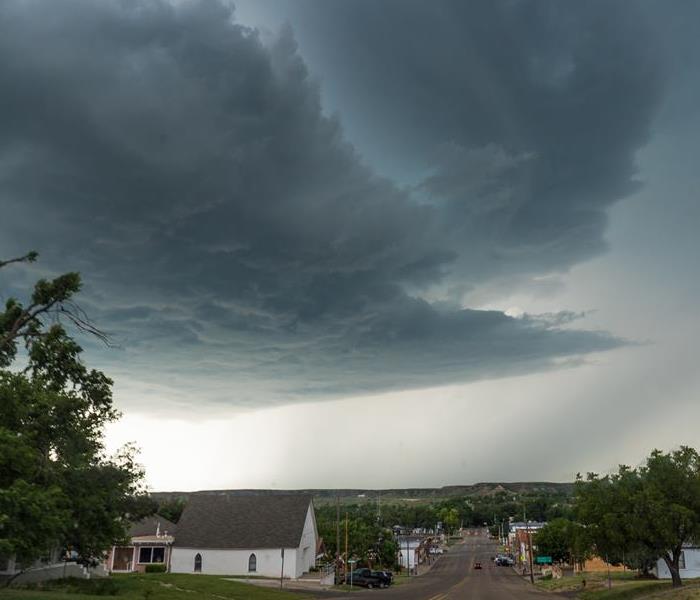 Photo of Supercell
Photo of Supercell
The streets of Broadview and neighboring areas are littered with debris, branches, and uprooted trees. Monday’s supercell storm rampaged throughout Illinois suburban area’s, leaving residents to battle dangerous heat levels without power. As temperatures increase Cooling stations are placed through the area as ComEd rushes to restore power powerlines destroyed by downed trees during the storm.
Mayor Katrina Thompson and Mayor Andre F. Harvey declare a local state of emergency for Broadview and Bellwood. Public works and contractor crews are addressing the debris, branches and uprooted trees caused by the storm. However, as stated by Mayor Katrina Thompson “Clean-up is going to be expensive for residents, businesses, and the Village of Broadview alike, so the official emergency declaration will make our community eligible for financial assistance to aid our recovery.” As volunteers of Home Depot, Cook County Government, and ComEd worked together to clear up the debris the mayor lifts permits for roofs, fences, and tree removal.
Outages also extend to La Grange Park where tension continues to grow between the La grange Country Club and the village officials. Last year after only a couple of being in office former Village Board Trustee Mikes Matteucci resigned due to this conflict of interest as a member of the country club. Many attempts from the village officials have seemed to fall on deaf ears such as the Village Board Meeting invitation to discuss stormwater issuing in which the Club did not participate. All while the trial to settle disputes between La Grange and a nearby quarry have been delayed. The trial set for July 18th has been pushed back to September 19th possibly to give time for the Hanson Aggregates quarry to implement its expert’s recommendations to expand its drainage ponds. It is said that this dispute derives from the Quarry cutting a drainage pipe three decades ago.
Let’s all continue to hope that the village and its residents reach some sort of resolution as flooding continues to become a growing problem. These are our neighborhoods so let’s put our heads together to find the best outlook for our towns and villages.
Sources:
Rezaei, A., & Barack, M. (2022, June 16). Residents in suburban Broadview battle dangerous heat; still without power following Monday’s storms. CBS News. Retrieved June 17, 2022, from https://www.cbsnews.com/chicago/news/suburban-broadview-heat-still-without-power/
Giuliani, D. (2022, June 15). Country Club Confuses La Grange On Flooding: Official. La Grange, IL Patch. Retrieved June 17, 2022, from https://patch.com/illinois/lagrange/country-club-confuses-la-grange-flooding-official
Giuliani, D. (2022b, June 15). Outages Remain In La Grange Park: Village. La Grange, IL Patch. Retrieved June 17, 2022, from https://patch.com/illinois/lagrange/outages-remain-la-grange-park-village
Giuliani, D. (2022a, June 14). La Grange Flooding Trial Delayed 2 Months. La Grange, IL Patch. Retrieved June 17, 2022, from https://patch.com/illinois/lagrange/la-grange-flooding-trial-delayed-2-months
Conditions of Extreme Weather
5/23/2022 (Permalink)
Severe weather forecasts are expected for the next couple of days in Texas, and Oklahoma, and will stretch to the southeast and possibly the upper Midwest area. Rain and flash flooding will be a strong concern. Major moisture coming from the Golf will make for heavy downpours of rain. This comes with good concern after pre-monsoon deluges have flooded parts of India and Bangladesh killing two dozen people and leaving about 90,000 others homeless. the Indian Army and Air Force have evacuated thousands in the past 2 weeks across the border in Bangladesh officials said at least 3 rivers are in danger of overflowing crop fields have been damaged and hundreds of villages are without clean water supply as flooding overtopped wells and damage supplies extreme weather events are becoming more common in South Asia due to climate change this bout of heavy rain is happening early monsoon season usually does not start until early June in the region. SERVPRO of La Grange Park is able to, upon request, service the Chicago metropolitan area in northeastern Illinois, including Chicago and its surrounding suburbs. So for your flooding and water damage concerns please contact SERVPRO of La Grange Park.
The Associated Press. (2022, May 23). Heavy rain floods parts of India, Bangladesh. ABC News. Retrieved May 23, 2022, from https://abcnews.go.com/International/wireStory/deluges-rain-flood-parts-india-bangladesh-84904733
Davis, D. D. (2022, May 23). Dozens Killed, Thousands Displaced in India and Bangladesh Flooding - Videos from The Weather Channel | weather.com. The Weather Channel. Retrieved May 23, 2022, from https://weather.com/news/weather/video/dozens-killed-thousands-displaced-in-india-and-bangladesh-flooding
International Building Safety Month.
5/3/2022 (Permalink)
May is International Building Safety Month. This campaign raises awareness about building safety and reinforces the need for the adoption of modern, regularly updated building codes, and helps individuals, families, and businesses understand how to maintain safe and sustainable structures.
Communities need protection from disasters like fires, weather-related events such as flooding and structural collapse. The best way to do this is by implementing Model building codes, adopted and enforced by well-trained professional code officials.
This year’s theme is safety for all building codes in action. Regularly updated codes and a strong system of strict code enforcement ensures that individuals and communities are safe in the buildings where they live, work, and play. This campaign is supported by four core themes that will be highlighted throughout the month:
Week 1: Planning for a Safe & Sustainable Tomorrow
Week 2: Exploring Careers in Building Safety
Week 3: Understanding Disaster Mitigation
Week 4: Creating a Safe & Abundant Water Supply
To learn more about the weekly themes, check out iccsafe.org. You can help spread the word about Building Safety Month, the importance of building safety, and the role of code officials with your community! Use the hashtag #BuildingSafety365 to join the global conversation on social media. As always, if your residential or commercial property suffers from structural damage, call your local SERVPRO franchise professionals to help make it "Like it never even happened.®"
The Standards for The Restoration Industry
4/7/2022 (Permalink)
SERVPRO of LaGrange Park/North Riverside is an IICRC firm. The Institute of Inspection, Cleaning and Restoration Certification (IICRC) creates the standards for the restoration industry and provides training and certification to restoration companies. IICRC Certified Firms have the right to display the IICRC Certified Logo.
IICRC Certified Firms must
Present accurate information to consumers and conduct business with honesty and integrity.
Require a technician on all jobs who has been formally trained and passed all required tests.
Require a continuing education program to keep technicians up to date on the latest changes in the industry.
Maintain liability insurance to protect all parties in the event of an accident.
Maintain a written complaint policy and agree with the Better Business Bureau or similar arbitration to resolve disputes, and accept the conclusions and recommendations of arbitration.
The IICRC Develops the Standards for The Restoration Industry
The IICRC has been the driving force in establishing the main industry standards and reference guides for professional carpet cleaning, water damage restoration and mold remediation. These IICRC standards take years to develop and require the coordination of experts in the field: manufacturers, industry organizations, insurance professionals, training schools, contractors, and public health professionals.
Standards are reviewed and updated every five years. Standards must evolve to keep up with the rapid changes and advancement of science and technology in the fields of fire, water, and mold cleanup and restoration industry.
About SERVPRO of LaGrange Park/North Riverside
SERVPRO LaGrange Park/North Riverside has been specializing in the cleanup and restoration of residential and commercial property after fire, smoke, and water damage disasters for a very long time. Our staff is highly trained in property damage restoration, and we are an IICRC Certified Firm. We believe in continuous training: from initial and ongoing training at SERVPRO’s corporate training facility to regular IICRC-industry certification. Rest assured our staff is equipped with the knowledge to restore your property. Our continuing education programs also give us the ability to connect with insurance agents, adjusters, and more. This provides lessens the gap in the work processes for SERVPRO and insurance.
Open Fire Camping and Grilling Safety
3/30/2022 (Permalink)
As we step into spring and the days get longer the weather temperature begins to rise to melt away our winter wonderland. Melting snow and spring showers water blooming flowers. With temperatures heating up and the perfect conditions for outdoor gatherings and activities, the temptation to spark up an open flame and share stories becomes enticing. The smell of food on the grill, a nice warm breeze, and your favorite song create the perfect mixture for some good times at your home or favorite campsite. But with great grilling power comes great responsibility so here are some tips for controlling your open fire for the upcoming seasonal festivities.
The National Fire Protection Association reports that an average of 8,800 home fires are caused by grills and barbecues. One out of every seven residential fires involve a grill as the ignition source. Grilling statistics from NFPA states that between 2014-2018 on average 10,600 home fires are started by grills each year with almost 20,000 patients going to the ER from grill-related injuries. If you know anything about fires then you probably know Smokey Bear, a character in the longest-running public service announcement in the United States. Smokey Bear’s informational public website state” In the United States, nearly nine out of 10 wildfires are caused by people not being careful. These numbers could be shocking so we’ve gathered some information to keep you safe around the grill and campfire during these seasonal changes.
Let’s start off with some Campfire rules. The first step is finding somewhere that allows you to safely maintain a fire. Dig a pit and create a 10-foot radius down to the dirt, far from overhanging branches or anything that could catch fire. Circling the pit with rocks and stacking extra wood upwind away from the fire prevents the fire from spreading. When starting your fire be sure to have lots of water and dispose of the match used to start the fire into the fire. Remember, never leave a campfire unattended and never put anything but wood into the fire. When putting your fire outspread the pieces of fuel and dump a liberal amount of water on it, stir it with water, and add more water as needed. Once the water is cold to touch, you’ll be able to leave the site.
Some grilling tips that are good to have are similar to the campfire rules listed above. Propane and charcoal barbeque grills should only be used outdoors and away from your home, deck railings, and overhanging branches. Grills should be clear of any grease or fat build-up. Propane grills should be checked for hose leaks at least once before using each year. When starting charcoal grills be sure to only use charcoal starting fluid and never add fluid to an open fire. Grills should never be left unattended and when finished grilling, allow the coals to completely cool before disposing of them in a metal container. We hope these tips help you stay safe this upcoming season and remember for all your fire, water, and restoration needs call your local SERVPRO professionals
Helping Families: Biohazard Clean-up
3/28/2022 (Permalink)
SERVPRO has been helping our communities since 1967 and continues to do so in over 1700 locations. Founded by Ted and Doris Isaacson SERVPRO has always been a family brand. SERVPRO has been helping families by providing necessary services to families in need. Bereaved families are often unprepared for the loss of a passing family member or friend. These families can turn to SERVPRO professionals that are committed to providing a safe, courteous cleanup and restoration service to protect the health of family members and to help preserve their memories of the deceased.
SERVPRO follows the IICRC S540 Standard trauma and crime scene clean up eight principles for trauma and crime scene clean up. The first principle is putting the safety and health of occupants, technicians, and workers first. We want to make sure that everyone is protected and is provided the correct equipment for the task a hand. Principle two is documentation, all unusual environmental conditions that require deviations from standard work practices associated with the removal of human blood, bodily fluids, or OPIM should be documented. Principle three, Evaluation and assessment. A preliminary evaluation may be performed prior to starting the remediation process if a preliminary determination indicates that biological contamination exists. The fourth principle is documentation during remediation, again we just want all work processes documented on our procedures. Principle five is contamination control or making sure the spread of cross-contamination is stopped or lessened. Principle six, contamination removal, physical removal, and proper disposal of the human blood, body fluids, and OPIM contamination Principle seven; Application of disinfectant, ensuring that the contents are safe for use by applying a government-registered antimicrobial. Eighth principle- post-remediation evaluation and verification. Verifying and confirming the cleanliness of contents and performing an evaluation.
These eight principles allow SERVPRO to provide families with safe, courteous cleanup and restoration services. It is our goal to help families in need so to lessen the worries of safety, cleanup, and restoration so that families may preserve their memories of the deceased.
Mold Control After a flood:
3/23/2022 (Permalink)
Understanding the dangerous of mold build-up not only to your home but to your loved ones as well can help prevent a tragedy. Mold grows in high moister areas which are typically warm and dark. Mold loves to attach to paper, cardboard, and wood but can travel and survive almost anywhere in your home. This can be particularly dangerous because it can cause health effects.
The best way to protect yourself and your loved ones is prevention so that mold doesn’t grow by means of Fixing plumbing, keeping humidity levels low, and allowing air to flow freely throughout your home. But since this blog is about mold control after a flood, we’ll discuss measures of flood and mold cleanup.
The first step is acting quickly to clean and dry out and water in your home. The longer the moister sits the more damage it can cause. Start with eliminating the floodwater, fixing and leaks or plumbing so that moister and isn’t allowed to rebuild and removing and carpets or hard to dry items. Lowering humidity and increasing your home’s airflow are sure ways to dry up moister and prevent mold. Air fans and dehumidifiers are great for lessening moister for home after a flood. Lastly, clean your home with safe-to-use mold-killing products but be wary of products such as bleach and ammonia as the combination is known for harmful and deadly effects. For your peace of mind and to ensure your home is water damage and mold-free after a flood is sure to call your local SERVPRO of La Grange Park at (708) 240-4873 to be cleaned professionally.
Sources:
You Can Control Mold | CDC. (n.d.). Center for Disease Control and Prevention. https://www.cdc.gov/mold/control_mold.htm
Spring in Chicagoland area
3/22/2022 (Permalink)
As we step into spring and the days get longer the weather temperature begins to rise to melt away our winter wonderland. Melting snow and spring showers water blooming flowers. Changes in weather are natural and beautiful but for the unprepared can be disastrous. Melting snow, rainfall, and humidity create the perfect environment for floods, mold, and water damage. We at SERVPRO in La Grange Park have you in mind during this time and would like to help you prepare for the upcoming weather changes with some preventative measures to keep you and your home protected against water damage.
The First step to prevention is being able to identify common areas water damage is likely to occur and signs of water and moisture damage. Areas where water can build, are a great place to start. Flower beds, ponding depression areas (U-shaped areas) and slanted yards, poorly maintained roofing and gutters, and cracks in your foundation and walls are open invitations for water damage.
The second step is tending to these areas. Consider regarding your lawn or installing a drain to help the flow of rainwater away from your home. Your gutters should be regularly cleaned and serviced. Cracks in your roofing and foundation could possibly be filled with epoxy but should really be looked at by a professional. Plumbing leaks should also be checked by a professional. Luckily SERVPRO of La Grange Park is here to help. Please feel free you contact us at (708) 240-4873. Check out our what to do after a flood for more information on mold control.
9 Ways to Keep Your Home Safe From Water Damage
3/12/2022 (Permalink)
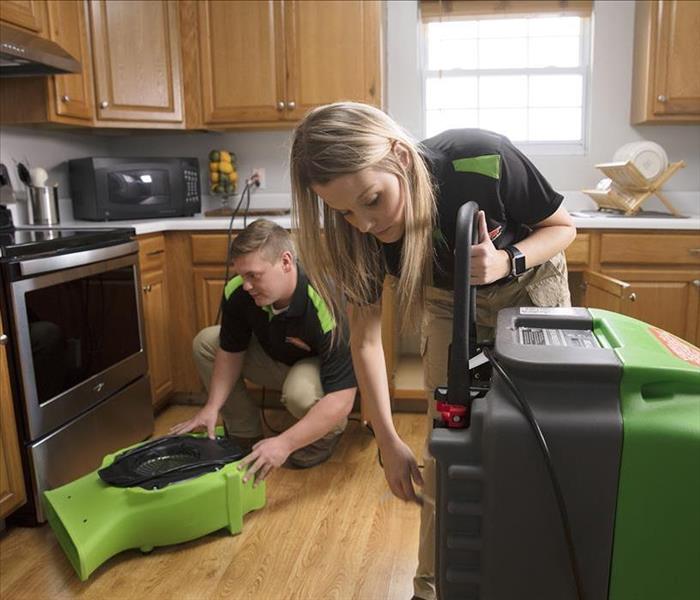 Minor leaks can go undetected for a long time and cause significant damage if left unchecked.
Minor leaks can go undetected for a long time and cause significant damage if left unchecked.
- You should be aware of the location of the stopcock. Ensure that not only you but also your family members are aware of its location. A severe leak or rupture can cause significant damage in minutes. It is critical to understand where and how to turn off the water supply.
- Check for leaks ahead of time. Minor leaks can go undetected for a long time and cause significant damage if left unchecked. Consider that a dripping faucet can waste up to 57 gallons of water per week. Look for signs of stray water beneath sinks and around appliances such as dishwashers and washing machines.
- Check that your sump pump is operational. The sump pump, which is common in basement homes, plays an important role in ensuring that your basement does not flood after prolonged periods of rain. If you have one, make sure it's well-maintained and serviced at least once a year.
- Keep debris out of your gutters. While leaves are the most common cause of blocked gutters, this isn't just an autumnal problem. Moss and weeds are frequently discovered to be a major cause. Blocked gutters play a significant role in damp problems. If you see water running down the side of your house or if your gutters appear to be sagging, they're probably blocked and need to be cleaned.
- Inspect your roof from the inside out. Examine the inside of your attic for signs of water leaking through the roof. Examine the joists for damp spots and the plaster for tea-colored stains. Outside, look for visible damage to the roof and make sure the flashing around any chimneys is in good condition.
- Keep your pipes from freezing. Even if you plan to be away, use a smart thermostat to keep your home at a minimum temperature of at least 10 degrees Celsius. Warm water must be able to circulate through pipes to avoid freezing damage. If a property will be unoccupied for an extended period of time, turn off the water supply at the stopcock and consider draining the system so that no water remains in the system.
- Pipes that are exposed should be properly insulated. Snap-on pipe insulation is inexpensive and effective, and it can also be used outside.
- Install a device to detect water leaks. Detection devices, which are relatively inexpensive, cut off the water supply in the event of a leak, which is critical if you leave your property vacant for extended periods of time.
- Look for any signs of moisture or mold. Damp can be detected by flaking paint or wallpaper, as well as black, speckled marks on skirting and sills. Consider adding more insulation if your walls feel cold to the touch or if you notice a musty odor. In the mornings, check windows and skylights for condensation. Its presence can indicate that your home has higher-than-average moisture levels.
10 Safety Tips to Prevent a Dryer Fire
3/11/2022 (Permalink)
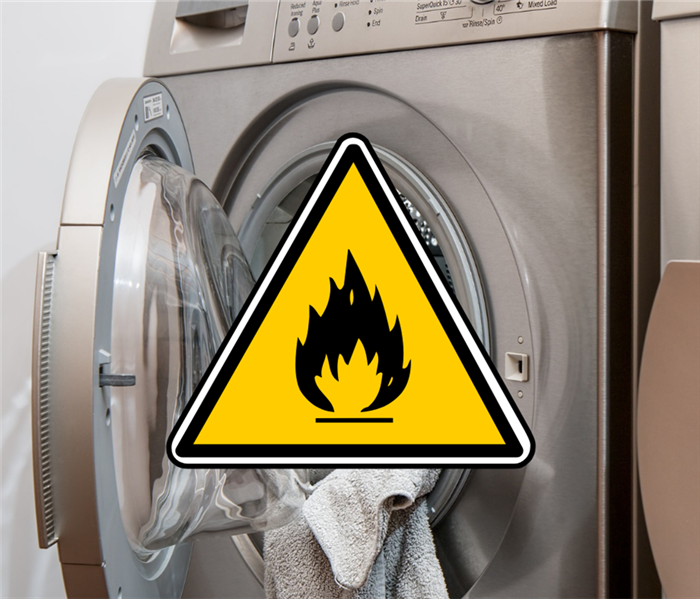 Consider running the dryer only when you are home and awake for your own safety.
Consider running the dryer only when you are home and awake for your own safety.
We usually wash and dry our clothes on a daily or weekly basis. However, it is critical to keep your clothes dryer in good working order in order to keep your home and family safe. Avoiding these specific bad habits can help you avoid a potentially disastrous house fire.
- Installation by a Professional
Professional technicians can ensure that your dryer is installed correctly and carefully. These professionals should be knowledgeable about a wide range of units, including gas and electric dryers, as well as washer/dryer combos. Most manufacturer recommendations, such as proper vent pipe installation, are familiar to these technicians.
A technician would explain how minimizing bends in the pipe is important because it creates fewer opportunities for lint to accumulate. They can install a dryer vent fan for you if the distance between the vent and your dryer is significant. This is an automatic electric device that increases airflow through the duct whenever the dryer is turned on. Having a professional install and service your dryer unit can help ensure that any potential hazards are handled correctly.
- Ongoing Maintenance
According to experts, the primary cause of clothes dryer fires is a failure to clean and maintain them. Check behind the dryer, where lint tends to accumulate. You should clean your dryer once a year and inspect the hose and vent for blockages twice a year.
It is a good idea to have a qualified service person clean the interior of the dryer chassis once a year. This will reduce the amount of lint that accumulates while also providing you with a professional opinion on the safety of your unit. In addition, a professional can inspect the venting and exhaust system. Employ only certified dryer exhaust technicians to ensure that this procedure is carried out correctly.
- Keep Flammables to a Minimum in the Surrounding Area
Dryer lint is not the only flammable that should be considered and kept away from the dryer unit's heat. Anything flammable should be swept up and disposed of before it accumulates and creates a fire hazard. Cleaning up dust and lint is time-consuming, but it is far less difficult than dealing with the aftermath of a fire.
On the same note, do not store cleaning products, boxes, or clothing baskets near the dryer because they may start a fire that spreads quickly. While this is an extreme case, keeping the area clutter-free is an important step toward fire prevention.
- Remove and clean the lint filter before and after each load of laundry.
Household dust and lint are the most common sources of ignition in dryer fires. They congregate within the dryer cavity, which is located near the heating elements. Temperatures can reach 550° here, which is hot enough to start a fire. It is never a good idea to forget to clean out your lint filter.
Cleaning the lint screen before and after each drying cycle is a good habit to get into during your laundry routine. This is an obvious first line of defense in the prevention of dryer fires. Wiping down the interior of the dryer will also remove excess lint buildup that the screen does not catch. This is a less obvious step that many people overlook, but it is nonetheless critical.
It is also critical that you never use a dryer without a lint filter, as this removes the dryer's built-in defense against hazardous lint buildup. This may seem obvious, but you'd be surprised how frequently it occurs.
- Only use metal venting material that is rigid or flexible
Most clothes dryer manufacturers recommend using flexible or rigid metal venting material to maintain proper drying time and airflow. Lint can accumulate in accordion-style ductwork, causing clogs and increasing blockages. Any dryer venting made of plastic or coiled wire foil should be replaced immediately with rigid non-ribbed metal ducts. Purchasing from a reputable vendor is critical to ensuring that your unit meets the necessary safety standards.
It is always a good idea to do your research on any major appliance before purchasing it. Looking at the unit's website to ensure it is from a reliable source, as well as researching customer reviews, can help you make an informed decision.
- Ensure that the air exhaust vent pipe is not obstructed
One of the leading causes of dryer fires is clogged dryer vents. When the vents are clogged, it is difficult to tell. Some people are completely unaware that the vents must be cleaned on a regular basis. However, it is critical to understand that lint accumulates on a large scale within the hoses and, when combined, can cause a serious problem. The accumulation restricts airflow, which can lead to overheating and fire.
In between professional inspections, clean the outside exhaust vent regularly. It is best to check this when your dryer is running by making sure that the exhaust air is escaping properly. If you cannot feel any air, it is likely that there is a lint accumulation clogging the vent outlet. This might require you to disconnect the exhaust vent from the dryer to remove the clog. Remember to reconnect the ducting to the outside vent and dryer before you use the dryer again. If you are unsure of how to do this, it is always recommended that you contact the manufacturer for help or hire a professional.
- Avoid Overloading
Laundry is easy to put off, especially if you have a busy schedule. However, this can lead to you saving all of your dirty laundry to be cleaned on the same day, and it's easy to use this as an excuse to overload your dryer, which can be dangerous.
A heavy load is too much for the dryer and is the most common reason for it to break down. Aside from downtime and repair costs, an overloaded dryer can cause the drum belt, spindle bearings, and pulleys to work overtime, resulting in higher-than-normal temperatures. When this occurs, the friction can ignite a spark, resulting in a fire.
This may be the most straightforward cause of dryer fires and malfunctions to avoid. Maintain organization by limiting your laundry loads to a few times per week. If your schedule makes this difficult or unreasonable, it may be better to simply split your laundry load into two or three loads instead, and take a slightly longer (albeit safer) time to complete this necessary chore.
- Examine Gas Lines
Qualified professionals should inspect the gas line and connection to ensure that they are leak-free and in good working order. Aside from a dryer fire, gas leaks are extremely dangerous and can cause a variety of problems. If you notice a burning odor when using your dryer, stop using it immediately and contact the manufacturer as soon as possible. At all times, stay away from the suspected gas leak area.
- Use the Proper Plug and Outlet
Dryer grounding is critical to their proper operation. Check that you are using the correct electrical plug and outlet as specified by the manufacturer. A licensed professional installing your dryer unit is a good way to ensure that you are doing this.
Check all connections on a regular basis and keep an eye out for any changes. If anything appears to be wrong, loose, or discolored, stop using it right away. Overloaded electrical sockets frequently cause tripped circuit breakers or blown fuses, which can result in a house fire.
- Never use the dryer when you are leaving the house or sleeping.
We've all succumbed to convenience and thrown a load of laundry in the dryer before heading to work or running errands. However, if a fire starts while you are away, you will be unable to put it out. Furthermore, if you are sleeping, it may be too late for you to realize that your house has caught fire.
Consider running the dryer only when you are home and awake for your own safety. It's also a good idea to keep a fire extinguisher in your laundry room in case anything goes wrong.
How to Protect Your Property from Floods Caused by Snowmelt, Ice Jams, and Winter Storms
1/31/2022 (Permalink)
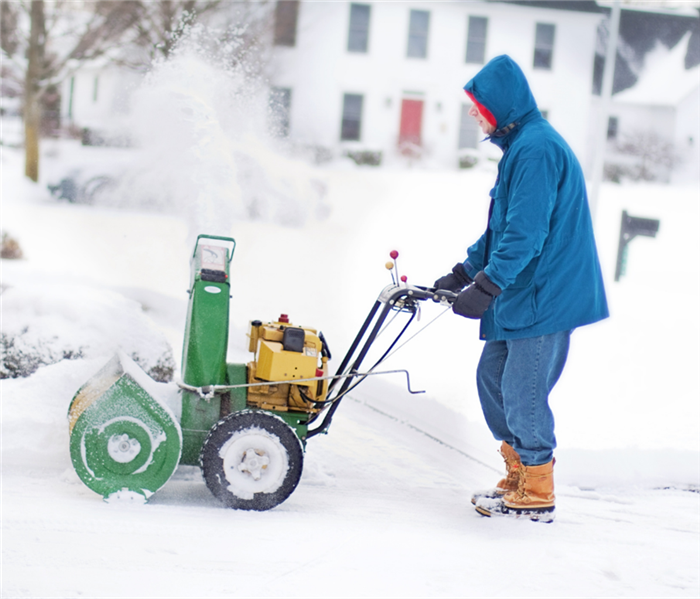 The risk of flooding doesn't go away in the winter.
The risk of flooding doesn't go away in the winter.
When we hear about flooding in the news, we usually hear about spring floods and summer storms, giving the impression that flooding occurs just half of the year. We're not out of the woods yet.
The risk of flooding doesn't go away in the winter, and flooding isn't the only thing to be concerned about when the weather turns cold. Snowmelt, ice jams, and winter storms threaten major floods from the Pacific Northwest to the Great Lakes to the Northeast throughout the winter months.
Winter Flood Risk #1: Snowmelt
Snowmelt is an element of the natural water cycle. However, if snow thaws too quickly to be absorbed back into the soil, neighboring water bodies, and drainage systems, it can flood adjoining land, potentially flooding your basement.
Snowmelt floods can occur anywhere in the snowy north of the US, and they usually occur in small, isolated episodes. But that doesn't rule out the possibility of serious consequences. Let's pretend it snows ten inches, which isn't unheard of in freezing areas. One inch of water equals ten inches of snow, and an inch of floodwater can cost you up to $25k in repairs, according to FEMA.
While snowmelt risk is higher in the spring, climate change has introduced more and more unseasonably warm temperatures every winter. Take the 2019 Midwestern floods, for example. Record amounts of snowfall from January through March were followed by a three-day stretch of 60-degree weather. Rain fell and caused historic levels of flooding along the Missouri River and its tributaries.
Winter Flood Risk #2: Ice Jams
Long cold episodes that cause the surface of rivers to freeze are followed by warm spells, resulting in ice jam floods. Large pieces of ice break off unevenly as temperatures rise, blocking streams and flooding adjacent settlements.
Winter Flood Risk #3: Winter Storms
People who live in lakeside places like the Windy City are probably familiar with flooding in the winter. Strong winds from winter storms can create massive waves that crash over shorelines and barriers into city streets, as they did in Chicago last winter.
These winter storms and subsequent floods are common in the Midwest along the Great Lakes, but they also happen along the East Coast. Nor’easters can trigger storm surges that push heavy ocean tides into coastal communities, on top of heavy rain or snow.
Regular downpours and flash floods can happen throughout the winter, too, as long as temperatures are high enough.
Steps You Can Take This Winter to Prevent Flooding on Your Property
The easiest method to protect your property from a flood is to put measures in place before one occurs. The two most important actions to take care of to ensure that you have both financial and structural flood mitigation on your property.
Step 1: Secure Flood Insurance
Purchase flood insurance as soon as possible once the fear of floods has passed. That way, if you experience flood damage this winter, you'll be able to file a claim swiftly and easily.
The good news is that a flood insurance policy covers all sorts of flood damage equally, so your policy will provide coverage all year. The cost of coverage is decided by factors such as the age of your structure, the type of foundation it has, and your flood zone and risk level.
Step 2: Shovel Proactively and Test Drainage Systems
Shovel snow away from your foundation by at least five feet.
Shovel snow away from a runoff path if your property is on a slope or hill.
Remove any snow that has accumulated on your roof.
Keep snow and ice from accumulating around your property's drainage systems, such as gutters and groundwater pumps.
A bucket of water can be used to test sump pumps.
Floods caused by snowmelt, ice jams, or winter storms can be helped with the same wet and dry floodproofing measures you take to safeguard your property against spring and summer floods, such as constructing drainage systems.
We Have Highly Trained Specialists to Restore Your Home
1/19/2022 (Permalink)
SERVPRO of LaGrange Park/North Riverside is an IICRC firm. The Institute of Inspection, Cleaning and Restoration Certification (IICRC) creates the standards for the restoration industry and provides training and certification to restoration companies. IICRC Certified Firms have the right to display the IICRC Certified Logo.
IICRC Certified Firms must
- Present accurate information to consumers and conduct business with honesty and integrity.
- Require a technician on all jobs who has been formally trained and passed all required tests.
- Require a continuing education program to keep technicians up-to-date on the latest changes in the industry.
- Maintain liability insurance to protect all parties in the event of an accident.
- Maintain a written complaint policy and agree to Better Business Bureau or similar arbitration to resolve disputes, and accept the conclusions and recommendations of arbitration.
The IICRC Develops The Standards For The Restoration Industry
The IICRC has been the driving force in establishing the main industry standards and reference guides for professional carpet cleaning, water damage restoration and mold remediation. These IICRC standards take years to develop and require the coordination of experts in the field: manufacturers, industry organizations, insurance professionals, training schools, contractors, and public health professionals.
Every five years, the standards are reviewed and updated. The water damage restoration field changes rapidly with advancements in technology and science, and therefore the standards must evolve to keep pace.
About SERVPRO of LaGrange Park/North Riverside
SERVPRO of LaGrange Park/North Riverside specializes in the cleanup and restoration of residential and commercial property after a fire, smoke, or water damage event. Our staff is highly trained in property damage restoration and we are an IICRC Certified Firm. We believe in continuous training: from initial and ongoing training at SERVPRO’s corporate training facility to regular IICRC-industry certification, rest assured our staff is equipped with the knowledge to restore your property.
We Are Here to Help!!
1/14/2022 (Permalink)
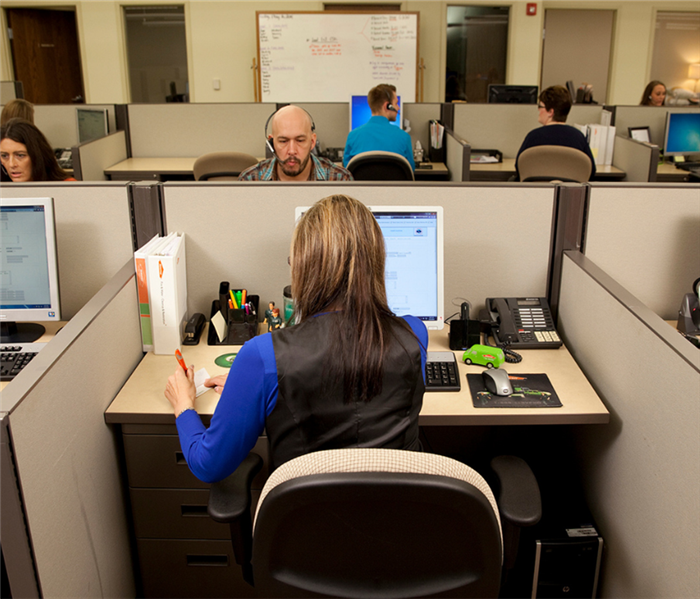 We Answer the Phone Ready to Help
We Answer the Phone Ready to Help
SERVPRO of LaGrange Park/North Riverside is available 24 hours a day for water emergencies, large or small. When you are dealing with water damage, immediate action is crucial. A delay of just a few hours can greatly increase the severity of the water damage.
We Answer the Phone Ready to Help
We understand that when you call us, you may be feeling confused, stressed, and vulnerable. You need an expert to guide you through this crisis. SERVPRO of LaGrange Park/North Riverside has the specific water damage training and experience to help you through this tough time. We specialize in water damage restoration—in fact, it's the cornerstone of our business.
What to Expect
When you call, we will ask several questions regarding your water damage emergency. These questions will help us determine what equipment and resources to bring, including how many trained SERVPRO Professionals may be needed.
Our SERVPRO Representative will ask several questions:
- Your name and contact information
- Your insurance information (if applicable)
- The street address of the water-damaged home or business
- When did the flooding or water damage occur?
- What caused the water damage (if known)?
- Is there electricity available (on-site)?
Call us today: (708) 240-4873
Will Insurance Pay For Mold Remediation
1/13/2022 (Permalink)
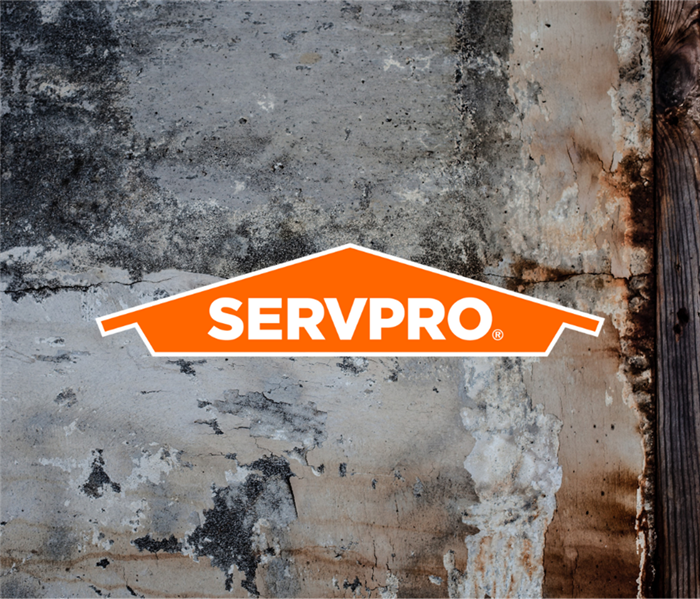 If you notice mold growth, it's best to eliminate it quickly. SERVPRO has the equipment and knowledge to assist in the cleanup process.
If you notice mold growth, it's best to eliminate it quickly. SERVPRO has the equipment and knowledge to assist in the cleanup process.
If you notice mold growth, it's best to eliminate it quickly. SERVPRO has the equipment and knowledge to assist in the cleanup process. Restoration costs can add up quickly, though, and you're probably wondering whether your homeowner's insurance can help pay the bill. Sometimes it does, and sometimes it won't. You'll want to review your policy and speak with your insurance adjuster. Here are three things to know before having that conversation.
1. Was It Accidental?
Is mold coverage not in your policy? Owners usually have to add it separately. That doesn't mean that you can't get aid. Did your roof cave in from snow or ice? Did a pipe suddenly freeze and burst? Insurance companies may payout if the spores spread as a result of something out of the homeowner's control. If the initiating incident is included then the subsequent events get bundled with it.
2. Was the Issue Remedied Quickly?
Before a check is cut, the company could ask for evidence proving your home was under proper care. Take the broken pipe for example. Can you prove that you called for help as soon as possible? Did you let it sit and fester for a while? If the latter is the case, you may have encouraged the fungus growth, giving grounds for denial. It's best to care for water damage as quickly as possible. Prove your efforts by saving receipts. Show efforts to have repairs made and dry up the premises.
3. Is a Different Policy Available?
Speak openly about concerns. As you meet about policy updates including mold insurance limits. For instance, some companies only pay up to a certain amount, capping the remediation and leaving the rest of the cost to the residents. Consider supplementing coverage. While you may have to pay a bit more each year, that annual amount could offset large numbers.
Eliminate mold growth as soon as possible. When you notice an issue, call SERVPRO and we will contact your insurance company if needed.
COVID-19 CLEANING & DISINFECTING SERVICES
1/9/2022 (Permalink)
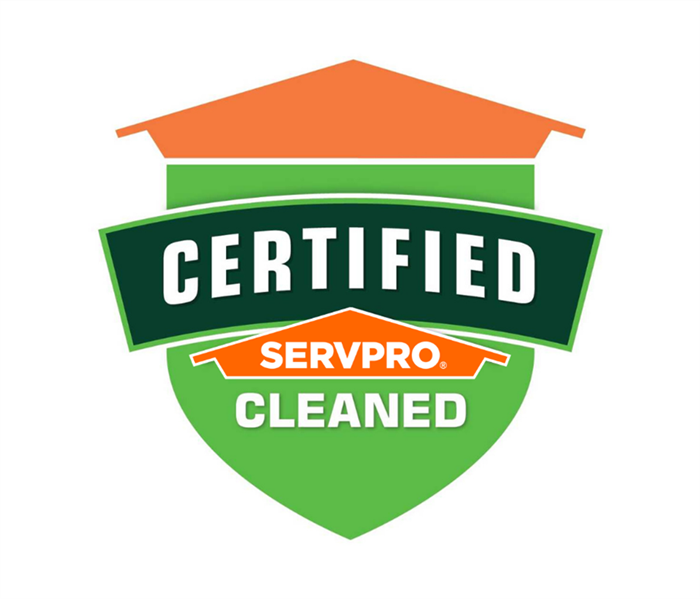 We provide preventative cleaning services as well as cleaning after a probable or proven exposure to assist reduce transmission.
We provide preventative cleaning services as well as cleaning after a probable or proven exposure to assist reduce transmission.
Protect Your Employees & Guests From COVID-19
About Coronavirus
Beginning in 2020, The Centers for Disease Control and Prevention responded to an outbreak of a respiratory disease caused by a new coronavirus that was first detected in China and spread internationally. While the virus is termed coronavirus, the sickness that results after infection is termed COVID-19.
COVID-19 was declared a pandemic, which is a global outbreak of a disease.
About Our Services
SERVPRO® of La Grange Park / N. Riverside technicians are specially trained to clean and disinfect your home or business according to CDC guidelines. We have years of experience dealing with biological hazards, and we will go above and beyond what janitorial personnel does on a daily basis. Our technicians are qualified to undertake a proactive cleanup that includes cleaning and disinfection of the business or structure. Washing porous and non-porous surfaces, disinfecting non-porous surfaces, cleaning, and disinfecting equipment, tools, and/or supplies used in the cleanup process, and waste disposal are all common cleanup methods.
Residential homes, small and large enterprises, schools and universities, commercial buildings, factories and plants, government facilities, and more can all benefit from SERVPRO's skilled cleaning services. COVID-19 was specifically addressed by our Certified: SERVPRO Cleaned defensive cleaning program. We provide preventative cleaning services as well as cleaning after a probable or proven exposure to assist reduce transmission.
What Chemical Do We Use to Clean?
While we use a range of disinfectants to destroy hazardous bacteria and viruses, SERVPROxide is the disinfectant of choice in COVID-19 cases. SERVPROxide is a hospital-grade disinfectant that has been shown to be effective on hard, non-porous surfaces against viruses like SARS-CoV-2. The CDC has cleared it for COVID-19 cleaning.
Call us today at (708) 240-4873 if your home or business has been exposed to COVID-19
Be Prepared for the Next Winter Storm With These Tips!
1/6/2022 (Permalink)
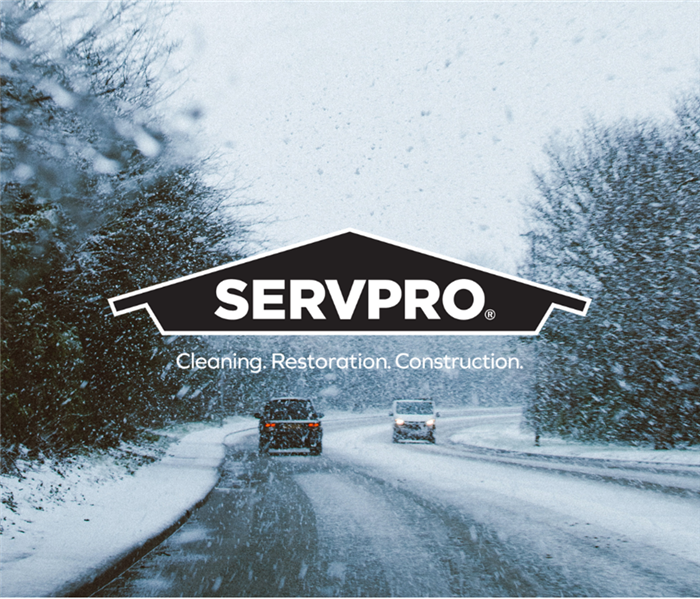 Before the next winter storm arrives, get your car's antifreeze levels, battery, ignition system, exhaust system, heater, lights, and oil checked.
Before the next winter storm arrives, get your car's antifreeze levels, battery, ignition system, exhaust system, heater, lights, and oil checked.
Winter storms can bring not only a lot of snow, but also bitterly cold temperatures, strong gusts, freezing rain, and ice. They can bring down trees, make roads and pathways extremely unsafe, and produce power outages that linger for days. Schools and daycare facilities may be closed as a result of the disruption to public transit. Winter storms also increase the likelihood of car accidents, hypothermia, frostbite, carbon monoxide poisoning, and heart attacks.
That's why, with winter storm season in full swing, knowing how to protect yourself, your family, and your house safe is essential.
Here are some things you can do now to prepare for the impending storm.
1. Make sure you have enough food in your pantry.
Because it's critical to stay indoors and avoid traveling during a winter storm, making sure you're well-stocked on food is critical. Many non-perishable things should be in your pantry so that you don't have to worry about anything deteriorating if you lose electricity. Ideally, you should have enough food to last at least three days.
2. Buy Bottled Water
Make sure you have plenty of bottled water on hand in case your pipes freeze and you can't get water from the tap. You may also require water for brushing your teeth, cleaning dishes, flushing toilets, or bathing if your pipes freeze. You can also prepare ahead of time by filling the bathtub, jugs, bottles, and other containers with water.
3. Get your prescriptions filled and hygiene items picked up
Make sure all of your prescription drug prescriptions are filled so that you have enough on hand to last at least three days, if not a week. This eliminates the need to rush to the pharmacy when the roads are poor.
You should also stock up on any hygiene products you may require, like as diapers, toilet paper, tampons, and toothpaste. Picking up moist toilet paper can also be beneficial if water is scarce.
4. Check your tools and stock up on ice melt.
Ice melt salt sells out quickly in local stores just before a storm, so start buying up early to ensure you have enough for after the storm. You'll need enough to shovel and salt all of your outside stairs, stoops, and walkways immediately following the storm, before the snow melts and turns to ice as the temperature drops.
Before the storm hits, make sure you have a good snow shovel (or two). Make sure they aren't too worn or cracked, as this will only complicate your life. You'll also want to make sure your tool kit is up to date and simple to locate, since you may need a wrench or pliers to quickly turn off utilities.
5. Be Prepared For A Power Outage
Charge your cell phones in advance of the storm, and have some portable battery backups available in case the power goes out. It's also a good idea to keep flashlights or battery-powered lights around the house so you don't have to waste time looking for them.
If you live in a region where power outages are common, you should consider purchasing a generator, either a portable or a standby one for your home. If you have a portable generator, make sure you have enough gasoline or propane before the storm to operate it whenever and for as long as you need it. Always use portable models outside, away from windows, and never use them indoors or in confined locations like garages, crawl spaces, or basements.
6. Take Care of Your Water Pipes
Allow cold water to flow from faucets supplied by exposed pipes to help prevent frozen pipes. Running water, even at a trickle, is less likely to freeze. Allow warm air to circulate near plumbing by opening cabinet doors in the kitchen and bathroom. Pipe insulation should be added to any pipes that are prone to freezing. Maintain a temperature of no less than 55 degrees Fahrenheit inside your home.
7. Make sure your windows and doors are well-sealed.
Drafty windows and doors let chilly air in while letting warm air out. That's why it's a good idea to use an insulation kit from any hardware shop to seal any windows. Weatherstripping can also be purchased at the store to improve the seal on your front door.
Insulated blinds are also available to help keep the warm air inside the house.
8. Inspect and replace smoke and carbon monoxide detectors if necessary.
Make that your smoke and carbon monoxide alarms are still operational. It's advisable to replace them with detectors that work during a power outage if they aren't already battery-powered or battery-backed to keep your family safe.
9. Get Your Backyard Ready
Take a trip around your yard before the storm to check for any tree limbs that could fall on your house. If you have the ability, you should prune those back to prevent them from causing damage to your property during the storm – or hire someone to do it for you.
If any tree branches are near power lines, you should get them trimmed or chopped back by a professional or the utility to assist reduce the danger of a power outage.
Mulch your gardens, if you haven't already, to protect plants that you don't want to freeze.
10. Get Your Car Ready
Before the next winter storm arrives, get your car's antifreeze levels, battery, ignition system, exhaust system, heater, lights, and oil checked.
Then, in case you're trapped in your automobile due to the blizzard, prepare your car with items you might require. Blankets, water, chains, jumper cables, ice scrapers, maps, bottle water, warm clothing, non-perishable snacks, and a first-aid kit should all be in your car. It's also a good idea to have some sand or kitty litter on hand in case you get stranded in the snow or ice.
11. Keep yourself up to date
Listen to your NOAA weather radio for hazardous weather alerts and warnings. Always keep an eye on the weather forecast, whether it's on the internet or on your phone. Sign up for emergency alerts and updates in your area.
In the event of an emergency, know how to cut off your utilities, such as gas lines.
Before the storm strikes, do some research on nearby shelters and warming centers, and establish a plan for where to go and how to get there if you need to leave your house in an emergency.
Also, be aware of the symptoms of hypothermia and frostbite, and be prepared to check on your neighbors, particularly if they are elderly or have young children who are more vulnerable to the cold.
The Fire Hazards of Winter!
12/30/2021 (Permalink)
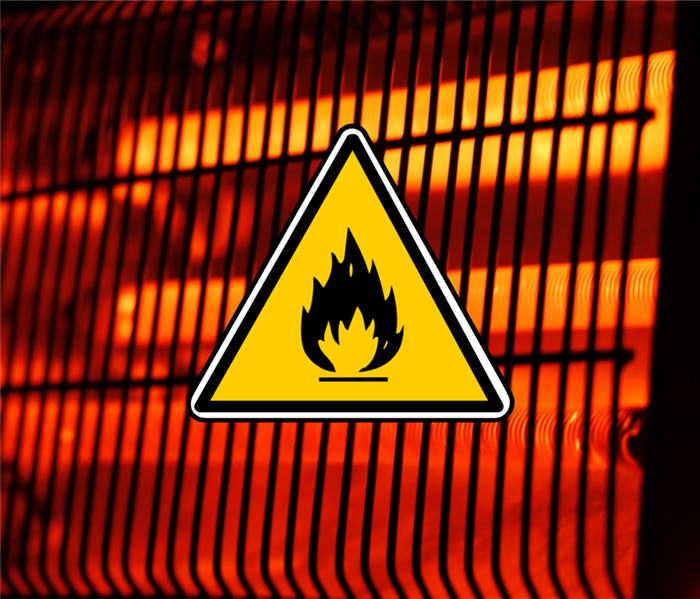 Anything that can burn should be kept at least three feet away from heating equipment!!
Anything that can burn should be kept at least three feet away from heating equipment!!
Keeping ourselves and our houses warm during winter can rapidly turn into a fire hazard, whether it's with a space heater, candles, or an electric blanket. There are various things you can do to make your home more fire-safe, as well as activities you can personally adopt to assist you to stay safe this winter.
Candles
- Candles should be kept at least 3 feet away from anything that can catch fire.
- Place candles in robust holders and in places where they won't be easily knocked over.
- Make sure that candles are out of reach of youngsters and dogs.
- If you leave the room, fall asleep, or go to bed, extinguish all candles.
Electrical equipment/appliances
- Only use one wall outlet at a time to plug in a heat-producing gadget (coffee maker, space heater, microwave, etc.).
- When using a heat-producing appliance, never utilize an extension cord.
- Extension cords should only be used for a short period of time.
- Furniture, beds, curtains, clothing, and flammable or combustible gases and liquids should all be kept away from lamps, light fixtures, and light bulbs.
Heaters
- Make room for space heaters! Anything that can burn should be kept at least three feet away from heating equipment (furnace, fireplace, wood stove, portable heater, etc.).
- When you leave the room or go to bed, turn off the space heater.
- A competent specialist should clean and inspect your heating equipment and chimneys once a year.
- Never heat your home using an oven.
Always make sure you have a working smoke and carbon monoxide alarm at all times in case of a fire.
Here's What You Need in Your Winter Car Emergency Kit if You Get Stranded in a Snow Storm
12/1/2021 (Permalink)
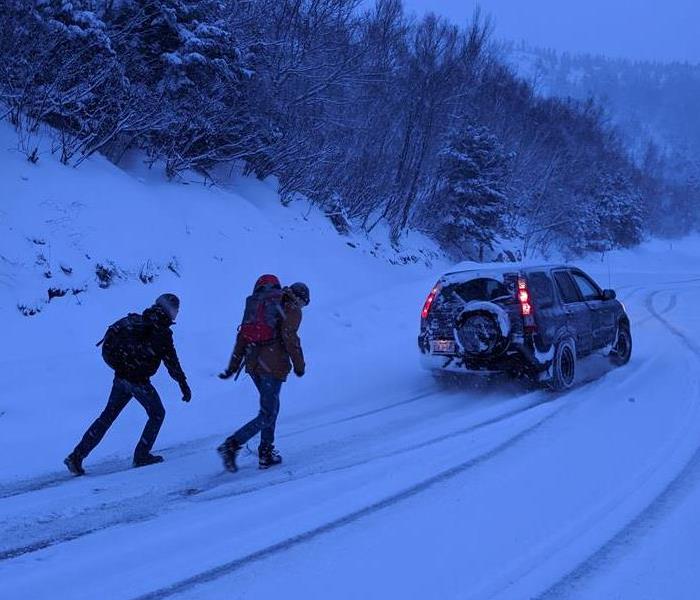 Winter Car Emergency Kit
Winter Car Emergency Kit
For the drivers in your family, including yourself, a winter car emergency kit is a must-have. Winter weather may leave you stranded, but having a well-stocked emergency pack can help you get back on the road, or at the very least make the time you wait for help safer and more comfortable.
- Booster cables for batteries. You'll need these if you have a dead battery or if you need to assist someone who has a dead battery. A portable jump starter, on the other hand, is simple to use and effective, but it must be kept charged while on the road.
- Ice scraper. In the snowbelt, every car should have an ice scraper and a brush. Scrapers are usually included in the kits for a low cost. It is preferable to include a snow brush/scraper that makes cleaning snow prior to travel much easier. It is the law in several areas to clear your automobile of all snow. Even if it isn't, it's just good manners to keep your blowing snow from obstructing another driver's eyesight.
- Portable Shovel. These are useful for digging out a car that has been buried by plows or stranded by the side of the road, as well as creating space around a tailpipe for lengthy idling to avoid pollutants from entering the vehicle. A collapsible shovel is included in most kits. (The shovels are available in various sizes and strengths.) If you've ever had to dig your car out, a full-sized shovel may be necessary, as tiny shovels can be tough to handle on larger operations. Additionally, have a bag of sand in your trunk to aid traction.
- Handy Items. The majority of kits feature a flashlight, and some also include a warning cone to alert approaching traffic of your presence. For that flashlight, bring extra batteries. Roadside triangles should be included in every pack, and some come with a reflective safety vest.
- A basic first-aid kit. Most emergency kits include a section for the minimal necessities, such as bandaging a tiny cut. Add items that are unique to your health needs, and keep in mind how temperature can alter medications.
- Charger for cell phone. A cell phone charger is a useful thing to keep in the car, especially during the winter and on road trips, because almost everyone nowadays has a smartphone hooked to their hip.
- Other items that are common. Gloves, a blanket, a rain poncho, wipes, and rags can all help you stay clean while also protecting you from the weather. Keeping a pair of boots and a cap in the car is a good idea, especially if you frequently drive in icy conditions.
- Strap for towing. A strap is a simple item that can be quite useful if you ever need to be hauled out of a ditch. Before you use the strap, make sure you know how much weight it can tow (reliable straps will have that information printed on the label) and how to tie it to the proper portion of the automobile. Read your car's owner's manual for tips on how to use a tow strap, such as how to utilize a detachable tow hook with a tether.
- A fire extinguisher. It's useful if you need to put out a little fire, but if your automobile is on fire, back off and call for help. If you buy a fire extinguisher, check sure it's designed for use in cars.
- Items to deal with a flat tire. Some kits include an aerosol can of tire sealant that can be used to temporarily repair a punctured tread. These products are not intended for big punctures or tires with sidewall damage, and they may not perform effectively in extremely cold conditions (see the directions). If a spare tire is available, use it, or ask for a tow from roadside help.
What do you have in your car emergency kit?
How do I protect my water heater in cold weather?
12/1/2021 (Permalink)
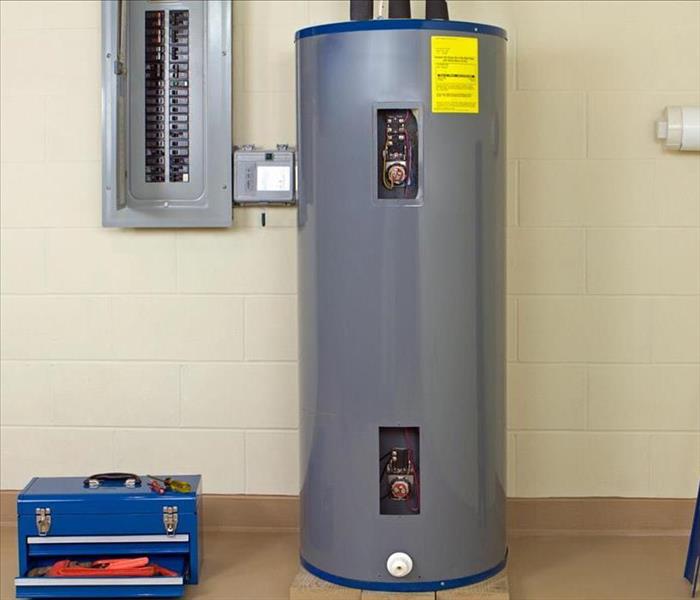 Tips on how to prepare your water heater for the holiday season
Tips on how to prepare your water heater for the holiday season
This holiday season, having a damaged water heater is the last thing you want. Dishes are more difficult to wash when you have to heat water on the stove, and guests don't like cold showers. However, you may be on the verge of a water heater meltdown without even realizing it.
The water in your plumbing is colder now that winter is near. This implies that your water heater will have to work a little longer and harder to reach the desired temperature. Furthermore, the temperature difference between the hot water at the top of the tank and the cold water at the bottom is higher, forcing the tank to flex more.
With the return of the kids from college, the arrival of family for an extended visit, the additional holiday dishes, and laundry, it will be put to even greater use. If your water heater is older, this could cause it to overheat.
Here are tips on how to prepare your water heater for the holiday season
Insulate your water tank and pipes.
As the temperature cools, it's critical to maintain your hot water as hot as possible. Loss of heat can drive up utility costs by consuming more power and gas. Heat loss can be reduced by insulating the tank and pipes going away from the water heater. This insulation is generally built into newer water heater tanks, but if you have an older tank, you can buy a tank cover to add an extra layer of insulation to keep hot water hotter. Your plumber will be able to properly measure and install this tank insulation. Otherwise, if you're in the market for a new water heater, look into one of the newer tank heaters with built-in insulation.
Check the anode rod.
The sacrificial anode rod is an important component of tank water heaters because it rusts away and sacrifices itself to prevent rusting in the heater tank. The sacrificial anode rod is placed at the top of the tank and should be checked during the pre-winter inspection. Anode rods are good for five years, although they should be examined once a year. It's time to replace the rod if it's calcium-coated or worn down to less than 1/4 inch thick.
Clean out the tank.
Excess sediment and calcium buildup can coat the tank sides lowering its efficiency and resulting in less hot water. You want to make sure your water heater is running smoothly and efficiently before the colder months of the year arrive. To eliminate buildup and extend the life of the tank, hot water tanks may need to be drained 1-2 times a year. Turn off the water, gas, and electricity to drain the tank. Connect a hose to the drain valve and direct the water to a ground drain. Allow the tank to drain by opening the drain valve and the temperature-pressure regulator valve. Once the tank is empty, flush it with cold water to remove any remaining sediment. Your plumber can also assist you in checking for calcification on the water heater element.
Access the temperature pressure regulator.
If the temperature or pressure in your tank rises too high, this valve on the top or side of the tank automatically releases water. Lift the lever and then release it to inspect the valve. You should be able to hear or see water exiting from the system. If the valve isn't working or the water is still leaking, call your plumber for assistance.
7 Ways to Prevent Frozen Pipes
12/1/2021 (Permalink)
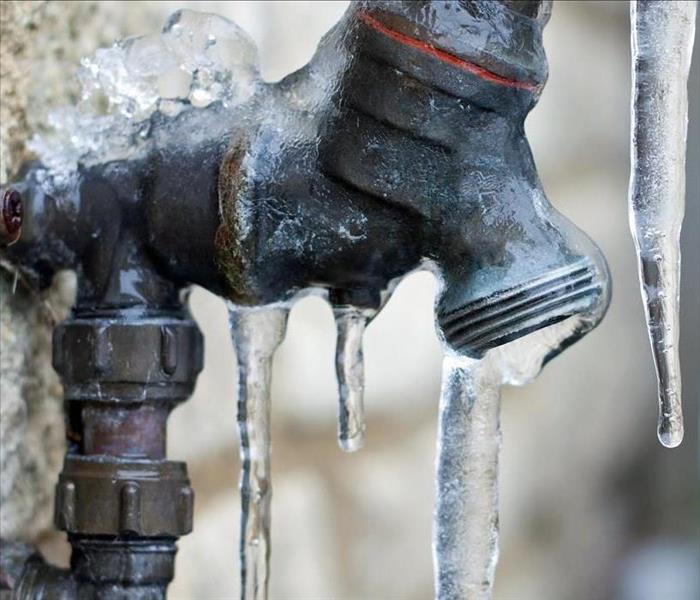 Tips to help prevent pipes from freezing
Tips to help prevent pipes from freezing
Frozen pipes are caused by three factors: rapid temperature dips, insufficient insulation, and thermostats set too low.
- Insulate. Even if you live in a climate where freezing is unusual, pipe insulation in your home's crawl areas and attic can help. The pipes that are exposed are the most vulnerable to freezing. Remember that the more insulation you use, the better your pipes will be protected.
- Use heat tape or wire. Wrapping pipes with heat tape or thermostatically controlled heat wires is one option. Use only goods that have been approved by a third-party testing organization, such as Underwriters Laboratories Inc., and only for the purpose indicated (exterior or interior). Follow the manufacturer's installation and operation directions to the letter.
- Seal leaks. Locate and completely plug any leaks that enable chilly air to enter the house. To keep the cold out, look for air leaks around electrical cables, dryer vents, and pipes and seal them with caulk or insulation.
- Hoses, valves, and faucets should all be secured outside. Disconnect garden hoses and, if possible, use an interior valve to turn off and drain water from pipes running to outside faucets before winter arrives. This decreases the risk of freezing in the short distance between the home and the pipe.
- Allow the water to drip. It may only require a trickle of hot and cold water to keep your pipes from freezing. When the weather is cold, let warm water trickle from a faucet on an outside wall overnight.
- Make the necessary adjustments to the thermostat. Frozen pipes can also be avoided by keeping your thermostat at the same temperature throughout the day and night. This also helps to lessen the strain on the furnace during periods of extreme cold.
- Open Cabinet doors. This permits heat to reach pipes under sinks and appliances near outside walls that aren't insulated.
Water not coming out of the faucet is one of the first indicators of a frozen pipe. If you notice this, go to the basement and double-check that the water is still on and that there isn't a leak. Continue your check after you've confirmed these two points to ensure that none of your pipes have burst. If you discover that your pipes are frozen but none have burst during your search, you have two options:
- Call a plumber to thaw your frozen. This is usually a better option. You don't know where the frozen pipes are or you can't get to the frozen region if you don't think you can safely thaw the pipes yourself.
- Make an effort to thaw the frozen pipes on your own. Be advised that if this option is not done correctly, it can cause more complications.
Safety Tips for Deep Frying a Thanksgiving Turkey
11/3/2021 (Permalink)
 Safety tips to protect yourself, your loved ones, and your home!
Safety tips to protect yourself, your loved ones, and your home!
It’s November, so it’s time for turkey!!!
Deep frying is the newest trend in Thanksgiving turkey preparation. The outcomes can be wonderful, but the process can be risky. I will explain why deep-frying is dangerous and share safety tips to protect yourself, your loved ones, and your home.
Why deep fryers can be dangerous
- The fryer has the potential to tip over and spill gallons of heated oil.
- When the turkey is placed into the cooking pot, overfilling the pot with oil produces leakage. If the oil spills onto the burner, the entire fryer will burst into flames.
- When frozen or partially frozen turkeys are placed in the fryer, steam quickly expands, causing the oil to boil over.
- If there are no thermostat controls, the fryer units have the potential to overheat to the point of combustion.
- The sides of the cooking pot, the lid, and the pot handles can become extremely hot, resulting in severe burns.
Deep-Fried Turkey Safety Tips
- Place the turkey fryer at least 10 feet away from your home and away from children and pets. It should never be left unattended.
- Place the fryer on a leveled, flat surface and carefully measure out the amount of oil required.
- Make sure your turkey is totally thawed and dry before cooking.
- Keep an eye on the temperature of the oil and use the fryer with caution. Severe burns from the lid and handle are possible.
- Always keep a fire extinguisher or multipurpose dry powder on hand in case oil catches fire.
Thanksgiving Safety Tips and Fire Facts
11/2/2021 (Permalink)
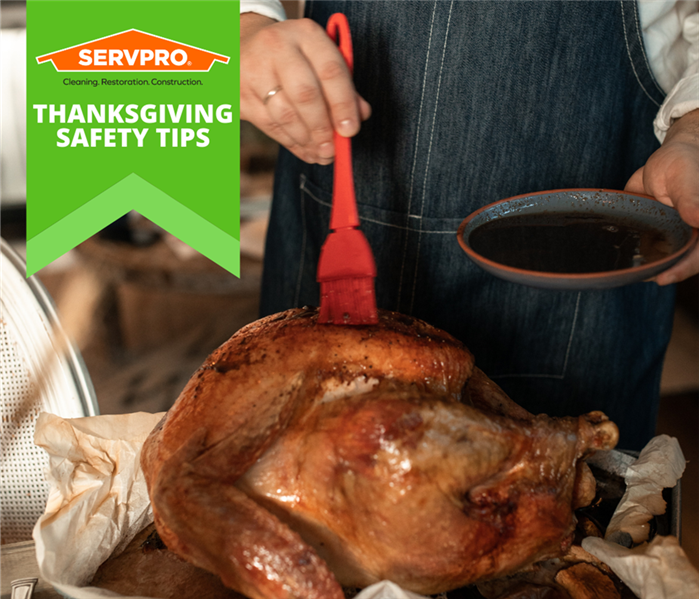 Thanksgiving Safety Tips and Fire Facts
Thanksgiving Safety Tips and Fire Facts
The kitchen is the heart of the home for most people, especially around the holidays. Everyone appreciates being a part of the preparations, from testing family recipes to creating cakes and pastries.
When there's a lot of activity and people at home, it's crucial to keep fire safety top of mind in the kitchen during this festive but chaotic time. As you begin to plan your holiday schedule and prepare a large family meal, keep in mind that by following a few easy safety tips, you can spend time with your loved ones while also keeping yourself and your family safe from fire.
Safety Tips
- While you're cooking, stay in the kitchen to keep an eye on the food.
- The stove will be very hot, so children should keep at least three feet away.
- Keep children away from hot foods and beverages. Vegetables, gravy, or coffee steam or splashes can cause significant burns.
- Make sure that no electric wires from a coffee maker, plate warmer, or mixer are dangling off the counter or within easy reach of a child.
- Matches and utility lighters should be kept out of reach of children, preferably in a locked cabinet.
- Never leave a lit candle alone in a room unattended.
- Check to see if your smoke detectors are working. By using the test button, you can put them to the test.
Thanksgiving Fire Facts
- Thanksgiving Day, the day before Thanksgiving, Easter, and Christmas Eve are the most common days for home cooking fires.
- On Thanksgiving Day in 2018, U.S. fire agencies responded to an estimated 1,630 home cooking fires, the busiest day for such disasters.
- Cooking that was left unattended was by far the most common cause of cooking fires and fire deaths.
How to Stay Safe During a Wind Storm!!
11/1/2021 (Permalink)
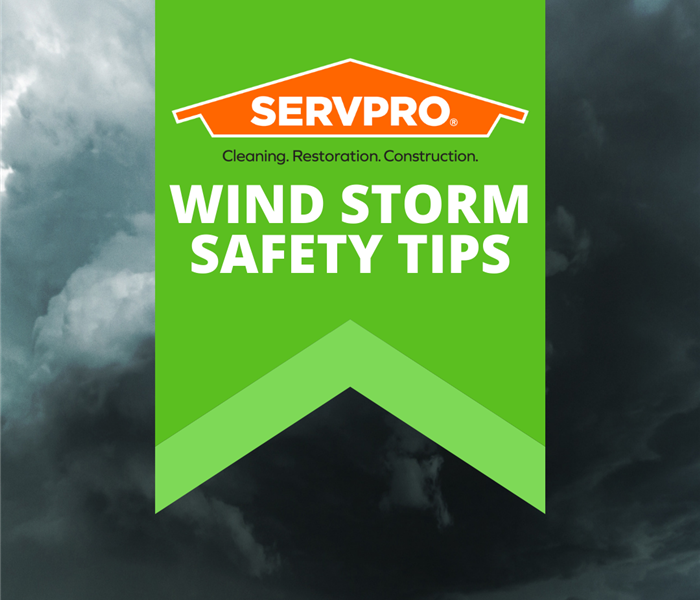 Tips to stay from wind storms
Tips to stay from wind storms
Winds can reach speeds of more than 100 miles per hour during extreme weather events such as tornadoes!
High winds of any speed, on the other hand, can cause damage to homes and property, as well as flying debris and shattered glass, which can cause injuries. A disaster preparedness plan for your family, including a disaster survival kit and an emergency evacuation plan, can save your family from injury and inconveniences.
Keep yourself updated!
Weather updates and advisories will be broadcast on the radio and television. Having the most up-to-date information is critical to keeping safe during a weather event. For updates, utilize an NOAA Weather Radio or battery-powered radio, and keep an eye out for mobile alerts.
A high wind alert indicates that persistent winds of more than 25 mph are expected.
Warnings for thunderstorms and tornadoes should be taken seriously since they indicate that severe weather has been detected and is on its way.
During bad weather, seek cover!
- Remove yourself from windows and glass doors and into the center of your house or basement. Take refuge under a stairwell or a large piece of furniture.
- During heavy winds, do not stay in a mobile home. High winds can easily topple them, and flying debris can penetrate their light frames and exteriors.
- Make a safe room for yourself. If you live in a location where violent winds are common, you should consider constructing a safe room in your home.
Protect your home against extreme weather and wind events with these helpful tips
- Vehicles that you want to leave behind should be parked or stored in a garage. If you don't have a garage, relocate your belongings to higher ground in the event of flooding.
- Garbage cans, patio furniture, barbecues, and other potentially wind-borne items should all be kept inside your house or garage.
- Close the doors and windows to your home. In the event of severe winds, board up windows and glass doors with shutters or plywood to prevent harm from broken glass.
- Secure your outdoor pool and turn it off. To avoid damage, turn off the circuit breaker for your outdoor pool and remove the engine.
- Tree branches that pose a danger should be removed. Pruning branches that may break off during a storm and injure someone or cause damage to your home or vehicles is a good idea.
- A generator can be rented or purchased. A generator can assist keep refrigerators, freezers, and lights running if you can rent or buy one. A severe storm can knock out power for days, if not weeks, at your home.
- Keep an ear out for weather updates on the radio. If you are told to evacuate, follow local officials' instructions and head to a shelter.
- Let your friends and family know where you'll be.
If you don't have time to get to a shelter, go to your safe room if you have one. Otherwise, stay in the center of your house or basement, away from windows, and hide under a stairwell or a large piece of furniture.
Why the best option for post-disaster cleanup and restoration is SERVPRO
11/1/2021 (Permalink)
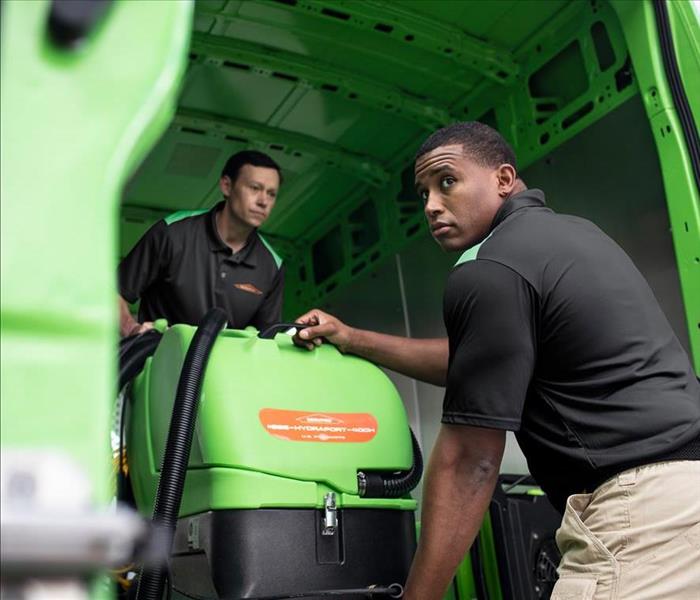 Why SERVPRO is Top Choice
Why SERVPRO is Top Choice
#1 Excellent Disaster Preparedness Resources
SERVPRO's network is one of the reasons for its success in crisis response. Because of the state-wide franchise network, there are enough resources to take on any job in any location. The experts of SERVPRO are prepared to repair commercial or residential damage.
Regardless of the size of the incident, all SERVPRO teams have access to additional resources for a quick and reliable response.
#2 Highly Skilled Groups
Each SERVPRO crew is made up of experts that have vast experience in catastrophe recovery.
SERVPRO is at the forefront of catastrophe recovery on a regular basis, allowing it to develop its processes and respond quickly. These teams are in charge of all areas of catastrophe recovery, including:
2017 Hurricane Harvey
2014 Polar Vortex
2010 Nashville Floods
2005 Hurricane Katrina
#3 Quick Responses for Lowering Total Costs
Storms cause damage on a property, enabling plenty of water to enter regions that should be dry. To save the building's structural integrity, the water must be removed quickly.
SERVPRO conducts a thorough cleaning process to prioritize areas that will be costly to replace or restore if not addressed right away. The response team knows which surfaces should be saved and which may be replaced at a reasonable price. As a result, the restoration time is reduced and the outcomes are more consistent.
#4 Experience with Insurance Companies
After a disaster, dealing with an insurance company is a necessary part of the process. That's why SERVPRO has established a network of contacts in the industry to ensure a seamless and effective relationship. SERVPRO works nicely with any insurance provider and has a good reputation for quality work on-site.
Emergency Ready Program for your business
9/29/2021 (Permalink)
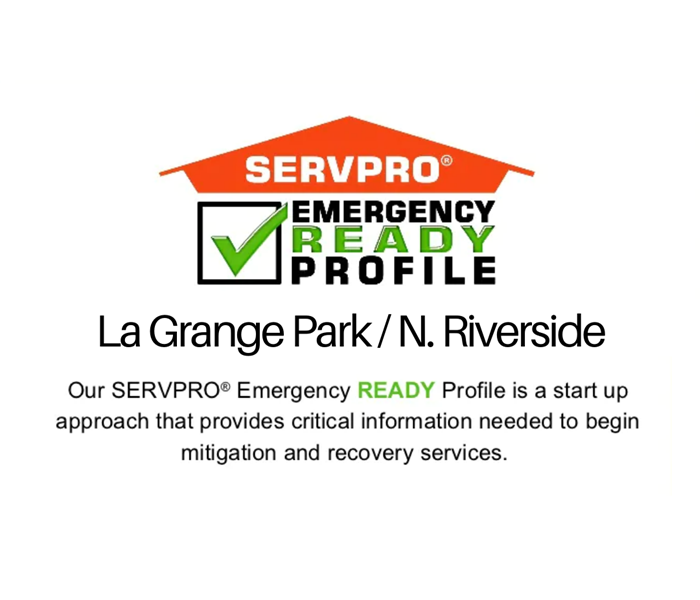 Join our Emergency Ready Program today!
Join our Emergency Ready Program today!
Are you and your clients “Ready for whatever happens?”
If an emergency situation arises in your workplace, give us a call and we'll be there as soon as possible to help. We're here for you 24 hours a day, 7 days a week to get your business back on track! Our experience includes fire and water damage restoration, while also electronics restoration and document drying.
Our professionals are trained to be aware of legal and environmental issues while working within your budgetary constraints to repair the affected area. We understand that every hour spent cleaning is an hour of lost revenue and productivity.
Preparation is essential for surviving any major disaster, whether it's a minor water leak, a large fire, or a widespread flood. The greatest time to prepare for such tragedies is before they occur.
By becoming a member of our SERVPRO of LaGrange Park / North Riverside Emergency READY Program (ERP), you will get access to over 40 years of experience in lessening the impact of natural and man-made disasters.
Give us a call today to schedule your Emergency Ready Program (708) 240-4873!
When storms or floods hit La Grange/N. Riverside, SERVPRO is ready!
9/27/2021 (Permalink)
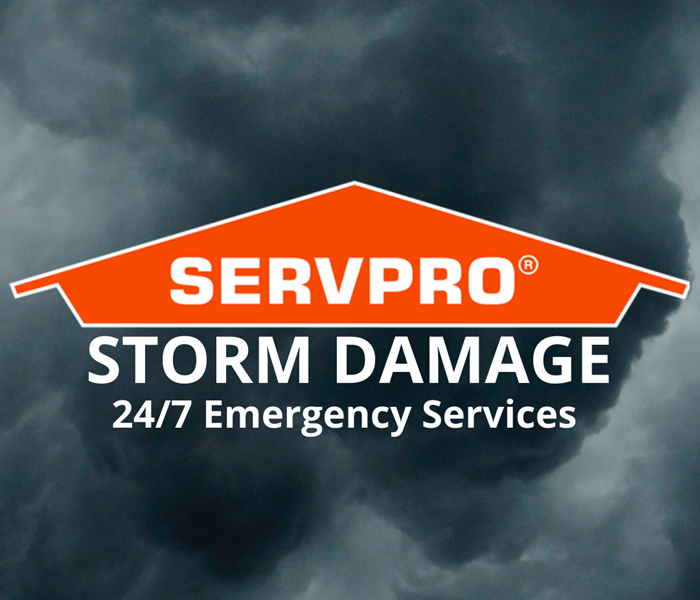 24/7 Storm Damage Emergency Service
24/7 Storm Damage Emergency Service
The effects of a storm or a flood can be catastrophic! You need to act quickly, and you need a professional that has experience with storm damage. SERVPRO La Grange/N. Riverside Professionals have the training, equipment, and resources to manage any major disaster and can respond quickly to storm and flooding situations.
What do we provide?
- 24 hour Emergency Service
- Highly Trained Water Damage Specialists
- Resources to Handle Storms and Disasters
Regardless of the Storm Damage, We Can Help!
SERVPRO of La Grange/N. Riverside can handle any size disaster, regardless of the type of storm. Our Disaster Recovery Team can respond rapidly with additional resources during major storms and disasters.
- Flooding caused by heavy rains
- Tornadoes and wind damage
- Ice and snowstorms
Have storm or flood damage? Call us at (708) 240-4873!
Hurricane Season 2021
9/13/2021 (Permalink)
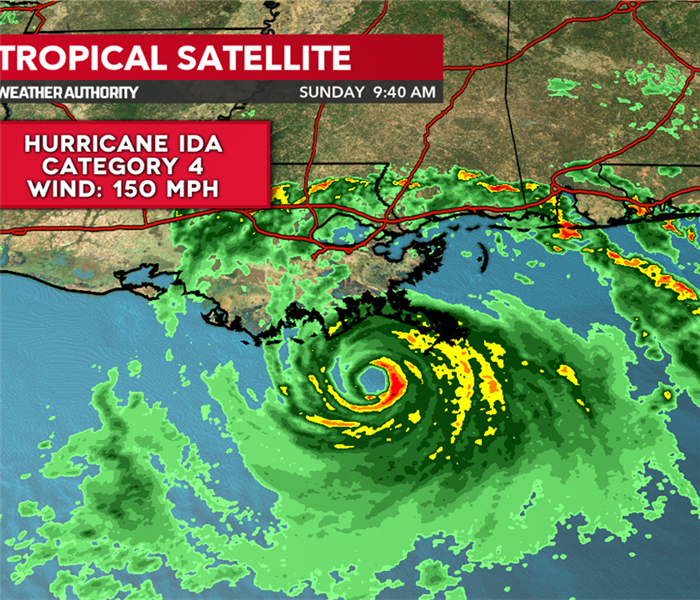 Have a plan and be prepared!
Have a plan and be prepared!
Hurricane season is upon us! Experts say that the hurricane season starts in May and lasts all the way until November on average. Each year is different. However, as on Friday September 10th, it has officially marked its peak of hurricane season for the Atlantic Basin. We have seen during this year there has been 13 named storms, and 5 of those reached a hurricane status and 3 of which became major hurricanes. Here is a list of the 13 hurricanes so far..
1. Ana: Formed near Bermuda on May 22nd
2. Bill: Formed off the East Coast on June 14th
3. Claudette: Formed in the northern Gulf of Mexico June 19th
4. Danny: Formed along the East Coast near Charleston, South Carolina on June 28th
5. Elsa: Formed in the central tropical Atlantic on July 1st
6. Fred: Formed in the eastern Caribbean on August 10th
7. Grace: Formed in the central tropical Atlantic on August 14th
8. Henri: Formed near Bermuda on August 16th
9. Ida: Formed south of Jamaica in the Caribbean on August 26th
10. Julian: Formed far out in the Atlantic on August 29th
11. Kate: Formed in the central, open Atlantic on August 30th
12. Larry: Formed in the far eastern Atlantic on September 1st
13. Mindy: Formed in the northeaster Gulf of Mexico on September 8th
With the knowledge of knowing we have officially hit the peak of hurricane season, here are some tips on how to be prepared for a hurricane in your area.
- Make a plan: If evacuation is necessary, turn off all utilities and follow community disaster preparedness plans. Make sure you select a common meeting place for all family members. Also make sure you have an evacuation plan for your pets.
- Secure the exterior: Trim any large trees and shrubs. Bring in all outside patio furniture, potted plants, bikes and toys inside.
- Install storm shutters: These will protect your windows, doors and skylights with appropriate shutters or impact-resistant glass.
- Check wall hangings and art: Make sure all wall hangings are secure and take notes about your art collection and any existing damage.
- Move your cars: Keep your cars to higher ground or park them in your garage against the garage doors.
- Power up: Fill up your car's gas tank, make sure all cell phones are fully charged, test your generator and always have plenty of fuel ready in case the power goes out.
- Store important documents: Make sure to keep important documents, such as legal papers, birth certificates, marriage license, insurance policy information, and any valuables in a safety deposit box in the closet of your home.
- Prep an emergency kit: You will need to gather any flashlights, portable radio, batteries, non-perishable food, bottled water, cash, blankets, toiletries and clothing.
- Identify a shelter room: This area should be on the first floor in the central part of the house that has no windows.
We here at SERVPRO understand that when disaster strikes, you don't know what will be left from the aftermath. We are always here to help with any mitigation or reconstruction services you may need!
National Preparedness Month
9/13/2021 (Permalink)
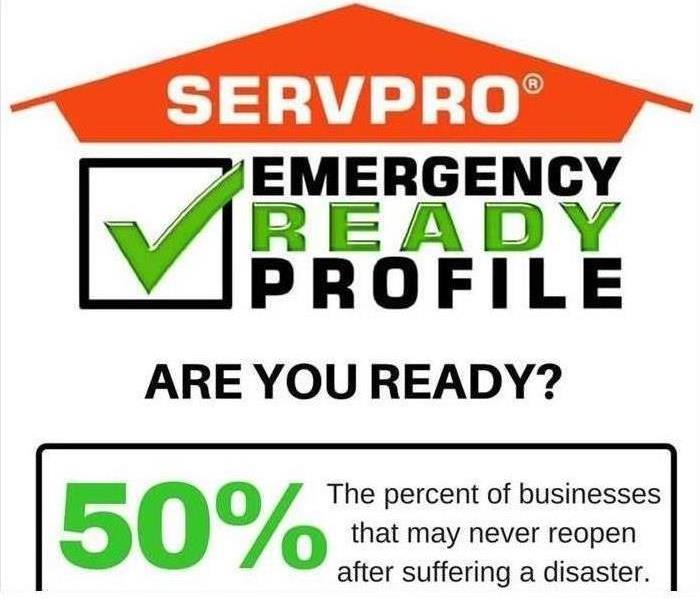 Be prepared!
Be prepared!
As a business owner, insurer or property manager, you are a leader in your community! Therefore, you have the opportunity to set an example to others around you. September is National Preparedness Month (NPM), and this year we are encouraging you all to join your community in preparing for emergencies and disasters. You can do so by leading the efforts to encourage your community to become more prepared as a whole. Disasters WILL HAPPEN, and not only do they devastate neighborhoods, but entire communities including local businesses of all sizes.
As an employer in your community, having a business continuity plan can help protect your company. It can also maximize your chances of recovery after a disaster takes place. There are 3 simple steps to take.
1. Plan to stay in business
2. Encourage your employees to become ready
3. Protect your investment
There are many supporting resources available that can begin to prepare your business for a disaster. We here at SERVPRO can help your business with our Emergency READY Profile (ERP). Here are some of the advantages of our ERP program.
- A no-cost assessment of your facility.
- A concise profile document that contains only the critical information needed in the event of an emergency.
- A guide to help you get back into your building following a disaster.
- Establishes your local SERVPRO franchise professional as your disaster mitigation and restoration provider.
- Identification of the line of command for authorizing work to begin.
- Provides facility details such as shut-off valve locations, priority areas, and priority contact information.
Preparation is KEY to making it through any size disaster, whether it is a small water leak or a large fire. The best time to plan is not when the event happens, but well before it takes places. No one ever plans on a disaster, but you now can plan for it and be prepared. Call us today to set up your very on Emergency READY Profile!
What causes sewage back up!
9/13/2021 (Permalink)
Sewage back ups are very unfortunate events that can happen in any home or commercial property. What causes this type of water damage anyway? Well, typically there are three main categories that a sewer back up happens: damaged sewer pipes, clogs, and tree roots in the sewer system. Let's look at these three areas a bit closer.
- Clogging: Typically if you only have one area of your home that experiences a backup, like a tub or a sink, then there is typically a clog and can be fixed with cleaning the drain. However, if you have the backup in several areas of your home, then there is a blockage at the main or the private that is causing the issue. Unless the blockage is removed, the overflow will continue and will damage your entire home or business area.
- Tree Roots: The roots of large trees in the proximity of a sewer line can often cause severe problems. They can literally grow into the pipes and cause holes and blockages or they may wrap around the sewer line and crush it.
- Damaged Sewer Lines: Older properties with older sewer lines that have not been upgraded can have broken or collapsed lines. All the pipes and sewers in older homes were built using cast iron and clay which can wear off with time, get rusty, and easily break down. Present day plastic sewer lines cannot cause such problems simply because they don’t rust.
Sewage backups are not only hazardous to your health, but they can cause a great amount of structural damage to your home. If you experience a sewage back up do not attempt to flush the toilet. Do not use harsh chemicals to attempt to clean out the drain. This can actually cause more damage and make things worse. Open your windows to let fresh air in. It is also very important to keep pets and children away from the affected area. However, the most important thing to do, is to call for professional help. We here at SERVPRO are always here to help!
Village Hall!
8/9/2021 (Permalink)
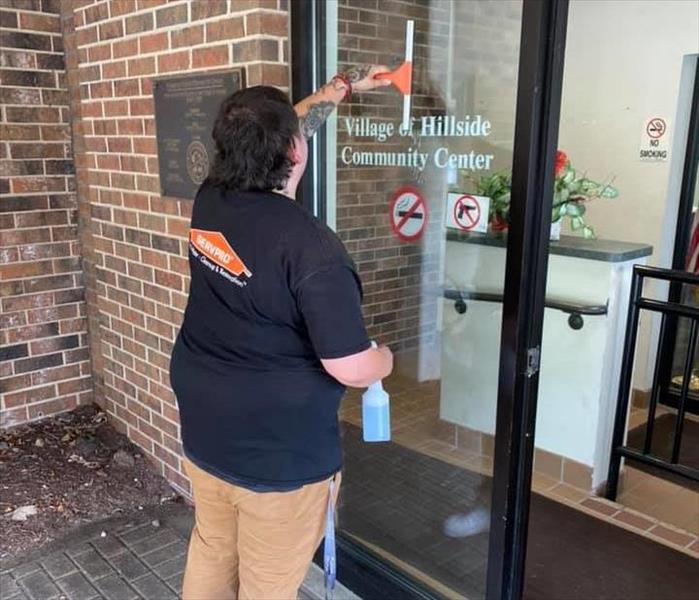 Cleaning and sanitizing the Village of Hillside Community Center!
Cleaning and sanitizing the Village of Hillside Community Center!
With the summer upon us, we are starting to see communities begin to open back up after the devastating of COVID. For example, the Village of Hillside has started to allow their Summer Nights of Hillside to take part again after being shut down for almost 2 years! These summer nights consists of a Car Show, Marketplace, food tents and concert area. The Village of Hillside wanted to make sure they take the appropriate steps when it came to sanitizing and cleaning the areas for the community's safety. We where instructed to clean the Village Community Center which allowed vendors to go and promote their small businesses to the community of Hillside. The police trailer was set out for the band that would be performing that night, and we made sure they also had a case of SERVPRO water. We also sanitized the main lobby of the Village Hall that allowed anyone to come in and take flyers, or any questions they may have throughout the event! It was such a pleasure to not only be able to help out the community of Hillside, but to also get out and enjoy some good music, drinks and food with some pretty awesome people we met throughout the night. We are always here to help, and love to do our part when it comes to commercial buildings in the community.
Tornado Watch: BE PREPARED!
8/9/2021 (Permalink)
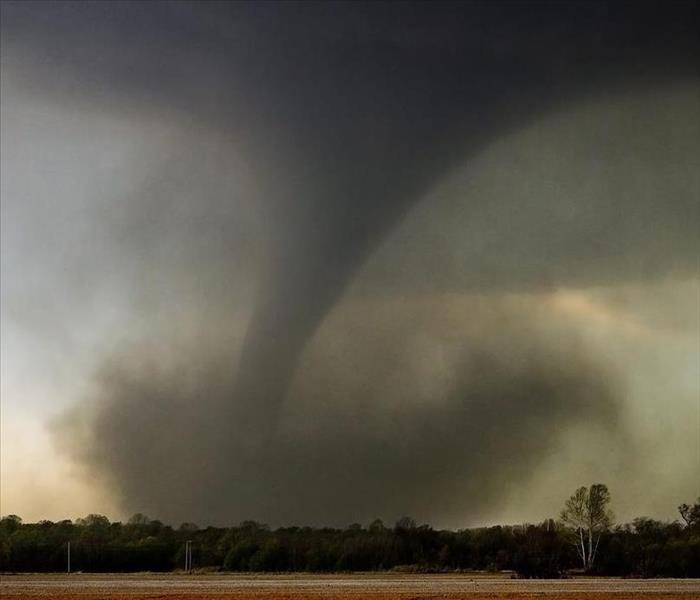 Have a plan!
Have a plan!
There has been ANOTHER tornado watch that has been issued for northern Illinois throughout the afternoon and evening. The watch has been issued until 10PM tonight for over 17 counties in Illinois. Severe storms are possible across northern Illinois and northwest Indiana. There is an area-wide threat for damaging winds, large hail and a couple tornadoes. There will also be heavy rainfall and flooding that can go into overnight. The weather service advises having multiple ways to receive weather warnings. They are also suggesting to have a plan set in place with your family and friends.
When it comes to making a plan for when disaster strikes, it is important to know which types of disasters could affect your area. Make sure to know how you will contact one another and reconnect if separated. Establish a family meeting place that's familiar and easy to find. Make sure to have the following..
1. A way to receive emergency alerts and warnings
2. Shelter plan
3. Evacuation route
4. Family/household communication plan
5. Update emergency preparedness kit
You will next want to consider specific needs in your household. Make sure to discuss your needs and responsibilities and how people in the network can assist each other with communication, care of children, business, pets or specific needs like operating medical equipment. Keep in mind some of these factors when developing your plan:
- different ages of members within your household
- responsibilities for assisting others
- locations frequented
- dietary needs
- medical needs including prescriptions and equipment
- disabilities or access and functional needs including devices and equipment
- languages spoken
- cultural and religious considerations
- pets or service animals
- households with school-aged children
You can never be to prepared when it comes to natural disasters, so please make sure you have a plan in place for when one strikes! Remember that SERVPRO is always here to help to make it look "Like it never even happened." Stay safe!
Fire Safety Tips for Your Pets
7/12/2021 (Permalink)
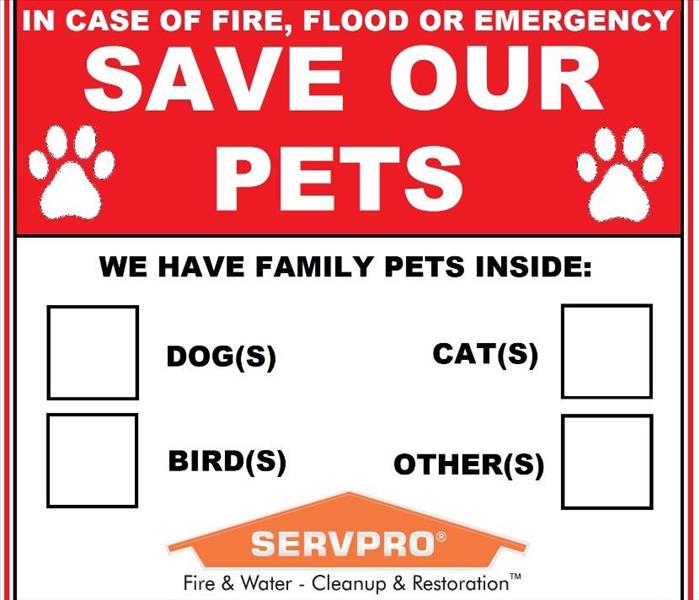 Take action before an emergency takes place!
Take action before an emergency takes place!
An emergency can happen at any moment, and you may never be able to fully prevent such events. However, you can prepare yourself and pets for when emergencies do take place. Here is a list of tips that will help your furry friends when a fire takes place.
- Consider installing monitored smoke detectors! If you live in a fire-prone area, monitored smoke detectors are always a smart choice. This will help the firefighters get a notification, and can respond as quickly as possible. Even if you are not home.
- Make sure to take note where your pets like to nap or hide. This is very important in event that needs evacuation in your home quickly. Remember that pets can be exponentially more difficult to round up if they sense stress. (Especially cats!) Practice crating your pets in advance to make it a positive experience. This will then help prevent them from running when you pull out their crate during any type of emergency.
- You need to have an emergency plan, and practice escape routes with your pet. Make sure to include all members of the family in this plan. Also make sure they know what to do and where to go.
- Have the phone number and address your local animal hospital handy. If your pet is injured, you will need to know where to take them for help ass quickly as possible.
- Make sure to pet-proof your home. Ensure there are no areas where pets can start fires accidentally. This includes stove knobs, loose wires, candles, fireplaces and other potential hazards in your home. Never leave a pet unattended with a lit candle or fireplace.
- If you have to evacuate, make sure to take your pets with you whenever possible. If you leave them behind, they may become trapped or escape and then be exposed to numerous life threatening hazards. In advance, make sure to contact your veterinarian for a list of preferred boarding kennels and facilities. Also, ask your local animal shelter if they provide emergency shelter or foster care for pets. Identify hotels and motels that accept pets, and also ask friends and relatives in your area if they would be willing to take your pet in case of an emergency.
- Get a rescue alert sticker! This easy to use sticker will let firefighters know that there are pets inside your home. Make sure it is visible, and we recommend placing it on or near your front door. This sign will include the types and number of pets in your home.
We here at SERVPRO have teamed up with local fire departments and animal hospitals to provide people with these stickers!
Summertime Tips!
7/12/2021 (Permalink)
Summertime is the perfect chance for you to freshen up the outside of your commercial property, temperatures are finally starting to heat up and signs of summer are rolling in. It also marks that time of year when commercial real estate property owners and managers need ensure that their buildings are ready the seasonal changes in order to avoid unexpected issues or costs.
Inspect your roof – Summer weather leads to strong storms. Keep a close eye on your roof to make sure leaks haven’t developed.
- Clean out gutters– Clean out any debris that’s trapped in your gutters. This is not only good for your gutters, but it also gives your business a well-maintained appearance. Summer often means severe storms, hail and even tornado activity that can put a severe strain on roofing materials. Start the summer out right by getting a professional roof inspection to determine any problems that might have occurred over the winter months. Ice and snow damage may have occurred that isn’t immediately evident. Loose tiles, damage to underlay materials and problems with gutters can lead to more serious problems as the season continues
- Revitalize the exterior– Clean up any trash or yard debris that’s lying around your property. Plant summertime flowers to offer a fresh pop of color. Apply a new coat of paint – or even better, use commercial pressure washing to remove dirt, pollen, and grime. Don’t forget about commercial concrete stains on your drive-thrus and sidewalks.
- Thoroughly inspect surfaces– Walk around your property and make note of any stains or damage on your exterior walls. Call us to come by and see how we can clean up your exterior with commercial pressure cleaning.
- Window maintenance, Winter weather may have damaged the windows on your commercial property, which could lead to higher air-conditioning costs during the summer months. Thorough caulking can prevent leakage of cooled air and save more on energy bills.
SERVPRO of LaGrange Park/North Riverside is here to help with all your commercial property needs. Give us a call at 708-240-4873, and ask about our Emergency Readiness Planning.
Disaster Plan for Your Business
7/8/2021 (Permalink)
 Have a plan!
Have a plan!
When it comes to owning a commercial business, you need to make sure you have a disaster plan in place. Natural disasters don't give you a warning to get out in time, and sometimes you only have minutes to act fast. One natural disaster that most people are not prepared for are earthquakes. Here are 6 steps to prepare you if an earthquake where to take place.
1. Assess the Earthquake Risk of Your Building
You need to get a clear picture about your business' earthquake risk factors. You need to know how ready or NOT ready your business is. It is recommended that all businesses perform risk assessments that find the strong and weak points of your plan. You should also schedule a consultation with an experienced firm to elevate the structural integrity of the building.
2. Create a Disaster Plan
These should be created and distributed to all of your employees beforehand. It is important to include ALL of you employees as you are developing a disaster plan. This way they if they notice any signs of an earthquake, they will know exactly what to do. Some of the things your disaster plan should include are:
- Contact information for all employees
- Communication plan
- Talk with employees with disabilities and make arrangements
- Hotline or text message system
- Schedule regular earthquake response drills to practice
- Emergency kit
- Safety checklist
3. Identify Your Building's Potential Structural Issues
Every business is different, and there is no one-size-fits-all approach. You will need to evaluate every aspect of your business and make preparations that are unique to your building's property. You need to understand the risks and take specific actions to help prevent earthquake disasters for your business, and to also protect your staff.
4. Bring in Expert Advisors
You can't afford to waste your time on hearsay or just anyone's word. Your business, life, and the lives of your employees and customers depends on doing things correctly and being truly prepared. Make sure you choose a reputable earthquake retrofitting contractor based on years of experience and high ranking results. This way it can translate to lives and business saved in those areas.
5. Develop a Comprehensive Emergency Communications Plan
Keeping your business in business after an earthquake often depends on effective communication. Be sure you have a plan in place that takes everyone into account. This includes your employees, your customers and your suppliers. Make sure you set up a backup communications plan that enables you to keep lines of communication open, even if you are unable to access your building. Make sure you employees know who to contact before hand so they aren't calling people they shouldn't have to call. Maintain an emergency contact list with police, fire, ambulance, hospital and other emergency services that employees know how to access quickly. Also, have your insurance company and attorney's numbers in a secure place.
6. After the Earthquake
Remember that it might not be readily apparent whether your building is safe after an earthquake takes place. There are usually aftershocks for hours and days afterward. Be sure to contact an experienced expert first for an earthquake damage safety assessment before you allow employees and customers back into the building.
Summer BBQ Grilling Safety Tips
7/8/2021 (Permalink)
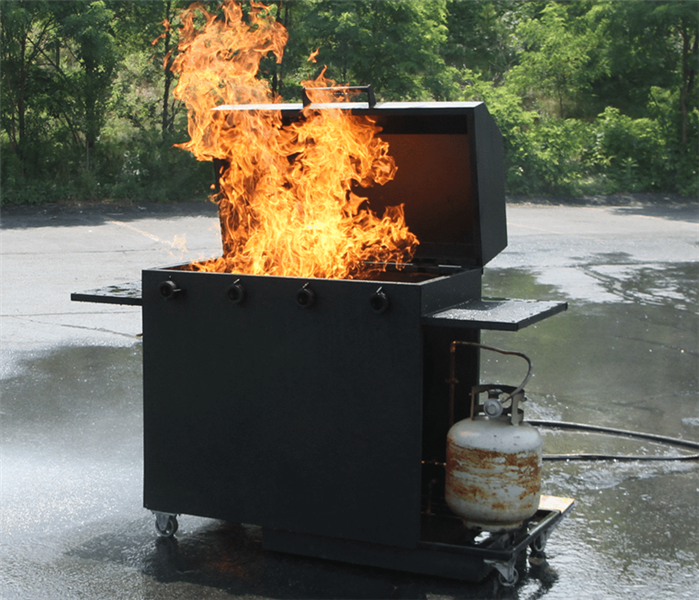 Fire safety for summer BBQ's!
Fire safety for summer BBQ's!
Grilling outside on a hot summer day is one of the most popular cooking methods in the summer. However, each year in the U.S. there are 10,200 home fires that are caused by outdoor grills. According to the National Fire Protection Association, July is the peak month for grill fires. Grill fires can start easily and spread quickly when the gas or charcoal is placed too close to any fire hazards. Here are 9 grilling safety tips for your summer BBQ's.
1. Only use grills outside
You might think it is okay to grill inside of your open garage or under a covered balcony, but propane and gas, charcoal grills are strictly designed for outdoor use where there is plenty of ventilation. If there is any combustible materials that surround or hang over the grill, it can catch fire easily and quickly. Make sure that the area over top and around the grill is clear.
2. Place your grill away from your home
BBQ grills are often placed just outside the back door or on the back deck. You should avoid placing your grill in these areas because it can pose a potential fire hazard. Grills that are placed too close to the house or wood structures can heat up adjacent materials and cause a fire to start. You want to make sure you keep at least 10 feet from your home or other structures.
3. Make sure your grill is located on a flat and level surface
If you place your grill on a slope or other uneven surfaces, it can tip over easily and cause a fire. Make sure that your grill is et up on a stable surface such as a concrete pad so it remains level while in use.
4. Check your grill for leaks
If you store your grill inside during the winter, make sure to check it over thoroughly when grilling season in the summer begins. A leak in the gas lines can cause propane or natural gas to build up inside when the lid is closed. Check the gas lines to make sure that they are free of leaks before using the grill. Make sure you also always open the lid of your grill before lighting.
5. Always clean your grill after use
When you BBQ regularly, it causes grease to build-up on the grill plates and collect inside the grease tray. If it is not cleaned, the build-up can then act as fuel and catch fire while the grill is in use. Clean your charcoal or gas grill after each use with a grill brush and empty the grease tray when it begins to fill up.
6. Never leave your brill unattended while in use
Never leave the grill unattended while you are cooking food. Grills use high heat and open flames to cook food, and when left unattended can become a safety and fire hazard. If you have to leave the grill, ask another adult to watch the grill for you.
7. Wear appropriate clothing
Clothing that has long sleeves or pieces that dangle can catch fire easily when too close to an open flame. When grilling food, wear clothing that won't interfere with the cooking process. Also, make sure that any apron strings are tied back away from the front. If a piece of clothing does catch fire, remember to stop, drop, and roll to extinguish the flames quickly.
8. Keep a spray bottle on hand
It is common for grills to flare up as fat drips from meat as it is cooking. This can cause a section of the grill to remain on fire as it burns away. If left alone, the flames will continue to burn and cause excess smoke to billow out from under the lid. Make sure you keep a spray bottle filled with water beside your grill so that you can quickly extinguish smaller flames before they begin to spread.
9. Always have a fire extinguisher close by
If a fire where to break out, follow these tips on how to put out a grill fire and ensure you have First Alert EZ Fire Spray within reach. It is simple to use, just point and spray to extinguish the fire. The spray is also quick and easy to clean up after use. It's small, compact size makes it the perfect addition to your grilling set to help keep your loved ones safe.
Following these safety tips and having the right protection will help you and your family enjoy a safe grilling season this summer!
Midwest Tornado & Flood
7/7/2021 (Permalink)
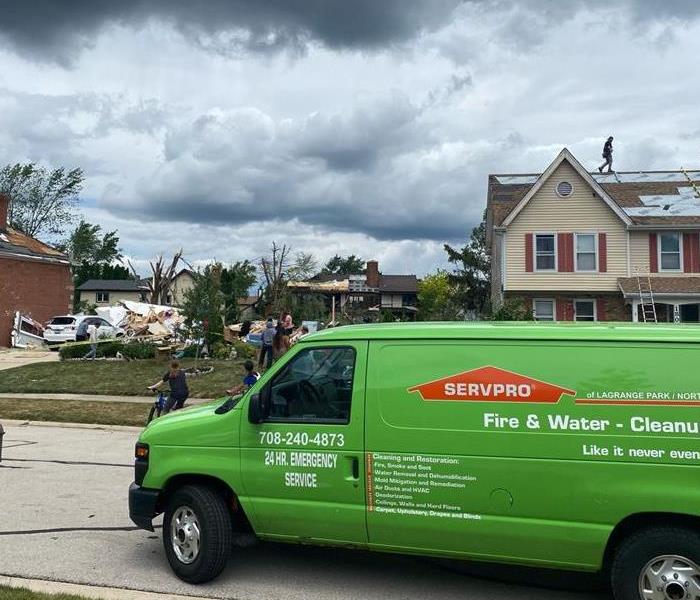 Serving the community!
Serving the community!
Living in the Midwest, you don't hear of many tornadoes coming through the area. If they do, they are mostly more south and don't cause much damage. However, disaster struck two of our suburbs in the middle of the night. The only time we usually hear the tornado sirens go off is when the first Tuesday of the month comes around. However, this was not the case this time. Once the morning hit, we where all able to see the disaster that the tornado has caused to residential homes. There where trees in homeowner's yards that where not there's, trampolines through the side of homes, cars completely smashed, and even an entire home was destroyed. We here at SERVPRO knew that the community needed our help. We immediately stationed our crew in two suburbs that where affected the most, and just handed out water and snacks to anyone that was in need of them. We could see the devastation on people's faces, and all we wanted to do was help as much as we could.
Following the tornado that hit, we then received major flood warnings for almost two weeks. On top of all the homes having property damage to them, they where now dealing with heavy rain fall coming into their homes. This is where our storm team kicked it into gear. Our crew is working around the clock to help restore people's homes, and to give them guidance on what the next step is to take because of these disasters. We can't be more proud to help support our communities during this time. This is why we stand by our saying of being "Faster to Any Size Disaster".
1 Year Anniversary!
5/3/2021 (Permalink)
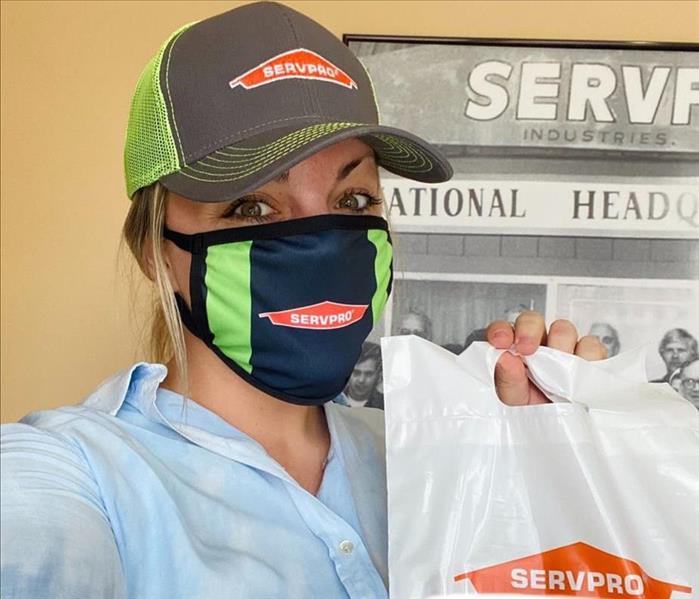 Thank you!
Thank you!
When thinking about what I wanted to do with my life as an undergraduate at DePaul University, I wasn't too sure. I had secured my Associate's Degree in Sociology and Psychology, and was entering my master's program at DePaul. This was when I decided to change my studies to marketing, and dive deeper into that field. After graduating with MS from DePaul, I was approached by a friend to look into working for the marketing team at SERVPRO. I had zero knowledge when it came to what SERVPRO did outside of the basic gist of the company. On top of that, I then was trying to work through a pandemic!! What a crazy time it was, but I recently hit my one year anniversary here at SERVPRO and I decided to reflect on the past year. During the pandemic, I was able to train more and get better knowledge of what SERVPRO does day in and day out. As things started to open back up, I was confident in my marketing and sales ability to tackle the daily routes. I now have a terrific relationship with all of our local first responders! We work alongside them when it comes to free COVID sanitations to their departments in order to keep them safe, and with community events by bringing fire safety tips and tricks. I have built so many wonderful and beautiful relationships during my one year anniversary, and some have even become friends that I hangout with on the weekends. I can't thank my marketing team and owner enough for giving me the opportunity to develop not only my work skills, but also as a person. THANK YOU SERVPRO!
What to expect with the unexpected
4/2/2021 (Permalink)
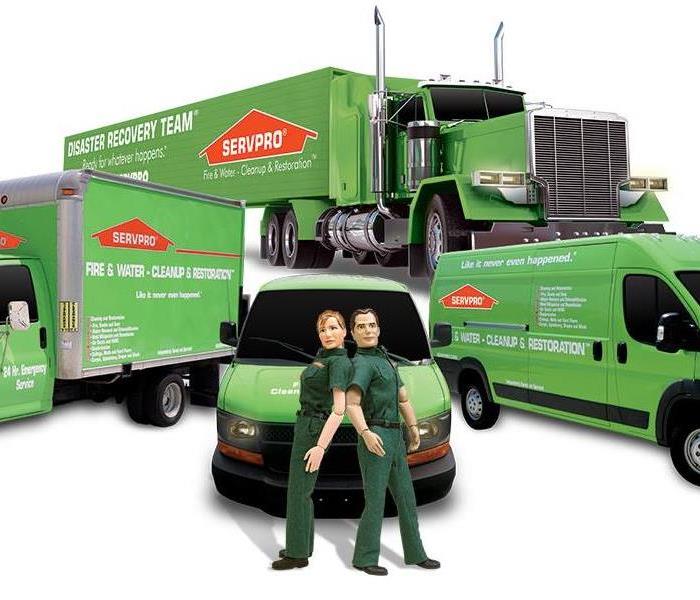 Call us today 708-240-4873
Call us today 708-240-4873
SERVPRO of LaGrange Park/North Riverside is available 24 hours a day for water emergencies, large or small. When you are dealing with water damage, immediate action is crucial. A delay of just a few hours can greatly increase the severity of the water damage.
We Answer the Phone Ready to Help
We understand that when you call us, you may be feeling confused, stressed, and vulnerable. You need an expert to guide you through this crisis. SERVPRO of LaGrange Park/North Riverside has the specific water damage training and experience to help you through this tough time. We specialize in water damage restoration—in fact, it's the cornerstone of our business.
What to Expect
When you call, we will ask several questions regarding your water damage emergency. These questions will help us determine what equipment and resources to bring, including how many trained SERVPRO Professionals may be needed.
Our SERVPRO Representative will ask several questions:
- Your name and contact information
- Your insurance information (if applicable)
- The street address of the water-damaged home or business
- When did the flooding or water damage occur?
- What caused the water damage (if known)?
- Is there electricity available (on-site)?
Spring Cleaning!
4/2/2021 (Permalink)
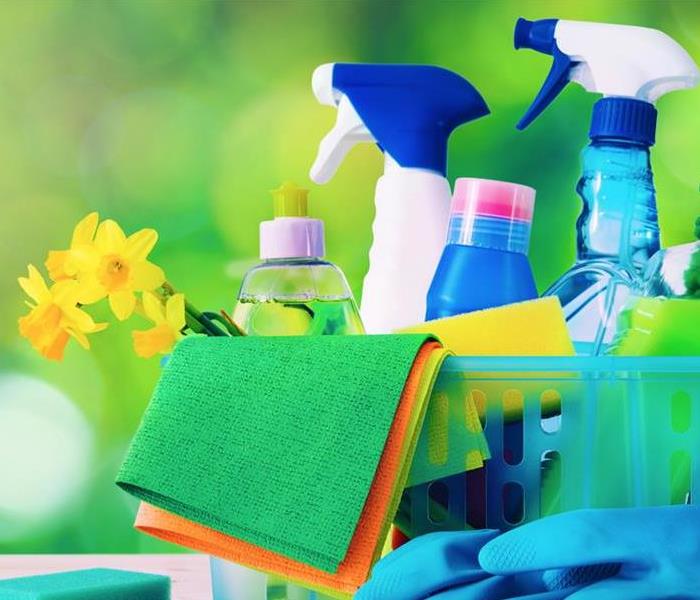 Call us today 708-240-4873
Call us today 708-240-4873
Spring cleaning time is here again, and a great opportunity to clean and organize your living spaces.
Here are some great tips to freshen up your home and make is sparkle:
Wipe off a dirty faucet.
To get rid of lime buildup, make a paste of 1 teaspoon vinegar and 2 tablespoons salt. Apply to sink fixtures and rub with a cloth.
Tidy up a toilet.
Pour a cup or more of diluted white distilled vinegar into the bowl. Let sit several hours or overnight. Scrub well with a toilet brush and flush.
Eliminate odors.
Swab plastic containers with a cloth dampened with vinegar.
Freshen up the fridge.
Clean the shelves and walls with a solution of half water and half vinegar.
Battle litter-box odor.
Cat litter can leave behind an unwelcome smell. Eliminate it by pouring a half-inch of white distilled vinegar into the empty litter box. Let stand for 20 minutes, then rinse with cold water.
Steam away a microwave mess.
Fill a small bowl with equal parts hot water and vinegar, and place it in the microwave on high for 5 minutes. As the steam fills the microwave, it loosens the mess, making clean up a breeze.
Remove wax.
If you get melted candle wax on your wood furniture or floors, gently wipe it away with a cloth soaked in a solution of equal parts white vinegar and water.
Erase crayon.
If your kids get crayon marks on the walls or floor, dip a toothbrush in white vinegar and gently scrub. The vinegar breaks down the wax, making for an inexpensive, nontoxic way to clean up after children.
Restore showerhead pressure.
If your shower-head gets clogged with mineral deposits, soak it for 15 minutes in a mixture of ½ cup vinegar and 1 quart water.
Another great do it at home cleaning solution is baking soda. Baking soda is great to freshen up stale and stinky smells in the home.
Here are some tips from Better Homes and Gardens for uses of baking soda around the house:
Stale-smelling sponges
Soak these kitchen staples in baking soda and water to freshen them up so you can use them a little longer.
Musty upholstery and carpets
Deodorize the soft, cushy places around your house by sprinkling surfaces with baking soda, letting it sit for 15 minutes, and then vacuuming it up.
Grimy toys
Naturally fight the effects of your little one's grubby hands by wiping them with a sponge dipped in a baking soda and water solution.
A mildew-y bathroom
Scrub your tub, tile, sink and shower curtain with a damp sponge and baking soda. Rinse to reveal gleaming surfaces.
A messy grill
Combat a summer's worth of cookout grime by sprinkling some baking soda on your grill-cleaning brush before you scrub away.
Finally, one of my favorite non chemical cleaning items is to use lemon. Lemons are a natural, mild disinfectant, and a quick trip to the store and you have a powerful cleaning weapon with no worries about chemicals.
According to thekitchn.com, lemons are "nature's little hand scrubbers". Here are some of their useful tips on how to use lemon in your spring cleaning:
Clean Wood Cutting Boards
Apply salt: Sprinkle the cutting board with coarse salt.
Scour the surface: Using a lemon half with the cut side down, scour the surface, squeezing slightly to release the lemon juice as you go.
Let sit, then scrape off: Let sit for 5 minutes, and then scrape the gray, dirty liquid into a small bowl using a bench scraper, and discard.
Rinse: Give the surface a final rinse with a clean wet sponge.
Smoking in the home
3/12/2021 (Permalink)
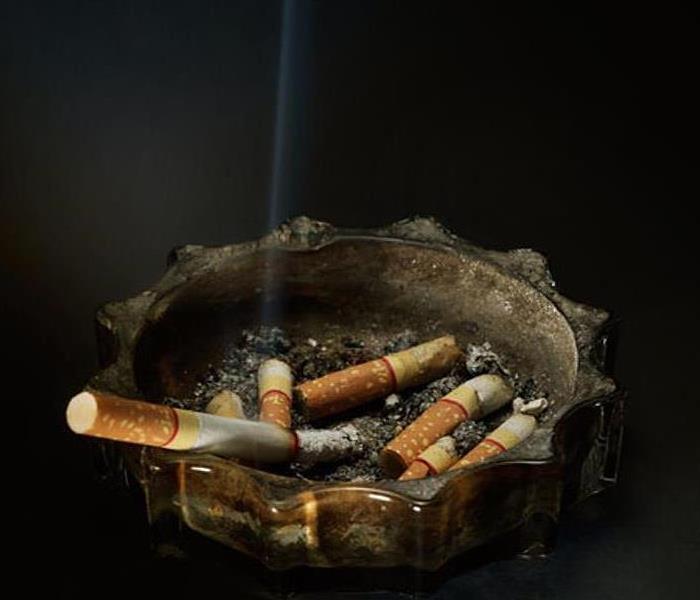 Emergency Service Response 24/7
Emergency Service Response 24/7
According to the National Fire Protection Association, smoking materials that include cigarettes, pipes, and cigars started an estimated 17,200 home structure fires. This was reported from U.S. fire departments. Amongst these 17,200 estimated fires, these fires cause 570 deaths, 1,140 injuries and $426 million in direct property damage. It was also reported that smoking materials caused 5% of reported home fires, 21% of home fire deaths, 10% of home fire injuries, and 6% of the direct property damage. According to the NFPA, most deaths in home smoking-material fires were caused by fires that started in bedrooms or in living rooms, family rooms or dens. It is also a face that the risk of dying in a home structure fire caused by smoking materials rises with age.
With that being said, it is encouraged to use smoking materials outside of the home. Designate a "smoking area" such as the garage or outside. This will help eliminate the risk of a fire starting in the actually home.
Melting snow floods basements
3/12/2021 (Permalink)
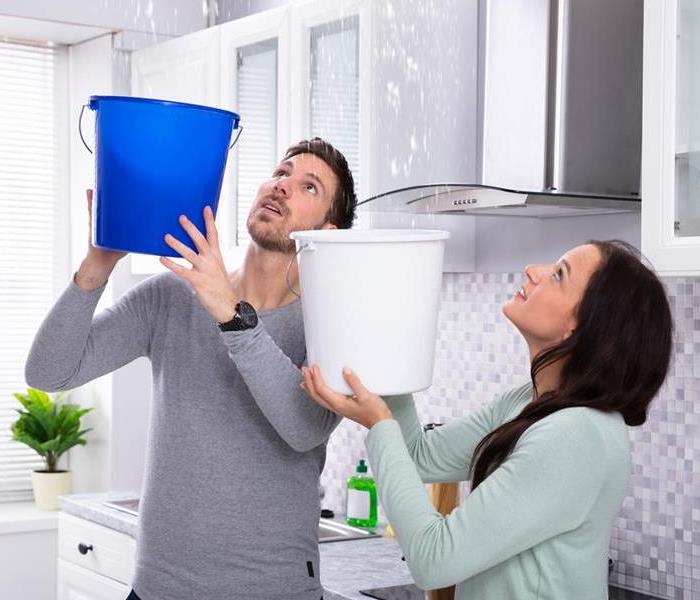 Here are some tips!
Here are some tips!
As we begin to enter Spring season, the process of snow melting can cause water damage to homes and businesses. This will then lead to flooding. It could be minor or major, but still cause water damage problems. Here are some ways to help prevent water damage as we enter this spring thaw out season. Now, you may not be able to prevent water damage under ever circumstance, but you can prepare your home ahead of spring-thaw months to prevent common causes of damage.
1. Basement pumps- install a sump pump or sewer backflow value and keep a battery-operated backup in case of power failure. Also, make sure to consider installing a water alarm that warns when water is accumulating in your basement.
2. Basement storage- Make sure to keep valuable items out of your basement. Removing any electronics or stored valuables from your basement prior to spring-thaw warnings could prove to be an important ounce of prevention.
3. Debris removal- Be sure to remove debris from window wells, gutters and downspouts.
4. Doors and windows- Check for any leaks around doors and windows.
5. Exterior walls- Keep all exterior walls of your home well painted and sealed.
6. Flood drains- If you have flood drains, make sure they work properly.
7. Foundation cracks- Make sure to inspect your foundation for cracks that will allow water seepage and initiate repairs.
8. Fuel tanks- Permanently anchor any fuel tanks.
9. Grading- inspect the grading around your home and make any changes. Design the grading to encourage the water to flow away from your home.
10. landscaping- Make sure to trim trees and bushes away from your home and do not store wood or compost piles nearby.
11. Roof- Keep your roof in good repair. Unless a tree falls on your roof during a storm, most insurers expect you to maintain your roof to prevent water leaks caused by snow melting or torrential downspouts.
Whether you are able to control the situation or not, we here at SERVPRO are always here to help you get your home or business back to like the disaster never even happen. That is way we are always here to help!
Frozen Pipes
1/31/2021 (Permalink)
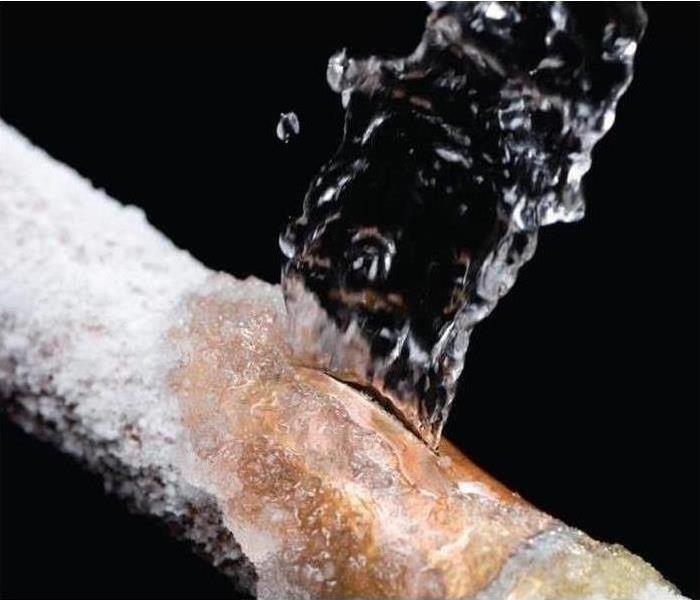 Frozen Pipe
Frozen Pipe
Thawing a frozen pipe the correct way is crucial to minimizing the damage. In order to thaw a frozen pipe, you need to first determine which pipe or pipes are frozen. You can do this by turning on the faucets, and if no water comes out or only a slight trickles out, then you have a frozen pipe. Before you begin attempting to thaw a frozen pipe, you need to open the faucet that the pipe feeds water into. You need to make sure to open both the hot and cold handles. This then will help relieve pressure in the system, and then will allow the water to escape once you begin to thaw the pipe. When beginning to thaw the pipe, you should always start near the faucet then work your way down to the blockage. This will help ensure that the melting ice and steam is able to escape through the open faucet. If you start the thawing process closer to the blockage, the melting ice could get stuck behind the blockage, creating more pressure in the pipe and increasing the chances the pipe will burst. When it comes to thawing the frozen pipe, you could use a hair dryer, heat lamp or portable space heater, hot towels, or electrical heating tape. If the frozen pipe is enclosed, you will need to either turn the heat up in the property, infrared lamp, or cut out a section of the wall to thaw out the frozen pipe/pipes. Remember NEVER attempt to thaw a pipe using an open flame. This can not only damage the pipe, but it can also start a fire in your property. If the frozen water pipe does burst, the first thing you should do is shut off the main water line into your property. This then will prevent additional water from flowing and damaging your property. Then you will need to call a professional, like SERVPRO, to help fix the problem. Therefore, in order to help prevent frozen pipes make sure to keep the heat on in the home, allow faucets to drip slightly, keep all interior doors open, seal up holes and cracks, add extra insulation, and remove exterior hoses and shut off interior valves feeding those hoses.
Continuing Education Classes
1/14/2021 (Permalink)
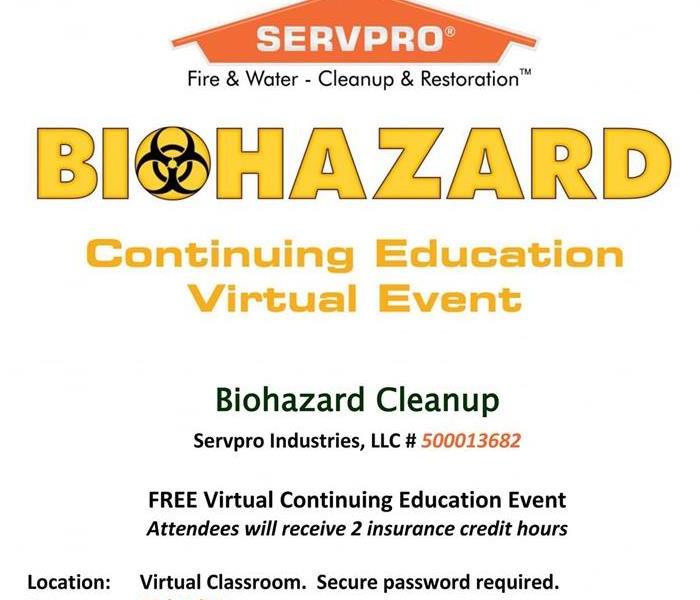 Upcoming Class!
Upcoming Class!
Every year, SERVPRO of Elmhurst provides continuing education in the areas of water, fire and mold mitigation. Education increases the opportunity for the community of professionals responsible for helping you when disaster strikes: The more you informed the community of first responders, the better able to help limit damage, save important personal belongings and control costs during a time of crisis.
At SERVPRO of Elmhurst, we work with adjusters, insurance agents, real estate agents, brokers, home inspectors, and office professionals by providing state-sanctioned Ethics Classes. Raising the bar when it comes to how people are treated especially in the time of need to protect their homes and personal belongings is essential to the insurance claim process.
Our goal is to make it "Like it never even happened." As a recent client said, "the whole clean up and insurance process was as painless as it could have been."
Check in with us on our upcoming classes. We are now offering virtual CE classes!
Why choose us
1/14/2021 (Permalink)
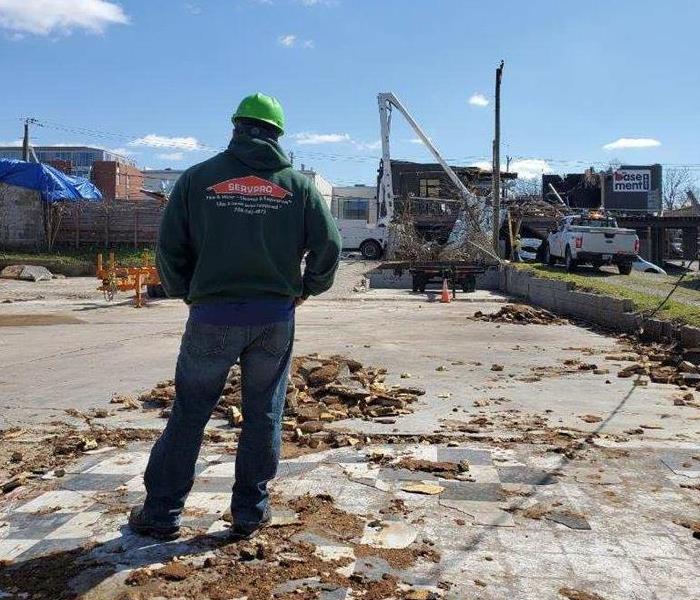 SERVPRO
SERVPRO
SERVPRO of LaGrange Park/ North Riverside specializes in storm and flood damage restoration. Our crews are highly trained and we use specialized equipment to restore your property to its pre-storm condition.
Faster Response
Since we are locally owned and operated, we are able to respond quicker with the right resources, which is extremely important. A fast response lessens the damage, limits further damage, and reduces the restoration cost.
Resources to Handle Floods and Storms
When storms hit the Berwyn, IL land area, we can scale our resources to handle a large storm or flooding disaster. We can access equipment and personnel from a network of 1,650 Franchises across the country and elite Disaster Recovery Teams that are strategically located throughout the United States.
Have Storm or Flood Damage? Call Us Today 708-240-4873
Commercial Property
1/10/2021 (Permalink)
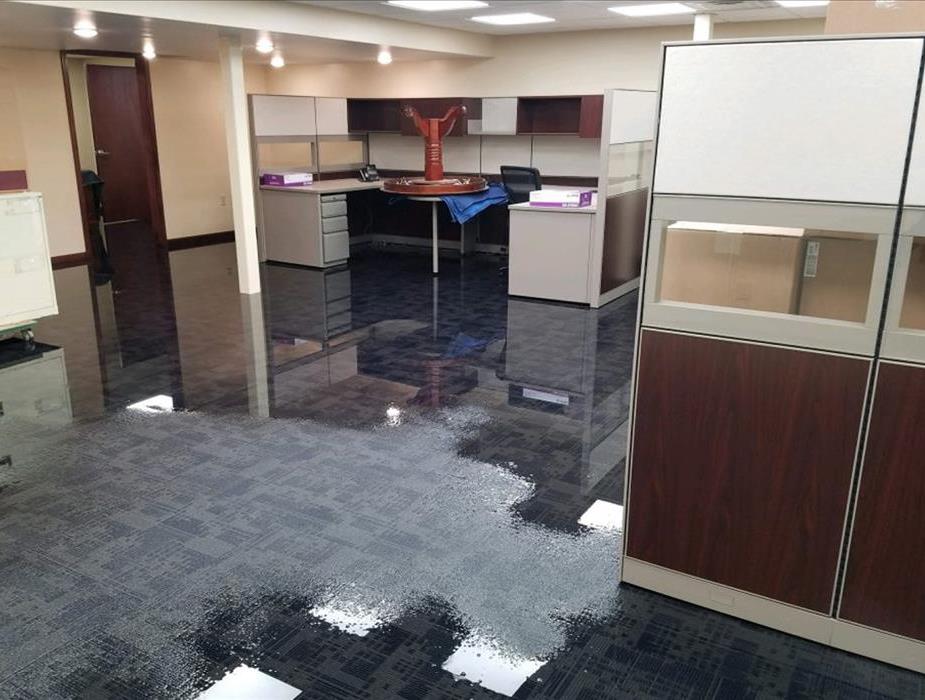 Water Damage
Water Damage
You want your business to make as much profit as possible, but you may be losing money without even realizing it. Leaks from damaged pipes, as well as other areas, are a common source of trouble in many buildings. It is important to perform regular inspections to make sure everything is in top condition. Here are a few problems that might end up costing you money.
1. Damaged Roofing
Leaking pipes are not the only potential source of excess water. The roof is an important part of the structure of your business, as it protects you from severe weather and keeps the inside of the building dry. However, if you do not properly maintain your roof, you could end up with a lot of damage. In some cases, the structure of the building may weaken or a mold growth might develop. Make sure to regularly check the condition of your building and perform repairs as needed.
2. Broken Appliances
Another common source of water is from broken appliances. The damage here can range from a small leak to a lot of flooding. One way to prevent this is to test your equipment regularly to ensure it is in proper working condition. As items begin to age and break down, replace them to prevent any significant problems.
3. Pipes and Plumbing
Damaged pipes can sometimes be a hidden source of wasted water and money. If you are not performing regular maintenance, a persistent leak could end up costing hundreds or thousands of dollars in extra water bills. Leaks can also indicate aging pipes that could cause a lot of damage if not replaced.
Performing regular maintenance in your building is a great way to locate problems and prevent big issues from leaks or damaged pipes. If you do experience damage, however, a water restoration company can perform necessary repairs to your building and belongings.
Chicagoland Winter Storms
1/7/2021 (Permalink)
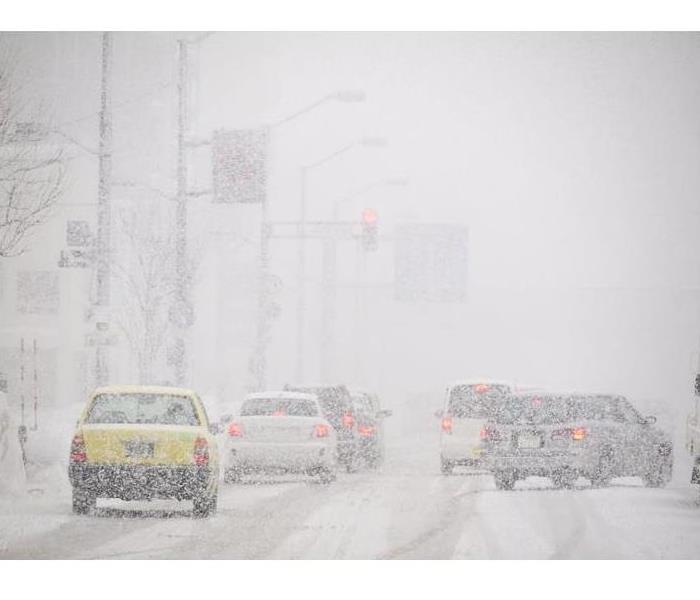 Be prepared!
Be prepared!
Protecting your home is vital in the winter months. A frozen water pipe can burst and flood your house. An ice dam in your gutter can cause water to seep into and saturate an interior walls of your home. Here is a list from Nationwide insurance that they advise their homeowners on during the winter months to prepare their homes for the cold.
- Clean out the gutters, disconnect and drain all outside hoses. If possible, shut off outside water valves.
- Insulate walls and attics, and caulk and weather-strip doors and windows.
- Repair roof leaks and remove tree branches that could get weighed down with ice or snow and fall on your house – or your neighbor's. (Avoid liability for the latter.)
- Wrap water pipes in your basement or crawl spaces with insulation sleeves to slow heat transfer.
- Consider an insulated blanket for your hot water heater.
- If you have a fireplace, keep the flue closed when you're not using it.
- Have a contractor check your roof to see if it would sustain the weight of a heavy snowfall.
- Make sure your furniture isn't blocking your home’s heating vents.
- During cold spells, keep cabinet doors open to allow warm air to circulate around pipes, particularly those in the kitchen and bathrooms.
- Keep a slow trickle of water flowing through faucets connected to pipes that run through unheated or unprotected spaces.
- If your house will be unattended during cold periods, consider draining the water system.
- Avoid ice dams– where water from melted snow refreezes in the gutters and seeps in under the roof, soaking interior walls. Here’s how:
- Ventilate your attic.
- Insulate the attic floor well to minimize the amount of heat rising through the attic from within the house.
- Consider having a water-repellent membrane installed under your roof covering.
If you do find that you have damage to your home, the Insurance Information Institute has published some tips on what to do in the case of a winter storm and managing the damage to your home.
- Take pictures of the damage immediately. If you have "before" pictures, that's even better. Those pictures will help ensure that your insurer cannot claim that the problem was preexisting.
- Make temporary repairs to keep the damage from getting worse but hold on to all of your receipts.
- Don't make pricey repairs before the insurance adjuster arrives.
- Don't assume something is not covered. Take out your policy. Most weather-related damage like burst pipes, a collapsed roof and ice dams are covered.
- Call a reputable company to come and help with any damages to your home. Choose a company that will work with your insurance company.
SERVPRO of LaGrange Park/North Riverside is here to help in your time of need for all your winter storm damage needs. Give us a call at 708-240-4873. We work with your insurance companies to make it “Like it never even happened.”
Lending a helping hand
1/5/2021 (Permalink)
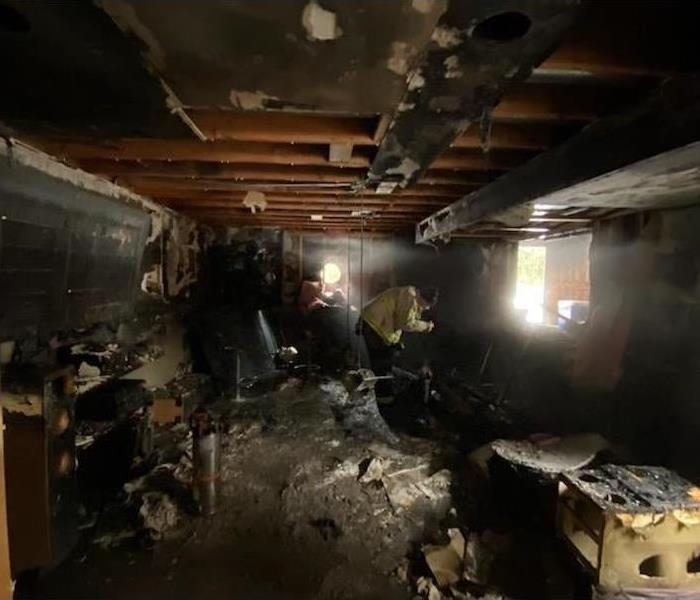 Residential Fire Damage
Residential Fire Damage
We have a really great relationship with our local fire departments, and follow their social media pages. After scrolling through our daily feed, we came across the Addison Fire Department's post about a local fire. What stood out about this post was that our local fire department and other FDs went to help with this major residential fire that took place. The AFPD responded to a house fire, and the smoke detectors did their job by alerting the family of the fire. They were all able to escape safely. They were very thankful for the help from the Wood Dale FPD, Elmhurst FD, and Itasca FPD for coming out to help. The family had told the firefighters that there were two guinea pigs in the home, and they were able to find and save them. The guinea pigs received O2 therapy and vigorous rubbing, and both where successfully resuscitated. The fire started in the basement, and the heat and smoke rose up throughout the house. They enforced to make sure your smoke detectors are working, and the batteries are changed! They also stated to make sure you keep your bedroom doors closed when sleeping, and try not to risk your life to save a pet. That is what the firefighters are for, and they will do their best to rescue them.
The main take away from this message was to always make sure to test your smoke detectors at least once a month, and the batteries should be replaced at least once or twice a year. Also, a huge shoutout to our local fire department for helping out a different fire department in order to get everyone out safely, along with the pets.
Toys for Tots
12/7/2020 (Permalink)
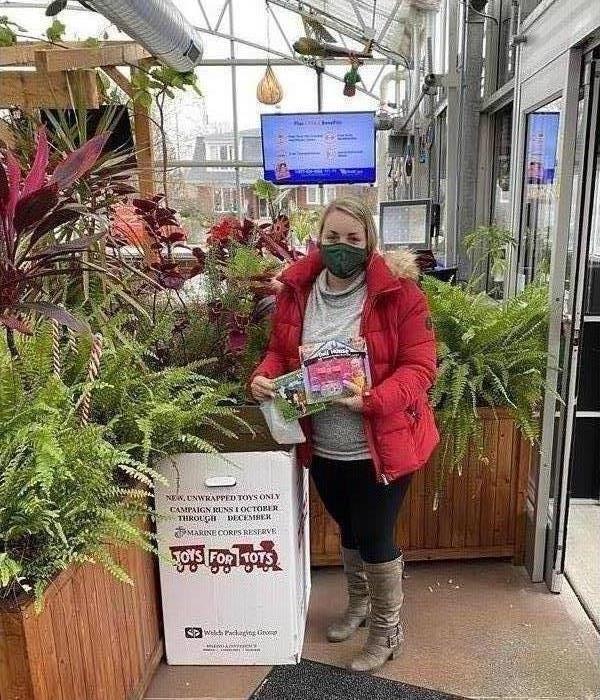 One of our marketing representatives Sabrina donating toys!
One of our marketing representatives Sabrina donating toys!
Toys for Tots is such a huge donation event that happens every year around Christmas time. The mission of the Marine Toys for Tots Program is to collect new unwrapped toys and distribute those toys to less fortunate children at Christmas. The primary goal is to help bring the joy of Christmas and send a message of hope to America's less fortunate children.
In order to better execute the program, in 1991 the Marine Toys for Tots Foundation was created at the behest of the Marine Corps. It is an IRS recognized 501(c)(3) not-for-profit public charity group. It is governed by a board of directors, all of whom are veteran Marines and successful business leaders from throughout the nation. The foundation's professional staff is headquartered in the Cooper Center, which is located just outside of the Main Gate of Marine Corps Bass about 35 miles south of Washington D.C..
The Marine Toys for Tots Program collected and distributed 19 million toys to 7.3 million less fortunate children in the past year allowing them to experience the joy of Christmas and receive a message of hope that otherwise would not have been there. This community action program took place in over 800 communities covering all 50 states, the District of Columbia, Puerto Rico, and the Virgin Islands.
We here at SERVPRO of Elmhurst, Arlington Heights/Prospect Heights, and Lagrange Park/N. Riverside, took part in helping donate over 30 toys to 15 different drop off locations this year. We want to help do our part in the community by giving children in need the feeling of joy on Christmas when it comes to unwrapping presents and seeing an awesome toy. This was such a humbling experience for our team, and cannot wait to take part again next year!
Ice Damming
12/1/2020 (Permalink)
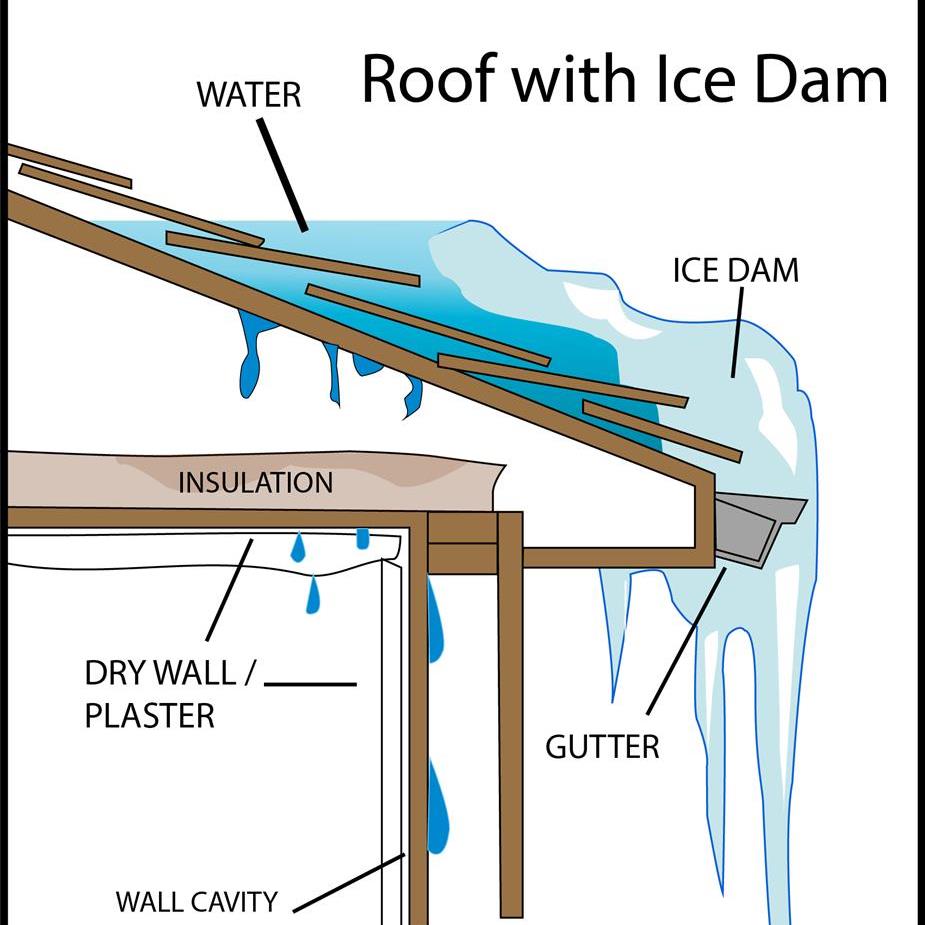 Ice Damming
Ice Damming
When looking at roofs this winter, icicles hanging along them may look beautiful but can be very dangerous. This is because the icicles forming and snow on the roof can lead to ice dams. These are thick ridges of solid ice that build up along the eaves. Dams can tear off gutters, loosen shingles, and cause water to back up and pour into the building or home. In result, this can lead to peeling paint, warped floors, stained and sagging ceilings. Also, soggy insulation in the attic, which loses R-value and becomes a magnet for mold and mildew.
Here are some ways in order to prevent ice dams. The first is to use heated cables. Attach these with clips along the roof's edge in a zigzag pattern, and the heated cables help prevent ice dams that lift shingles and cause leaks. This solution allows you to equalize your roof's temperature by heating it from the outside instead of blowing in cold air from the inside.
Next is to blow in cold air. Hacking away at ice dams with a hammer, chisel, or shovel is BAD for your roof. Also, throwing salt on them will do more harm to your plantings than the ice. Therefore, take a box fan into the attic and aim it at the underside of the roof where water is actively leaking in. This targeted dose of cold air will freeze the water in its tracks.
You can also rake it by pulling off snow with a long-handled aluminum roof rake while you stand safely on the ground. A rake with wheels will instantly change the exterior temperature of your roof without damaging shingles.
De-icing methods deal with diminishing the damage after the dam has formed. Fill the leg of a discarded pair of panty hose with a calcium chloride ice melter. Lay the hose onto the roof so it crosses the ice dam and overhangs the gutter. You can use a long-handled garden rake or hoe to push it into position. The calcium chloride will eventually melt through the snow and ice and create a channel for water to flow down into the gutters or off the roof.
Lastly is a permanent fix for ice dams. Getting ride of ice dams for good is simple. Just keep the entire roof the same temperature as the eaves. This is done by increasing the ventilation, adding insulation, and sealing off every possible air leak that might warm the underside of the roof.
1. Ventilate Eaves and Ridge
- A ridge vent paired with continuous soffit vents circulates cold air under the entire roof. Both ridge and soffit vents should have the same size openings and proved at least 1 square foot of opening for every 300 square feet of attic floor. Place baffles at the eaves to maintain a clear path for the airflow from the soffit vents.
2. Cap the Hatch
- An unsealed attic hatch or whole-house fan is a massive opening for heat to escape. Cover them with weather stripped caps made from foil-faced foam board held together aluminum tape.
3. Exhaust to the outside
- Make sure that the ducts connected to the kitchen, bathroom, and dryer vents all lead outdoors through either the roof or walls, but never the soffit.
4. Add insulation
- More insulation on the attic floor keeps the heat where it belongs. To find how much insulation your attic needs, check with your local building department.
5. Install sealed can lights
- Old-style recessed lights give off great plumes of heat and can't be insulated without creating a fire hazard. Replace them with sealed "IC" fixtures, which can be covered with insulation.
6. Flash around chimneys
- Bridge the gap between chimney and house framing with L-shaped steel flashing held in place with unbroken beads of a fire-stop sealant. Using canned spray foam or insulation isn't fire safe.
7. Seal and insulate ducts
- Spread fiber-reinforced mastic on the joints of HVAC ducts and exhaust ducts. Cover them entirely with R-5 and R-6 foil-faced fiberglass.
8. Caulk penetrations
- Seal around electrical cables and vent pipes with a fire-stop sealant. Also, look for any spots where light shines up from below or the insulation is stained black by the dirt from passing air.
Understanding the lifecycle of ice damming is key. It starts with the birth, and it is the breakdown of the conditions that lead to the formation of ice dams. First, heat collects in the attic and warms the roof, except at the eaves. Next you move into the growth, and snow begins to melt on the warm roof and then freezes on the cold eaves. Finally is maturity, and ice accumulates along the eaves, forming a dam. Meltwater from the warm roof backs up behind it, flows under the shingles, and into the house.
STORMS IN THE AREA
12/1/2020 (Permalink)
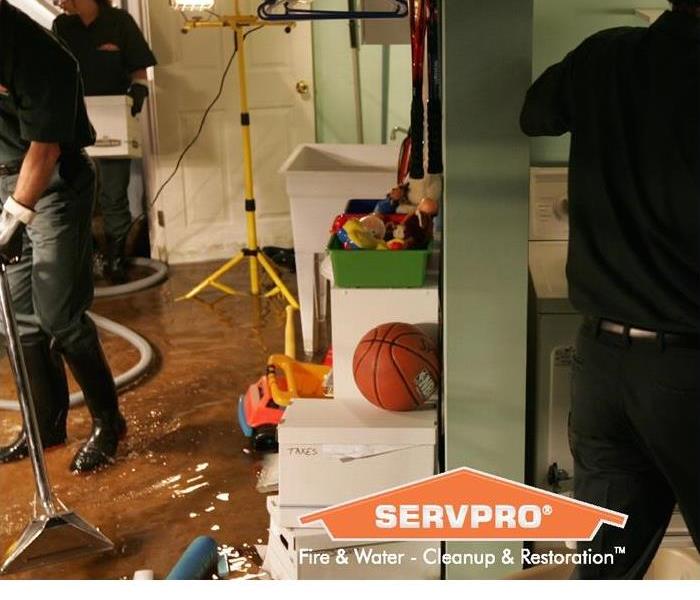 We are here 708-240-4873!
We are here 708-240-4873!
Recover - part 3 of 3
Once floodwaters have cleared, it's time to recover and rebuild. We Have the Resources to Handle Storms and Disasters.
In addition to our own resources, we can access equipment and personnel from over 1,700 Franchises across the state and country. We can even call upon strategically located Disaster Recovery Teams for catastrophic storms and major events.
How long does it take for water to damage a house?
12/1/2020 (Permalink)
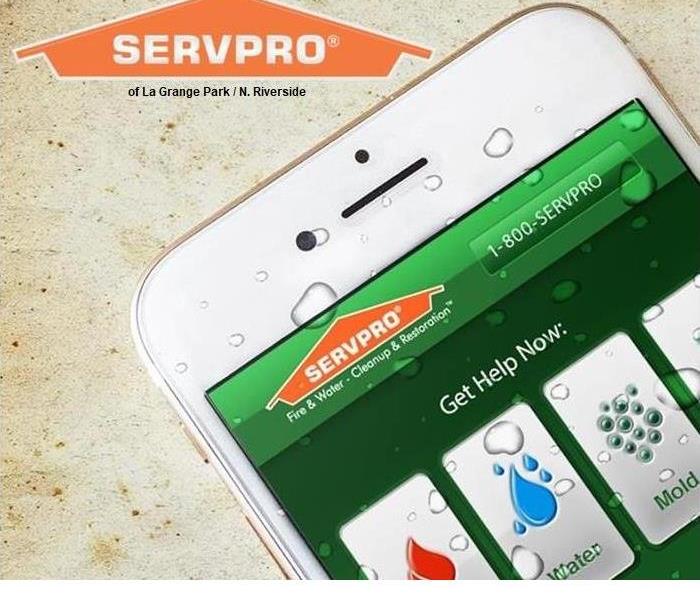 GET THE APP!
GET THE APP!
Within Minutes
- Water quickly spreads throughout your property, saturating everything in its path.
- Water is absorbed into walls, floors, upholstery, and belongings.
- Furniture finishes may bleed, causing permanent staining on carpets.
- Photographs, books, and other paper goods start to swell and warp.
Hours 1 - 24:
- Drywall begins to swell and break down.
- Metal surfaces begin to tarnish.
- Furniture begins to swell and crack.
- Dyes and inks from cloth and paper goods spread and stain.
- A musty odor appears.
48 Hours to 1 Week:
- Mold and mildew may grow and spread.
- Doors, windows, and studs swell and warp.
- Metal begins to rust and corrode.
- Furniture warps and shows signs of mold.
- Paint begins to blister.
- Wood flooring swells and warps.
- Serious biohazard contamination is possible.
More Than 1 Week:
- Restoration time and cost increase dramatically; replacing contaminated materials and structural rebuilding may be extensive.
- Structural safety, mold growth, and biohazard contaminants pose serious risks to occupants.
After fire cleanup
11/3/2020 (Permalink)
After fire cleanup
Smoke and soot is very invasive and can penetrate various cavities within your home, causing hidden damage and odor. Our smoke damage expertise and experience allows us to inspect and accurately assess the extent of the damage to develop a comprehensive plan of action.
Smoke and soot facts:
- Hot smoke migrates to cooler areas and upper levels of a structure.
- Smoke flows around plumbing systems, seeping through the holes used by pipes to go from floor to floor.
- The type of smoke may greatly affect the restoration process.
Different Types of Smoke
There are two different types of smoke–wet and dry. As a result, there are different types of soot residue after a fire. Before restoration begins, SERVPRO of LaGrange Park/North Riverside will test the soot to determine which type of smoke damage occurred. The cleaning procedures will then be based on the information identified during pretesting. Here is some additional information:
Wet Smoke – Plastic and Rubber
- Low heat, smoldering, pungent odor, sticky, smeary. Smoke webs are more difficult to clean.
Dry Smoke – Paper and Wood
- Fast burning, high temperatures, heat rises therefore smoke rises.
Protein Fire Residue – Produced by evaporation of material rather than from a fire
- Virtually invisible, discolors paints and varnishes, extreme pungent odor.
Our Fire Damage Restoration Services
Since each smoke and fire damage situation is a little different, each one requires a unique solution tailored for the specific conditions. We have the equipment, expertise, and experience to restore your fire and smoke damage. We will also treat your family with empathy and respect and your property with care.
Have Questions about Fire, Smoke, or Soot Damage?
Call Us Today – 708-240-4873.
What you did and didn't know about tornadoes
11/3/2020 (Permalink)
The Websters Dictionary defines a tornado : "A tornado is as a rotating, funnel-shaped cloud that extends from a thunderstorm to the ground with whirling winds that can reach 300 mph. Damage paths of tornadoes can be in excess of one mile wide and 50 miles long."
According to the study done by The Weather Channel. Each year in the U.S., 1,200 tornadoes on average kill 60 people, injure 1,500, and cause roughly $400 million in damages, putting long-term average tornado losses on par with hurricanes.
There are many misconceptions in regards to tornadoes. Here are some facts from tornadofacts.net
Tornado Safety Related Myths
- Southwest corner of your home/building/shelter is the safest location - In 1887 John P. Finley wrote a book on his observations of his tornado research. While he published some ground breaking information on tornadoes he also helped created this tornadoes myth. John believed that tornadoes only traveled in a northeast direction and that derby they created would be carried in the direction of its propagation. The 1997 F5 Jarrell tornado is a prime example of his misconceptions since that tornado moved in a south-southwesterly direction. It's recommended that you always seek shelter in the lowest floor of a building, preferably under an I-beam or staircase, regardless of the type of building you're in.
- Open all the windows in your home when a tornado warning is issued - This is an extremely dangerous myth because it takes away critical minutes that could be used to reach shelter. It used to be widely believed that you needed to open your windows during a tornado to equalize pressure and prevent your house from exploding. A violent tornado will only have a 10% drop in pressure which isn't anywhere near enough to cause your home to explode. Ignore your windows and seek shelter immediately when a tornado warning is issued.
- A highway overpass is an excellent tornado shelter - This myth gained huge traction in 1991 when a TV crew survived a tornado unharmed by sheltering under a overpass in El Dorado, KS. This event had nationwide coverage with video of the event and that helped perpetuate this myth to a dangerously high status. The conclusion for scientific evidence from the Oklahoma outbreak in 1999 actual proved that overpasses are actually one of the worst places to seek shelter during a violent tornado; mostly due to the wind tunnel effect that can accelerate flying derby speed even during weak tornadoes.
- You can outrun a tornado via a vehicle - The theory behind this myth is a vehicle can travel faster than the average tornado, but the key phrase is average. There is no way for someone to know the travel and wind speed of a tornado just by looking at it. Plus the flooding, hail, and flying derby from a tornado can put someone in a vehicle in danger. The official directive from the National Weather Service is if you spot a tornado nearby to abandon your vehicle and seek shelter in a nearby building, culvert or ditch.
- A brick or stone building can protect me from a tornado - While a brick or stone building can provide better protection during tornado a violent only can easily turn a brick or stone building into a pile of rubble. It's recommended that you always seek shelter in the lowest floor of a building, preferably under an I-beam or staircase, regardless of the type of building you're in.
- If a tornado isn't coming directly towards me I'm safe - In the past it was common belief that a tornado would only travel in a northeasterly direction. While it's true that most tornadoes will move northeast this is most due to the direction the storm is traveling. Tornadoes are erratic, unpredictable, and can come from any direction. A prime example is the 1997 F5 tornadoes that struck Jarrell, TX which traveled southwest.
When a major storm hits, it may overwhelm local restoration companies. SERVPRO of La Grange Park / North Riverside can scale our resources by accessing the equipment and personnel of 1,700 Franchises. We can also access Disaster Recovery Teams that specialize in major storms and catastrophic events.
Safety tips for the upcoming holidays
11/2/2020 (Permalink)
Per the National Fire Protection Association, nearly 47,000 fires occur during the winter holidays claiming more than 500 lives, causing more than 2,200 injuries, and costing $554 million in property damage. The National Fire Protection Association also states that on average, one of every 22 home fires started by Christmas trees result in death.
www.redcross.org/homefires, has several good home safety tips for the holidays to keep your home safe. We at SERVPRO LaGrange Park/North Riverside wanted to share some of those tips with you to ensure a safe holiday season.
- Place Christmas trees, candles, and other holiday decorations at least three feet away from heat sources like fireplaces, portable heaters, radiators, heat vents and candles.
- Purchase flame retardant metallic or artificial trees. If you purchase a real tree, make sure that it has fresh, green needles that aren’t easily broken. Keep live trees as moist as possible by giving them plenty of water.
- Make sure that light strings and other holiday decorations are in good condition. Do not use anything with frayed electrical cords and always follow the manufacturer’s instructions.
- Always unplug tree and holiday lights before leaving home or going to bed.
- Never use lit candles to decorate a tree. Always extinguish candles before leaving the room orgoing to bed.
- Use only sturdy tree stands designed not to tip over. Keep curious pets and children away from Christmas trees.
- Keep anything that can catch on fire—pot holders, oven mitts, wooden utensils, paper or plastic bags, food packaging, and towels or curtains—away from your stove top.
- Designate one person to walk around your home to make sure that all candles and smoking materials are properly extinguished after guests leave.
The following video also shares other great ideas to keep in mind this holiday season.
Holiday Fire Safety
Have a safe and wonderful holiday season from your friends at SERVPRO LaGrange Park/North Riverside
Thermal Imaging
11/2/2020 (Permalink)
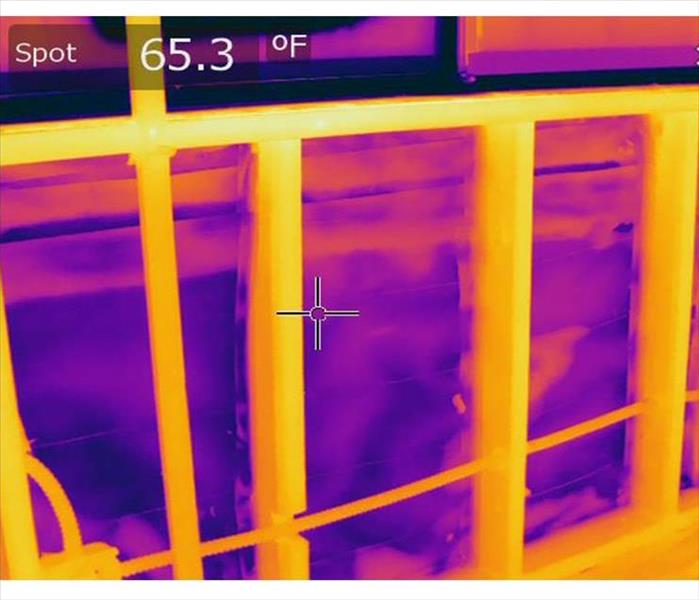 Finding the invisible.
Finding the invisible.
SERVPRO has many tools they offer for their customers. I recently came across a new tool that was used to detect water, and it was our thermal imaging camera our crew has. The thermal temperature screening provides a range of solutions.
Thermal cameras are important because they identify elevated body temperatures. In our case, it can show to us the level and amount of water that is in floors or walls that may not be noticeable because it is underneath. They are designed to detect and measure the invisible infrared radiation emanating from objects, frequently referred to as a "heat signature". The hotter an object is, the more radiation it releases. The thermal camera sensor array will detect infrared frequencies, converting the data to electronic signals, which can then be viewed as colored images that vary with the level of heat being emitted.
Unknown water in a home can cause major damage that can cost you a lot down the road. With that being said, having our team come in with our thermal imaging will allow our team to get to the problem faster because we are able to see something that you may not. This is why here at SERVPRO, we always go by our saying of being "faster to any size disaster" .
Commercial Cleanup!
9/29/2020 (Permalink)
If you can’t summon help quickly, a fire can quickly sweep through your Elmhurst, IL, office and leave a trail of devastation in its wake. Fire damage can be severe and make it impossible for you to resume work duties in your building. Ironically, the very water firefighters use to eliminate the fire can also cause major problems. Trained professionals have the equipment and skill to clean up both types of damage.
Thorough Inspection
When you call a professional disaster cleanup crew to your office, the team won’t jump right in and start working without a plan. The company will evaluate the effects of the fire damage in order to come up with an effective strategy. The technicians will do the following:
• Make note of which areas of your building were affected.
• Determine the extent of the damage.
• Decide what areas and items you can salvage and which ones you must replace.
• Establish a plan of attack that will yield the most complete, time-effective results.
Remove Standing Water
A fire hose can pump out hundreds of gallons of water while a firefighter is battling a blaze. It’s no wonder water can wreak havoc in your office after a fire. A technician will use wet vacuums and other specialized water removal equipment to make sure there is no leftover water on your floor or on furniture or other objects. Next, the team will dry the areas with dehumidifiers and high-powered blowers.
Clean and Sanitize
Sucking up water and drying the area isn’t enough to mitigate water damage. The professionals will also use chemicals to thoroughly sanitize any areas where there had been water. This will minimize the chances of mold growth.
Fire damage and water issues go hand in hand after a fire. By understanding the process the pros use, you can have peace of mind and confidence that your office will be in good hands.
FEMA!!
9/29/2020 (Permalink)
Some buildings are more at risk of flooding than others in Elmhurst, IL. The Federal Emergency Management Agency, or FEMA, aims to prepare every individual to handle any natural disaster that might affect him or her, and floods are no exception. There is a wealth of flood preparation knowledge you can find from this agency, including a flood risk map that shows you exactly how likely your home is to be affected by a flood. You should take the time to learn:
1. Which flood zone your home is located in
2. What flood insurance options you have
3. Where you fall on the flood insurance rate map or FIRM
4. The elevation of your property
5.What the evacuation plan is for your area
Flood Insurance
It is a good idea to have water damage covered by your insurance policy, but you may not realize that water damage and flooding damage is not the same thing. Water damage is caused by things like burst pipes or leaky roofs, but the damage caused by external factors like tidal waves or mudslides fall into a different category. Most people do not need flooding insurance, but if you are in a high-risk area, it might be beneficial. The National Flood Insurance Program, or FEMA NFIP, is a special program FEMA offers that provides affordable flooding damage insurance.
What To Do
FEMA also has recommendations for what to do during a flood. You should be intimately familiar with the evacuation plan in your area and have all the supplies you need before a flood happens. You should have plenty of canned food, bottled water, a first aid kit, and general tools. It might be good to have a flooding damage restoration company in Elmhurst, IL already in mind so you can start the process of repairing as soon as possible. Flood water contains contamination, so it is not safe to return to your home no matter how minor the damage is.
Storm Team- Iowa
9/1/2020 (Permalink)
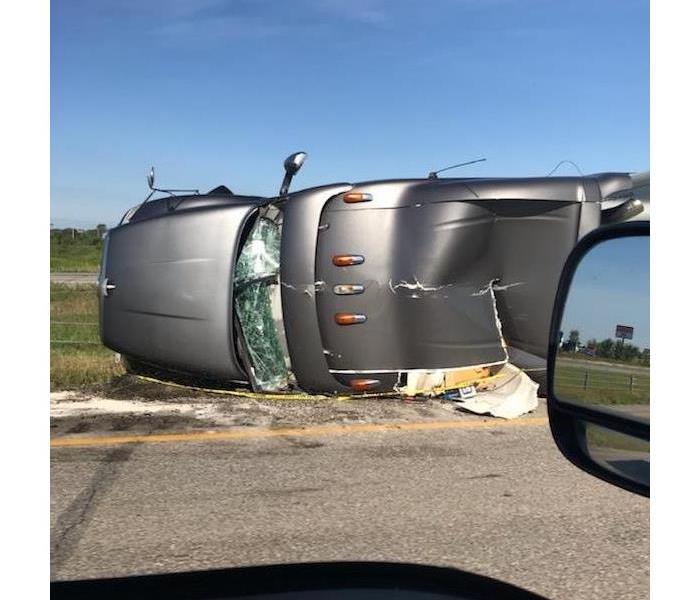 Our team helping fix the damages out in Iowa!
Our team helping fix the damages out in Iowa!
Over the past couple weeks, our storm team here at LaGrange Park/N. Riverside has been out assisting those who were hit with damage from the bad storm that went through Iowa. Our team has been working on a major project at one of the local hotels nearby. Our commercial large loss division is composed of the best of the best in restoration. Our commercial operations manager has been supervising the job every since we started down in Iowa. Our team was about to dispatch trained production professionals, and cut costs through the strategic placement and oversight of temporary labor. Once our team got word there was going to be a major storming rolling through there, we had a team ready to go the day before. After the storm hit, out team drove over 3 hours to get out to the location where the commercial property was. On the way, our team was able to see all the damage first hand driving through Iowa. Our team described it almost as a "scary scene in a movie". There was semi-trucks turned over on the highway, full grown trees pulled out of the ground, entire roofs taken off of homes, broken homes, and many more disasters that put tears to their eyes. Our team knew that they needed to help fix Iowa, and be able to make it strong again. To this very day, our team is still out in Iowa assisting the major commercial loss that has taken place, and they will continue to work in order to get the operation up and going again. We here at SERVPRO are always faster to any size disasters!
How Much Does Water Damage Restoration Cost?
9/1/2020 (Permalink)
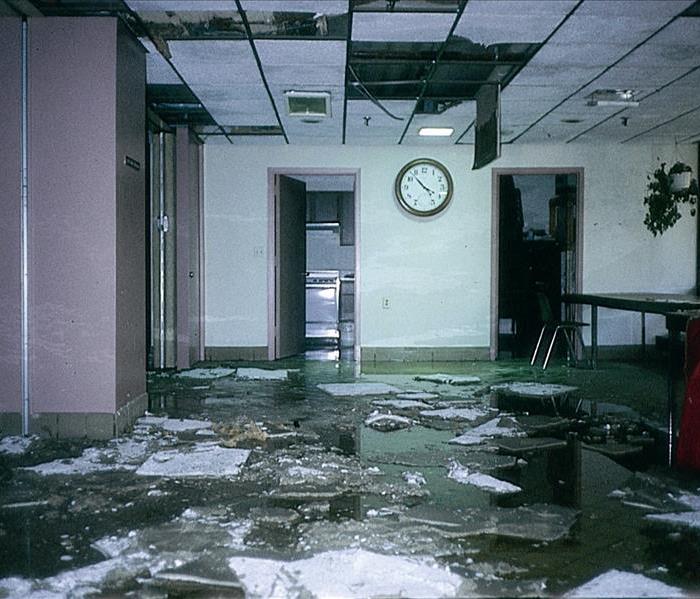 Call SERVPRO when water damage affects your business!
Call SERVPRO when water damage affects your business!
When it comes to owning a business or a home, water damage can be one of the most costly things there is. You can not only lose out on days or weeks of productivity, but you could also find yourself repairing or replacing valuable equipment like electronics, tools and inventory. This is where the costs come into play.
- On average, water damage from a sink will run $7,000.00 for each instance
- For toilets, that number ranges between $2,000.00 and $10,000.00
As we can see, this can add up very fast! Here are some causes of water damages, and what you can do to help prevent them.
1. Appliances and Equipment
- Air conditioners, water heaters or anything that uses tubes, pipes, gaskets or filters to operate has the potential to leak. The best thing to do is to regularly look over and maintain your equipment. If you notice anything that concerns you, such as rust, cracks, bulges or signs of moisture, call SERVPRO.
2. Roofing
- Make sure you're checking your roof regularly. If you've got a pond up there, your drainage isn't working effectively. Keep in mind that every inch of water weighs in at around 5 lbs. Be sure to look for any damage to your perimeter flashing, roof membrane or roof penetrations like drains, pipes and gas lines.
3. Pipes and Drains
- Your plumbing system is susceptible to stoppages, clogs and damage. If a crack develops, it could dumb 250 gallons of water per day on your facility. Look for outward signs of moisture, blue stains, rusting, and cracking and bulging. If you're having plumbing work done or you have a cut pipe for any reason, check for scale buildup. You can also try a pipe camera to get a good look at what's going on inside your system.
4. Sprinkler Systems
- Many commercial buildings are outfitted with sprinkler systems, which are great for minimizing fire damage, but not so great for water damage when they malfunction. Always check your sprinkler system for signs of damage or rust, and replace them regularly to make sure they are functioning properly.
5. Mother Nature
- Natural disasters like hurricanes, severe thunderstorms ad flash flooding can do untold damage to your business. You can control how ready you are for it though. Keeping your gutters clear, installing barriers and storing sensitive files and electronics at a higher level are all things you can do to keep the damage minimal. Consult with a SERVPRO professional to get your ERP set up and ready in case something like this were to happen.
Common Causes of Commercial Building Fires
9/1/2020 (Permalink)
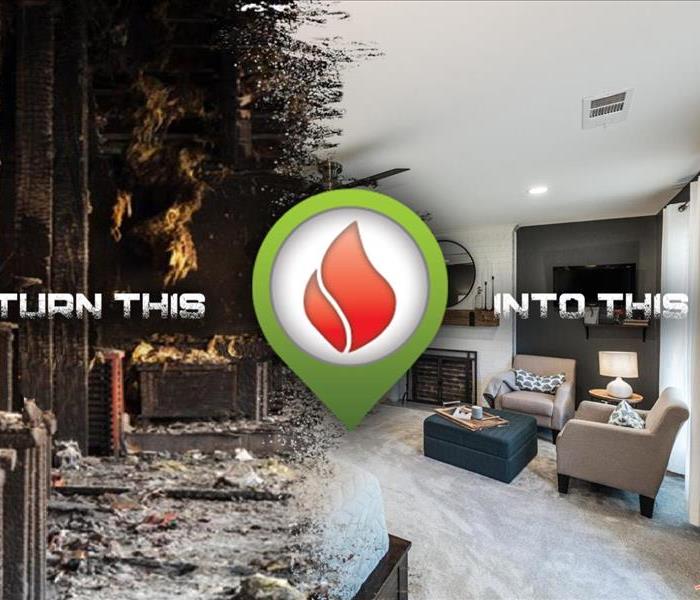 Make sure to check all heating sources!
Make sure to check all heating sources!
We usually don't think of a fire destroying our business or office building. We are more worried about less concrete threats. This includes a downward trending economy, high customer churn rate, the struggle to retain talented employees, legal issues, etc. However, nonresidential building fires killed 65 people, injured 1,425 and created $2,461,400,00 in damage between 2004 and 2013.
In order to prevent a dangerous and costly fire, the time of day fires are most likely to occur in your building depends on what type of business you're in. An office building is a bit different from a manufacturing plant. Ex: In an office building, fires are most common during regular work hours. Incidence of fires peaks in the early evening hours between 3-6pm.
Therefore, the most common causes of commercial building fires are as follows.
1. Cooking Fires
- 29.3% of nonresidential fires from 2013 were cooking related. In fact, 1 in 4 office building fires were related to cooking equipment. These types of fires do tend to account for less damage, but they are easily preventable with fire protection systems such as alarms and fire extinguishers.
2. Intentional
- This accounts for almost 10% of fires, and tends to cause the most damage. Intentional fires also result in more civilian injuries and deaths. Unlike cooking and heating fire, it's most common for intentional fires to be started between 3pm and midnight. A few common locations to be aware of in the building are bathrooms, trash bins, garages, and open areas like a lawn or field.
3. Careless Acts and Human Error
- 9.2% of commercial fires were unintentional results of careless acts. This is somewhat of an 'other' category. Some examples include accidentally leaving space heaters or other heat producing equipment on, carelessly discarded cigarette butts igniting fires, and plugging too many things into the same extension cord.
4. Heating Fires
- Heating fires account for 9% of all nonresidential building fires. Central heating units, fireplaces, water heaters, and other heating appliances and systems should be regularly inspected to prevent fires. It is important to move any flammable materials and furniture away from heat sources.
Hurricane Hazards
8/4/2020 (Permalink)
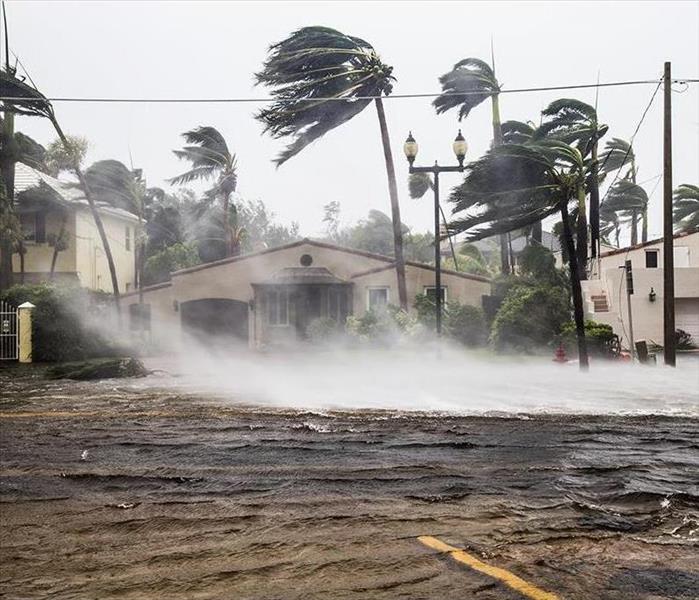 Make sure you are prepared.
Make sure you are prepared.
Hurricane season is upon us, and there are several named storms that have developed in the Atlantic, Caribbean and Gulf of Mexico. On average, there are about 12 tropical storms that will develop between June 1st and November 30th. Of those 12 storms, 6 of them will become hurricanes according to the National Weather Service. We know that hurricanes can be life-threatening, and they can cause a serious amount of property damage. The National Weather Service lists the following as potential "hurricane hazards".
Storm surge: is the abnormal rise of water generated by a storm's winds. This hazard is historically the leading cause of hurricane related deaths in the United States. Storm surge and large battering waves can result in large loss of life and cause massive destruction along the coast. It can also travel several miles inland, especially along bays, rivers and estuaries.
Flooding: from heavy rains is the second leading cause of fatalities from landfalling tropical cyclones. Widespread torrential rains associated with these storms often cause flooding hundreds of miles inland. This flooding can persist for several days after a storm has dissipated.
Winds: from a hurricane can destroy buildings and manufactured homes. We also see that signs, roofing material and other items left outside can become flying missiles during a hurricane.
Tornadoes: can accompany landfalling tropical cyclones. They typically occur in rain bands well away from the center of the storm.
Dangerous waves: produced by a tropical cyclone's strong winds can pose a significant hazard to coastal residents and mariners. These waves can cause deadly rip currents, significant beach erosion and damage to structures along the coastline. This is even when the storm is more than a 1,000 miles offshore.
With this all being said, preparation is the best protection against the dangers of a hurricane. Make sure you plan an evacuation route and your emergency plan, take inventory of your property and take steps to protect your home or business.
ERP for your commercial property
8/4/2020 (Permalink)
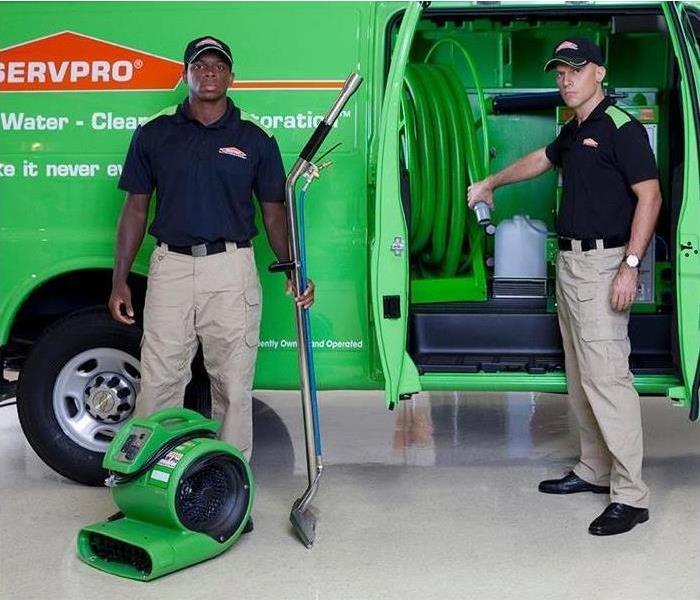 Make sure you not only have one for your commercial property, but also that it is up to date.
Make sure you not only have one for your commercial property, but also that it is up to date.
For a business owner, a worst-case disaster scenario involving fire or water damage can seem unthinkable until it suddenly becomes a reality. A quick response time by a disaster recovery company such as SERVPRO can help minimize property damage. Owners need to have a quick and convenient emergency disaster plan that connects them with vendors, necessary contacts, and pertinent information when disaster strikes. SERVPRO's Emergency Ready Plan (ERP) is a respected industry tool during a disaster event. It is so valuable that in the midst of the confusion and panic, an owner or manager can be provided a sense of calm and clarity in reaching out for expert help.
There are four key parts to building an ERP.
1. Identify your facility's greatest threats in order to assess the overall severity of the event.
- Look at your location that you are in. Be aware if you are in tornado alley, hurricane season, or subject to freezing temperatures.
2. Document all vital information and establish clear communication activities.
- An ERP needs to contain critical property information that can help speed up response time after a disaster strikes the property. Make sure to include any documentation that deals with prior loss history. Also, identify and label utility shut off locations, and prioritize your key contacts. Prior loss history can provide first responders and restoration vendors with historical information on your facility's condition. Also, proper utility identification will allow for quicker response times for emergency shut off, requests and key contact information is vital to starting the recovery process. This will allow you to quickly contact key personnel and answer priority questions.
3. Practice! Practice! Practice! There is no "textbook" event, so expect the unexpected.
- You should always conduct practice sessions to make sure everyone is clear on the process. There needs to be clear evacuation routes in your ERP, and set a distribution chain for your disaster recovery plan amongst key contacts and various locations.
4. Keep it updated, and have all necessary information communicated with your insurance company and emergency restoration vendors.
- Make sure your ERP is always up to date. This is the best way for the recovery to begin. People are going to come and go, updates will be made to the facility, and utilities can change. This should be a dynamic document that changes as your business does. You do not want to fall behind when disaster strikes!
Tornado Season
8/4/2020 (Permalink)
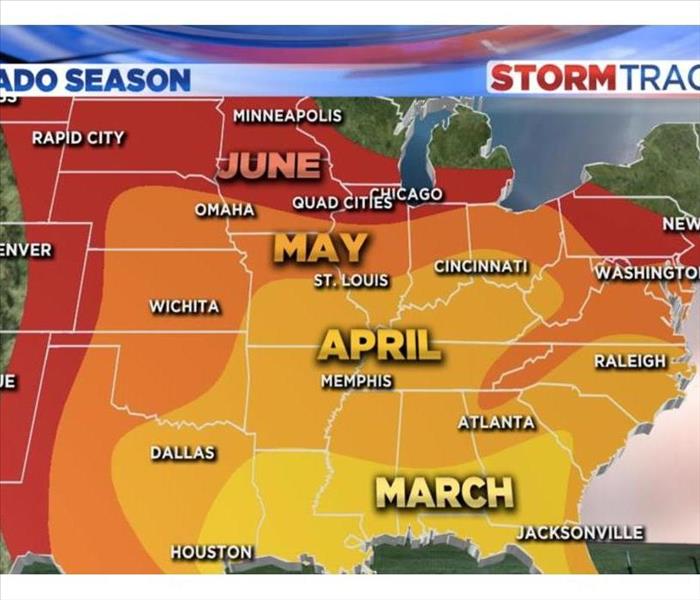 Check this out!
Check this out!
Tornadoes can occur year-round anywhere over the lower 48 of the United States, but the spring to summer period is prime time for severe thunderstorms that spawn the violent swirling columns of air. Building warmth and surging humidity are key ingredients for thunderstorms which, when severe, can evolve to produce tornadoes.
Severe thunderstorms will typically form when we get warm, moist air from the Gulf of Mexico clashing with cool air from Canada and sometimes dry air from the deserts. We often see the most tornadoes develop from central Texas, northward through the Nebraska and Iowa area, which is referred to as "Tornado Alley".
In order for severe thunderstorms to form, there must be a mechanism for air to rise in vigorous fashion. As a column of air rises through the atmosphere, it cools and causes moisture within to form the towering clouds we see as thunderstorms. The more moisture available and the cooler the air is aloft, the more efficient and potentially the more violent this process is. A push of dry air or cooler air from the outside can also intensify this process.
Any time there is a surge in temperature and humidity levels, combined with the approach of cooler and drier air thunderstorms can erupt. the most dramatic time of the year for this is in the spring to early summer. The peak for severe weather and tornado season is from April through June. Areas of the country that typically warm up the fastest with an ample supply of moisture are usually the most likely areas for early-season severe thunderstorms and tornadoes.
Commercial Building Tips
7/23/2020 (Permalink)
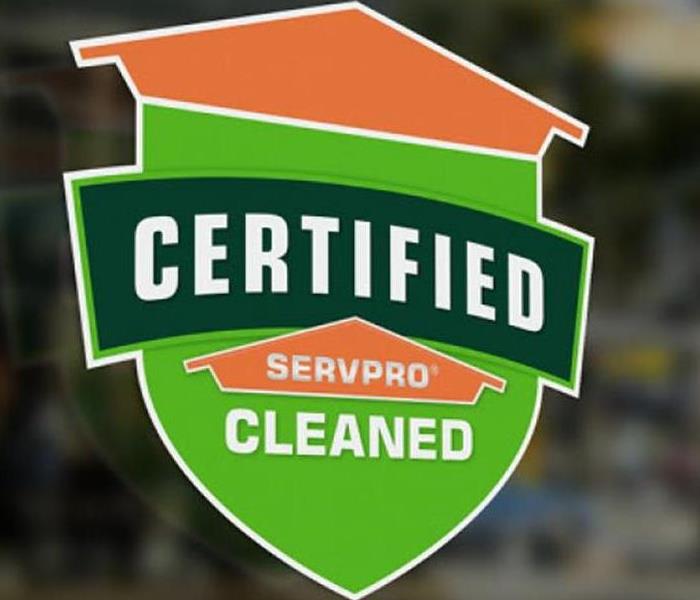 Get set up today!
Get set up today!
According to the Federal Emergency Management Agency nearly 50% of businesses never reopen after a water or fire emergency. The Federal Emergency Management Agency also did a survey in 2015 of businesses across the US, and found that near 75% of businesses do not have a disaster recovery plan in place.
SERVPRO of LaGrange Park/North Riverside can help you with that. We offer a no cost assessment of your facility. We come into your company and give a very detailed guide on how to get your back into your business after a disaster occurs.
The other great thing about SERVPRO of LaGrange Park/North Riverside assessing your commercial property is that our assessment will take very little time away from you and your current project, but in the event of a fire or water damage it will get your back to production much faster and efficiently.
The best part about our emergency readiness planning is that we establish a working relationship. We know your building, and you as a customer. You also get to know us, and build a working relationship that you can be certain we have your companies best interest at heart.
We also want to stay up to date with our commercial buildings, and there sanitation process throughout this COVID-19 time period. We understand that most commercial buildings have and still operating during this pandemic, so we want to make sure their staying healthy. With our new Certified: SERVPRO Cleaned program, they can get all of the proper cleaning and sanitizing that is necessary to make sure they are not only staying healthy, but also still able to operate.
Don't wait, call SERVPRO of LaGrange Park/North Riverside today at 708-240-4873, and let us come assess your property and create an emergency readiness plan for you and get you set up with our Certified: SERVPRO Cleaned program.
Certified: SERVPRO Cleaned Program
7/23/2020 (Permalink)
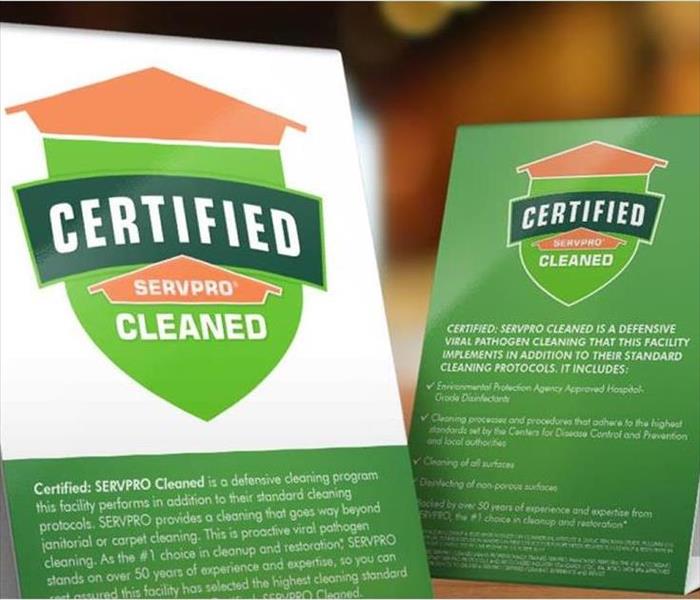 Get set up today!
Get set up today!
We as a company have recently introduced our new program Certified: SERVPRO Cleaned, and it is designed to provide our communities with a way to know that a structure has been cleaned, sanitized, and disinfected. This is also a cleaning and disinfecting program that we here at SERVPRO have to offer for our commercial property owners in order to address the current COVID-19 pandemic. We ensure that when businesses choose SERVPRO, their customers, employees, and community are rest assured that they have selected a higher standard of cleaning.
This program is set up with 3 unique steps called the 3 C's. These 3 C's include Consult, Clean, and Certify.
Consult deals with the process of talking to each businesses personally because not all businesses are the same. A SERVPRO professional who understands the business will create a custom cleaning program to meet their specific needs. The specific program will be developed based on a range of factors including business type, size of space, amount of high frequency touch points, foot traffic, and congestion points. Therefore, they will know that the clean they receive is customized to their unique needs.
Clean is based on the specific needs of their business, and their location will undergo a thorough expert cleaning rooted in the pillars of People, Process, and Product.
-People: SERVPRO professionals are uniquely prepared during this unprecedented time to clean and disinfect homes or businesses according to the protocols set by the CDC. We have years of experience in dealing with biological contaminants, and we will go beyond the scope of work that needs to be done.
-Process: SERVPRO professionals are trained to perform proactive or emergency responsive cleanups that involves facility or structure cleaning and disinfection. This would include cleaning of porous and non-porous surfaces, disinfecting of non-porous surfaces, cleaning and disinfecting of equipment, tools and supplies used for cleanup, and disposal of hazardous materials. We also recommend a frequent cleaning depending on what CAT it is in. We want to make sure that people are getting back to business as soon as possible if there is a known COVID-19 case involved.
-Product: Our program has more than 100 exclusive professional cleaning products to meet any need. This includes our proprietary cleaning agent, SERVPROXIDE, which is a hospital-grade disinfectant that carries the Environmental Protection Agency's lowest toxicity category and is NSF certified for sanitizing surfaces in and around food processing surfaces.
Certify deals with the our credibility as the premier biohazard cleaning company in the country to their business. This then allows assurance to their employees and customers that only SERVPRO can deliver. Once the business has been cleaned, they will gain access to propriety signage, digital emblems, and other collateral that communicates that they've selected the highest standard of cleaning available to protect their employees and customers. We also have the option to add the date, so then their guests will know that their location is being cleaned regularly.
SERVPRO professionals have been on the front lines of proactive and reactive COVID related cleanups, and we are here to help as businesses begin to reopen and to also help them stay open!
Carbon monoxide the silent killer
7/23/2020 (Permalink)
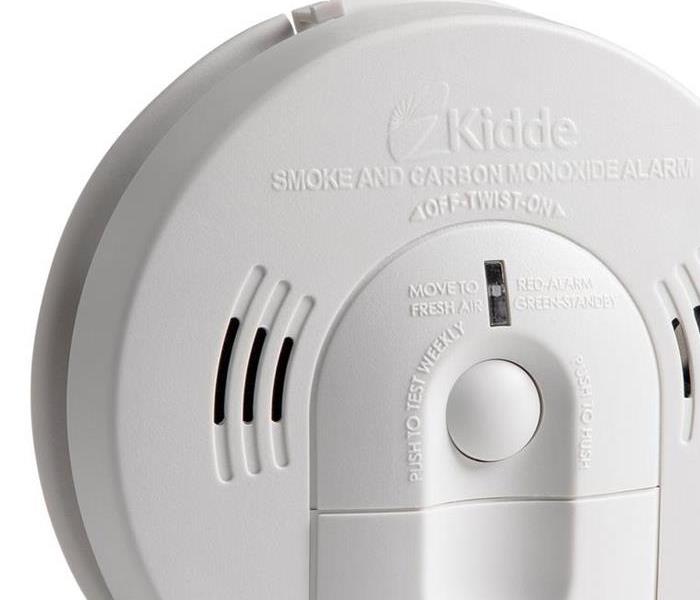 Make sure to get yours today!
Make sure to get yours today!
Did you know that local fire departments require carbon monoxide detectors?
The Elmhurst Fire Department requires that each home be outfitted with carbon monoxide detectors, in addition to smoke detectors.
For some people, they may not know this, so here are some helpful tips and steps about the carbon monoxide detector.
First off, Carbon monoxide is a colorless, odorless, and tasteless gas that is poisonous to humans. It is known as the "silent killer" because humans cannot tell when they are around it. The carbon monoxide detector is a safety device that can alert homeowners of a CO leak, and then help them escape a potentially life-threatening situation.
Carbon monoxide can be produced by any fuel-burning device. There are three main sources, and they are your home's furnace, dryer vent in a drying machine, and fireplace or chimney. It is VERY IMPORTANT to have those sources regularly services and cleaned by a professional to help prevent a CO leak.
When it comes to installation of the alarms, it is important to have them on every level of the home. That way all family members can hear the detectors go off. There should also be detectors in every bedroom, sleeping area, and common room for extra safety while asleep. They can be placed anywhere in the room, and can also be placed on the wall or the ceiling and will be just as effective.
Lastly, it is important to test your alarms regularly, so at least once a month. If it has replaceable batteries, they should be changed at least every 6 months. However, just because you replace the batteries doesn't mean they last forever. They have a lifetime of anywhere between 5-7 years.
The most common causes of house fires
7/23/2020 (Permalink)
There are many common causes when it comes to house fires, but there are measures that can be taken in order to avoid them.
Cook equipment that includes pots and pans can overheat very quickly, and they can cause a fire very easily if the person cooking gets distracted and then leaves the cooking unattended. ALWAYS stay in the area where cooking is taking place, or ask someone to water the food when cooking with hotplates.
Portable heaters are another common cause of house fire. Make sure to keep them at least one meter away from anything that could easily catch fire. This would include furniture, curtains, laundry, clothes and even yourself. If you have a furnace, get it inspected once a year to make sure it is working to safety standards.
Make sure to keep bedrooms off limits when it comes to smoking in the home. A cigarette tat is not put out properly can cause a flame, as the butt may stay alit for a few hours once one is done with it. It could burst into flames if it came into contact with flammable materials, such as furniture.
An electrical appliance, such as a toaster can start a fire if it is faulty or has a frayed cord. A power point that is overloaded with double adapter plugs can cause a fire from an overuse of electricity. Also, a power point extension cord can be a fire hazard if not used appropriately. Make sure to double check the appliances and power points in the home.
Candles may look and smell pretty, but if left unattended they can cause a room to easily burst into flames. Make sure to keep candles away from any obviously flammable items such as books and tissue boxes. Always blow out the candle(s) before leaving the room they are in.
Children can cause a fire out of curiosity, to see what would happen if they set fire to an object. Please make sure to keep any matchers or lighters out of reach in order to avoid this. Install a smoke alarm in your child's room and practice a home escape plan with your children and family in case there was a fire.
Homes with inadequate wiring can cause fires from electrical hazards. Some signs to see if you have bad wiring are
-lights dim if you use another appliance
-for an appliance to work, you have to disconnect another
-fuses blow or trip the circuit frequently
Make sure to have a licensed electrician come and inspect your home, or contact your landlord if you have any of the above occurrences.
Make sure when you barbeque to keep it away from the home, tablecloths or any plants and tree branches. Keep them regularly maintained and cleaned with soapy water and clean any removable parts. Check the gas bottle for any leaks before you use it each time.
If you have any flammable liquids in the home or garage such as petrol, kerosene or methylated spirits, keep them away from heat sources and check the label before story. Be careful when pouring these liquids.
Lastly, lamp shades and light fittings can build up heat if they are very close to light globes. Check around the house to make sure. Lamp bases can become a hazard if they are able to be knocked over easily, and so should be removed if they are. Check that down lights are insulated from wood paneling or ceiling timbers.
Key takeaways for preventing water damage
7/23/2020 (Permalink)
Water damage is the No. 1 culprit that weakens your home's foundation and the very core that holds your house together. I am sure you have heard about core strength for your body. Well, water damage hits at the core strength of your home, eventually causing serious structural damage. Damp wood invites termites and carpenter ants. It can also cause mold and mildew if not taken care of properly.
Here is how to prevent water damage using three easy strategies that will give you peace of mind the next time heavy storms hit.
1. Ensure good drainage
- clean your gutters
- direct downspouts 5-10' away from the house
- slope your yard away from the foundation
2. Test your sump pump
- check your sump pump once a year
- test more frequently during storm season
3. Fix water leaks
- repair any noticeable dripping pipes
- check for dark spots under pipes & on ceilings
- repair any cracked caulking
- inspect the roof for missing, loose of damaged shingles
By following these tips, you are going to have less of chance when it comes to the amount of water damage that the home may take on.
Internship at SERVPRO
5/7/2020 (Permalink)
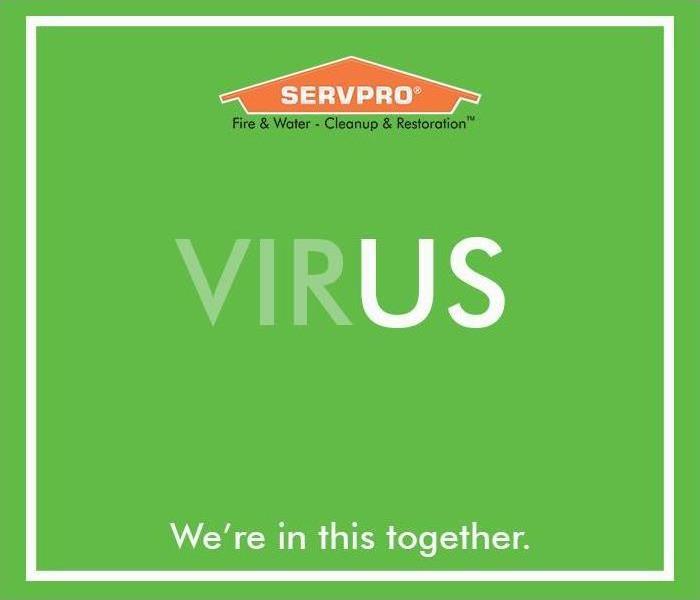 We are all in this together!
We are all in this together!
The company that I am interning for is SERVPRO of Elmhurst/Arlington Heights & N. Prospect/Lagrange Park & N. Riverside. The office location is located in Broadview IL, and the areas that are listed are the territories that our marketing team is allowed to market in. SERVPRO is a franchise that is owned and operated by personal owners. We have over 1,700 locations across the United States. Our company focuses on fire, water and mold restoration and mitigation for disasters that strike homes, buildings, businesses, etc. We are also currently doing cleaning and disinfecting for COVID-19 with our Vanquish product and fogging system. As far as what I do as an intern at SERVPRO, I work alongside the marketing and sales team. Our job is to go on daily routes around our territories and market SERVPRO to insurance agents, restaurants, hotels, churches, retail stores, etc. You name it, SERVPRO can help! However, one major struggle we are having during this time is not being able to go out on our daily routes to market and sell because of the current pandemic we are in. Therefore, all the team members are in the office and are brainstorming ideas on how to market SERVPRO from behind a computer screen. Some ideas we have come up with is marketing through social media. This is mainly my job because the other members don’t care for it, and I actually really like it. I have access to all the social media accounts like Instagram, Facebook, LinkedIn, Twitter, etc. Every day I come in and do daily posts on all the accounts in order to ensure we are getting the SERVPRO name out on the Internet more. Especially now since everyone is at home with the stay-at-home order in place, they are constantly on their smart devices. I also have been doing blog entries on the SERVPRONet website about my internship here at SERVPRO. SERVPRONet is a personal website for SERVPRO employees to access that has updated news for everyone, marketing tools, sales techniques, and so on. I also have been attending weekly WebEx meetings with the SERVPRO marketing headquarters with all different SERVPRO franchises across the country. They show us helpful tools to use while being stuck at home or in the office. Another major event that our company has been doing is free cleaning and disinfecting for our first responders. Our team members have been going out and doing cleaning and disinfecting to the vehicles and offices of police and fire departments in our territories. This has given our company major recognition on social media websites, and we are even building relationships that we didn’t have before. I love what I do here at SERVPRO and I have learned so many different techniques about marketing and sales that I never knew before. This has given me so much more confidence when approaching new people, and building up my relationship skills. I have developed a different side of professionalism that I didn’t know I had before, and it is truly amazing to see the growth I have gained because of SERVPRO. The employees I work with treat everyone like family, and it is very welcoming when you walk in the door every day. I always have a smile on my face when I enter in the morning, and then when I leave in the afternoon. I love coming to work every day, and that is exactly how it should be. Thank you SERVPRO for letting be on this internship journey with your company!
Cleaning & Disinfecting for COVID-19
4/1/2020 (Permalink)
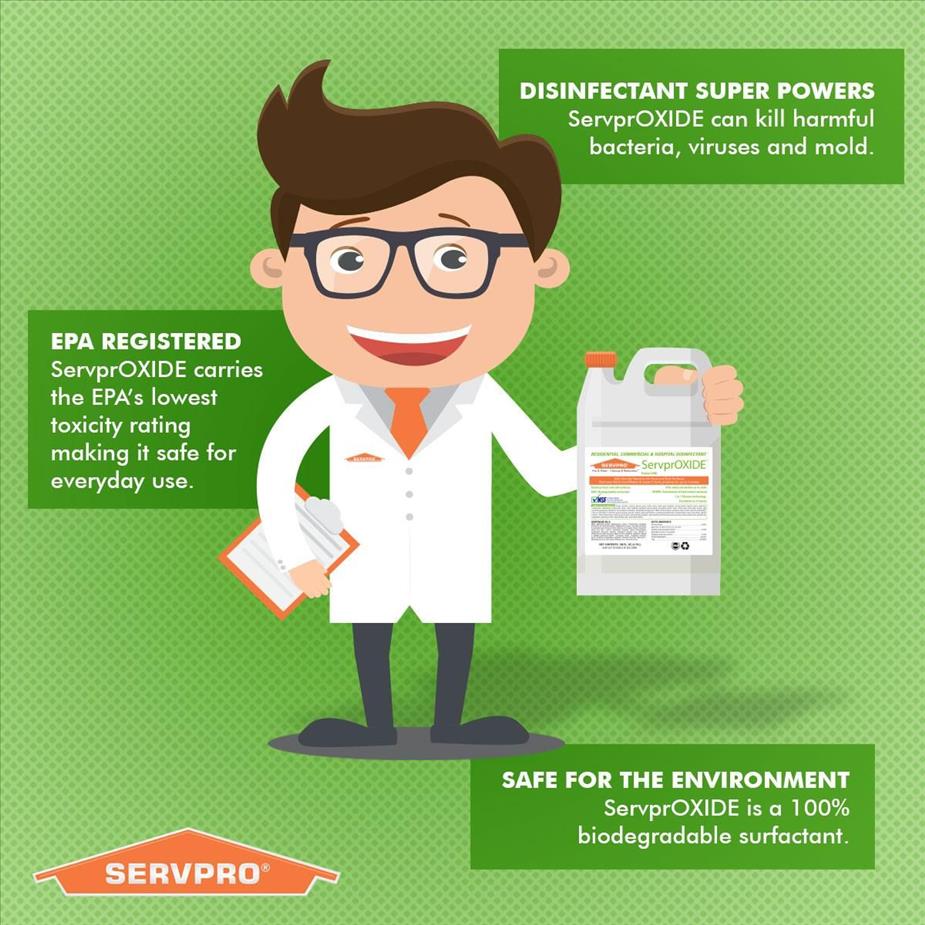 This is the product we use for the cleaning and disinfecting for COVID-19. We want to help do our part in stopping the spread of the virus!
This is the product we use for the cleaning and disinfecting for COVID-19. We want to help do our part in stopping the spread of the virus!
Hello,
We have been out servicing 911 call centers, trucks, distribution warehouses and distribution offices that are keeping our stores stocked with supplies and know that our Police and Fire Departments also need to be out to protect our communities but also need to stay free from a spread of the SARS-CoV-2” COVID-19 .
We here at SERVPRO wanted to let you all know that we are currently are open to help combat the spread of the virus. SERVPRO, with direction from the CDC have put together protocol to deal with “SARS-CoV-2” COVID-19 pro-actively (pre-positive test) and reactively (post-positive test).
These general guidelines are broad in scope and are not-specific protocols. Any protocols from federal, state, local agencies, or an industrial hygienist would supersede these guidelines. A CAT system has been designed for the different calls as it relates to “SARS-CoV-2” COVID-19.
CAT1: Proactive cleaning only CAT2: Person under investigation (PUI) or possible exposure CAT3: Confirmed, positive case
The protocol for CAT 1 is attached along with the SDS sheets, Chemical information, approval forms and rates for the services. We know that it is ever changing at a rapid rate and is very volatile. If you are in need of any services please reach out to us and we will do our best to help answer any questions or perform any work.
CAT 2 and CAT 3 – Protocol:
The Centers for Disease Control and Prevention (CDC) is closely monitoring an outbreak of respiratory illness caused by a novel (new) coronavirus (named “SARS-CoV-2”) that was first detected in Wuhan City, Hubei Province, China, and spread to dozens of countries throughout the world. This is an emerging, rapidly evolving situation and the CDC will provide updated information as it becomes available, in-addition to updated guidance.
https://www.cdc.gov/coronavirus/2019-ncov/community/organizations/cleaning-disinfection.html
Cleaning and Disinfection After Persons Suspected/Confirmed to Have COVID-19 Have Been in the Facility
Timing and location of cleaning and disinfection of surfaces
- At a school, daycare center, office, or other facility that does not house people overnight:
- It is recommended to close off areas used by the ill persons and wait as long as practical before beginning cleaning and disinfection to minimize potential for exposure to respiratory droplets. Open outside doors and windows to increase air circulation in the area. If possible, wait up to 24 hours before beginning cleaning and disinfection.
- Cleaning staff should clean and disinfect all areas (e.g., offices, bathrooms, and common areas) used by the ill persons, focusing especially on frequently touched surfaces.
- At a facility that does house people overnight:
- Follow Interim Guidance for US Institutions of Higher Education on working with state and local health officials to isolate ill persons and provide temporary housing as needed.
- It is recommended to close off areas used by the ill persons and wait as long as practical before beginning cleaning and disinfection to minimize potential for exposure to respiratory droplets. Open outside doors and windows to increase air circulation in the area. If possible, wait up to 24 hours before beginning cleaning and disinfection.
- In areas where ill persons are being housed in isolation, follow Interim Guidance for Environmental Cleaning and Disinfection for U.S. Households with Suspected or Confirmed Coronavirus Disease 2019. This includes focusing on cleaning and disinfecting common areas where staff/others providing services may come into contact with ill persons, but reducing cleaning and disinfection of bedrooms/bathrooms used by ill persons to as needed.
- In areas where ill persons have visited or used, continue routine cleaning and disinfection as in this guidance.
How to Clean and Disinfect
Surfaces
- If surfaces are dirty, they should be cleaned using a detergent or soap and water prior to disinfection.
- For disinfection, diluted household bleach solutions, alcohol solutions with at least 70% alcohol, and most common EPA-registered household disinfectants should be effective.
- Diluted household bleach solutions can be used if appropriate for the surface. Follow manufacturer’s instructions for application and proper ventilation. Check to ensure the product is not past its expiration date. Never mix household bleach with ammonia or any other cleanser. Unexpired household bleach will be effective against coronaviruses when properly diluted.
- Prepare a bleach solution by mixing:
- 5 tablespoons (1/3rd cup) bleach per gallon of water or
- 4 teaspoons bleach per quart of water
- Products with EPA-approved emerging viral pathogens claims are expected to be effective against COVID-19 based on data for harder to kill viruses. Follow the manufacturer’s instructions for all cleaning and disinfection products (e.g., concentration, application method and contact time, etc.).
- For soft (porous) surfaces such as carpeted floor, rugs, and drapes, remove visible contamination if present and clean with appropriate cleaners indicated for use on these surfaces. After cleaning:
- If the items can be laundered, launder items in accordance with the manufacturer’s instructions using the warmest appropriate water setting for the items and then dry items completely.
- Otherwise, use products with the EPA-approved emerging viral pathogens claims (examples at this link) that are suitable for porous surfaces
Thank you for your time and stay safe.
We are still open!
4/1/2020 (Permalink)
 We are still open during this pandemic, and want our customers to know we are here to help with whatever they may need!
We are still open during this pandemic, and want our customers to know we are here to help with whatever they may need!
SERVPRO of Elmhurst provides 24-hour emergency service and is dedicated to being faster to any-sized disaster in Elmhurst. We can respond immediately to your emergency and have the expertise to handle your restoration or cleaning needs.
- 24-Hour Emergency Service
- Faster to Any-Sized Disaster
- Highly Trained Restoration Technicians
- A Trusted Leader in the Restoration Industry
- Locally Owned and Operated
- Advanced Restoration and Cleaning Equipment
Have Questions? Call SERVPRO of Elmhurst 630-758-1701
Residential Services
Whether your Elmhurst home needs emergency flood damage or your upholstery cleaned, you can depend on us. Our technicians have extensive cleaning and restoration training and can make your property look its best. Learn more about our residential services:
- Water Damage Restoration
- Fire Damage Restoration
- Mold Remediation
- Storm Damage Restoration
- Cleaning Services
- Building/Reconstruction Services
Commercial Services
There's never a convenient time for fire or Water damage to strike your Elmhurst commercial property. Every hour spent cleaning up is an hour of lost revenue and productivity. When the need arises for professional cleaning or emergency restoration services we have the training and expertise to respond promptly with highly trained technicians to get your property back to business.
Prevent Cigarette Fires Inside and Out
2/25/2020 (Permalink)
 Always smoke outside to diminish the risk of a house fire
Always smoke outside to diminish the risk of a house fire
How Can You Reduce The Risk Of a Cigarette Fire?
The number of cigarette smokers in the U.S. is significantly lower than a few years ago, yet cigarettes are still a leading cause of home fires. The embers of a cigarette can burn hotter than the flame of your lighter or match. Caution should always be taken when smoking, especially indoors or around flammable materials outside. Even an ashtray fire can quickly turn into a disaster if not properly supervised. So, how can you reduce the risk of a cigarette fire?
1. Don’t Smoke in Bed
The sheets and blankets on a bed can brush the cigarette and catch fire or the ashes can fall in between the folds, igniting a fire. There’s the added risk that you’ll drift off to sleep before the cigarette has burnt out completely.
2. Practice Caution Indoors
Always smoke outside to diminish the risk of a house fire. Caution should be taken outside as well, though. Try to smoke away from anything flammable; dead leaves and pine needles are extremely flammable. It’s best to stay on a patio or driveway. Never throw a lit cigarette or cigarette butt on the ground.
3. Be Mindful of a Breeze
Whether indoors or out, a breeze can carry an ember away, sparking whatever it comes in contact with. A cigarette fire can get out of control before you even notice it.
4. Don’t Smoke Around an Oxygen Machine
Smoking around pure oxygen is a serious hazard, even if the oxygen machine is turned off. Since fire requires oxygen to burn, pure oxygen allows it to burn even hotter and faster than normal.
If you are a smoker, manage your cigarette closely and make sure it’s properly extinguished. Also, be sure to keep your smoke detectors maintained. If your La Grange, IL, home sustains damage from a cigarette fire, you can count on fire cleanup professionals. They’ll return your home to its preloss condition.
How To Save Materials in Your Home After a Flood
2/11/2020 (Permalink)
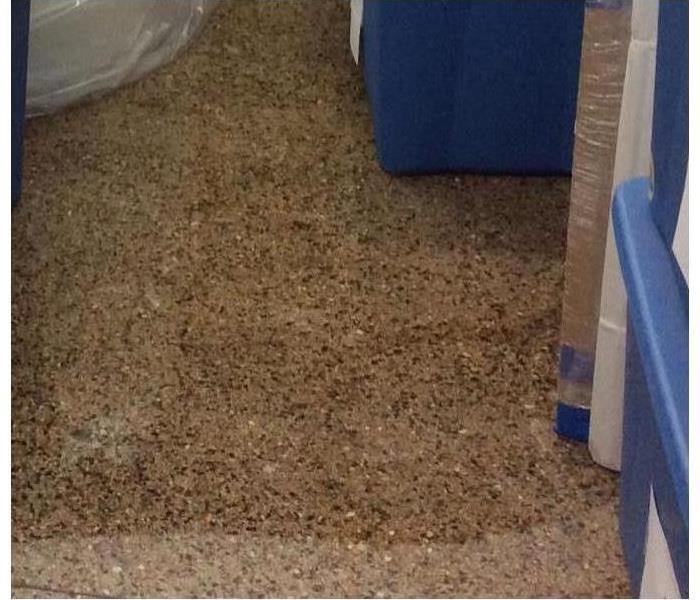 Water pipe break in Westchester, IL
Water pipe break in Westchester, IL
You do your best to safeguard your family, property, and possessions from harm and accident. Unfortunately, disasters in your home can occur and cause widespread damage. When you discover water in home, you can feel devastated by the potential loss of important items and materials. With the prompt help of a professional flood remediation company, it's possible to salvage even the most delicate possessions. There are things you can do to mitigate problems after a flood, but you can trust the pros to make your home whole again.
The Process the Professionals Use
As soon as you can, get in touch with a water removal company. Most crews can arrive at your home within a few hours of your call, regardless of the time or the day when you call. Once on the scene, the technicians will do the following:
- Evaluate what caused water in home.
- Assess the extent of the damage.
- Remove all water.
- Thoroughly dry the area.
- Disinfect the affected area.
- Restore and rebuild as needed.
Floor Cleaning
Hardwood floors and carpets often bear the brunt of flooding. Using dry cleaning, crews can often salvage these materials. Technicians will first tear out the carpet or wood and set them out to dry. Crews will remove all saturated water and will dry the items to avoid the growth of mold.
Document Cleaning
You've probably got books, photographs and documents in your Westchester, IL, house that you can't afford to lose. The pros will treat each item delicately, laying them out to dry. Next, a technician will use freeze-drying to remove all water. Once the paper is dry, it won't crinkle or curl.
Electronics Cleaning
Never turn on an electronic after a broken pipe or other problems caused a flood. Professional technicians will carefully get rid of any water and dry the product. Crew members have the right equipment and tools to safely do the job.
Don't let water in home spell doom for you. Professional teams have what it takes to restore your materials and belongings.
Three Common Water Issues Your Commercial Building Might Experience
1/31/2020 (Permalink)
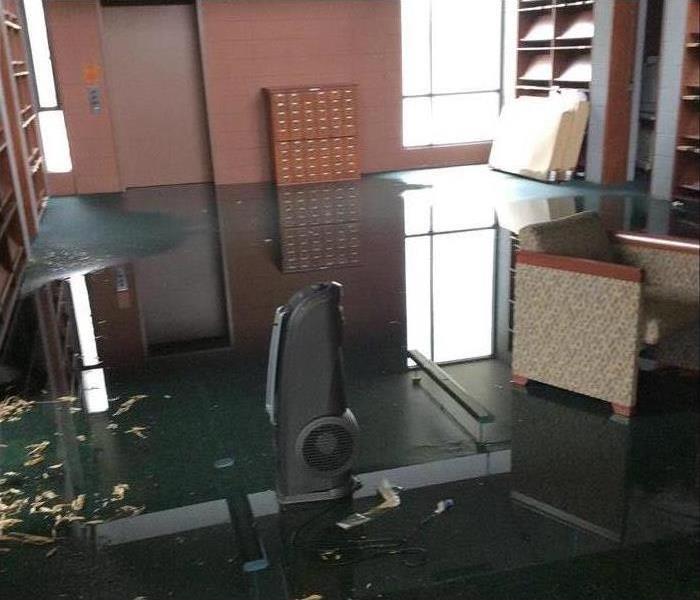 Commercial water loss in Maywood, IL
Commercial water loss in Maywood, IL
3 Common Water Problems You May Find in Your Commercial Building
No matter what kind of commercial building you have in Maywood, IL, it is important to keep it in top condition. Water damage is a common problem that can occur, and it can stem from leaking pipes or something larger. The following are a few issues that you should look out for.
1. Backed Up Plumbing
Sometimes, a sink or toilet backup may not be a big deal, but if it is happening often, then there could be a larger problem. Plumbing can become backed up when the water is not able to drain as it should. While this may be a simple clog that can be quickly taken care of, it can also indicate problems in your pipes. Sometimes this happens if certain materials are disposed of improperly. To prevent this, only flush paper products that are designed to dissolve quickly and avoid pouring food or grease down your drains.
2. Broken Pipes
While your plumbing system is designed to last for a long time, it will not last forever. Depending on the materials from which they are made, some pipes will need to be replaced every few decades while others may last much longer. Whatever kind of pipes your building uses, it is a good idea to perform inspections and maintenance regularly to find and repair any damage before a pipe break occurs.
3. Leaking Pipes
Leaks may not seem like as much of a problem as breaks, but they can cause quite a bit of damage over time. Excessive amounts of moisture can cause mold to grow in your building and can weaken some materials. Along with causing physical issues, leaks can also result in higher water bills, so it is best to have them fixed as soon as possible.
If any of these common problems have resulted in damage to your building, a water damage remediation company can perform cleanup and repairs. They can fix leaking pipes and other sources of moisture, remove excess water from the area, and restore your building.
What To Know About the SERVPRO Claim Inventory Service
1/22/2020 (Permalink)
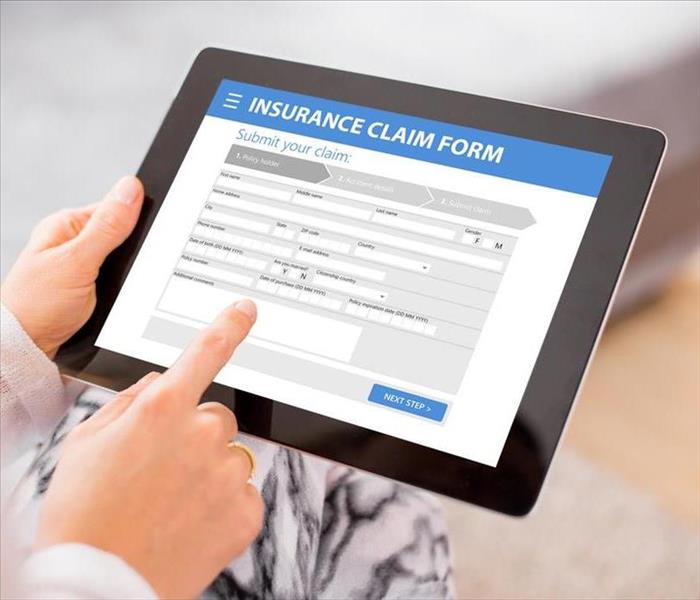 The electronic inventory system allows the restoration team to compile the list as they go
The electronic inventory system allows the restoration team to compile the list as they go
Many Reasons You May Find the Electronic Claim Inventory
When you have a business in Berwyn, IL, that has gone through storm or fire damage you may choose to contact your local SERVPRO for restoration. Not only can these professionals help with repairs, but they offer several services that may help with the insurance claim as well. You may find the electronic claim inventory system particularly useful for several reasons
1. It Keeps a List of Damaged Items
One reason the inventory system is useful is the fact that it can keep a list of damaged items. Many times when filing a claim insurance agents require these lists so they can calculate the cost of the damages. The electronic inventory system allows the restoration team to compile the list as they go, making it easier to keep track of everything.
2. It Allows you to Access Information Electronically
The ability to access the information you need for your claim electronically, can help when it comes time to file the insurance claim. Electronic access cuts down the time it would normally take to contact your restoration team and ask for information. In addition to no longer needing to play phone tag, you won’t be interrupting the restoration work every time a question needs to be answered.
3. It Helps Track Progress
Another aspect you and your insurance agent may find useful is the fact that this system can help track the progress of the restoration. As your repair team completes tasks they can update the system to show what jobs have been completed and what repairs still need to be finished.
When it comes to making an insurance claim the inventory system offered by your local SERVPRO can help. This system can keep a list of damaged items, allow you to access your information electronically, and track the restoration process. All of these things may help with the claims process.
Goal Setting From Our SERVPRO Owner
1/14/2020 (Permalink)
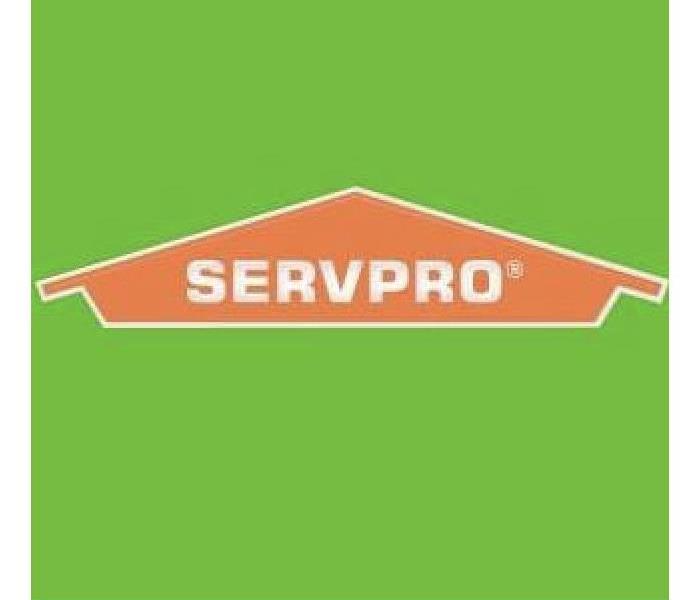 So, next year before you go and set goals think about the bar. Have you set the bar high or have you thrown it on the ground?
So, next year before you go and set goals think about the bar. Have you set the bar high or have you thrown it on the ground?
Every year we set goals for ourselves that are just maybe too unrealistic. It is not that we don't want to achieve them but it is that "life gets in the way."
Is setting goals something we should all do or is it that we need to set higher expectations? Goals help us to gauge our place in life, but if we are on the correct path, don't they hold us back? People say without them we are just going to do what we need to get by. I think goal setting has brought us to where we are now, a country that just works enough to get by.
I set my goals as I have been taught and then stop and said: "what the heck am I doing?"
The goals I listed out were:
Work out with my kids!
Growth of the company!
Spend more time with my wife!
Organize the garage!
Landscape the yard!
All of these are goals that you can achieve but one directly affects the other. If I reach my goal of working out with my kids, it means that I have to be home in time to work out with them prior to them having to eat dinner, shower, and study. This means that I might have less time Monday - Friday at work to reach my second goal which is to grow the company. Then, in turn, it means that I might have to work weekends making the third goal a total disaster. I don't need that to happen, so this better work.
So, why do I do this every year?
Oh, yeah! To make sure I stay on task and grow myself, or at least that is what I have been taught over the past 45 years of my life.
Think about it, has no one ever challenged goal setting? 45 years is a long time and I think of all of the thought processes that have been changed. So, I say stop setting goals and start raising the bar on how you should live your life. If you have kids, work out with them. Show them that taking care of your body is a good thing, we only have one! Grow your business each and every year by doing what you need to do! Be present and make sure that you hire the A players. Spend time with the ones you love and dammit keep up with your yard work and housekeeping. Make a schedule and follow it. Set the bar high and keep it there. Quite looking to give yourself a way out.
I know this might be a waste of your time but I think this is an area of business/ life that we don't spend enough time on. Look at other countries and they spend a month of each year and the company they work for is still in business, grows each year, has a lower divorce rate, well-organized homes, and minimal and healthy landscaping. Believe it or not, that is a goal every year for them without calling it a goal. Since it is expected it just happens. I fully understand that we are not other countries but wouldn't it be nice to have more vacation time, family time and less stuff to take care of? I think they do that by making sure they communicate better, set higher standards and keep the want clutter down to a minimum. Raise your expectations and you will never have to set another goal again. You could be more tomorrow then you are today if you really think about what I am saying.
So, next year before you go and set goals think about the bar. Have you set the bar high or have you thrown it on the ground? A bar on the ground is quite easy to get over and it really does not involve any skill.
Keeping Your Rental Home Mold-Free
1/8/2020 (Permalink)
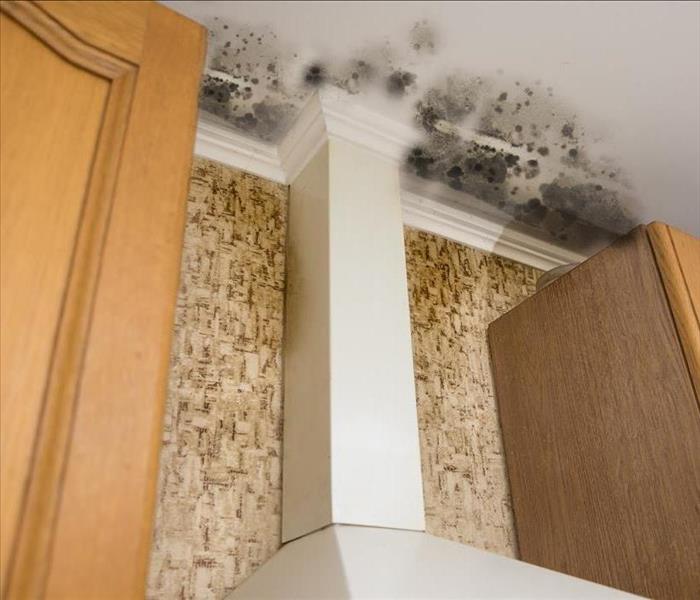 Black mold damage in a North Riverside, IL home
Black mold damage in a North Riverside, IL home
Prevent Mold Growth in Your Buildings
Whether you own one rental property or several, it's important to stay on top of routine home maintenance, including mold prevention, for all residences. Stopping mold from growing in a rental home is tasked to both the tenant and the landlord, though as a landlord, you carry the responsibility of ensuring that your properties are habitable. To help prevent mold growth in your buildings, take these tips and share them with your tenants.
- Fix water leaks
- Control humidity levels
- Clean and dry thoroughly after water damage
Home Maintenance
Regular maintenance and cleaning are important aspects of keeping your North Riverside, IL, home mold-free. You should routinely inspect roofs, walls, and plumbing for leaks. If you find any issues, fix them as soon as possible. Mold thrives in moisture, so removing the water source is crucial for stopping mold. If possible, have all carpets and upholstery in the home sanitized on a regular schedule.
Air Quality
Controlling air quality is crucial in mold prevention. Mold spores live in the air and are found everywhere. When spores are trapped in areas with high humidity levels and land on organic materials, they will likely grow into problematic colonies. Keeping your air well-circulated and controlling humidity can help prevent mold growth.
Mold Remediation
If your property suffers water damage of any kind, you should immediately contact experts in water and mold damage restoration. While you can take some steps yourself to lessen the damage, you will need professionals with the correct training and equipment to fully clean and restore your property.
Take mold prevention steps early to best avoid any issues in your North Riverside, IL, rental building. As a landlord, you are responsible in the long run for ensuring safe and clean residences for your renters. Share this information with your tenants so that they can take steps to prevent mold while they reside in your property, as well.
Commercial Fire_4_Business Tips for Fire Preparedness
12/31/2019 (Permalink)
 A contingency plan needs to be clearly communicated
A contingency plan needs to be clearly communicated
Commercial Fire_4_Business Tips for Fire Preparedness
As a successful business owner in Broadview, IL, you strive to be prepared for anything. When it comes to a fire breaking out, just having alarms and extinguishers is not enough. A fire contingency plan is a well-thought plan catered specifically to your business to ensure the safety of everyone on-site. Establishing a plan may also reduce the damage to a structure, speeding up the fire damage restoration process.
Establish Specific Roles
Along with establishing and mapping an evacuation plan, which should be posted throughout the building, it’s important that people completely understand what to do in case of an emergency. As part of the plan, assign key roles to specific people to help guide a smooth evacuation. These roles may include:
Assign one person to be the overall point person for planning, preparing and instigating the plan. This person should also be responsible for conducting a headcount at a determined safe location.
Since no one knows when a fire may break out, the main fire chief should have an assistant. They work closely with the main person to understand protocols. If both are on-site, the assistant can take responsibility for alerting employees and calling 911.
Depending on the size of the business, route guides should be available to ensure that set evacuation paths are clear and people can calmly exit the premises.
For businesses with multiple floors, assign a monitor to each floor to verify the area has been cleared.
Cover all the Bases
A contingency plan needs to be clearly communicated. Along with taking the time to ensure each employee knows how to use emergency equipment, it is also important to test the plan. Just like a school drill, businesses should conduct a fake emergency evacuation to ensure it works and see areas that may need improvement.
A contingency plan provides peace of mind that your most valuable assets, your people, will know exactly what to do in case of an emergency. Take the time to prepare and communicate to ensure your plan works.
Key Differences Between Storm Damage and Flooding
12/23/2019 (Permalink)
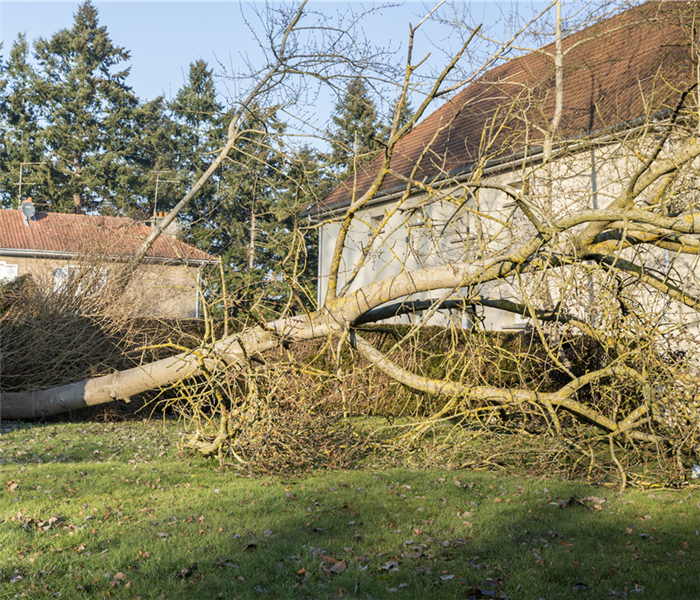 Wind gusts can even knock over trees onto the building
Wind gusts can even knock over trees onto the building
It's a scenario that no business owner wants to encounter: You come to work one day and find water on the floor or dripping from the ceiling. Not only do you worry about the cost and inconvenience of cleaning it up and making repairs, but there's a chance it'll interrupt your operations. Flood damage can be severe, but incoming water doesn't necessarily have to cause widespread problems. It's important to make a distinction between a flood and damage from a storm.
Prevention Tips
There are ways you can minimize the risk of flooding in your Hillside, IL, office. Keeping water out of the building will help safeguard building materials, electronic equipment, documents and more. Look at the following safety measures:
- Install a backflow system in the plumbing.
- Have a sump pump in the lower levels of the facility.
- Check pipes and the roof for leaks.
- Make sure water is draining away from the building.
Storm Damage
Heavy rains and other severe weather such as thunderstorms or hurricanes can cause significant storm damage. High winds can damage the roof and tear off the siding. Wind gusts can even knock over trees onto the building. Rain can come into the office through cracks in the foundation or gaps in windows. All of these factors can destroy drywall, flooring and other building materials. Without the help of a professional disaster cleanup team, you face a lengthy recovery process.
Floods
Flood damage can come from both storms and from other causes. While incoming rain and overflowing waterways certainly pose dangers. Your office may be prone to floods from other sources such as a sewer backup, the main water line break or bursting pipes. Floods from these culprits can sometimes be more severe because you may not immediately detect them.
Whether your building has suffered flood damage from a storm or a malfunctioning system in the office, you need to act fast. Call a reliable water removal expert to make your office safe once more.
Important Clean-up Steps After a Flood
12/6/2019 (Permalink)
Important Clean-up Steps After a Flood
If you discover water in home, it's important to respond quickly to mitigate the damage. With the right help, you can salvage many of the items in your Riverside, IL, house. There are steps you can take to minimize problems, but you should also contact a professional to handle the more significant damage.
Immediate Aftermath
Your first job once you discover flooding in your home is to try to stop the source, if it's safe to do so. You should also contact your insurance company to file a claim and get a hold of a professional flood remediation team to assess the extent of the damage. In the meantime, you can do the following:
- Unplug all electronics.
- Remove items out of the water or away from the wet areas.
- Lay clothes, documents or other materials out to dry.
Cleaning Carpets and Furniture
A professional water cleanup company may be able to salvage wet carpet and furniture. The team will use a thorough dry cleaning process to extract water from the floor and from sofas or chairs. It is also important to dry out the materials to discourage the growth of mold. Crews will use high-powered fans and dehumidifiers to accomplish this. Lastly, a technician will sanitize the area to kill any fungal growth.
Cleaning Documents
Whether it's a broken pipe or a massive storm that brings water inside your house, paper can suffer damage from the flood. Specialists can use freeze-drying methods to save items such as books, photographs, maps and documents.
Cleaning Electronics
It's no secret that moisture and products such as computers, televisions and stereos don't mix. When you have water in home, electronics can suffer. Luckily, the professionals have effective methods to carefully treat the items. The team will start by drying the outside and then will move to the interior of the electronics. You shouldn't try to handle wet electronics by yourself.
For water in home, make sure you get a professional water removal company on the job. You can rest assured knowing you can still use many of your belongings.
Will Insurance Pay For Mold Remediation?
11/27/2019 (Permalink)
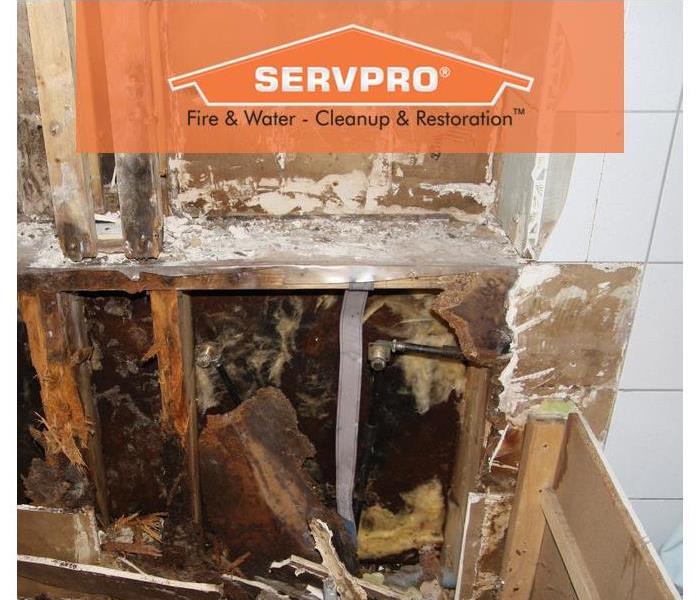 Does your insurance company cover mold damage?
Does your insurance company cover mold damage?
Will Insurance Pay For Mold Remediation?
If you notice fungus growth, it's best to eliminate it quickly, using the professional services of SERVPRO. These specialists have the equipment and knowledge to assist in the cleanup process. Restoration costs can add up quickly, though, and you're probably wondering whether your homeowner's insurance can help pay the bill. Sometimes it does, and sometimes it won't. You'll want to review your policy and speak with your insurance adjuster.
How To Prevent a Candle Fire
11/22/2019 (Permalink)
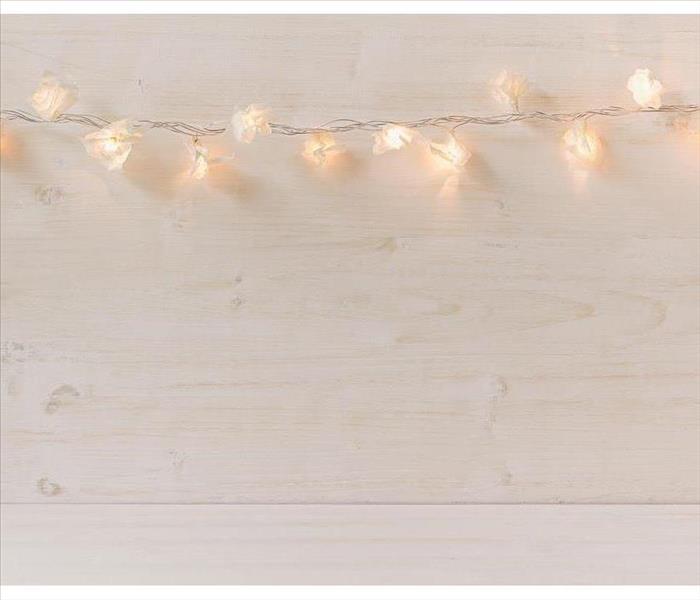 Fairy lights a candle substitute you can use
Fairy lights a candle substitute you can use
How To Prevent a Candle Fire
You might be comforted by the scent of a candle burning in your living room, but this object poses a serious risk to your home in La Grange Park, IL. Candle fires unfortunately happen often and usually because of negligence on the part of building occupants. If you wish to keep a candle in your home, there are ways to do so safely. These guidelines can help you enjoy the scent and warmth of a candle in your home while reducing the risk of a candle fire.
Use Alternatives
Fortunately, there are many candle alternatives that you can place in your home. These options let you enjoy the same effects of a regular candle but aren’t hazardous in any way. Below are some examples of candle substitutes that you can use:
- Battery-powered/flameless candles
- LED string lights
- Lava lamps
- Fairy lights
If you prefer to fill your home with the scent of a regular candle, there are also options that are designed to mimic the smell you love. Wax warmers, air fresheners and potpourri can give off a similarly pleasant scent with no fire hazard.
Practice Basic Candle Safety
If you must burn a candle for any reason and candle alternatives won't suffice, it’s your responsibility to be cautious and use common sense. Always blow out candles before you go to bed and never leave a flame unattended. If you have small children, never leave them alone with a burning candle. Additionally, when you light a candle, always ensure that there are no objects located within a twelve-inch radius of the candle. Taking these steps can protect you against harm and significantly reduce the risk of fire.
A candle fire cannot be prevented in some cases, even when you do everything you can to keep your home protected from danger and use reliable candle alternatives. No matter what kind of fire damage you’re facing, calling emergency restoration services for a fire cleanup can help your home recover immediately.
COOKING FIRES
11/18/2019 (Permalink)
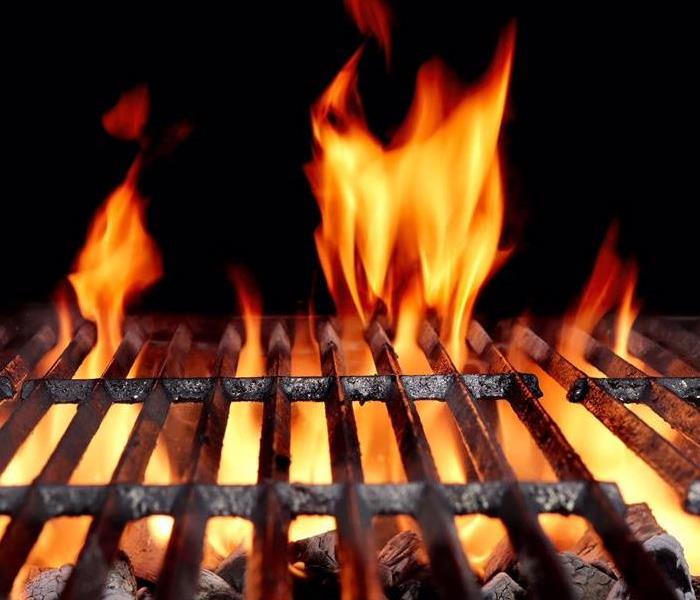 If the unthinkable happens and a fire strikes your business or home, give the experts at SERVPRO of La Grange Park/North Riverside a call.
If the unthinkable happens and a fire strikes your business or home, give the experts at SERVPRO of La Grange Park/North Riverside a call.
Did you know cooking equipment is the leading cause of residential fires?
As the holiday season begins and you find yourself in the kitchen more often while hosting friends and family, fire precautions should be top of mind.
A property owner experiences a flood of emotions when a fire ravages their business or home. Fear, uncertainty, stress, and doubt about the future
of the property and their livelihood can be overwhelming to the property owner long after the flames have been extinguished and the smoke has cleared.
After the first wave of heroes has rescued the property, let your the SERVPRO of La Grange Park/North Riverside professionals help you restore it to its preloss condition. Combining rapid response, the utmost professionalism, and open communication throughout the entire job process, we strive to restore not only the home or business structure but the customer’s peace of mind as well.
The National Fire Protection Association (NFPA) offers the following eye-opening statistics on structure fires.
*482,030 structure fires were reported in the United States in 2018.
*These fires caused $9.9 billion in property damages.
*One structure fire was reported every 48 seconds.
If the unthinkable happens and a fire strikes your business or home, give the experts at SERVPRO of La Grange Park/North Riverside a call. We will help make it “Like it never even happened.”
What Causes Sewage Backup During a Storm?
11/12/2019 (Permalink)
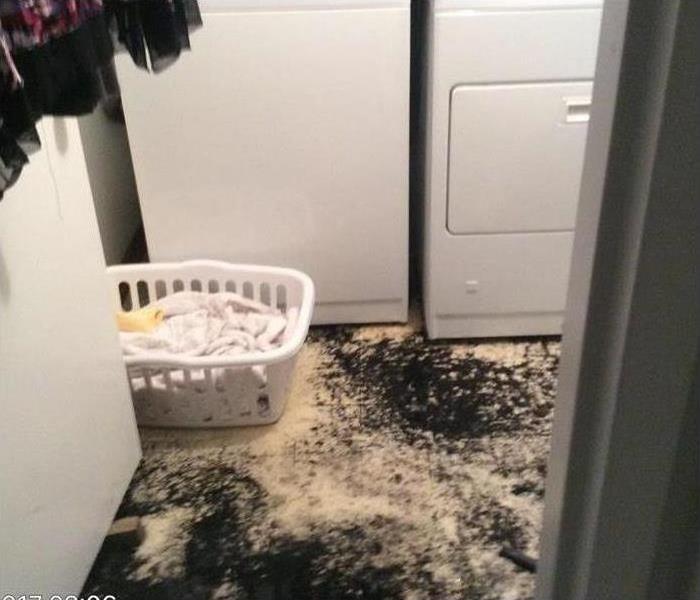 Sewer water backup in a laundry room
Sewer water backup in a laundry room
What Causes Sewage Backup During a Storm?
A flooded basement can be devastating, especially if you use that space to store valuable heirlooms or photos. Unfortunately, this is a common problem with several causes, including:
- Sewer water backing up into your home
- Surface water flowing near the foundation
- Groundwater being pushed into the basement
Surface water often comes into the basement via clogged gutters or sloped pavements and landscapes. These problems are relatively easy to fix.
Preventing groundwater flooding is a bit more complicated. Groundwater can seep into the basement when hydrostatic pressure pushes the fluid through holes or cracks in the floor. Still, there are ways to prevent this issue, namely installing a drain system to reduce the hydrostatic pressure.
Sewage Backup
Major storms can also lead to a flooded basement in your Forest Park, IL, home. This is particularly a problem in houses built before 1980. Many of these homes contain an exterior drain at the basement level that attaches via a pipe to the city's sewage system. If the rain level in that system gets too high during a storm, the water can flow back toward your house. You may be able to solve this issue by installing an interior drain system with a sump pump.
Even newer homes may have to deal with sewage problems during storms, however. The local sewage system is often overwhelmed during major rainstorms, causing sewer water to back up into homes. Keeping your pipes clear of tree roots and installing backflow valves can help protect your home from sewage backup. However, you cannot completely prevent it from occurring.
Dealing With Basement Flooding
No matter what the cause, a flooded basement can cause plenty of damage. The water can destroy the walls and floors. It can also contaminate any belongings you are storing in that room.
Thankfully, your home and your possessions can be saved with the help of an emergency restoration company. Cleanup professionals do more than just drain the water from your property. They can also disinfect your house, remove any odors and excess mold, and take care of your personal items.
Signs of Wind Damage to Your Commercial Roof
10/26/2019 (Permalink)
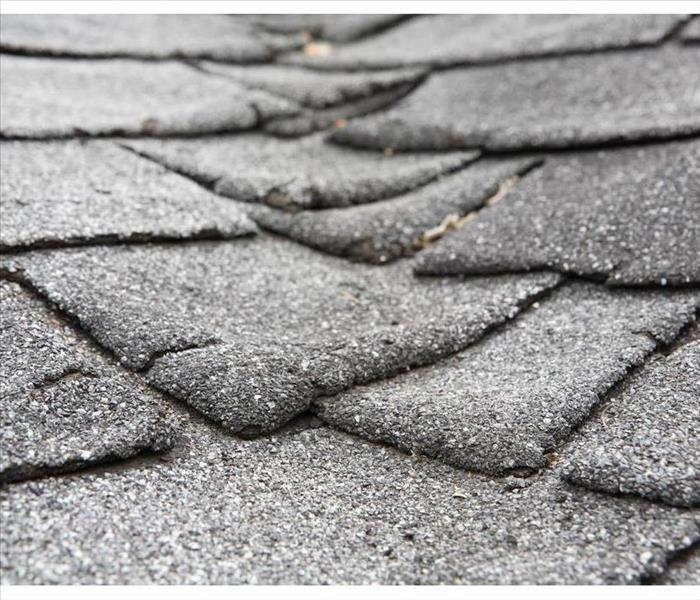 Damaged shingles on roof
Damaged shingles on roof
Common Signs of Wind Damage That You Might Find on Your Commercial Building
After a storm hits your business in La Grange Park, IL, you may notice various forms of damage on your property. The high winds can lead to roof damage, structural problems and other complications. No matter what kinds of issues you are experiencing, the key to addressing them properly is to know how to identify them. Here are some common signs of wind damage that you may find on your commercial building.
Curling Shingles
One potential issue that may result from high winds is curling shingles. When looking for signs of these damaged materials, be sure to check the following areas:
- Edges and corners of roof
- Area surrounding chimney
- Roof ridge
If you locate damaged shingles on your roof, make sure that you call a professional as soon as possible. Shingles that have begun to curl don’t function as effectively, which means they pose the risk of allowing water to leak through the roof. This can lead to severe water damage in your business if you don’t take care of the issue promptly.
Roof Leaks
A leaking roof is another form of roof damage that you should address right away. Leaks can appear in many places on your roof. To identify a problem, check the top floor of your building for any wet spots on the ceiling. Because leaks can lead to more serious water damage if left unaddressed, be sure to have them repaired immediately.
Chimney Damage
If you come across any forms of damage to your chimney, this could be a sign that you need to schedule a roof rebuild. When inspecting your chimney, check to see if there are any issues with the flashing. If it is split or missing, this is a major indicator that your roof has been hit by wind damage.
Any kind of roof damage to your La Grange Park, IL, business should be taken seriously. Contact emergency restoration services immediately to help your building recover from the effects of a storm.
How To Deal With Water Damage in 5 Steps
10/18/2019 (Permalink)
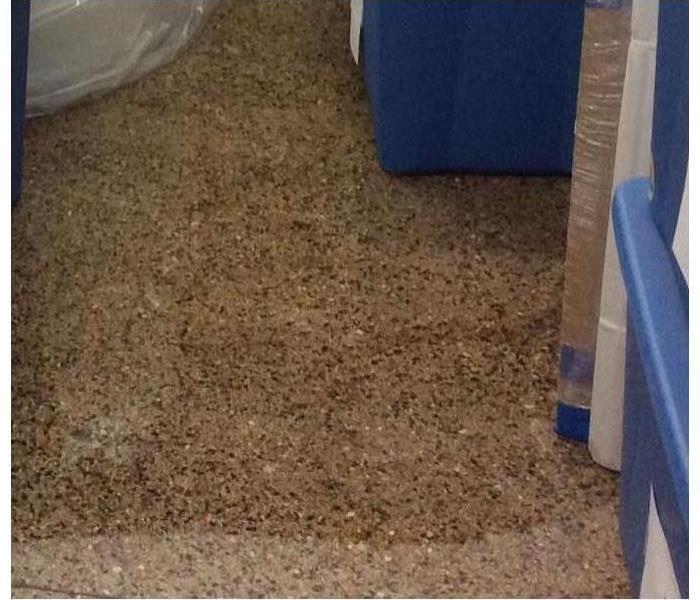 Water damage in a Forest Park, IL storage area
Water damage in a Forest Park, IL storage area
How To Deal With Water Damage in 5 Steps
Water incidents can devastate your home in Forest Park, IL, if they are not dealt with immediately. They can leave behind massive water damage, which not only ruins the residence's look but also endangers its stability. Reduce damage to your home by taking the following steps after such an incident.
1. Check for Safety
Before dealing with the damage, you should ensure you and everyone else in the area is safe. A flooded area can have electrical hazards, toxic chemicals or other dangers enhanced by water. Disconnect all power before approaching.
2. Find and Stop the Source
If the area is safe, determine the water source and stop the flow, if possible. These incidents are sometimes caused by natural flooding or an outside leak. Find the entrance and seal it. Other times, these incidents occur due to damaged or broken pipes. Stop the leakage if you can or turn off the water supply to the pipes or house.
3. Call for Assistance
Water damage is something you cannot solve by yourself, so be prepared to contact the necessary services. First, call 911 if you or someone else is injured or if there is a dangerous situation. Then, contact a professional water cleanup company to deal with both excess water and the damage done to the home. Finally, call the insurance company.
4. Clear Excess Water
While you may not be able to deal with the water incident entirely, you can still take steps to clear some of the excess water. Depending on the source, you can use a mop or a water vacuum to clear the majority. Air conditioning, a fan or an open window can also dry out the area effectively. If it is too dangerous, wait for the cleanup professionals.
5. Assess the Damage
Now that the water has been removed, you can inspect the severity and size of the damage. Take note of details, as this information can be helpful for the insurance and cleanup companies.
Water damage can leave lasting consequences. Through quick action, you can prevent a disaster from permanently impacting your home.
Does Lightning Cause House Fires?
10/9/2019 (Permalink)
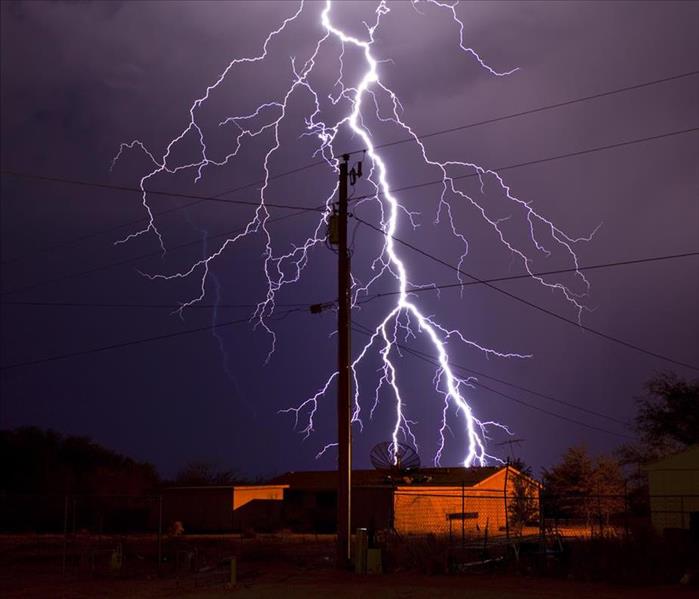 If a lightning fire strikes in your home, do your best to stay safe and get the help you need
If a lightning fire strikes in your home, do your best to stay safe and get the help you need
Severe storms in La Grange, IL can cause all kinds of trouble, including flooding, wind damage and even fire damage. There are precautions that can be taken to help prevent or minimize these types of damage, but due to the unpredictability factor of a lightning fire, you may do better to learn what should be done to stay safe in the event lightning strikes your home.
Things To Do Before and After a Strike
Because of the random nature of lightning, there are few preventive measures that can be taken to reduce the risk or the shock of a sudden lightning fire. There are a few things however that should be done immediately following a strike. Here are some guidelines for both.
Trim bushes and tree branches away from the house and roof to reduce the risk of a blaze spreading from foliage that may catch on fire
Have a lightning rod professionally installed to draw lighting safely away from the house
Turn off water, lights and other heavy draws on household electricity to reduce the attraction
Following a strike, the first priority is to make sure everyone gets out of the house
Once people are safely out, call 911 to get the fire department on its way, then alert next door neighbors so they can watch their homes
Don’t Go it Alone
A house fire is started by lightning over 22,000 times each year in the United States. Deaths or serious injuries and heavy property damage frequently accompany such a fire. If a strike does hit and start a blaze in your home, the first thing to do is to get out and call for help. Once the flames are out, it would be most helpful to call the fire and water restoration professionals in La Grange, IL to come and assist with fire damage cleanup. There may be a good deal of structural damage as lightning burns fast and hot, so get the help you need.
Take any preventive steps you can to prevent a disaster in an electrical storm. If a lightning fire strikes in your home, do your best to stay safe and get the help you need.
Does Your Homeowners Insurance Cover Mold?
9/26/2019 (Permalink)
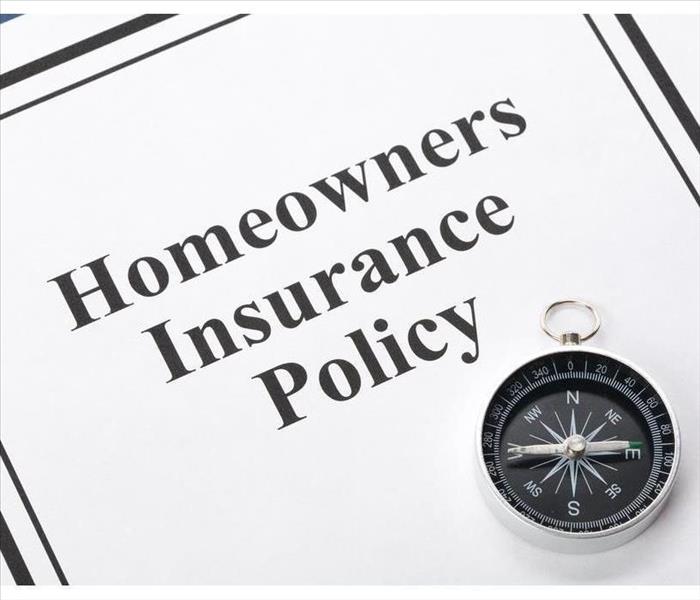 Does homeowners insurance cover mold growth?
Does homeowners insurance cover mold growth?
Have you noticed fungus growth in your home in Westchester, IL, and wondered whether or not your homeowners policy covers it? The answer is: maybe. There are situations where mold may be covered and others where it isn’t. Here are some factors that may determine coverage and what you can do about it.
What Insurance Companies Typically Cover
There is generally no mold coverage clause in a typical homeowners insurance policy, which may vary from commercial property or renter’s policies. Insurance companies expect homeowners to maintain and upkeep their property and only assume risk for covered perils. Covered perils are situations outside of a homeowner's control that occur through no fault of the homeowner. These include things such as the following:
- Lightning
- Fire
- Frozen pipes
- Vandalism
- Overflow of water from household items
- Impacts from snow, ice, or sleet
Fungus growth occurring from one of these situations where the impacted area is restored immediately by mold remediation specialists may be covered under your policy.
What They Don’t Cover
If water has been standing unnoticed for several days or weeks causing fungus to grow, you may find you are not covered. Additionally, if mold is caused by water seepage in an area that should have been updated, repaired or maintained, then you may not be covered by insurance. These would be your responsibility as the homeowner.
What You Can Do About It
You may be able to obtain a mold insurance rider as an addendum to your current insurance policy. This may provide additional coverage that your existing homeowners policy doesn’t. However, the insurance company may put a cap on the costs they will incur, or they may say they will cover certain costs but not others.
Fungus growth is a worrisome issue. Insurance companies generally cover damage occurring as a result of perils outside the control of the homeowner. They often don’t cover anything that could be the homeowner's fault. You may want to consider additional coverage as an addendum to your current policy to mitigate the risk if you have any concerns.
Why Hire a Certified Water Damage Expert
9/26/2019 (Permalink)
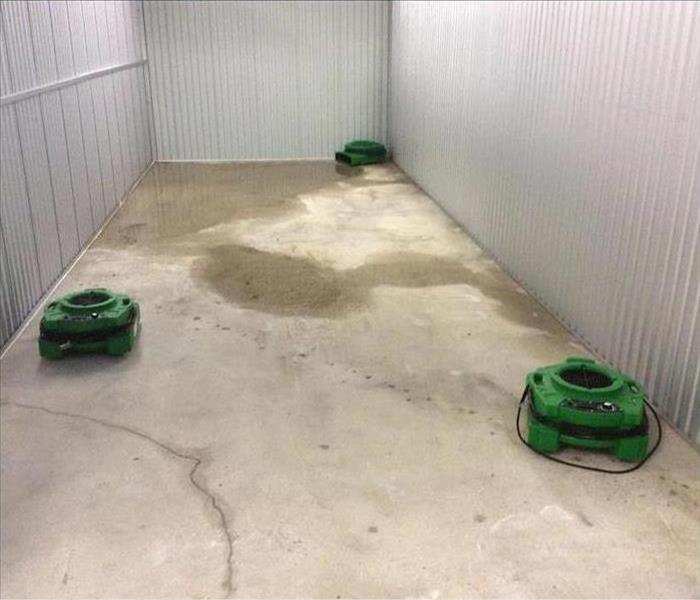 Commercial water damage in La Grange, IL
Commercial water damage in La Grange, IL
If you have water damage in La Grange, IL, there is a good chance you need to hire a certified water damage expert to safely return your location to normal. Faulty or old pipes can ruin personal belongings and structural materials. If not cleaned up swiftly and correctly, mold can begin to grow in as little as 24-48 hours. Certain types of water also need to be disinfected. There is considerably more to water clean up than just soaking up excess water. It is important to get a certified specialist to ensure your business is restored the right way.
What They Do
The Institute of Inspection, Cleaning and Restoration Certification is a governing body that sets standards for the inspection, cleaning, and restoration industries. To become certified, technicians must pass a series of exams and keep up with continuing education credits. A restoration specialist performs water clean up and restores your property to its pre-flood condition. Certification assures industry-leading skills in a variety of areas:
- Microbial remediation
- Commercial drying
- Odor control
- Water damage restoration
- Structural drying
How To Know If You Need an Expert
The extent of your water damage determines if you need a certified restoration specialist. For example, if you have a broken pipe and water has leaked into the drywall, subfloor, or other structural materials, you need to hire a professional. Not only will they remove materials that need to be discarded, but they will also use special drying equipment that can air things out before mold sets in. If mold is already a problem, or microorganisms are present, a specialist will develop a plan to disinfect the area and dry it in a way that does not spread germs or mold spores throughout your building.
Your business is too important to put it in the hands of someone that is not properly trained. By hiring a certified water damage expert for your water clean up, you can trust that they will get the job done right and restore your building to its previous condition.
4 Things To Do If Your Roof Collapses
9/10/2019 (Permalink)
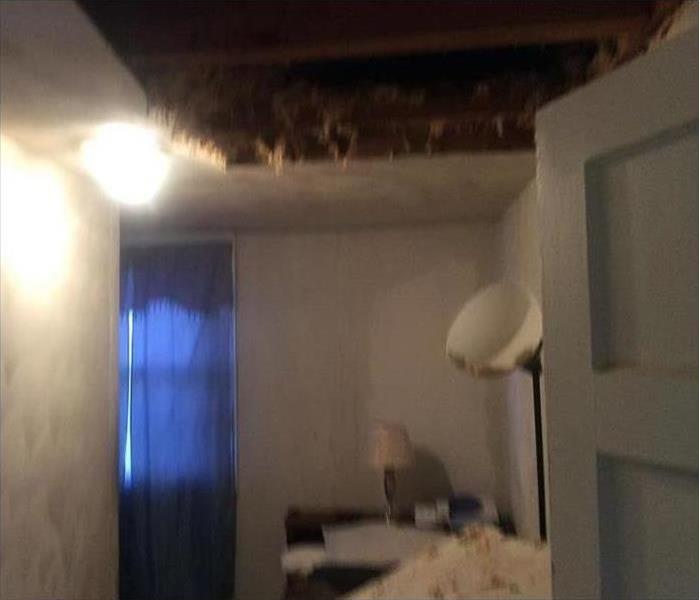 Roof collapsed in a Maywood, IL home
Roof collapsed in a Maywood, IL home
4 Things To Do If Your Roof Collapses
There are plenty of DIY projects you can tackle at home, but if a winter storm or blizzard blows in to Maywood, IL, leaving serious roof damage behind, it is time to put down the hammer and pick up the phone. Disaster cleaning after a roof cave-in or storm damage is a job for professionals.
Do Not Enter
If a storm has caused your roof to collapse, do not go back in the house for any reason. Instead, you should do the following:
- Get out.
- Don't stop to search for, or collect, personal belongings.
- Take your family to a place where they are safe from the blizzard.
- Call 911.
Contact Your Insurance Agent
As soon as your family is safe, call your insurance agent. Let your agent know what has happened and check on what your policy will cover. Then call a company that handles winter storm restoration.
Call a Professional
A home with structural damage such as a roof collapse calls for specialized skills, and you will need to call in a professional restoration team to handle the job. They will take care of cleanup and repairs and help get your life back to normal as quickly as possible. Cleanup and restoration after a roof collapse or other serious roof damage usually involves the following steps:
- Clearing debris, such as dry wall, boards or broken pipes
- Drying the area using fans and heaters
- Repairing areas with water damage
Stay in a Hotel
Make arrangements for your family to stay outside your home for a week or more. You could stay with friends or relatives, or you may prefer a hotel. Be sure to ask your insurance agent what your policy covers in this regard, and then relax.
A winter storm can be stressful, but the cleanup doesn’t have to be. When the restoration team is finished, it will look “Like it never even happened.”
Tips for Preventing Water Damage While on Vacation
8/27/2019 (Permalink)
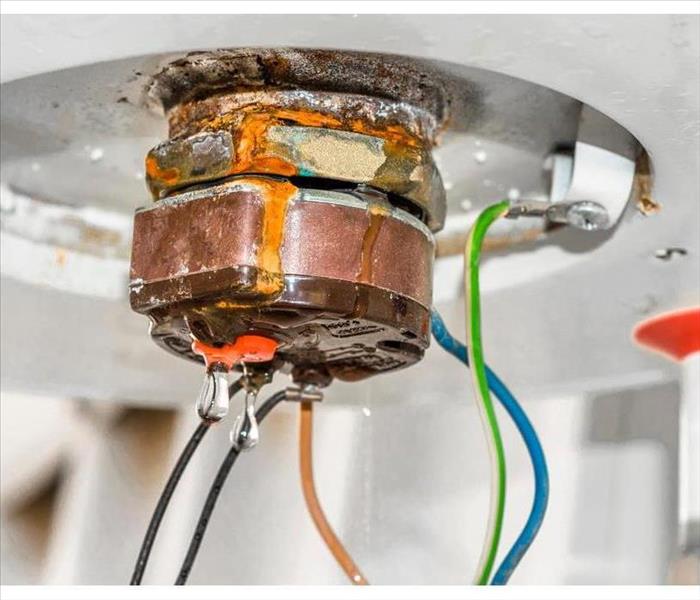 Check your water heater for leaks
Check your water heater for leaks
When you go on vacation, you want to be able to relax knowing that your home in Berwyn, IL, is safe and sound. One of the biggest worries a homeowner can face is that of water damage and water pipe repair. Luckily, there are certain steps you can take to prevent this from happening while you're away.
Inspect Everything
First, you will want to make a thorough sweep of your home, in order to make sure nothing is leaking and everything is sealed up tight. Some commonly problematic areas to include in your inspection are:
- clear the debris from the sump pump
- check your water heater for leaks
- make sure there isn't a leaking or broken pipe under any of your sinks
- see that the hoses that connect to major appliances are in good shape
Prepare Your Home
Next, you might want to take certain measures to prepare various protection systems in your house. You can clean out your gutters. Reseal any windows or repair your roof if necessary. If you found a leak, do some water pipe repair before you go. If you are taking a vacation in the winter, insulate your pipes and leave the cupboards open so they don't freeze. Finally, remember to turn off your water, and flush the toilets after you do so to drain them of water.
Keep an Eye On It
If possible, have someone visit your home periodically throughout your absence to make sure it's not flooded. You can ask a friend or you could hire someone. Another option is to install a leak detection system. They will set off an alarm and can notify your phone. It's also a good idea to have a licensed water damage restoration specialist picked out, in case you do need to address a situation right away from afar.
The last thing you want to do when taking a much needed vacation is rush home to complete a water pipe repair. If you leave your home in top condition and make sure it is looked after, you won't ever have to!
Preparing Your Business for a Severe Storm
8/20/2019 (Permalink)
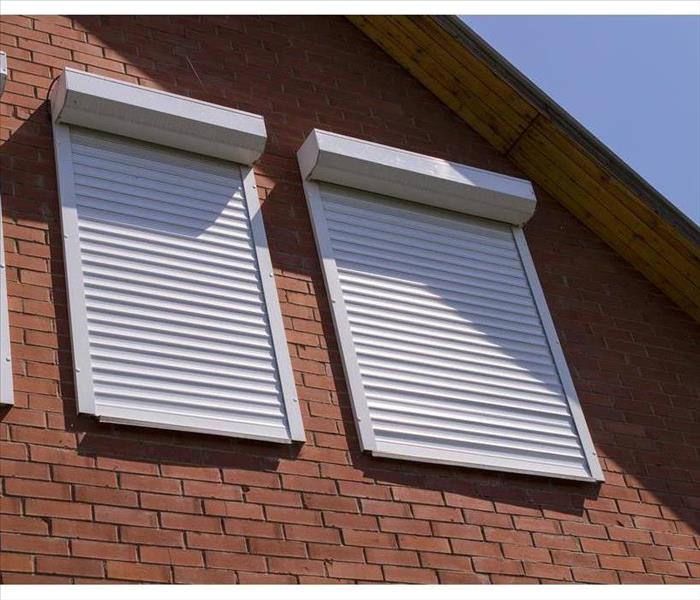 Invest in operable shutters to protect windows from high winds
Invest in operable shutters to protect windows from high winds
A rainstorm or thunderstorm can occur suddenly, and you may not always have adequate time to prepare. Luckily, there are steps you can take now to prepare your North Riverside, IL, business for inclement weather.
Before a Storm
Unfortunately, storms can damage property and injure customers and employees. Here are some tips for minimizing damage:
- Invest in operable shutters to protect windows from high winds.
- Make sure all trees close to your business are healthy, and keep limbs trimmed.
- Install surge protectors or other forms of lightning protection.
- Inspect the roof to make sure it can withstand heavy rains.
- Create a plan for yourself, employees and customers in case severe weather strikes during business hours.
During a Storm
The storm plan you create should include basic safety precautions such as not using landline phones or running water, staying away from windows, etc. It should also list the safest areas of the business to go during a storm. If you have employees that may be out of the office when a storm hits, be sure to include information about how to stay safe while on the road during a thunderstorm or rainstorm, i.e., pull over as soon as possible and stay in the vehicle with the windows up.
After a Storm
Although much of the danger is over by the time the skies clear, there are still risks to both people and property. Be sure to avoid downed power lines and report them to the proper authorities. Also, never attempt to drive through a flooded area. After you ensure the safety of your employees and customers, it is important to begin repairing any damage. Before beginning repairs, though, be sure to take either photos or video for the insurance company. After documenting the damage, begin cleanup efforts as soon as possible. Water damage can quickly turn into mold growth which can further harm your property.
Preparing for a storm will go a long way toward minimizing damage, but you may still need to hire a certified restoration company to get your business back to normal after a thunderstorm or rainstorm.
3 Steps for Protecting Fire-Damaged Property
8/13/2019 (Permalink)
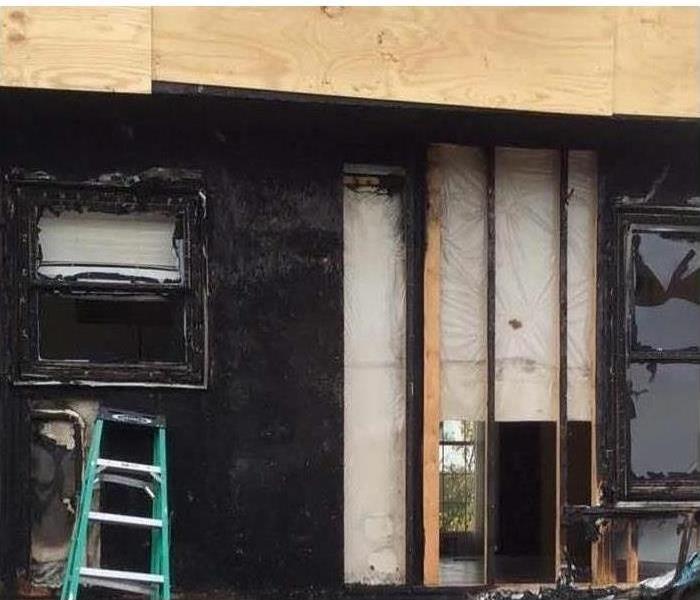 Fire damage in Broadview, IL
Fire damage in Broadview, IL
After your commercial property is affected by fire damage, looters may try to take advantage of the vulnerability. There are several things you can do to protect your property and everything inside.
Secure All Openings
One of the first things you need to do is board up windows and doors. Choose exterior plywood, or marine-grade wood, with at least ¾ inch thickness. Don't simply screw the plywood into place; instead, screw the wood into place from the inside or use interior clamps. You'll need more than your security system in place because the fire and related damages could have affected the wiring, or the electricity may have been turned off.
Hire Professionals for Restoration and Security
Commercial buildings are harder to secure than private dwellings. Preventing vandals from entering the property may be harder in this situation. Contact fire cleanup and restoration professionals to address the damage; they may also put up temporary fencing and assist with the boarding up process. A temporary arrangement with a security company may also be appropriate for preventing looting and vandalism.
Store Documents and Valuables in a Secure Location
If you have sensitive information, expensive products, or specialized equipment, it's a good idea to move those items to a secure location that hasn't been compromised by fire damage. As fire cleanup efforts are underway, there may be many technicians and workers coming and going through your property. Removing valuables to a secure location reduces the potential for further losses and damages.
Prevention Equals Protection
A fire in your place of business can be an emotionally taxing experience. After the flames have died down and restoration efforts are scheduled, the need for tight security is clear. Protect your property and business belongings from vandals and looting by securing your buildings, hiring professionals, and storing valuables somewhere else. Minimize fire damage on your Broadview, IL, property by taking decisive preventative action.
Efficient Commercial Mold Testing
7/24/2019 (Permalink)
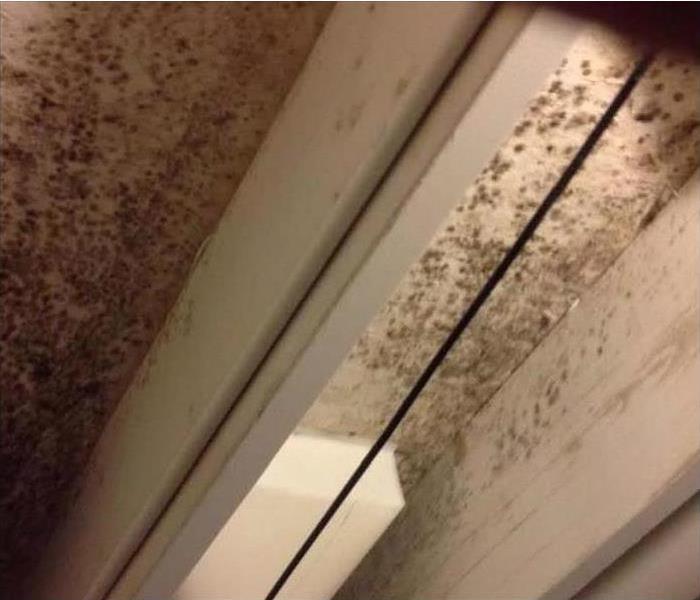 Mold on basement
Mold on basement
Your commercial building in Hillside, IL, needs quality indoor air. Whether you’re serving hundreds of customers daily or working in a small office with a few coworkers, air quality is important for the comfort and safety of everyone in the building. While some mold can be easily seen, other types of mold can affect your air quality and require an indoor environmental specialist to determine the presence of mold.
How To Test for Mold
Mold growth is typically easy to spot. Here are some common areas that mold may be growing in your commercial building:
- Bathroom grout and caulk
- Bathroom ceilings surrounding fans
- Closets
- Basements
However, not all mold is visible. Some mold can be growing deep in your HVAC ductwork, wall cavities or other areas that aren’t immediately visible. Hidden mold can have the same effect on your air quality, so consider hiring a professional indoor environmental specialist who will check the air quality and compare it to the air quality index.
Limits of Mold
The EPA hasn’t set any official limits on the amount of acceptable mold in an indoor environment. This means that there isn’t an official level to compare the presence of mold against. Any positive signs from a mold test should be treated seriously, so ask a specialist about any steps you can take to remove mold from your commercial building.
The Importance of Commercial Mold Test Specialists
Without a specialist, it’s difficult to determine the air quality of your business location. Discover how your air quality compares to other businesses, and ask about ways to improve your air quality to benefit your guests and employees. Look for a mold remediation company that is Here To Help.
Mold may be hiding in areas that you can’t see, but an indoor environmental specialist who is experienced with commercial buildings can help you accurately test your air quality and determine the best course of action for your business.
How To Prepare Your Commercial Property For Winter
7/22/2019 (Permalink)
 It's important to prepare your business for winter.
It's important to prepare your business for winter.
Winter facility preparation is so crucial to your peace of mind at your commercial property. Having a check list of tasks is an efficient way to attack the needs of your building. Unexpected problems will always arise, but if you are prepared it makes dealing with those surprises less stressful.
Facility roofs are a critical point of risk when it comes to winter weather. Facilitiesmanagment.com has listed some safety tips to consider during winter weather.
Safety Tips for Your Commercial Property During Winter.
Flat roofs: Flat roofs require continual maintenance. Conduct required repairs of flat roof membranes and seams before cold weather compromises ability to do work. Be sure to identify areas where water can accumulate and where ice or heavy snow can pile up in wintertime.
Consider forming a snow and ice removal plan to prevent snow burden or ice overload from causing breakdowns in roof surface or even structural integrity. This is especially important when big snows are followed by a fast warm-up that can lead to standing water on roofs.
- Inspect roofs each week leading up to and during the winter season.
- Sweep up debris and check tar seals.
- Keep roof drains clear and be prepared if necessary to pump water off roof.
- Check that flashings are flush and secure.
- Plan for emergency snow removal in event of heavy accumulation. Identify and supply proper equipment and check it in advance of predicted snows.
Slanted Roofs: The various materials from which slanted roofs are made can present different kinds of problems. Even though water runs downhill and shingles or tiles are designed to shunt it off, slanted roofs can still leak and must be sealed correctly to prevent seepage.
- Inspect shingles and roof vents if applicable.
- Check roof-edge waterproofing and seal to prevent potential drafts.
- Install or check ice breakers to protect public safety.
- Trim back trees or branches that may impact roof integrity.
Water seepage is always something to consider in the winter as well. Foundation seepage can reach into the interior of the building and cause mold damage. This can cause air quality in the building to decline, which can lead to illness. Ensuring adequate ventilation and completely drying any areas impacted by moisture collection or seepage are the best ways to prevent mold growth.
Winter Fire Safety
Fire safety involves both preventative and responsive measures at most facilities.
- Have electrical contractors run tests on “last mile” connections from input source to buildings and throughout the facility to check wiring and loads placed on outlets, panels and equipment.
- Run daily checks if necessary to prevent storage of flammable materials including cloths or other solvent-soaked items.
- Educate all people to proper fire escape and fire drill procedures.
- Inventory and check all fire extinguishers.
- Supply adequate heat to keep fire response equipment functioning safely, including value houses, water tanks, pump houses and other supplies.
- If your facility has fire protection tanks, check daily to prevent freezing.
Your commercial property is worth protecting from the winter weather. Should you have a winter fire, mold damage, or water damage give SERVPRO of LaGrange Park/North Riverside a call at 708-240-4873.
3 Common Causes of Home Fires
7/17/2019 (Permalink)
 Cigarettes are another common cause of house fires
Cigarettes are another common cause of house fires
Common Causes of Fires
Fires can devastate homes, and avoiding a home fire Riverside, IL, is often important to homeowners. However, many people aren't sure how to prevent fires in their homes. Learning about common causes of fires can be a helpful first step in preventing your home from sustaining fire damage.
1. Worn Electrical Cords
Many items in households today require electricity to function, which is one reason why electrical fires are common occurrences in residential areas. Over time, cords can become frayed, which can expose the wires and make a fire more likely to occur. It can be difficult to notice if cords that are not in view, such as cords to the television or other appliances, become frayed. In order to help to prevent this type of fire, it can be useful to check the wiring to all devices in appliances in your house and to replace frayed cords.
2. Kitchen Mishaps
There are several reasons fires in homes often begin in kitchens. Fires commonly start in kitchens when pots or pans are left unattended or when grease is left on a stovetop and catches fire. After kitchen fires, many homeowners find it useful to contact fire cleaning and restoration experts to restore their homes to their original states. Fortunately, you can often prevent a home fire by staying in the room while cooking and keeping your kitchen clean.
3. Smoking Inside
Cigarettes are another common cause of house fires, and this type of fire is more likely to occur when a person smokes inside their home. Many people unintentionally fall asleep while smoking on their beds or sofas, which often results in a fire. Improperly disposing of a cigarette in the home can also cause a fire. However, you can often prevent cigarette fires by smoking outside of your home and extinguishing cigarettes in an ashtray outside of your home as well.
Understanding common fire causes can help you to protect your home. Replacing worn electrical cords, using caution when cooking and not smoking inside can help you to prevent a home fire.
Avoid These 3 Causes of Sewage Backup
7/9/2019 (Permalink)
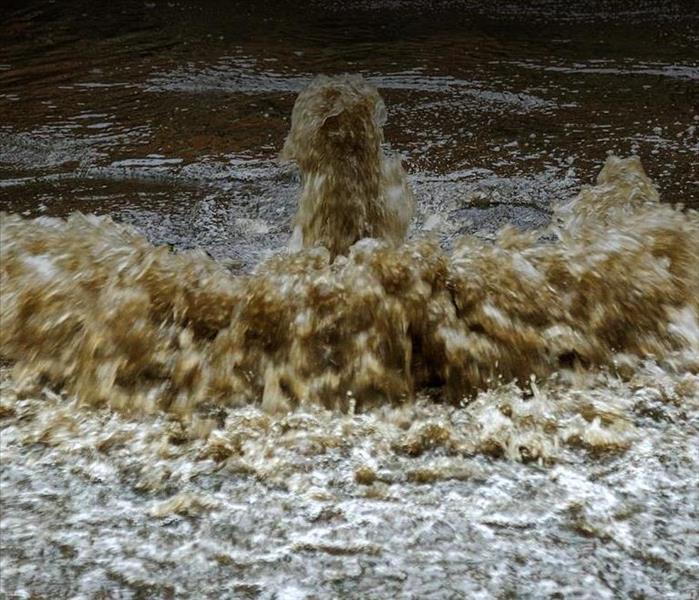 Sewage overflow in Lyons, IL
Sewage overflow in Lyons, IL
Three Possible Causes of Sewage Backup
If you are a homeowner in Lyons, IL, whose house has suffered damage from a backed-up sewer, one of the biggest impact areas will likely be your basement. A flooded basement can be inconvenient and expensive to deal with, so putting in measures to prevent such an occurrence is highly advisable. Here are three possible causes of sewage backup to keep in mind.
1. Sewage Overflow
Sewage systems are designed to have a maximum water-holding capacity. Thus, when there is a heavy downpour and the amount of water coming in exceeds the capacity of a sewer, there is a high likelihood of flooding even though the system may be in perfect working condition.
2. Old Sewage Systems
The average age of many public sewage systems in the U.S. is 30 years. As a result, many of them are more susceptible to damage now than in the past. This means that if your home in Lyons, IL, is connected to any such public system, there is a bigger risk of suffering a flooded basement. Similarly, if you live in an older home, your plumbing may be nearing the end of its life span. Replacing old pipes and valves before they deteriorate can prevent a backup of sewage.
3. Blocked Pipes and Drains
When foreign materials get into drains and pipes, it can result in water backing up and, ultimately, flooding. Pipes can get clogged when solid substances are thrown into sinks, flushed down toilets or washed into drains from the outside. To keep your pipes and drains clear, be sure to get rid of oil and grease properly. You should also take care not to use toilets and sinks to dispose of items that do not easily degrade.
A flooded basement can cause a lot of anxiety and discomfort to a homeowner. If you find yourself surrounded by unwanted water, consider consulting a reputable water damage restoration company to help.
Hail Damage to Roof Can Cost You Money
6/28/2019 (Permalink)
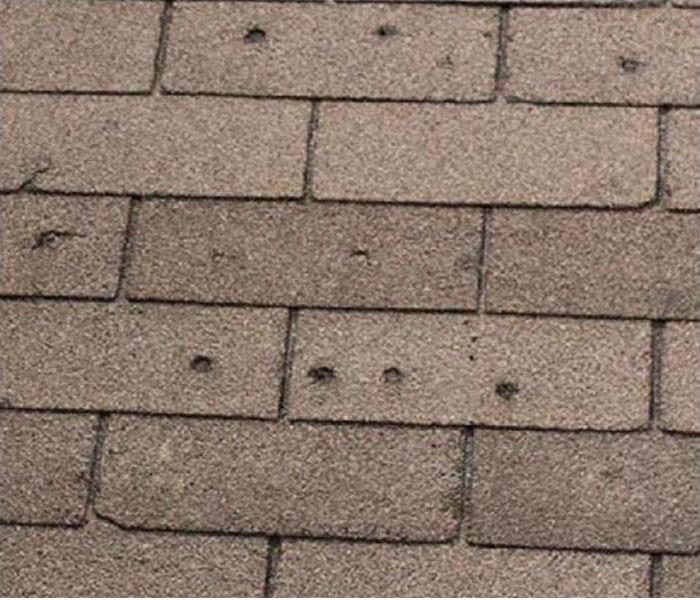 Hail Damage on roof is common after a storm.
Hail Damage on roof is common after a storm.
Hail Damage can be costly.
What is hail?
"Hail is large, layered ice particles, often spherical in shape, which are produced by thunderstorms having strong, tilted updrafts. Hailstorms form within a unusually unstable air mass, that is, an air mass in which the temperature falloff with height is much greater than normal." (The Weather Channel)
How can hail damage your roof?
"Basically, hailstones one inch in diameter begin causing damage to some of the older, thinner roof products. Therefore, from a roof damage perspective, we believe the hail size threshold for issuing a severe thunderstorm warning can be increased from ¾ of an inch to one inch in diameter." (Travelers Insurance) Hail larger than 0.75 inches is considered large enough to cause serious damage in the United States. Per NOAA, hailstones can fall at speeds up to 120 mph. The largest hailstone ever recorded in the United States was 8 inches in diameter, weighing nearly 2 pounds.
How do you know if you have roof damage from hail?
Set up a ladder to your roof to examine the top of the roof. Check the ridge cap of the roof for dents. This area of the roof will receive the most damage from hail since it is flat and will take a direct hit in a storm. Look at the shingles. Check the whole shingle, as well as the edges, for signs of damage.
If climbing up a ladder is not your thing, call SERVPRO of LaGrange Park/North Riverside at 708-240-4873, and we will take a look at your roof for hail and other roof damage for you.
Creating a Fire Escape Plan for Your Office
6/25/2019 (Permalink)
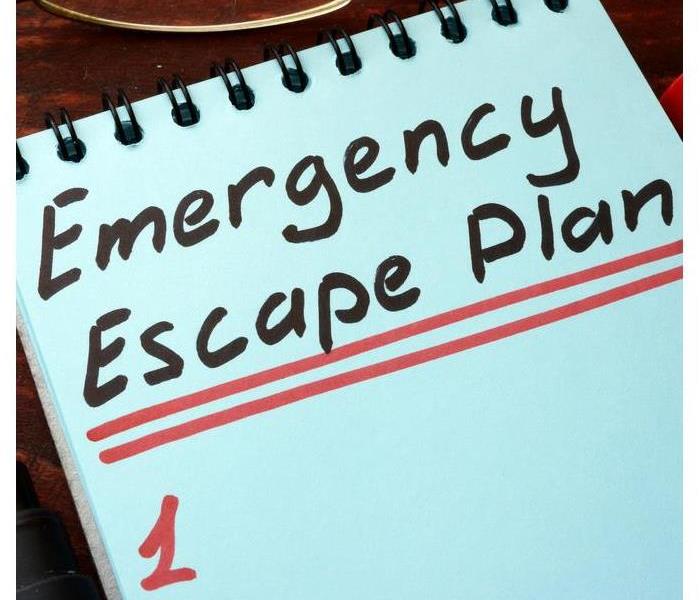 A fire evasion plan, also known as an emergency escape plan
A fire evasion plan, also known as an emergency escape plan
Imagine it’s a typical afternoon at your company in La Grange Park, IL. It’s business as usual, with your employees hard at work. Suddenly, the smoke alarm jolts everyone out of their normal routine, but when they see there’s a fire erupting in the hallway, they realize this is no ordinary fire drill. They have to leave immediately. A good fire escape plan, previously disclosed to and rehearsed with the staff, can ensure everyone exits the building safely during an emergency, and you can account for all employees.
What Is It and Why Is It Necessary?
A fire evasion plan, also known as an emergency escape plan because it is helpful for any emergency evacuation, is a strategy for exiting the building in the event of a fire. When creating such a plan, the best routes for evacuation are identified, so that everyone can leave the building safely and in a timely manner.
What Is Considered a Good Plan?
A good fire escape plan often includes the following:
- Designated managers who step into action in the event of an evacuation and make sure everyone exits the building safely and meets at the pre-planned meeting area
- Designated exits, depending on one's location in the building at the time of evacuation
- A meeting place for employees once they have exited the building
- A communication plan to use in the event of separation
- Time to practice the exit strategy once or twice a year so that employees are familiar with what to do in the event they have to evacuate
After the Fire Has Been Extinguished, What’s Next?
A fire is a most unwelcome tragedy, but it does not have to mean the end of business as you have known it. Companies specializing in emergency restoration services are Here to Help and can make the fire damage look “Like it never even happened.”
Hopefully, your business will never experience the misfortune of a fire. However, a good fire escape plan can ensure your employee's exit safely and give you additional peace of mind.
3 Common Sources of Water Damage
6/18/2019 (Permalink)
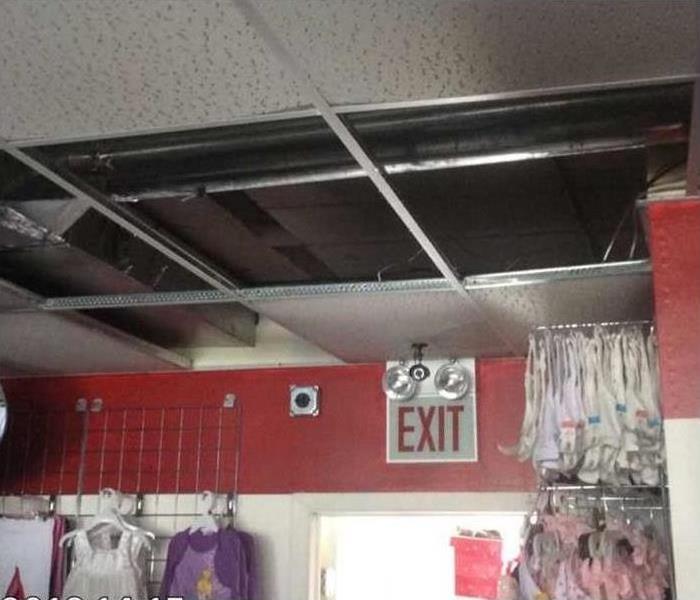 Commercial water damage due to roof leak
Commercial water damage due to roof leak
3 Common Sources of Water Damage
You want your Forest Park, IL, business to make as much profit as possible, but you may be losing money without even realizing it. Leaks from damaged pipes, as well as other areas, are a common source of trouble in many buildings. It is important to perform regular inspections to make sure everything is in top condition. Here are a few problems that might end up costing you money.
1. Damaged Roofing
Leaking pipes are not the only potential source of excess water. The roof is an important part of the structure of your business, as it protects you from severe weather and keeps the inside of the building dry. However, if you do not properly maintain your roof, you could end up with a lot of damage. In some cases, the structure of the building may weaken or a mold growth might develop. Make sure to regularly check the condition of your building and perform repairs as needed.
2. Broken Appliances
Another common source of water is from broken appliances. The damage here can range from a small leak to a lot of flooding. One way to prevent this is to test your equipment regularly to ensure it is in proper working condition. As items begin to age and break down, replace them to prevent any significant problems.
3. Pipes and Plumbing
Damaged pipes can sometimes be a hidden source of wasted water and money. If you are not performing regular maintenance, a persistent leak could end up costing hundreds or thousands of dollars in extra water bills. Leaks can also indicate aging pipes that could cause a lot of damage if not replaced.
Performing regular maintenance in your building is a great way to locate problems and prevent big issues from leaks or damaged pipes. If you do experience damage, however, a water restoration company can perform necessary repairs to your building and belongings.
3 Ways To Prevent Water Damage
6/11/2019 (Permalink)
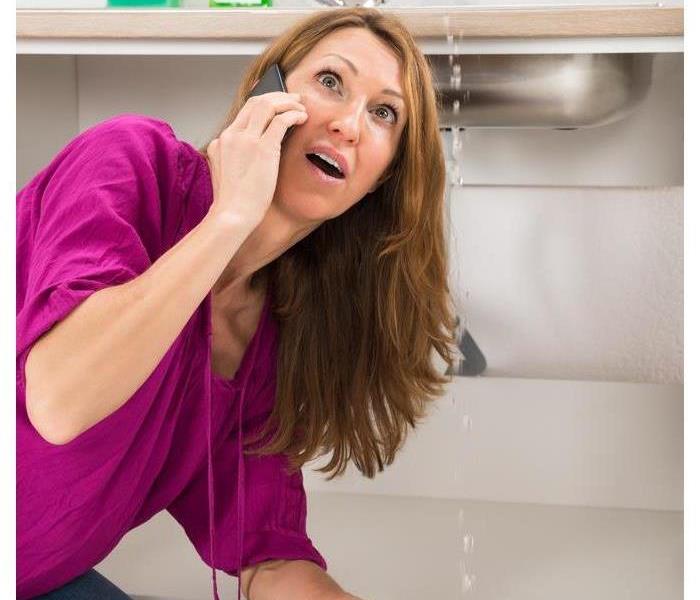 If there is a leak in your home, you should have it repaired as soon as possible
If there is a leak in your home, you should have it repaired as soon as possible
Protect Your House from Harm
There are many things that can cause water damage to your La Grange, IL, home, from accidents to natural disasters. Luckily, there are also several steps you can take to prevent it. In many cases, using the following tips will allow you to protect your house from harm.
1. Perform Regular Maintenance
While it can sometimes seem bothersome, you should perform maintenance on your home on a regular basis to avoid preventable water damage. This should include inspecting each area of your property and checking your plumbing and appliances for signs of disrepair. Examine the exterior as well to locate any cracks. Maintaining your home can limit future issues and make an insurance claim go more smoothly if a problem occurs.
2. Repair Leaks Right Away
Many people ignore small leaks and assume that they are not a big deal. However, this is not always the case. If there is a leak in your home, even if it does not seem severe, you should have it repaired as soon as possible. These can lead to large areas of damage as well as broken pipes if they are ignored.
3. Prepare Your Home for Storms and Cold Weather
Sometimes the water damage will come from outside the house rather than inside. If you are expecting a severe storm, be sure to prepare your home beforehand. Clean your drains and gutters to prevent roof leaks caused by backed up water, and make sure that all doors and windows are properly sealed. During the colder months of the year, keep the inside sufficiently heated and consider insulating your pipes to stop them from freezing and bursting.
While you can prevent certain problems, some accidents are unavoidable. If your home is impacted by water, you can call an emergency restoration service to repair the damage. They can perform remediation, water cleanup and any necessary repairs to your property.
Mold Damage and Rental Insurance: What’s Covered?
5/29/2019 (Permalink)
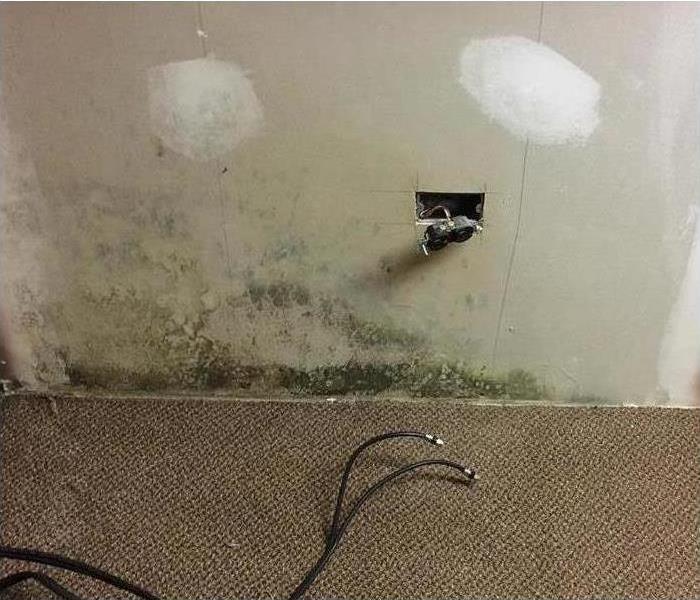 Mold found in a Westchester, IL home
Mold found in a Westchester, IL home
If you have found mold in an apartment or home you are renting in Westchester, IL, it is possible that mold has spread to your personal belongings and caused damage. While the costs of hiring a mold remediation specialist to address the mold issue and making repairs to prevent mold growth is most often your landlord’s obligation, you likely will be responsible for repairing or replacing your affected belongings. If you have a rental insurance policy, there are several situations where you might be covered.
When Will Renters Insurance Cover Mold Damage?
In general, costs associated with mold removal and remediation that you are liable for will be covered by rental insurance if the mold damage is caused by a covered peril. Some common covered perils include:
- Fire and lightning
- Falling objects
- Damage caused by plumbing, heating, or air conditioning freezing or overflow
- Freezing pipes
- Damage from the weight of ice, snow, or sleet
Who Is Liable for Mold Problems?
It is important to remember that both tenants and landlords have a part to play in keeping a rental free from mold. As a renter, it is your responsibility to keep the property clean and do what you can to prevent mold from growing. You are required to tell the landlord about issues that can cause mold growth, such as a leak or malfunctioning HVAC system. You also need to alert them of any mold you find in the home immediately. It is the landlord’s responsibility to quickly make repairs and address mold issues right away to prevent damage, but they are not responsible for replacing your damaged belongings.
The damage mold causes can be very costly to address. While finding mold in a home you are renting can be very stressful, it is important to remember that your rental insurance policy will cover any of your affected belongings if they are the result of a covered peril.
Why cleaning your commercial air ducts is important
5/27/2019 (Permalink)
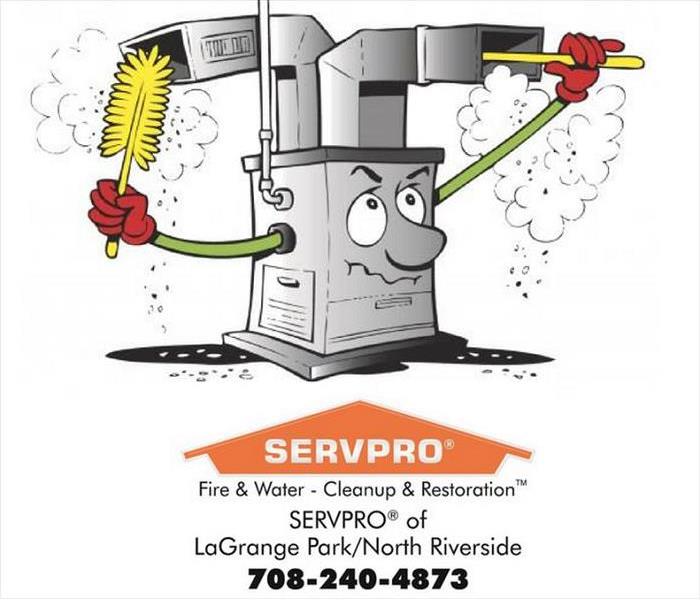 Give SERVPRO of La Grange Park/ North Riverside for commercial air duct cleaning.
Give SERVPRO of La Grange Park/ North Riverside for commercial air duct cleaning.
According to the NACDA—The HVAC Inspection, Maintenance, and Restoration Association, “if your ducts look dirty, they probably are.” By conducting routine air duct cleanings, you will be able to fully inspect your air ducts for leaks, HVAC effectiveness, and overall indoor air quality.
Cleaning Your Commercial Air Ducts is Important
Air Duct Cleaning Improves the Quality of Indoor Air
By routinely having your air ducts cleaned you can significantly decrease the amount of airborne molecules in your office, all while avoiding weighty fees for other air purifying solutions. Air ducts, like everything else in our office, collect dirt and debris. While filters may catch a lot of streaming debris, there is still a considerable amount of dust that settles within the ducts.
Air Duct Cleaning Conserves Energy
Air duct cleaning provides a beginning in optimizing your duct function while providing the opportunity for other issues to be assessed. A properly and thoroughly cleaned HVAC system, not just the air ducts, can reduce the costs associated with running your HVAC system and increase the useful life of your air conditioner and furnace. EPA research suggests that cleaning dirty cooling coils, fans and heat exchangers can improve the efficiency of cooling and heating systems and lower the energy costs of running your heating and cooling system. In administering frequent commercial air duct cleanings, all parts of your HVAC system will be refreshed. This will allow your systems to work better, faster, and more efficiently, all while using less energy!
Air Duct Cleaning Will Save You Money
Having your air ducts regularly serviced lower your energy bill, but it will also prolong the life of your HVAC system. Energy Star estimates indicate that you can improve the efficiency of your HVAC system by 20 percent or more simply by cleaning your ducts.
If you are looking for commercial duct cleaning, please give us a call at (708) 240-4873, and let us help save your company money.
Water Damage repair process
5/27/2019 (Permalink)
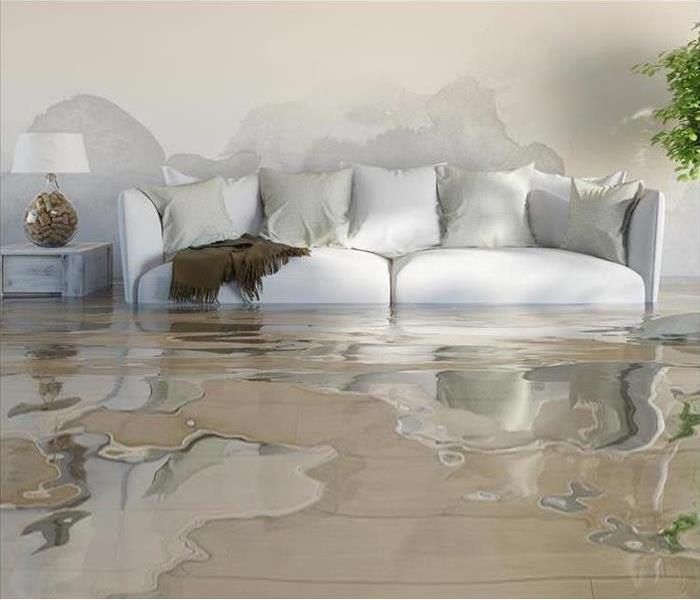 SERVPRO of La Grange Park/ North Riverside provides a 24 hour fire and water damage restoration service.
SERVPRO of La Grange Park/ North Riverside provides a 24 hour fire and water damage restoration service.
Flooding and water damage is very invasive. Water quickly spreads throughout your home and gets absorbed into floors, walls, furniture, and more. SERVPRO of LaGrange Park/North Riverside arrives quickly and starts the water extraction process almost immediately. This immediate response helps to minimize the damage and the cleaning and restoration costs.
Need Emergency Service? Call Us 24/7 – 708-240-4873.
Water Damage Timeline
Within Minutes
- Water quickly spreads throughout your property, saturating everything in its path.
- Water is absorbed into walls, floors, upholstery, and belongings.
- Furniture finishes may bleed, causing permanent staining on carpets.
- Photographs, books, and other paper goods start to swell and warp.
Hours 1 - 24:
- Drywall begins to swell and break down.
- Metal surfaces begin to tarnish.
- Furniture begins to swell and crack.
- Dyes and inks from cloth and paper goods spread and stain.
- A musty odor appears.
48 Hours to 1 Week:
- Mold and mildew may grow and spread.
- Doors, windows, and studs swell and warp.
- Metal begins to rust and corrode.
- Furniture warps and shows signs of mold.
- Paint begins to blister.
- Wood flooring swells and warps.
- Serious biohazard contamination is possible.
More Than 1 Week:
- Restoration time and cost increase dramatically; replacing contaminated materials and structural rebuilding may be extensive.
- Structural safety, mold growth, and biohazard contaminants pose serious risks to occupants.
About SERVPRO of LaGrange Park/North Riverside
SERVPRO of LaGrange Park/North Riverside specializes in the cleanup and restoration of residential and commercial property after a fire, smoke or water damage event. Our staff is highly trained in property damage restoration. From initial and ongoing training at SERVPRO’s corporate training facility to regular IICRC-industry certification, rest assured our staff is equipped with the knowledge to restore your property.
Flooding and water emergencies don’t wait for regular business hours and neither do we. SERVPRO of LaGrange Park/North Riverside provides emergency cleaning and restoration services 24 hours a day, 7 days a week—including all holidays.
Eliminating Smoke Odor After a Fire
5/17/2019 (Permalink)
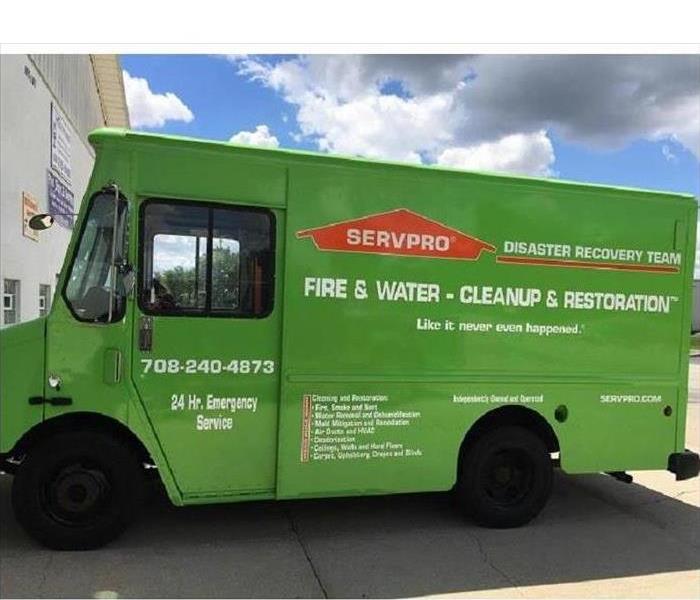 Call a fire restoration specialist in the Maywood, IL, area
Call a fire restoration specialist in the Maywood, IL, area
Smoke Cleaning Tricks to Remove the Stench From Your Home
While fires can be put out and some even mitigated with little restoration needed, smoke damage can linger. The smells associated with a fire can be challenging to remove, and it will often take a fair bit of elbow grease and possibly professional services to eliminate any residual odors thoroughly. However, there are a couple of smoke cleaning tricks you can use to remove the stench from your home.
1. Vinegar and Water
While the odor is only one aspect of smoke damage, it likely permeates from both hard and soft surfaces. Using a mixture of vinegar and water on all your homes hard surfaces can help. You will want to spray the walls, counters and shelves with this mixture and let it dry. Once dry, you can wipe everything down with a damp rag. Using the vinegar and water mixture should help to reduce the smoke smell.
2. Baking Soda
For porous surfaces, smoke cleaning with vinegar and water may not be the best option. Instead, use baking soda on carpets and other fabrics. The baking soda will absorb some of the odor-causing chemicals. After letting the baking soda sit on the porous materials for a while, you can use a vacuum to discard it. However, be sure to empty the vacuum afterward to avoid transferring any stink.
3. Professional Services
If neither of the above solutions help to remove the smoke odor from your home, or if they didn’t eliminate the odor altogether, then you can call a fire restoration specialist in the Maywood, IL, area. These professionals are experienced in fire damage and will be able to help you with your home’s deodorization.
Depending on the extent of the fire, DIY smoke cleaning may eliminate your home’s odor problems. However, in larger disasters or more significant blazes, a remediation expert may be necessary. In either situation, your home can return to normal with appropriate action.
3 Things You Should Know About Commercial Generators
5/7/2019 (Permalink)
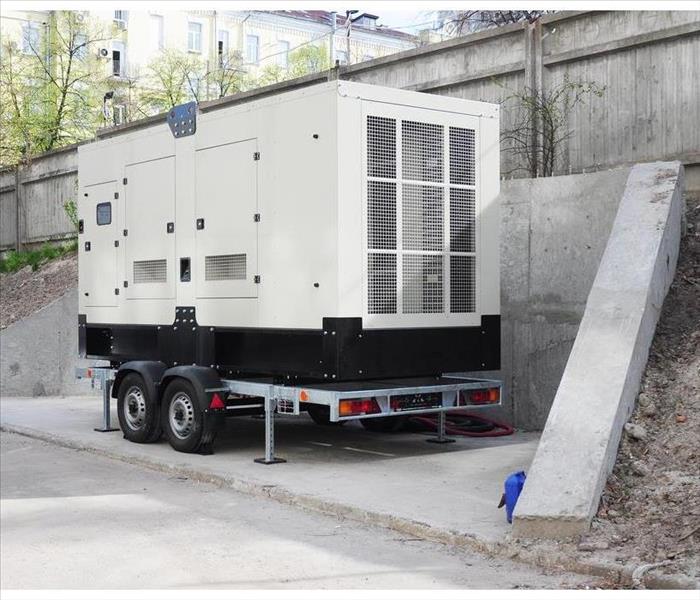 A commercial generator can help you continue running your business as usual until power is restored
A commercial generator can help you continue running your business as usual until power is restored
Things You Should Know Before Buying a Commercial Generator
When you are experiencing severe weather, it is possible that the power might go out in your Lyons, IL, building. While you could decide to just call it a day, your business would lose valuable time and profits, especially if the power outage lasts for a while. Investing in a generator is another option. Here are a few things that you should know before buying one.
1. How Do They Work?
This alternative power source runs on fuel and can be used as a temporary source of electricity in the event of a power outage. Using an engine, it supplies an electrical output that you can connect to your building. It can help you continue running your business as usual until power is restored.
2. How Long Can You Run It?
The length of time that you can run your machine depends on the type that you have and ranges from a few hours to several days. For business purposes, a permanent generator would likely be more appropriate. They can supply additional energy for longer periods of time than the portable variety. If you want to continue operating as normal, this is the option that you would need. However, if you only need power to keep your computers running long enough to save any important files, then a smaller machine would suffice.
3. When Will It Need To Be Replaced?
Over time, your machine will begin to work less efficiently, and components may begin to fail. Many are designed to last for 3,000 to 5,000 hours. While it can vary depending on how often you need to use it, this can usually give you between 20 to 30 years of use. To prevent generator problems and keep it working as long as possible, you should be sure to perform regular maintenance.
Using a generator can help keep your business operating during a storm, but in the case of severe weather, your commercial building may experience some damage. If this happens, an emergency repair service can help to quickly get everything back to its previous condition.
Thunderstorm Safety
5/2/2019 (Permalink)
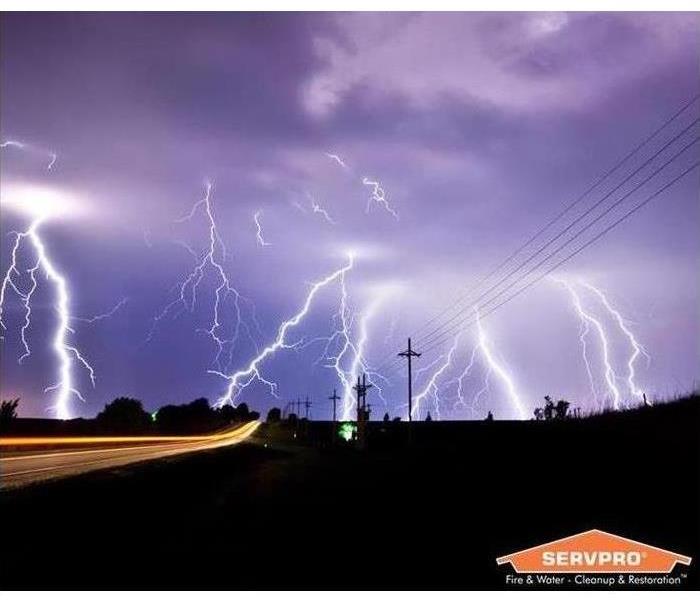 Thunderstorms can be very dangerous if we are not prepared.
Thunderstorms can be very dangerous if we are not prepared.
All thunderstorms are dangerous, and every thunderstorm produces lightning. "While lightning fatalities have decreased over the past 30 years, lightning continues to be one of the top three storm-related killers in the United States. People struck by lightning often report a variety of long-term, debilitating symptoms." According to the researchers at The Weather Channel.
How do you prepare for a thunderstorm?
According to ready.gov, "To prepare for a thunderstorm, you should do the following:
- To begin preparing, you should build an emergency kit and make a family communications plan.
- Remove dead or rotting trees and branches that could fall and cause injury or damage during a severe thunderstorm.
- Postpone outdoor activities.
- Secure outdoor objects that could blow away or cause damage.
- Get inside a home, building, or hard top automobile (not a convertible). Although you may be injured if lightning strikes your car, you are much safer inside a vehicle than outside.
- Remember, rubber-soled shoes and rubber tires provide NO protection from lightning. However, the steel frame of a hard-topped vehicle provides increased protection if you are not touching metal.
- Shutter windows and secure outside doors. If shutters are not available, close window blinds, shades or curtains.
- Unplug any electronic equipment well before the storm arrives."
Finally it is important to familiarize yourself with these terms to help identify a thunderstorm hazard:
Severe Thunderstorm Watch - Tells you when and where severe thunderstorms are likely to occur.
Severe Thunderstorm Warning - Issued when severe weather has been reported by spotters or indicated by radar. Warnings indicate imminent danger to life and property to those in the path of the storm.
Water, and fire damage call both happen during a thunderstorm event. SERVPRO of LaGrange Park/North Riverside is here to help. Give us a call at 708-240-4873 for all your restoration needs.
3 Things You Should Know About Flood Zones
4/26/2019 (Permalink)
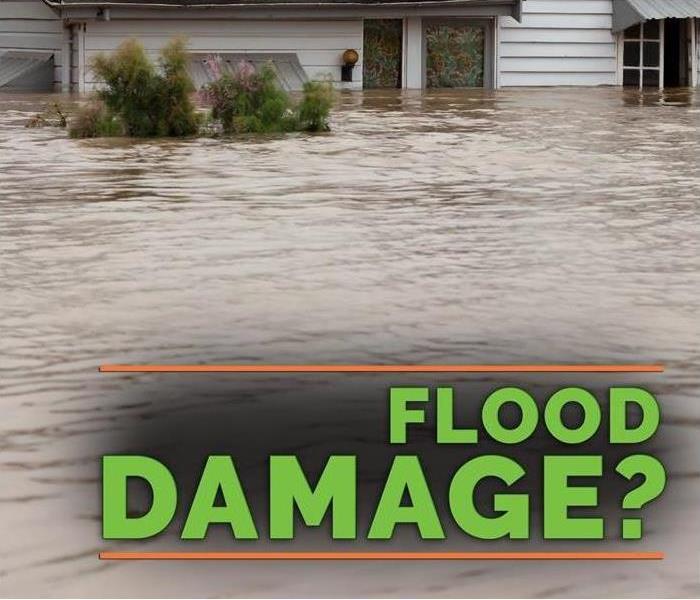 Living in a flood zone can make things more difficult for you, depending on the usual severity of flooding.
Living in a flood zone can make things more difficult for you, depending on the usual severity of flooding.
As a homeowner in La Grange, IL, it is important to have as much information as possible to keep your family and your property safe, but there are some things you may not think to consider. Whether or not your home is located in a flood zone might not usually cross your mind, but this knowledge can be incredibly helpful. Here are a few things that you should know about these areas.
1. What Is It?
As the name suggests, a flood zone is an area that has an increased risk of flooding during severe weather. The Federal Emergency Management Agency, or FEMA, determines the risk in each area and gives them a rating based on the type of floods that occur and the severity of the damage it causes.
2. How Do You Determine if You Are in One?
If you want to see if your home is in one of these zones, the process is simple. FEMA provides resources, such as a Flood Insurance Rate Map, that homeowners can download from their website. This will show you in which type of zone your property is located. Their maps are updated often, so you can check back over time to see if there have been any changes.
3. How Will This Affect You and Your Property?
Living in a flood zone can make things more difficult for you, depending on the usual severity of flooding. In some cases, you may end up with damage to your home that requires an emergency restoration service. You might be required to purchase additional flood insurance for your home as well.
While owning a home in one of these areas might not be ideal, having the necessary information can help you be more prepared in case of an emergency. If you know that there is a storm coming, take steps to keep your family and belongings safe. If there is damage to your home, know that there are services available to help.
2nd Annual Golf Fundraiser
4/25/2019 (Permalink)
https://www.planmygolfevent.com/32379-TuskegeenextSERVPRO/?fbclid=IwAR25dcOOARPGoLC9gQtYiZRX9Ko936H5LvPiSvkuuLm-HoRhvZW4l0e2NlA
Please join us for the SERVPRO 2nd Annual Outing to benefit the Tuskegee Next Program on August 2, 2019.
Registration - 10:30-11:30 am
Shotgun Start - 12:00 pm
Dinner - 5:00 pm
Raffles - 6:00 pm
We will have a great day of golf at the beautiful Arlington Lakes Golf Club in Arlington Heights, IL
(www.ahpd.org/algc). The event will include a Shotgun start, raffles, meet & greet by the students you are helping to support and raffles following golf.
Special Offer: Included with your online registration is a 1-year subscription to Golf Digest (a $10 value). Click here for offer and refund details.
Register now and remember to invite your friends to play. Just click on "Tell a Friend" and you can send them a link to this site automatically.
Thank you for your support of the Tuskegee Next.
Common Plumbing Issues in Commercial Buildings
4/18/2019 (Permalink)
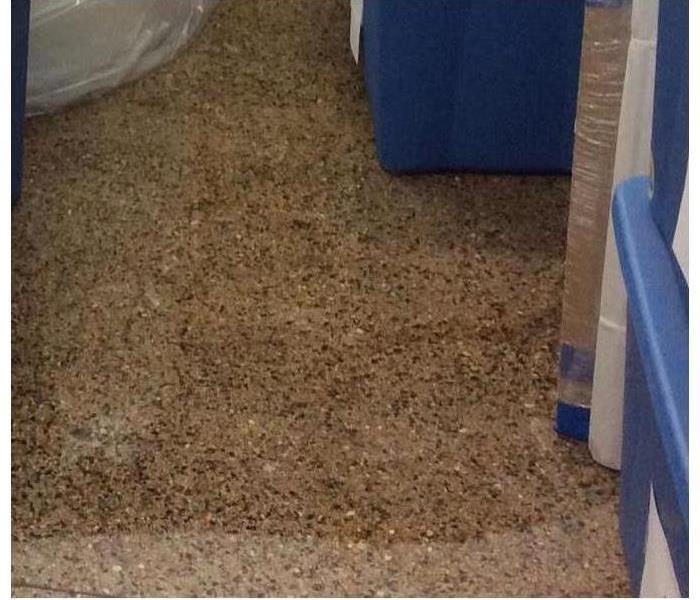 Only by performing proper inspections and maintenance can a property owner reduce risk and minimize potential issues.
Only by performing proper inspections and maintenance can a property owner reduce risk and minimize potential issues.
Commercial buildings are often plagued with plumbing issues, such as a blocked sewer. The reason behind these common detriments is the continual usage of the overall system. As a commercial business owner or manager, you are likely aware that your facility is used more frequently than a residential property might be. This added strain creates many common issues for a variety of commercial buildings.
1. Cast Iron Deterioration
While you may have gone to extensive lengths to ensure that all the plumbing in your facility was replaced or in good standing, did you remember to inspect the lines connecting your property to the municipal lines? These connections and pipes are often made of cast iron, which can deteriorate over time. Common signs of this issue are toilet overflow and sewage backup.
2. Sewer Backup
Again, because of the increased usage of your building’s facilities, a blocked sewer is more likely to occur. While this may be symptomatic of deteriorating pipes, it may be simpler than that. It is possible that the blockage is the result of a clog of sanitary and personal products.
3. Copper Pipe Breaks and Leaks
Another common issue is found in copper piping. These pipes have a propensity to develop pinhole leaks or even pipe breaks. While some of these breaks are not a result of neglect, many can be prevented with proper maintenance and inspection.
4. Foundation and Structural Issues
If you have an unknown leak, you may notice some foundation and structural issues. For instance, leaks can lead to wall and ceiling cracks or a loss of structural integrity. A plumbing specialist in the Riverside, IL area can assess your property to help you pinpoint possible solutions and develop maintenance routines.
While a blocked sewer is one common problem shared by most commercial properties, there are many others. Only by performing proper inspections and maintenance can a property owner reduce risk and minimize potential issues.
What’s the Most Accurate Way To Identify Mold?
4/13/2019 (Permalink)
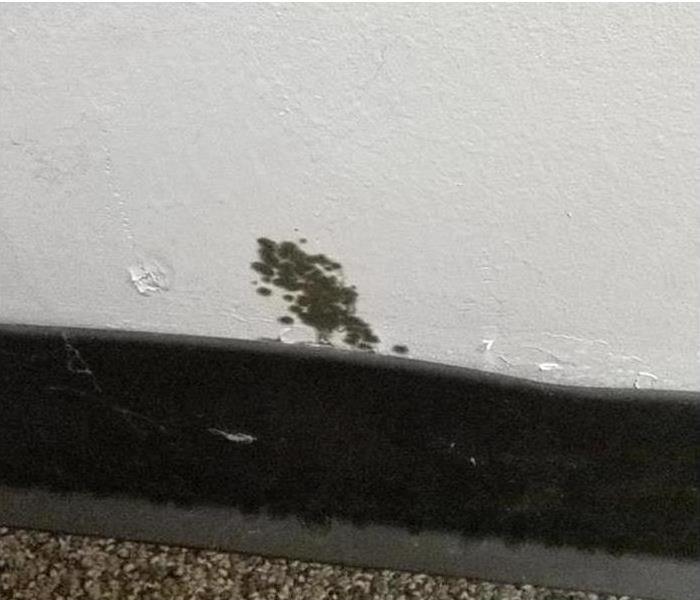 Scheduling a professional mold test is the only way to determine whether black mold or any other mold is growing in a building.
Scheduling a professional mold test is the only way to determine whether black mold or any other mold is growing in a building.
It is almost impossible for untrained professionals to identify mold. Even indoor environmental professionals rely on lab testing to accurately identify the genus and species of fungi. Scheduling a professional mold test is the only way to determine whether black mold or any other mold is growing in a building in Berwyn, IL.
Observe Indications or Risks
Non-professionals can look for signs of water damage, visible mold or odors. Do not attempt to perform any DIY mold tests. There are several reasons why mold can be difficult to identify:
- There are over 100,000 types of mold
- Mold changes colors throughout the growth cycle
- Mold spores are everywhere
Black mold may appear green in early stages of growth, and other non-toxigenic types of mold may appear black. A musty odor indicates the presence of microbial volatile organic compounds, which are off-gases released during the mold growth cycle.
Arrange For Mold Testing
An IEP will arrive on location to take samples. He or she may use one or more of the following methods:
- Air samples
- Surface samples
- Bulk samples
Air samples involve capturing air from inside and outside a structure. Surface samples are practical when mold growth is apparent. Bulk samples involve testing contents from within a structure. It may take several days to process the results of a professional test.
Review the Results
An IEP will review test results with a building owner or facility manager and recommend remediation methods. Mitigation and restoration professionals trained in mold remediation can ensure that the infestation is eliminated, underlying issues are resolved and mold growth will not reoccur.
Even if a non-professional correctly identifies the genus of mold, such as black mold or stachybotrys, there are numerous species that may or may not be toxigenic. Obtain an accurate identification from an IEP and rely on a certified mold cleanup service located in Berwyn, IL.
Why should we clean our commercial air ducts?
3/27/2019 (Permalink)
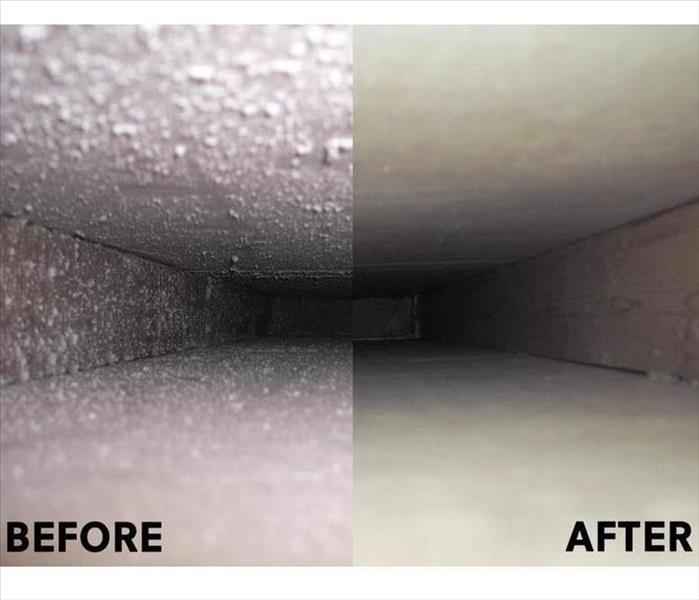 A Before and After picture of a Commercial Air Duct in La Grange Park, IL, that needed professional cleaning.
A Before and After picture of a Commercial Air Duct in La Grange Park, IL, that needed professional cleaning.
Why cleaning your commercial air ducts is important
According to the NACDA—The HVAC Inspection, Maintenance, and Restoration Association, “if your ducts look dirty, they probably are.” By conducting routine air duct cleanings, you will be able to fully inspect your air ducts for leaks, HVAC effectiveness, and overall indoor air quality.
Air Duct Cleaning Improves the Quality of Indoor Air
By routinely having your air ducts cleaned you can significantly decrease the amount of airborne molecules in your office, all while avoiding weighty fees for other air purifying solutions. Air ducts, like everything else in our office, collect dirt and debris. While filters may catch a lot of streaming debris, there is still a considerable amount of dust that settles within the ducts.
Air Duct Cleaning Conserves Energy
Air duct cleaning provides a beginning in optimizing your duct function while providing the opportunity for other issues to be assessed. A properly and thoroughly cleaned HVAC system, not just the air ducts, can reduce the costs associated with running your HVAC system and increase the useful life of your air conditioner and furnace. EPA research suggests that cleaning dirty cooling coils, fans and heat exchangers can improve the efficiency of cooling and heating systems and lower the energy costs of running your heating and cooling system. In administering frequent commercial air duct cleanings, all parts of your HVAC system will be refreshed. This will allow your systems to work better, faster, and more efficiently, all while using less energy!
Air Duct Cleaning Will Save You Money
Having your air ducts regularly serviced lower your energy bill, but it will also prolong the life of your HVAC system. Energy Star estimates indicate that you can improve the efficiency of your HVAC system by 20 percent or more simply by cleaning your ducts.
If you are looking for commercial duct cleaning in La Grange Park, IL, please give SERVPRO of La Grange Park/ North Riverside a call at 708-240-4873, and let us help save your company money.
Follow These Mold Safety Advice If You Live in LaGrange Park
3/27/2019 (Permalink)
If you see visible mold, do not disturb it. You can inadvertently spread the mold infestation throughout your home. When mold is disturbed, the mold can release microscopic mold spores which become airborne and can circulate inside your home.
What to Do:
What Not to Do:
- Don’t touch or disturb the mold.
- Don’t blow air across any surfaces with visible or suspected mold growth.
- Don’t attempt to dry the area yourself.
- Don’t spray bleach or other disinfectants on the mold.
About Our Mold Remediation Services
SERVPRO of LaGrange Park/North Riverside specializes in mold cleanup and restoration, in fact, it’s a cornerstone of our business. Our crews are highly trained restoration professionals that use specialized equipment and techniques to properly remediate your mold problem quickly and safely.
If You See Signs of Mold, Call Us Today – 708-240-4873.
Flood Safety Tips
3/27/2019 (Permalink)
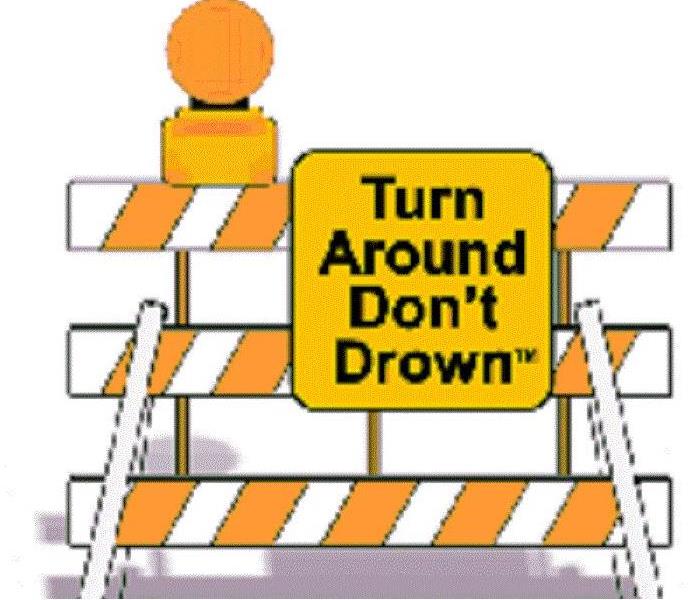 Stay safe during a Storm and take all the precautions necessary to avoid severe Storm Damage.
Stay safe during a Storm and take all the precautions necessary to avoid severe Storm Damage.
Flood can happen anywhere, and without much of a notice. According to ready.gov “Just 6 inches of moving water can knock you down, and 1 foot of water can sweep your vehicle away.” Flood Watches and Flood Warnings are available to let you know what the weather is doing in your area. On average, more deaths occur due to flooding each year than from any other severe weather related hazard.
First of all flood watches and flood warnings are two separate alerts to warn about the weather in your area. A flood watch is to make you aware that conditions are possible for flooding. A flood warning means you need to take action to keep yourself and your family safe.
Ready.gov has some safety tips in case you are in an area where there is a flood warning.
- Move immediately to higher ground or stay on high ground.
- Evacuate if directed.
- Avoid walking or driving through flood waters. Turn Around, Don’t Drown! Just 6 inches of moving water can knock you down and 1 foot of water can sweep your vehicle away.
The water from a flood is only one of the risks. Water and electricity do not mix. In the event of a flood, downed power lines are also possible. Stay away from all power lines. Calling your local utility company is the only thing you should do in the event you see downed lines. Your appliances, if they get wet, should also not be used until they have been inspected by a licenses electrician. The fuse box in the house should be avoided as well as long as there is water in the home.
We may not be able to control weather conditions, but we can take all possible precautions to ensure our personal safety and protect our homes from severe damage.
According to ready.gov the following tips can help prepare you for a flood:
- Find out how vulnerable your home is to flooding by determining the elevation of your property.
- Evaluate your insurance coverage once a year to make sure your home is fully covered. As new construction grows in certain areas, more flood-plains are sometimes created.
- If your home is in a flood-prone area, contact the National Flood Insurance program to learn what mitigation measures you can take in advance.
- Contact your local emergency management agency to learn how to construct proper protective measures around your home.
- If you live in a flood-prone area, keep these materials on hand: sandbags, plywood, lumber, plastic sheeting, trash bags, shovels, work boots and gloves.
- Purchase a weather radio. These special, battery-operated radios cost as little as $20 and are available at many hardware and appliance stores and other retail outlets.
- Put together a disaster survival kit. Keep the following supplies near at hand and put them in a water-tight container: flashlight with extra batteries, battery-powered radio and weather radio, first aid kit, medicines, eyeglasses, drinking water, non-perishable foods, change of clothes, cash and credit cards, and copies of all important papers.
- Plan two evacuation routes in advance. Don’t wait until threatening weather conditions occur before trying to determine your route to safety. Be aware of streams, drainage channels and low areas in your region that are prone to flooding, so that your evacuation routes are not cut off.
- Do not park your vehicle near streams or rivers, especially during threatening weather conditions.
As always, SERVPRO of LaGrange Park/North Riverside wants you to stay safe first and foremost. However, flooding happens, and we are here to help.
If you have flood damage in your home, call us at 708-240-4873 for all your water damage needs.
We Specialize in Flooded Basement Cleanup and Restoration!
3/26/2019 (Permalink)
A basement can flood at any time, although flooding most often occurs during heavy rainfall. Basements are inherently prone to flooding because they are the lowest level of a building and are normally built partly or entirely below ground level. There are a number of reasons why your basement could flood, including:
- A blocked or failed sewer lateral pipe
- Heavy rain causes surface water to pool around your home
- Storm sewer backup
- Sanitary sewer backup
- Foundation drainage failure
- Water supply-line break or hot-water tank failure
- And many more
Have Questions about Basement Flooding?
If flood water is not handled quickly and properly, it can jeopardize your health and safety, and cause severe damage to your home’s structure. Remember, the longer you wait, the worse the problem will get.
The bottom line: a flooded basement can jeopardize your health, safety, and your home’s integrity. It’s worth making a call to SERVPRO of LaGrange Park/North Riverside and let our trained, professional crews handle the situation safely and correctly. We have earned the trust of hundreds of homeowners, business owners, and property professionals.
We are Flooded Basement Specialists:
- We are Available 24 hours/7 days per week
- We’re a Preferred Vendor to many National Insurance Companies
- We Bill The Insurance Directly – One Less Thing For You To Worry About
- Our Technicians are Highly-Trained in Water Restoration Techniques
- We use s500 IICRC Restoration Standards
- Advanced Inspection and Extraction Equipment
Basement Flooded? Call Us Today – We’re Ready To Help 708-240-4873.
24 Hour Emergency Water Damage Service
3/26/2019 (Permalink)
SERVPRO of LaGrange Park/North Riverside is available 24 hours a day for water emergencies, large or small. When you are dealing with water damage, immediate action is crucial. A delay of just a few hours can greatly increase the severity of the water damage.
We Answer the Phone Ready to Help
We understand that when you call us, you may be feeling confused, stressed, and vulnerable. You need an expert to guide you through this crisis. SERVPRO of LaGrange Park/North Riverside has the specific water damage training and experience to help you through this tough time. We specialize in water damage restoration—in fact, it's the cornerstone of our business.
What to Expect
When you call, we will ask several questions regarding your water damage emergency. These questions will help us determine what equipment and resources to bring, including how many trained SERVPRO Professionals may be needed.
Our SERVPRO Representative will ask several questions:
- Your name and contact information
- Your insurance information (if applicable)
- The street address of the water-damaged home or business
- When did the flooding or water damage occur?
- What caused the water damage (if known)?
- Is there electricity available (on-site)?
About SERVPRO of LaGrange Park/North Riverside
SERVPRO of LaGrange Park/North Riverside specializes in the cleanup and restoration of residential and commercial property after a fire, smoke or water damage event. Our staff is highly trained in property damage restoration. From initial and ongoing training at SERVPRO’s corporate training facility to regular IICRC-industry certification, rest assured our staff is equipped with the knowledge to restore your property.
When Storms or Floods hit SERVPRO is ready!
3/26/2019 (Permalink)
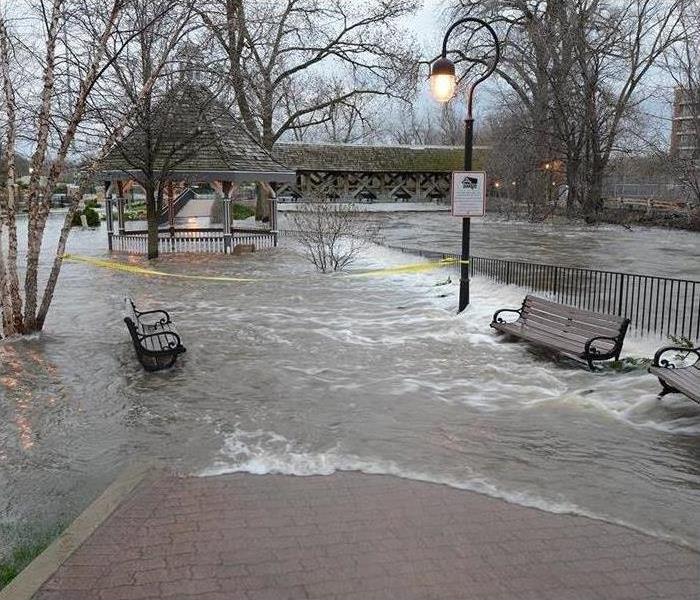 Our highly trained crews are ready to respond 24/7 to storm or flood damage in LaGrange Park/ North Riverside
Our highly trained crews are ready to respond 24/7 to storm or flood damage in LaGrange Park/ North Riverside
SERVPRO of LaGrange Park/ North Riverside specializes in storm and flood damage restoration. Our crews are highly trained and we use specialized equipment to restore your property to its pre-storm condition.
Faster Response
Since we are locally owned and operated, we are able to respond quicker with the right resources, which is extremely important. A fast response lessens the damage, limits further damage, and reduces the restoration cost.
Resources to Handle Floods and Storms
When storms hit the Berwyn, IL land area, we can scale our resources to handle a large storm or flooding disaster. We can access equipment and personnel from a network of 1,650 Franchises across the country and elite Disaster Recovery Teams that are strategically located throughout the United States.
Have Storm or Flood Damage? Call Us Today 708-240-4873
What Positions SERVPRO as a Top Choice for Businesses Needing Emergency Recovery?
3/25/2019 (Permalink)
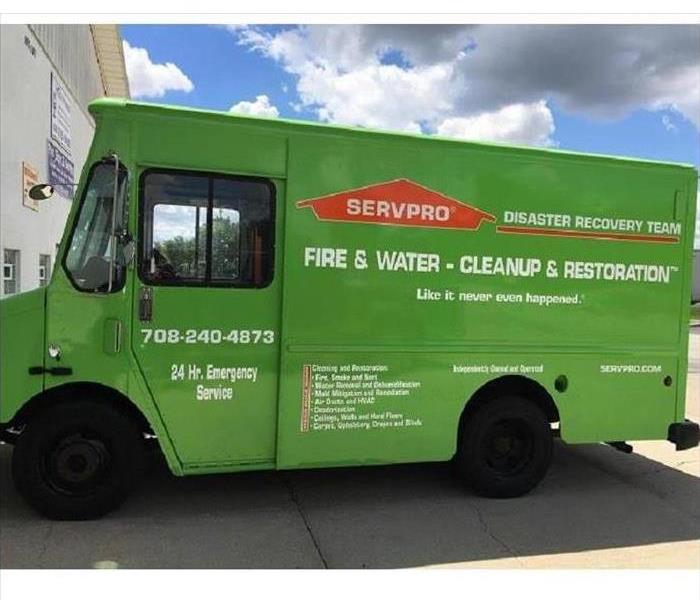 SERVPRO is a national brand.
SERVPRO is a national brand.
What Makes SERVPRO A Top Choice For Emergency Recovery Businesses?
The most urgent situations require only the best possible response and remedy. This is why you can’t afford to settle for anyone other than SERVPRO when your office experiences a flood, fire or mold infestation. There are other groups in Riverside, IL you could consider for cleanup and restoration help. It’s difficult to find any team that can stack up to the skills, experience and qualifications of a SERVPRO franchise.
What’s on the Resume?
Every disaster relief organization will tout its services as the best and as the place you should call when you have immediate cleanup needs in your office. Here are some top reasons SERVPRO should be your first and only call for a recovery company:
- They’re locally owned.
- They have vast resources and support.
- The technicians are qualified and skilled.
- The technicians use state-of-the-art equipment and techniques.
The Local Connection
SERVPRO is a national brand. No matter where you go in the U.S., you can find a SERVPRO franchise ready to help in emergencies large and small. There’s also a team in your own backyard that understands your needs and that is close enough to respond within a couple of hours or less. The local office has the backing of company headquarters, which can send additional supplies and technicians to the scene if necessary.
The Right Stuff
An ordinary cleanup crew with average skills and tools won’t cut it for you. You should expect excellence, and you’ll get it with this specialized group of restoration experts. The technicians are certified and qualified to tackle any task you have, no matter how complex or complicated it may be. Best of all, the team will have your office looking as close to perfect as possible, ready for you to resume normal operations.
Now that you know about the SERVPRO franchise in your area, keep their number and website handy. If disaster strikes, you know where to turn.
Restoring Your Commercial Property After A Water Damage Event
3/20/2019 (Permalink)
Flooding and water damage events at LaGrange Park/North Riverside and the surrounding area commercial properties are often complex with numerous issues that require a knowledgeable and flexible response. Whether we’re dealing with a relatively small water cleanup scenario or a large scale event, we work quickly to assess each unique situation and isolate the damaged area. In many instances, normal operations can continue in a temporary space while we restore your facility.
Restoring Commercial Properties Presents Unique Challenges
Our professionals are trained to be mindful of legal and environmental concerns and strive to fully restore the damaged area while working within your budgetary constraints. We understand that every hour spent cleaning up is an hour of lost revenue and productivity. So when an emergency situation arises in your business, give us a call and we’ll be there fast with the help you need.
About SERVPRO of LaGrange Park/North Riverside
SERVPRO of LaGrange Park/North Riverside specializes in the cleanup and restoration of commercial and residential property after a water damage event. Our staff is highly trained in property damage restoration. From initial and ongoing training at SERVPRO’s corporate training facility to regular IICRC-industry certification, rest assured our staff is equipped with the knowledge to restore your property.
Our Highly Trained Restoration Specialists Can Restore Your Home
3/20/2019 (Permalink)
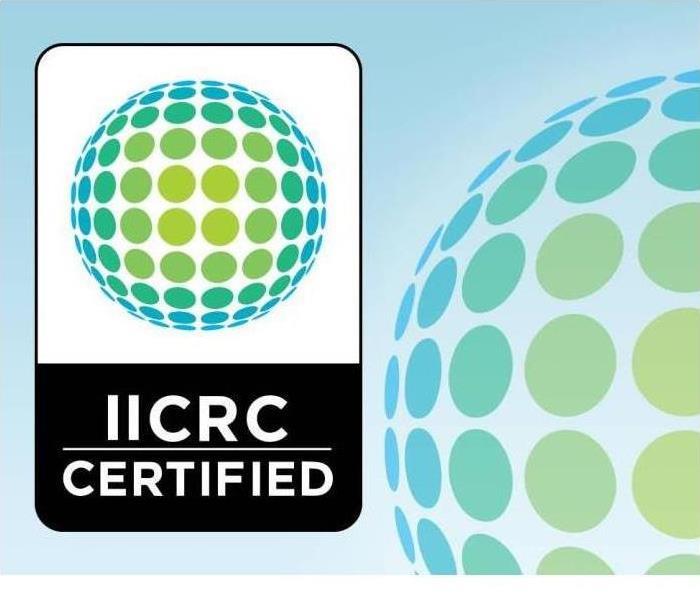 We are an IICRC Certified Firm
We are an IICRC Certified Firm
SERVPRO of LaGrange Park/North Riverside is an IICRC firm. The Institute of Inspection, Cleaning and Restoration Certification (IICRC) creates the standards for the restoration industry and provides training and certification to restoration companies. IICRC Certified Firms have the right to display the IICRC Certified Logo.
IICRC Certified Firms must
- Present accurate information to consumers and conduct business with honesty and integrity.
- Require a technician on all jobs who has been formally trained and passed all required tests.
- Require a continuing education program to keep technicians up-to-date on the latest changes in the industry.
- Maintain liability insurance to protect all parties in the event of an accident.
- Maintain a written complaint policy and agree to Better Business Bureau or similar arbitration to resolve disputes, and accept the conclusions and recommendations of arbitration.
The IICRC Develops The Standards For The Restoration Industry
The IICRC has been the driving force in establishing the main industry standards and reference guides for professional carpet cleaning, water damage restoration and mold remediation. These IICRC standards take years to develop and require the coordination of experts in the field: manufacturers, industry organizations, insurance professionals, training schools, contractors, and public health professionals.
Every five years, the standards are reviewed and updated. The water damage restoration field changes rapidly with advancements in technology and science, and therefore the standards must evolve to keep pace.
About SERVPRO of LaGrange Park/North Riverside
SERVPRO of LaGrange Park/North Riverside specializes in the cleanup and restoration of residential and commercial property after a fire, smoke or water damage event. Our staff is highly trained in property damage restoration and we are an IICRC Certified Firm. We believe in continuous training: from initial and ongoing training at SERVPRO’s corporate training facility to regular IICRC-industry certification, rest assured our staff is equipped with the knowledge to restore your property.
Spring Cleaning Time Is Here Again
3/20/2019 (Permalink)
Spring cleaning time is here again, and a great opportunity to clean and organize your living spaces.
Here are some great tips to freshen up your home and make is sparkle:
Wipe off a dirty faucet.
To get rid of lime buildup, make a paste of 1 teaspoon vinegar and 2 tablespoons salt. Apply to sink fixtures and rub with a cloth.
Tidy up a toilet.
Pour a cup or more of diluted white distilled vinegar into the bowl. Let sit several hours or overnight. Scrub well with a toilet brush and flush.
Eliminate odors.
Swab plastic containers with a cloth dampened with vinegar.
Freshen up the fridge.
Clean the shelves and walls with a solution of half water and half vinegar.
Battle litter-box odor.
Cat litter can leave behind an unwelcome smell. Eliminate it by pouring a half-inch of white distilled vinegar into the empty litter box. Let stand for 20 minutes, then rinse with cold water.
Steam away a microwave mess.
Fill a small bowl with equal parts hot water and vinegar, and place it in the microwave on high for 5 minutes. As the steam fills the microwave, it loosens the mess, making clean up a breeze.
Remove wax.
If you get melted candle wax on your wood furniture or floors, gently wipe it away with a cloth soaked in a solution of equal parts white vinegar and water.
Erase crayon.
If your kids get crayon marks on the walls or floor, dip a toothbrush in white vinegar and gently scrub. The vinegar breaks down the wax, making for an inexpensive, nontoxic way to clean up after children.
Restore showerhead pressure.
If your shower-head gets clogged with mineral deposits, soak it for 15 minutes in a mixture of ½ cup vinegar and 1 quart water.
Another great do it at home cleaning solution is baking soda. Baking soda is great to freshen up stale and stinky smells in the home.
Here are some tips from Better Homes and Gardens for uses of baking soda around the house:
Stale-smelling sponges
Soak these kitchen staples in baking soda and water to freshen them up so you can use them a little longer.
Musty upholstery and carpets
Deodorize the soft, cushy places around your house by sprinkling surfaces with baking soda, letting it sit for 15 minutes, and then vacuuming it up.
Grimy toys
Naturally fight the effects of your little one's grubby hands by wiping them with a sponge dipped in a baking soda and water solution.
A mildew-y bathroom
Scrub your tub, tile, sink and shower curtain with a damp sponge and baking soda. Rinse to reveal gleaming surfaces.
A messy grill
Combat a summer's worth of cookout grime by sprinkling some baking soda on your grill-cleaning brush before you scrub away.
Finally, one of my favorite non chemical cleaning items is to use lemon. Lemons are a natural, mild disinfectant, and a quick trip to the store and you have a powerful cleaning weapon with no worries about chemicals.
According to thekitchn.com, lemons are "nature's little hand scrubbers". Here are some of their useful tips on how to use lemon in your spring cleaning:
Clean Wood Cutting Boards
Apply salt: Sprinkle the cutting board with coarse salt.
Scour the surface: Using a lemon half with the cut side down, scour the surface, squeezing slightly to release the lemon juice as you go.
Let sit, then scrape off: Let sit for 5 minutes, and then scrape the gray, dirty liquid into a small bowl using a bench scraper, and discard.
Rinse: Give the surface a final rinse with a clean wet sponge.
About SERVPRO of LaGrange Park/North Riverside
SERVPRO of LaGrange Park/North Riverside specializes in the cleanup and restoration of residential and commercial property after a fire, smoke or water damage event. Our staff is highly trained in property damage restoration. From initial and ongoing training at SERVPRO’s corporate training facility to regular IICRC-industry certification, rest assured our staff is equipped with the knowledge to restore your property.
Three Things You Should Know About Mold in Your Home
3/18/2019 (Permalink)
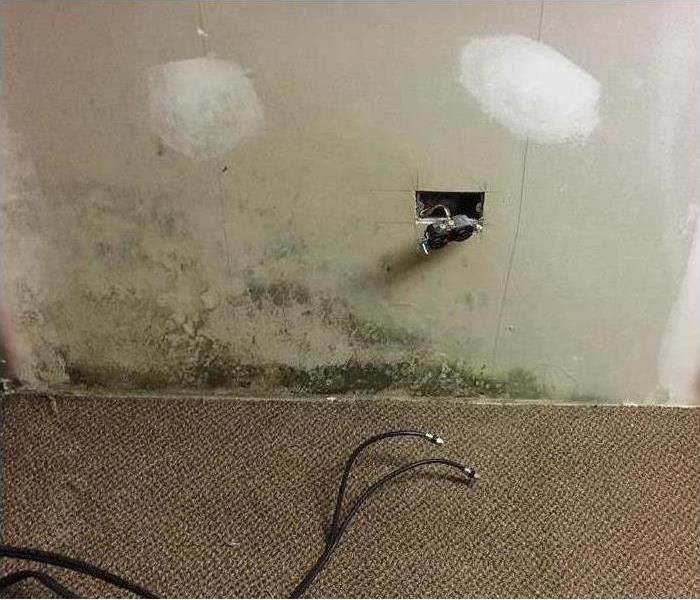 If you have high humidity levels in your home, mold can spread rapidly, sometimes in only a day or two.
If you have high humidity levels in your home, mold can spread rapidly, sometimes in only a day or two.
Three Things You Should Know About Mold In Your Home
For many homeowners, mold growth can be a significant problem. Many things can contribute to the development of this fungus inside of your Riverside, IL home, especially if you do not perform regular maintenance on your house. Here are a few things that you might need to know if you discover mold in your home.
1. There Are Many Types of Mold That Can Grow In Your Home
When you think about mold growth in your home, you are likely thinking about black mold. However, this is not the only type of fungus that you can find there. Black mold is only one of several varieties. While not all types of mold are necessarily harmful, they can all cause damage to your home, so it is best to have it remediated as soon as possible.
2. It Spreads and Grows Quickly
Particularly if you have high humidity levels in your home, mold can spread rapidly, sometimes in only a day or two. Because of this, it is essential that you do not ignore any signs of a growth. Even if you cannot see any mold, you might be able to smell it. If you have a musty odor in your house and you cannot locate the source, mold is likely the culprit.
3. It Is Not as Easy To Remove as You Might Think
Even if you have removed all of the visual mold from your home, it is possible that it is present inside of your house’s structure. If you see any damage, it is best to have a mold remediation service examine your house and remove the mold. Having this done by professionals will make it less likely that the growth will return. They can also locate any sources of water damage that might contribute to the problem.
While having a mold growth in your home may seem like more of an annoyance than an emergency, you should always treat it as soon as possible to avoid extensive damage.
Responding to a Home Flood Disaster
3/18/2019 (Permalink)
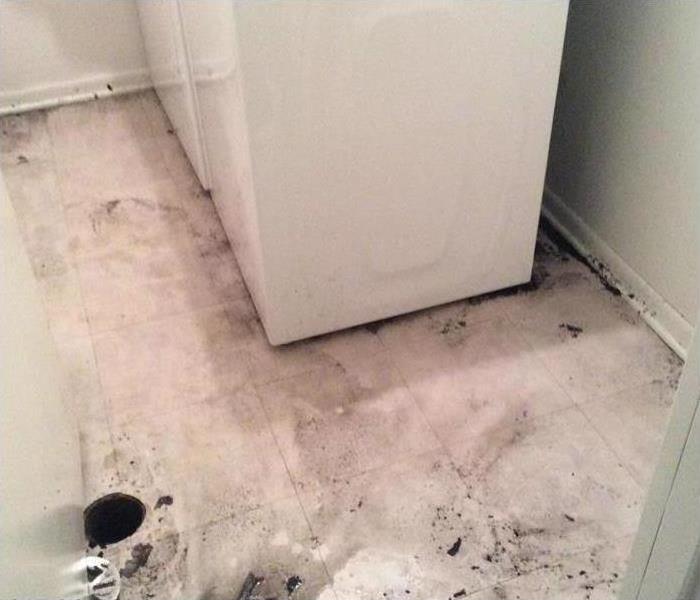 If you experience a flood due to a broken pipe or other water event, it's important to act quickly and safely.
If you experience a flood due to a broken pipe or other water event, it's important to act quickly and safely.
Responding To A Home Flood Disaster
A flood can be one of the most devastating things to happen to your home and life. It can come from heavy rain, a broken pipe, defective appliances, sewage backup, and other unexpected causes. Because flooding is generally kept off your radar until it actually happens, you may find yourself overwhelmed with questions about how to act in the best interest of your safety and belongings. Here are three tips for responding to a home flood.
1. Identify the Damage
Is the source of the water a broken pipe or something more complicated? Is it clean water or contaminated? These kind of questions will help you decide how to proceed. If it's Category 2 or Category 3 contaminated water, it could be hazardous to enter the area without proper protective gear. Do not enter the wet area unless it is clear what kind of damage you have experienced.
2. Turn Off Power
Your next move should be to shut off the main power to your home in order to avoid electrocution in the initial cleanup stages. If this task will have you wading through the flooded area, do not proceed with the list and simply evacuate the home.
3. Call a Professional
Although there are minor things you can do while waiting for emergency restoration services to arrive, it is not wise to take on remediation without the proper training and experience. There are a mountain of risks that could end up worsening the damage if you’re not careful. Even simply waiting too long to begin cleanup poses a danger to your home and health, so it is best to act as soon as the water in your home is detected. Do not attempt to fix a damaged pipe or appliance on your own, either; always consult an expert in La Grange, IL for advice on your specific situation.
If you experience a flood due to a broken pipe or other water event, it's important to act quickly and safely. Sometimes the safest, smartest thing to do is leave cleanup to the professionals.
The Cost of a Business Interruption Is Covered by Insurance
3/14/2019 (Permalink)
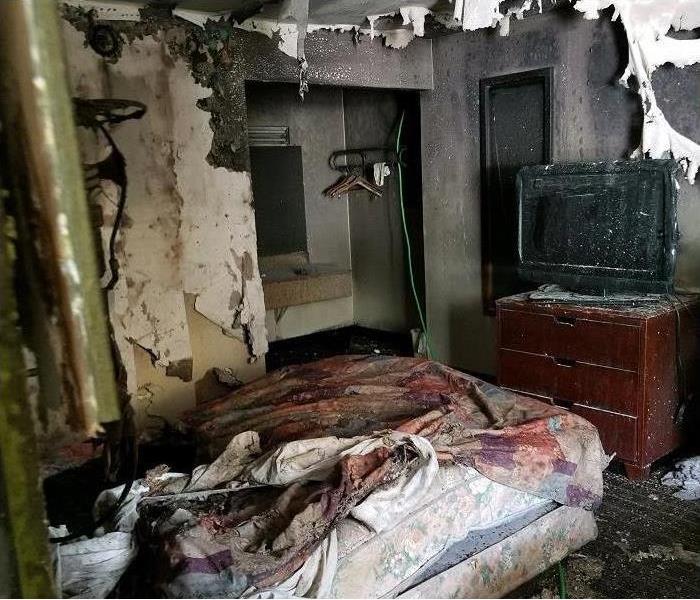 Commercial fire damage in a Berwyn, IL home
Commercial fire damage in a Berwyn, IL home
The Cost of a Business Interruption
Disaster has struck. It’s a dark day in Berwyn, IL. Your business has completely shut down. Was it fire or storm damage? It doesn’t matter. There is much to be done between now and the day you can reopen. Unfortunately, there was a lot of damage and reopening is a long way off. While you are assessing the situation, your insurance agent reminds you about the interruption insurance portion of your policy and describes some of the costs that it can cover.
1. Costs Associated With Moving to a Temporary Location
If your business can operate from anywhere and your policy covers it, you can restart your business at a temporary location. This can shorten the business interruption dramatically. It will allow you to continue your operation, keep your customers satisfied and make your employees happy that they still have jobs.
2. Lost Profits But Not Lost Revenue
If your business is profitable and you can document profitability, you will be reimbursed for profit lost. Some people mistakenly believe that interruption insurance covers the insured for lost revenue but that is not the case.
3. Fixed Costs
The government wants you to pay your property taxes. Your landlord expects you to pay the rent. Behind them, there are others standing in line to get paid. They don’t care that you are temporarily out of business.
4. Training Costs
Unless you set up your business to operate at a temporary location, it’s a good bet that you will permanently lose many of your employees. New employees will need to be trained to do the jobs, and training costs money.
5. Other Expenses
There will always be other expenses that don’t fit in the above categories. There could be loan payments, utilities, association dues and contractual obligations.
A Short Interruption Is Good for Everyone
Your insurer wants the interruption insurance payments to end. You want things back to normal. If your repairs include fire restoration, consider bringing in a team of restoration experts. You will be happy you did.
Mitigation terms and definitions
3/4/2019 (Permalink)
Education is always a plus when you are not in that industry or have questions. Giving you terms and definitions will help you to understand a little of what your mitigation company SERVPRO is talking about when they are scoping the job for the techs to perform the work. Just like watching subtitled moves to learn another language, just a little easier.
Condensation – The process of changing water from a vapor to a liquid.
Contracts – Water damage services should not begin until an adequately contract is signed by the property owner. Contracts should specify the party responsible for payment.
Conventional refrigerant dehumidifier – This kind of dehumidifier loses efficiency as the air dries below 55 grains per pound. It removes water vapor from the air using a process called condensation.
Dehumidifier/dehumidification – If electric cords become frayed, the device should be removed from service and the cord repaired properly. Mechanical dehumidification should be used when the outdoor humidity ratio is higher than the humidity ratio indoors. Dehumidification is the process of removing water vapor from the air.
Desiccant dehumidifier – This kind of dehumidifier creates the lowest humidity ratio, which means that it also creates the lowest vapor pressure.
Dew point temperature – The temperature at which the air becomes saturated, 100% relative humidity. Air that contains the maximum water vapor at a given temperature is saturated.
Drying goals – Drying is not complete until all affected materials have been returned to their pre-determined drying goals.
Drywall (Gypsum board) – Ceilings that are saturated and sagging should be drained, removed quickly, and discarded. Drywall becomes more fragile when wet and more stable as it dries.
EPA registered products – When using these products, you must follow label directions. The use of antimicrobials on water projects may or may not be advisable. Technicians should obtain the customer’s informed consent before applying antimicrobials on a water project.
Evaporation – The process of changing water from a liquid to a vapor. As water evaporates from a material the temperature of the surface of the material gets cooler; this is known as evaporative cooling.
Hardwood flooring – Technicians should dry hardwood flooring until it reaches within 2-4 percentage points of normal EMC. After the floor has been dried to acceptable moisture content, appropriate acclimation time should be allowed before refinishing. If drying wood floors is feasible, it is recommended that you attempt to achieve a target humidity ratio of less than 40 grains per pound as quickly as possible. When moisture causes the wood flooring to swell across the width of each plank, with the edges higher than the center, the planks are cupped.
High-risk persons – People who are very young, very old, have suppressed or compromised immune systems, have allergies, or have respiratory problems. If high-risk persons are present on a water project, restorers should recommend third-party evaluation by an Indoor Environmental Professional (IEP). High-risk persons who are present on a Category 3 water loss should remain off the work site until the building is safe to re-occupy.
Humidity ratio – The amount of water vapor that a volume of air contains by weight. Humidity ratio is directly related to vapor pressure.
Hygroscopic materials – Hygroscopic materials continue to absorb water until they reach equilibrium. They can have secondary damage from high humidity. The potential for damage to hygroscopic materials is greatest when the relative humidity is above 60%.
Low-grain refrigerant dehumidifier – This kind of dehumidifier removes water vapor from the air using a process called condensation. LGR dehumidifiers continue to remove a significant amount of water vapor below 40 grains per pound.
Moisture content – The measurement of the amount of moisture contained in a material, expressed as a percentage of the weight of the oven-dry material. If a restorer is measuring materials with an instrument that is calibrated for that material, then it is recommended that the term moisture content be used.
Moisture level – The measurement of the amount of moisture contained in a material on a relative scale. If a restorer is measuring materials with an instrument that is not calibrated for that material, then it is recommended that the term moisture level be used.
Mold – Use appropriate protective measures when mold growth is discovered.
Monitoring – Water projects should be monitored at least once every day. Daily readings should include all applicable air, equipment, and HVAC output readings.
Open drying system – This method uses outside air to reduce the indoor humidity. When deciding if an open drying system is appropriate, restorers should consider the humidity ratio of the indoor air as compared to the humidity ratio of the outdoor air and occupant comfort.
Permeance – Permeance is the ability of water vapor to pass through a material.
Refrigerant dehumidifier – This kind of dehumidifier is the most energy-efficient type of dehumidifier. It continues to perform efficiently down to 70°F. It is usually the most efficient dehumidifier to use in warm, wet environments. Dehumidifier capacity is reported in pints per day (ppd); this reported amount of water removal is based on an AHAM test at 80°F and 60% RH for 24 hours.
Relative humidity – The ratio of moisture suspended in the air expressed as a percentage of the total moisture-holding capacity of the air.
Safety issues – One of the technician’s first responsibilities on a water project is to identify and communicate safety hazards. The most common safety issue on water projects is slippery floors.
Sanitizer – A product designed to significantly reduce, but not eliminate, microorganisms of public health importance.
Sterilizer – An antimicrobial designed to kill all forms of viruses, bacteria, and fungi, including their spores.
Sublimation – The process of changing water from a solid to a vapor without going through the liquid phase.
Vapor pressure – Vapor pressure is the force exerted by a gas on its surrounding environment.
Waste water disposal – The best place to dispose of all waste water is back into the sanitary sewer system. When a sanitary sewer system is not available, waste water should be disposed of at an approved municipal waste water disposal site.
EMERGENCY FIRE DAMAGE TIPS
2/12/2019 (Permalink)
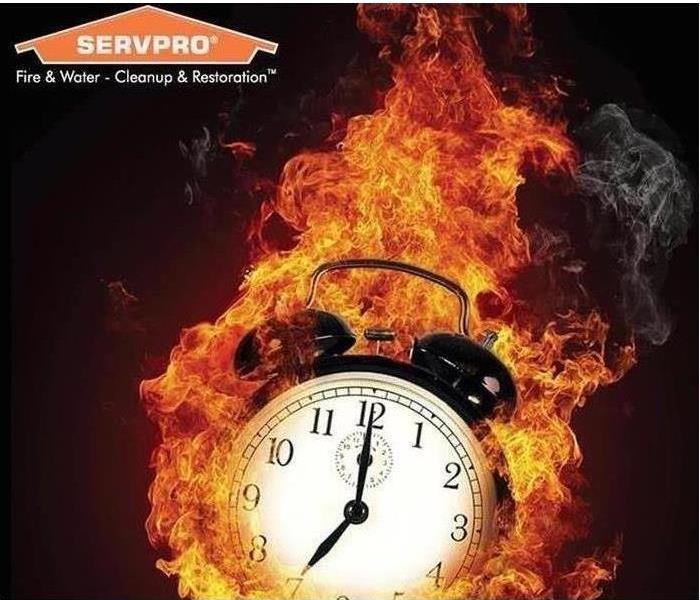 Don't waste time to plan to avoid a FIRE.
Don't waste time to plan to avoid a FIRE.
EMERGENCY FIRE DAMAGE TIPS
These emergency tips will assist you in taking proper action until your local SERVPRO® Franchise Professionals arrive. Follow these DOs and DON’Ts to help reduce damage and increase the chances of a successful restoration.
DO:
- Limit movement in the home to prevent soot particles from being embedded into carpet and avoid tracking.
- Keep hands clean. Soot on hands can further soil upholstery, walls and woodwork.
- If electricity is off, empty freezer and refrigerator completely and prop doors open to help prevent odor.
- Wipe soot from metal kitchen and bathroom faucets, trim and appliances.
- If heat is off during winter, pour RV antifreeze in sinks, toilet bowls, holding tanks and tubs to avoid freezing pipes and fixtures.
- Remove soot particles from plants with a damp cloth.
- Change HVAC filter, but leave system off until a trained professional can check the system.
- Tape double layers of cheesecloth over air registers to stop particles of soot from getting in or out of the HVAC system.
DON’T:
- Don’t attempt to wash any walls or painted surfaces without first contacting your SERVPRO® Franchise Professional.
- Don’t attempt to shampoo carpet, rugs or upholstered furniture without first consulting your SERVPRO® Franchise Professional.
- Don’t attempt to clean any electrical appliances (TV sets, radios, etc.) that may have been close to fire, heat or water without first consulting an authorized repair service.
- Don’t consume any food or beverages that may have
- been stored close to fire, heat or water. (They may be contaminated.)
- Don’t turn on ceiling fixtures if ceiling is wet. Wiring may be wet or damaged and cause electrical shock and air movement may create secondary damage.
- Don’t send garments to the dry cleaner. Improper cleaning may set in smoke odor.
P.A.S.S the acronym for portable fire extinguisher usage
2/12/2019 (Permalink)
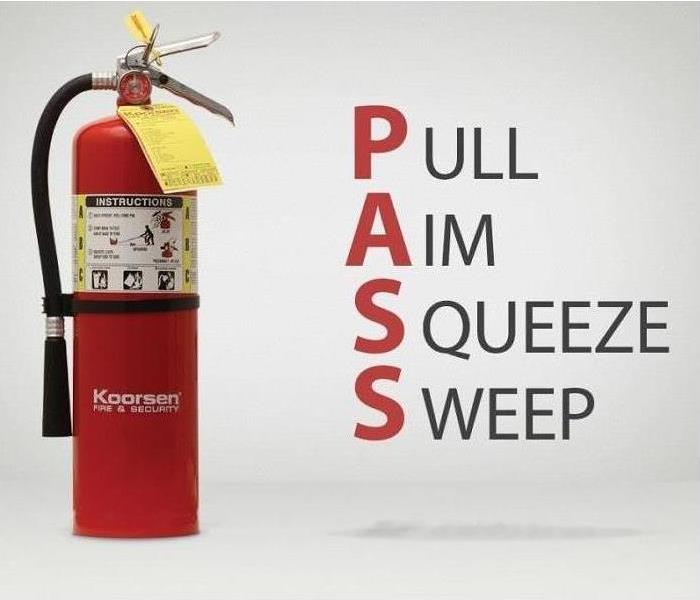 Making it "like it never even happened"
Making it "like it never even happened"
EMERGENCY FIRE DAMAGE TIPS
Portable fire extinguishers
Portable fire extinguishers can be life and property saving tools when used correctly. In order to operate an extinguisher, the National Fire Protection Association (NFPA) suggests remembering the word PASS:
Pull the pin. Hold the nozzle pointing away from you and release the locking mechanism.
Aim low. Point the extinguisher at the base of the fire.
Squeeze the lever slowly and evenly.
Sweep the nozzle from side-to-side.
Read the instructions on the fire extinguisher and become familiar with them before a fire breaks out. Remember, extinguishers do have limitations. It is also important to ensure you have the correct type of extinguisher for your facility. To find more information on choosing the appropriate class of extinguisher, please visit the NFPA website at nfpa.org.
Smoke Alarms: LIFE SAVERS
2/12/2019 (Permalink)
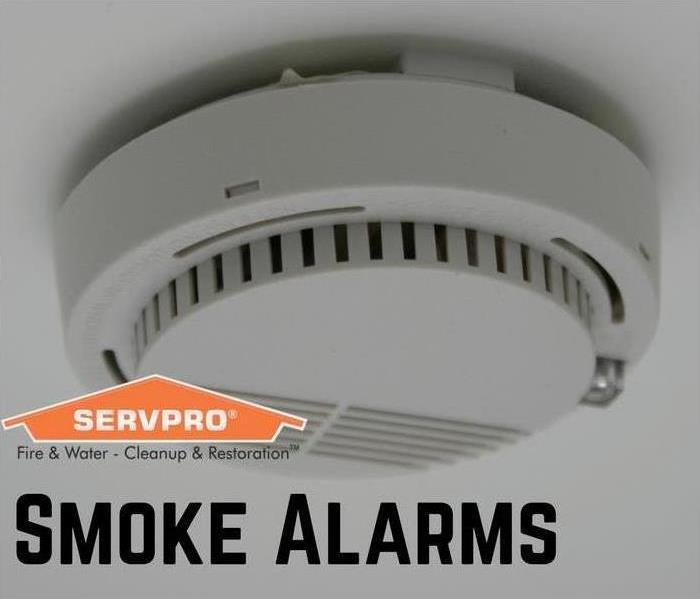 Don't let the batteries be the reason.
Don't let the batteries be the reason.
Smoke Alarms: LIFE SAVERS
Smoke alarms save lives when properly installed and maintained, according to the National Fire Protection Association (NFPA).
In homes, smoke alarms should be in every bedroom and on every level, including the basement. In office and commercial environments, check your state requirements or contact your local Fire Marshall to help ensure all codes are met.
Test smoke alarms monthly using the test button. Smoke alarms with non-replaceable batteries need the entire smoke alarm unit replaced every ten years. Other alarms need batteries replaced every year and the unit replaced every ten years. If the alarm chirps signaling low battery, take the proper steps to replace the unit or the batteries immediately. Never disable or remove the battery from an alarm. Almost half of fires where smoke alarms were present but did not activate had missing or disconnected batteries (NFPA).
In larger commercial facilities, hard wired or wireless smoke alarms offer benefits such as not needing to be tested as often and activating throughout the entire building if smoke is detected in just one area (NFPA).
If you need help installing, testing or changing batteries in your smoke alarms, contact your local fire department, an electrician or the American Red Cross.
Be sure your home or workplace has a fire emergency plan in place and conduct regular fire drills. For more information on Emergency preparedness, contact your SERVPRO® Professional. 708-240-4873
POLAR VORTEX 2019 SERVPRO
1/29/2019 (Permalink)
As a polar vortex rolls across the United States in this week, there is a point when we have a lower temperature than Antarctica. Take a second to think about that.
Although temperatures in LaGrange Park and Chicago-land drop quickly, we will fair better than other areas.
Unfortunately for homeowners and business owners in our area, the drop will still wreak havoc with their pipes. Being overwhelmed on what to do is going to be the first thought. That is why you need a plan and a company.
Many homes and businesses will call about burst pipes, flooded basement and closed office due to sprinkler breaks and will be put on wait lists.
Although it does seem like some of these burst pipes will be inevitable, there are a few precautions that you can take to avoid a major loss when the temperatures drop.
Insulate Pipes
Insulating your pipes is inexpensive compared to the cost of a water damage and is easy to do yourself. This is the first step when preparing your house for cold weather.
Insulate Everything Else
Make sure there is plenty of insulation in your attic and crawlspace. This will keep everything in your house warmer including your pipes.
Run Faucets
When you know that there is going to be a big temperature drop, like the recent polar vortex, don't give water a chance to freeze by running it. The smallest stream from a faucet will keep the water moving and prevent freezing. This is especially important to do with faucets that are served by exposed pipes.
Keep Garage Door Closed
If there are pipes in your garage, you need to keep it as warm as possible. Do not leave it open and try to open it only when absolutely needed.
Remove, Drain, and Store Hoses
Water in hoses can freeze and start a chain reaction that will lead back into your house. Prevent this by removing all hoses from the house and draining them.
Open Cabinets
Open cabinets in the kitchen and bathroom to get some warmer air moving beneath your sinks.
Keep House Temperature Consistent
Most people drop the temperature in their house down at night. When temperatures are especially cold, it is best to keep the house at a higher consistent temperature. The price of heat is nothing compared to the price of a burst pipe.
Set Temperature When Out of Town
If you will be out of town during the winter, make sure to keep the temperature of your house above 55 degrees at the very least.
Following these simple steps can go a long way in preventing a major water damage. For the losses that cannot be prevented, remember to call us at SERVPRO of LaGrange Park/N. Riverside at 708-240-4873!
FIRST RESPONDERS BOWL
12/14/2018 (Permalink)
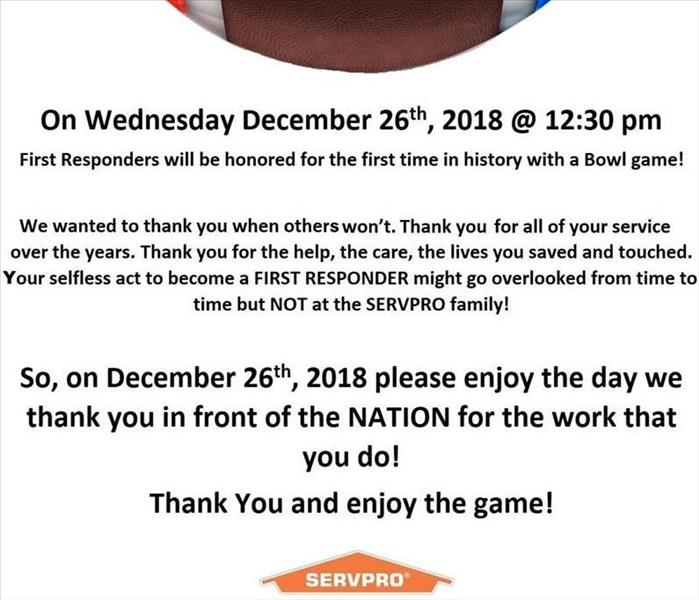 WE THANK YOU!
WE THANK YOU!
FOLLOW THE GAME!
FOLLOW THE GRATITUDE!
EXPERIENCE A GREAT FOOTBALL GAME IN APPRECIATION OF THE PEOPLE WHO PUT THEIR LIVES ON THE LINE EVERYDAY TO HELP OTHERS.
JOIN US FOR THE NEW SERVPRO FIRST RESPONDER BOWL AS WE RECOGNIZE OUR FRIENDS AND NEIGHBORS ACROSS OUR COMMUNITIES WHO PROTECT AND SERVE.
https://www.firstresponderbowl.com/
FIRES IN WINTER
12/7/2018 (Permalink)
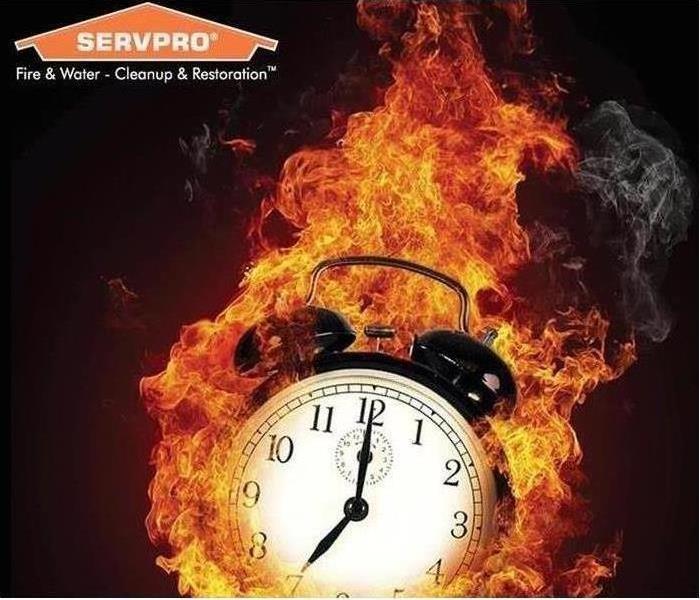 Where you have smoke you have fire!
Where you have smoke you have fire!
As the temperature has begun to drop we are seeing an uptick in the number of residential fires. 890 people die in winter home fires each year. $2 billion in property loss occurs each year from winter home fires. Winter home fires account for only 8 percent of the total number of fires in the U.S., but result in 30 percent of all fire deaths.
Winter brings several potential hazards into the home. Cooking is the leading cause of all winter home fires. Holiday decorations like faulty lights, dry Christmas trees, and candles are also a major cause. The top three days of the year for candle fires are Christmas, New Year’s Day and New Year’s Eve.
Faulty and improperly utilized alternative heating methods such as space heaters, fireplaces, and wood burning stoves also contribute not only to fire risk but carbon monoxide risk as well. Heating equipment is involved in one of every six reported home fires, and one in every five home fire deaths. Heating equipment is also a major source of carbon monoxide and winter months are when carbon monoxide incidents are more common.
Here are a few tips that you can share with your policy holders:
- Have your fireplace, heating vents and dryer vents inspected and cleaned by a professional every year.
- If you use your fireplace, make sure you clean after every use. Dispose of ashes correctly by placing them in a metal can at least ten feet from the house.
- Keep anything that can burn at least three feet from any heat source like fireplaces, wood stoves, radiators, or space heaters
- Plug only one heat-producing appliance (such as a space heater) into an electrical outlet at a time.
- If portable generators are needed, keep them outside, away from windows and as far away as possible from your home. Make sure someone is home to supervise.
- Install and test carbon monoxide alarms at least once a month.
- Keep your Christmas tree watered and dispose of it when it has become too dry. Nearly 40% of Christmas tree fires occur in January.
Here is a link to a great source of information https://www.nfpa.org/Public-Education/By-topic/Seasonal-fires/Put-A-Freeze-on-Winter-Fires
Please be safe and remember that if a problem does arrive, SERVPRO of La Grange Park / North Riverside is there 24/7/365 to help and make it "Like it never even happened."
We have a continuing education class coming up February 13. It is called Understanding Mold in the Restoration Industry and is going to be a great one. I have attached a flyer with more information. If you have a need for Ethics credit, please reach out to me as we are in the process of scheduling another class.
Finally, one request. If you have had a good experience with SERVPRO of Arlington Heights/Prospect Heights or SERVPRO of LaGrange Park/North Riverside please head over to our Yelp page or Google and give us a review. We truly appreciate everything you have done to help us grow!
https://twitter.com/SPArlProHeights https://www.facebook.com/SPArlingtonHtsProspectHts/ https://www.facebook.com/SPLagrangePKNRiverside/
Ice Daming
11/27/2018 (Permalink)
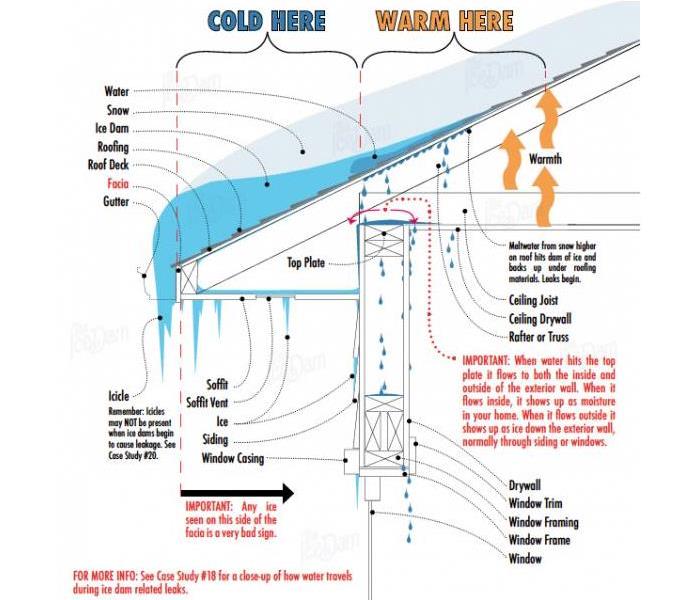 IF YOU SEE ICICLES YOU HAVE AND ISSUE!
IF YOU SEE ICICLES YOU HAVE AND ISSUE!
Ice dams occur after a heavy snowfall when warm air in the attic causes the roof to warm and the snow to melt. Water running down the roof refreezes when it reaches the colder roof edge, forming a mound of ice.
Icicles are a sure sign of poor roof ventilation and poor insulation in your home. Warm moist air from inside your home can move upwards and leak around ceiling lights through poorly insulated ceilings and around attic access openings.
Temp fix for the issue:
Lay the hose onto the roof so it crosses the ice dam and overhangs the gutter. If necessary, use a long-handled garden rake or hoe to push it into position. The calcium chloride will eventually melt through the snow and ice and create a channel for water to flow down into the gutters or off the roof.
Deep Fryer Fires
11/21/2018 (Permalink)
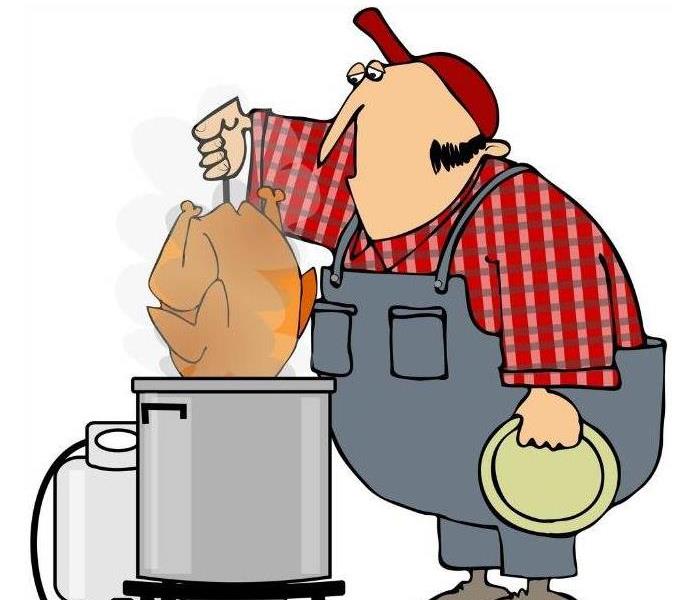 HAPPY THANKSGIVING!
HAPPY THANKSGIVING!
Keep the bird outside where it all started is going to be the best way to keep the bird from being the reason that you are staying in a hotel on and after Thanksgiving.
FACT: According to the National Fire Protection Association: deep fryer fires cause an average of 5 deaths, 60 injuries and more than $15 million in property damage each year. Deep-frying turkeys has become increasingly popular, but the new tradition is a recipe for holiday tragedy.
Deep Fryer Fires | FDNY Smart
www.fdnysmart.org/deep-fryer-fires/
Deep-Frying Outdoors
Although you’re outdoors, using a propane deep fryer can be very dangerous. Never leave your deep fryer unattended and be sure to carefully follow these instructions:
- To start, take the wrapper off of the turkey, and remove and discard the neck and giblets.
- Deep-fry your turkey outside on a flat surface, far away from homes, garages, wooden decks, etc.
- To determine how much oil is needed for frying, place the thawed turkey in the fryer basket and place it in the fryer. Add water until the top of the turkey is barely covered. Remove the turkey, allowing the water to drain from the turkey back into the fryer. Measure and mark the water line, and use that line as a guide when adding oil to the propane fryer.
- Pat the turkey dry with paper towels.
- Add oil to the fryer (based on the water line).
- Preheat oil in the fryer to 375° F.
- While the oil is heating, prepare your turkey with any seasonings, marinades, or injected flavor that you desire.
- When the oil is hot, turn the burner off and slowly lower the turkey into the hot oil. Slowly lowering the basket helps prevent the oil from bubbling over. Turn the burner back on.
- Cook the turkey about 3 to 4 minutes per pound.
- The turkey is done when the dark meat is at an internal temperature of 175° F to 180° F and all white meat is at an internal temperature of 165° F to 170° F.
- When the turkey is done, slowly lift it from the pot and place it in a pan or on paper towels to drain. Let the turkey stand for 20 minutes before removing it from the rack or basket.
- Let cool to a good eating temperature and ENJOY!
Fall Maintenance Tips for Your Commercial Property
8/21/2018 (Permalink)
It’s official, fall is coming, and it’s coming quickly. School gear is being purchased in bulk, last minute vacations are being taken to squeeze out the final remnants of summer and hot weather, and fall apparel and gear have hit the stores in preparation for the cooler air and shorter days. Take the hint and start your own preparations to make sure your commercial property is ready for the changing seasons.
Check Your Gutters – The season is known as “Fall” for a reason, leaves are going to change color and fall from the trees in bulk, and that means a lot more than increased sweeping and vacuuming inside as they are tracked in on shoes. The biggest threat that comes from all of those falling leaves and debris is to your gutter system. Make sure it’s clear so that water will flow freely away from your building when it rains and pours. This simple step will go a long way towards preventing roof leaks and flooding.
Check Your Heaters – Avoid surprises by checking to make sure your heater works before the first cold snap. This means checking on the pilot light, oil levels (if applicable) and furnace filters, as well as having an HVAC expert come in for a seasonal checkup. Not only will your employees and customers thank you, but these steps can help ensure your heating unit will work better and last longer.
Check Your Water Pipes – Exposed water pipes should regularly be checked for leaks, but fall is also a good time to examine the insulation and make sure it’s prepared for colder weather. Prevent frozen and burst pipes in the winter by conducting a quick check in the fall and fixing any inadequacies.
Prevent Electrical and Fire Problems – Have an electrician come in and perform a maintenance check on your electrical system to ensure it’s prepared for the increased usage that fall demands. Shorter and colder days mean more lighting and the possible addition of space heaters, and you don’t want to blow a fuse when clients are around! While you’re at it check your smoke detectors and their batteries ideally once a month, but in the spring and fall at the least, and any emergency generators which should be started once a week so they don’t remain idle too long, transfer load tested every month and full load tested once a year.
SERVPRO of LaGrange Park/North Riverside is here to help. Give us a call at 708-240-4873 for all your emergency preparedness needs, as well as emergency water or fire needs. We will make it "Like it never even happened."
What Causes Mold To Grow In Your Home
8/8/2018 (Permalink)
Mold spores need three things to grow into mold: nutrients, cellulose (the cell wall of green plants) is a common food for indoor spores, and moisture. To begin the decaying process caused by mold; time -mold growth begins from 24 hours to 10 days after the provision of growing conditions.
Molds are found everywhere, and can grow on almost any substance when moisture is present. They reproduce by spores, which are carried by air currents. When spores land on a moist surface suitable for life, they begin to grow.
Common building materials are capable of sustaining mold growth. Mold growth in an indoor environment is typically related to water or moisture and may be caused by incomplete drying of flooring materials. Flooding, leaky roofs, building-maintenance or indoor-plumbing problems can lead to interior mold growth. Water vapor commonly condenses on surfaces cooler than the moisture-laden air, enabling mold to flourish. This moisture vapor passes through walls and ceilings, typically condensing during the winter in climates with a long heating season. Floors over crawl spaces and basements, without vapor barriers or with dirt floors, are mold-prone.
Significant mold growth requires moisture and food sources and a substrate capable of sustaining growth. Common building materials, such as plywood, drywall, furring strips, carpets, and carpet padding provide food for mold. In carpet, invisible dust and cellulose are food sources. After water damage to a building, mold grows in walls and then becomes dormant until subsequent high humidity; suitable conditions reactivate mold. Mycotoxin levels are higher in buildings which have had a water incident.
If you suspect, that you have mold growing in your home or business, Call SERVPRO of LaGrange Park/North Riverside today at 708-240-4873. We will help you make it “Like it never even happened.”
Smoke Detector Life Expectancy
8/3/2018 (Permalink)
You have a smoke detector in your home, but have you ever wondered what the life expectancy of that alarm is? Smoke alarms save lives. Smoke alarms that are properly installed and maintained play a vital role in reducing fire deaths and injuries, but how long before it should be replaced?
The U.S. Fire Administration for Homeland Security, the National Fire Protection Association (NFPA), the National Electrical Manufacturers Association (NEMA) and the Red Cross agree after working for 87,000 hours, or about 10 years in normal environmental conditions in the home can have an impact on the performance of your smoke alarm.
The NFPA conducted a study, and the results reinforced how important it is for integrators to address the fire safety needs of their clients: 1 in 5 Smoke Alarms Is 10+ Years Old
- Half of Americans (50 percent) have three or more smoke alarms in their current home.
- Almost one in five Americans who have smoke alarms (19 percent) say the oldest smoke alarm they currently have in their home is 10+ years old.
- Nearly one in five Americans who have smoke alarms (18 percent) are not at all sure how old the oldest smoke alarm they currently have in their home is.
- When asked how often they should replace smoke alarms, nine in 10 Americans (90 percent) did not select the correct answer, which is at least every 10 years.
SERVPRO of LaGrange Park/North Riverside wants you and your family safe. Keep these tips in mind when checking your smoke alarms.
Garden Hoses Can Cause Water Damage To Your Home
7/27/2018 (Permalink)
A 25-foot, 1/2-inch diameter hose attached to a faucet that supplies water at 40 psi has a flow rate of 24 gallons per minute, while a 100-foot hose only has a flow rate of 6 gallons per minute. That is a lot of water coming from a garden hose. That is why it is so important to make sure that when you are out watering your garden or flowers that you keep an eye on the hose. Walking away from your hose while it is on can cause water to flow into your home and cause water damage.
A leaking garden hose can also cause water damage to your home as well as mold damage due to the long period of time that the water might be entering your home. Here are some things you should look for when you come across a leaking water hose, and how you can stop the water from entering your home.
The most important thing to determine is where the leak on your hose is actually coming from. This shouldn’t be too difficult to do, but depending on the location will determine the severity of the problem and how much effort it will take to fix it. If your hose always leaks from around the connection to the water tap, you may have either a problem with the spigot itself, or the hose fitting. If water wells up around the handle, your packing washer may be worn out, or the packing nut may need to be tightened, but if water only leaks when your hose is secured to the faucet, then you need to see if the water is welling up around the actual connection, or from below the fitting.
If you find that you have water damage to your home due to water entering your home from the garden hose, SERVPRO of LaGrange Park/North Riverside is here to help. Give us a call at 708-240-4873.
Summer Storm Tips
7/23/2018 (Permalink)
During the summer months, our minds are preoccupied with vacationing, grilling burgers with the family, and focusing on getting that bronze tan at the poolside. Yet, most of us leave our most valued possessions unprepared for the alarming and unpredictable summer storms: our homes.
Each year, thunderstorms alone cause an astonishing $15 billion in property damage. Summer and spring seasons are the most vulnerable to these destructive and frightening storms. Hailstorms result in approximately $1 billion of property damage a year. Thunderstorm winds can reach over 100 mph with an outcome of severe roof and house siding damage. Flooding causes billions of dollars a year in damage to homes and sadly some result in total loss of residences.
Here are some summer time safety tips to keep in mind during summer storms:
- Know the safest structure of your home to go to during a severe storm such as a basement, underground cellar, or even the most inner part of your home away from windows.
- Take summer storm warnings and alerts seriously, especially tornado and hurricane warnings! Tornadoes and hurricanes can lead to total property loss and even death.
- Invest in storm windows.
- Contact your insurance company to be more familiar with your policy. Most home insurers do not cover flooding damage.
- Cut down any unwanted trees or limbs and get your trees trimmed before summer storm season. Trees and branches can fall on your property and damage the siding or windows due to those powerful 100 mph thunderstorm winds.
- Get routine maintenance on your roof and the foundation! Cracks in the roof are the number one leading cause to flooding damage.
Summer storms can happen at any time. Make sure you home is ready, and your family is safe. Unfortunately, we all know things happen, even to the most prepared home. SERVPRO of LaGrange Park/North Riverside is here to help! Give us a call at 708-240-4873 for all your water damage needs.
Summertime Fire Safety
7/17/2018 (Permalink)
Now that it is summer, it is bonfire time! According to a report from the United States Fire Administration, summer is one of the most dangerous seasons for fire-related injuries and deaths. Fortunately, there are plenty of ways to protect yourself and your loved ones while still having a great time. Here are some great tips from the American Fire Safety Administration.
Choose a location for your bonfire where it will not spread. Never build a fire near any dry leaves or grassy areas or under overhanging tree branches. Before building a bonfire, clear away all shrubbery and vegetation from the area, dig a pit for the fire, and surround it with rocks.
Be smart about lighter fluid. Do not store gasoline, liquid fire starter, or any other type of flammable liquid near the campfire. It's too easy for stray flames to ignite these materials.
Never light a bonfire if you do not have the means of extinguishing it. Always keep plenty of water and a shovel near the campfire to use in an emergency and to put the campfire out when you are finished using it.
If you experience a fire at your home while enjoying a beautiful summer night, SERVPRO of LaGrange Park/North Riverside is here to help. Give us a call at 708-240-4873.
Summer humidity spreading mold
7/11/2018 (Permalink)
In general, mold grows well within the same temperature range that makes us feel comfortable, about 60 to 80 degrees. When warm, moist air comes into contact with cold surfaces, it can create condensation, since the cooler air can't hold as much moisture. Sometimes, humidity or dampness, or water vapor in the air can supply enough moisture for mold growth. Indoor relative humidity should be kept below 60 percent. Ideally humidity should be kept between 30 percent and 50 percent, if possible.
In the summer, air conditioning can de-humidify indoor space. However, if the system is too large or too small for the space it serves, the cooling system can create high humidity by cooling without removing water vapor. A properly sized and maintained system will dehumidify and cool a building. Learn more about the role of heating, ventilation and air conditioning HVAC systems in indoor environmental quality.
When there are cold surfaces in a building, water vapor can condense on those surfaces, just as water condenses on the outside of a glass of ice water. Insulation of exterior walls can prevent condensation and mold growth during the winter.
You should always be mindful of indoor sources of water vapor that can be problematic. Clothes dryers must be vented to the outdoors. Unvented gas or kerosene space heaters can generate enormous amounts of water vapor, as well as other air contaminants, and should be used sparingly and never as a primary heat source. Always run the bathroom exhaust fan when showering or bathing, and make sure the vent is exhausted to outdoors. A properly vented kitchen exhaust fan can remove steam created during cooking.
If you find you have mold growth in your home give SERVPRO of LaGrange Park/North Riverside a call at 708-240-4873. We will make it “Like it never even happened.”
Does Your Business Have An Emergency Readiness Plan?
7/5/2018 (Permalink)
According to the U.S. Small Business Administration, as many as one in four businesses that suffer some kind of major disaster do not reopen afterward. According to the National Fire Prevention Association, U.S. fire departments responded to about 3,300 office property fires per year between 2007 and 2015. Those fires resulted in about $112 million in property damage each year, and most were in business offices.
The NFPA also has statistics specific to manufacturing facilities. According to their research, there are about 37,000 fires at industrial or manufacturing facilities each year, resulting in 18 deaths, 279 injuries, and $1 billion in property damage. Heating equipment and stop tools were the leading cause sparking 28 percent of the fires. Mechanical failure or malfunction caused 24 percent of the fires.
Floods are the #1 natural disaster in the United States. Every business in every state is at risk of water damage from floods. In the past 3 years all 50 states have experienced flash flooding causing damage to businesses as well as homes.
We offer an Emergency Readiness Plan that literally puts getting help after a fire or water damage at your fingertips. The Ready Plan is an emergency preparedness tool for home and business owners, property managers, risk managers and facility management. It allows for the creation of an Emergency Ready Profile™ containing critical facility information to help speed up response time.
You need a restoration company that is going to not only help you get your company back on their feet, but also work with your insurance company. SERVPRO of LaGrange Park/North Riverside is here for your business and commercial property. We are here to help! Call us today at 708-240-4876 to discuss all your fire and water restoration needs or to create an Emergency Readiness Plan for your business.
Prepping Your Property For Summer Storms
6/29/2018 (Permalink)
Have an emergency kit with these items you probably already have in your home: flashlight(s), battery powered weather radio, extra batteries to fit each electronic (including cell phone), non-perishable foods (canned goods and dry foods), lots of bottled water, can opener, first aid kit (with a disinfectant), fire extinguisher, blankets, extra clothes, sturdy shoes or boots, clock or watch, whistle to signal for help, important personal items (eyeglasses, prescriptions, etc.), and paper documents such as birth certificates, social security cards, and other significant legal papers.
- Know the safest structure of your home to go to during a severe storm such as a basement, underground cellar, or even the most inner part of your home away from windows.
- Get routine maintenance on your roof and the foundation! Cracks in the roof are the number one leading cause to flooding damage.
- Cut down any unwanted trees or limbs and get your trees trimmed before summer storm season. Trees and branches can fall on your property and damage the siding or windows due to those powerful 100 mph thunderstorm winds.
- Contact your insurance company to be more familiar with your policy. Most home insurers do not cover flooding damage.
- Keep all expensive and favored possessions off the floor and away from low ground in case of flooding. Keep them in the highest part of the home preferably.
- Invest in storm windows.
- Keep all patio furniture, grills, etc. in doors before a summer storm hits. Do not forget to park your vehicles in the garage!
- If your town is evacuating due to a hurricane, secure and board up windows and any openings of your home.
- Finally, take those summer storm warnings and alerts seriously, especially tornado and hurricane warnings! Tornadoes and hurricanes can lead to total property loss and even death.
SERVPRO of LaGrange Park/North Riverside is here to help. Water damage, fire damage, and storm damage can cause serious damage to your home or commercial property. Give us a call at 708-240-4873 for all your restoration needs.
Two Easy Ways to Avoid Water Damage
6/27/2018 (Permalink)
Water damage is the No. 1 culprit that weakens your home’s foundation and the very core that holds your house together. You’ve heard about core strength for your body. Well, water damage hits at the core strength of your house, eventually causing serious structural damage. Damp wood invites termites and carpenter ants; plus, it causes mold and mildew.
Here’s how to prevent water damage using three easy strategies that will give you peace of mind the next time heavy storms hit.
#1 Test Your Sump Pump
Sump pumps come to life during storms. That’s not when you want to realize yours isn’t working properly. You should check it at least once a year, and ideally perform several checks during heavy storm seasons.
How to test your sump pump:
- Slowly fill the sump pump pit with water. Watch for the “float” (similar to the float in your toilet) to rise, which should turn on the pump. Then watch to make sure the water level falls.
- Test your backup pump the same way, but unplug the main pump first.
- If you don’t have a backup pump — or a generator — and are on municipal water, get one that runs on water pressure. If you’re on well water, your only option is the battery kind.
#2 Check for water leaks and fix them.
- Check for dark spots under pipes inside sink cabinets, stains on ceilings, toilets that rock, and of course drips.
- At least once a year, inspect your roof. Repair missing, loose, and damaged shingles. Repair any cracked caulking and check for leaks around flashing.
Prolonged and persistent leaks lead to mold.
This is just 2 very simple ways to avoid having water damage to your home. However, life happens and SERVPRO of LaGrange Park/North Riverside is here to help. Give us a call at 708-240-2873 for all your water damage needs.
Do's & Don’ts of Flood Damage Cleanup
6/25/2018 (Permalink)
The first thing you will need to do after a flood is make sure that it’s safe for you and your family to be on the property. SERVPRO has the ability to pull our resources in the event of a flood and can be onsite to assist you in the event of a flood. Here is a list of Do's and Don'ts after a flood for you to consider.
- DO beware of rodents, snakes and insects that might have come in with flood waters
- DO smell for gas and look for damaged power and gas lines, foundation cracks and exterior damage
- DO look for broken pilings, shifted stairs, slanted floors and walls
- DO turn off water and power (unless you would have to do so while standing in water)
- DON’T enter your home or business if you see major structural damage
- DON’T walk on sagging floors or floors above sagging ceilings
- DON’T use electrical appliances or turn on ceiling fans and lights if the ceilings are wet
Once you’re ready to start the cleaning process, it’s important to prioritize. At this stage:
- DO check that your running water is safe to drink and to use for cleaning
- DO flush your toilet before you use it to check for clogs from mud and debris
- DO check for cabinets and other items that may be ready to fall over
- DO temporarily patch holes in the walls and roof with plastic wrap and repair floors and roof sections with 4X4s if you can do so safely
- DO remove debris
- DO remove water trapped in walls
- DO open all the doors and windows to improve ventilation
- DO use a wet vac, shop vac, fans, dehumidifiers and desiccants (materials that absorb moisture) to start drying out the property
- DON’T drain a flooded basement too quickly, because rapid changes in pressure could cause the foundation to collapse
- DON’T do structural or electrical work yourself
- DON’T connect generators to the home’s power system, but plug in fans and appliances directly
- DON’T use generators, grills, camp stoves or charcoal inside homes or within closed areas
- DON’T use a household vacuum to remove water and mud
- DON’T let garbage pile up, as it could exacerbate contamination and house pests
- DON’T leave pools of standing water, which could become breeding grounds for mosquitoes
Floods are serious events to a persons home or business, SERVPRO of Lagrange Park/North Riverside is always here to help. Give us a call at 708-240-4873. We will make it “Like it never even happened.”
Mold Prevention
6/22/2018 (Permalink)
The key to mold prevention is simple: moisture control. You can't mold-proof your home, but you can make it mold-resistant.
Identify problem areas in your home and correct them. - See water spots in the ceiling and walls? There is water coming from somewhere. Find the sorce and stop it.
Dry wet areas immediately. Mold can't grow without moisture, so tackle wet areas right away. Seepage into the basement after a heavy rainfall, accumulation from a leaky pipe, even a spill on the carpet should be dried within 24 to 48 hours
Direct water away from your home. If the ground around your home isn't sufficiently sloped away from the foundation, water may collect there and seep into your crawlspace or basement.
Improve air flow in your home. According to the EPA, as temperatures drop, the air is able to hold less moisture. To increase circulation, open doors between rooms, move furniture away from walls, and open doors to closets that may be colder than the rooms they’re in. Let fresh air in to reduce moisture.
Again, mold proofing your home is not achievable. However, following these few steps will help make it mold resistant. However, as we know, even our best efforts sometimes do not hinder mold growth, and that is where SERVPRO of LaGrange Park/North Riverside comes in handy. We are IICRC certified in mold remediation and will help make your home or business look “Like it never even happened.” Give SERVPRO of LaGrange Park/North Riverside a call at 708-240-4873.
Summer Tips For Your Commercial Property
6/19/2018 (Permalink)
Summertime is the perfect chance for you to freshen up the outside of your commercial property, temperatures are finally starting to heat up and signs of summer are rolling in. It also marks that time of year when commercial real estate property owners and managers need ensure that their buildings are ready the seasonal changes in order to avoid unexpected issues or costs.
Inspect your roof – Summer weather leads to strong storms. Keep a close eye on your roof to make sure leaks haven’t developed.
- Clean out gutters– Clean out any debris that’s trapped in your gutters. This is not only good for your gutters, but it also gives your business a well-maintained appearance. Summer often means severe storms, hail and even tornado activity that can put a severe strain on roofing materials. Start the summer out right by getting a professional roof inspection to determine any problems that might have occurred over the winter months. Ice and snow damage may have occurred that isn’t immediately evident. Loose tiles, damage to underlay materials and problems with gutters can lead to more serious problems as the season continues
- Revitalize the exterior– Clean up any trash or yard debris that’s lying around your property. Plant summertime flowers to offer a fresh pop of color. Apply a new coat of paint – or even better, use commercial pressure washing to remove dirt, pollen, and grime. Don’t forget about commercial concrete stains on your drive-thrus and sidewalks.
- Thoroughly inspect surfaces– Walk around your property and make note of any stains or damage on your exterior walls. Call us to come by and see how we can clean up your exterior with commercial pressure cleaning.
- Window maintenance, Winter weather may have damaged the windows on your commercial property, which could lead to higher air-conditioning costs during the summer months. Thorough caulking can prevent leakage of cooled air and save more on energy bills.
SERVPRO of LaGrange Park/North Riverside is here to help with all your commercial property needs. Give us a call at 708-240-4873, and ask about our Emergency Readiness Planning.
Water Damage Insurance Claim Tips
6/15/2018 (Permalink)
SERVPRO of LaGrange Park/North understands the insurance companies and how to help guide you through your claim. Here are some claim tips to assist you with your claims process for water damage.
Contact Your Insurance Company ASAP
Keep your policy number at hand and be prepared to provide them with detailed information of damages.
Take Note Of Everything
Keep detailed records of everything during the initial call. This includes the name of the agent you’re speaking to, the date of the call, the time, and what was discussed.
Keeping this information handy will help you if you experience a problem with your claim.
Document the Damage
DON’T throw anything out or try to make permanent repairs before the adjuster is able to estimate the damages. Doing this may void coverage. Take photographic evidence of damages, make a detailed list of damaged items, and provide receipts if you have them available.
Damage Control
You’ll want to (and your insurance company expects you to) do as much as you can to prevent further damages. These are considered emergency repairs and will not affect your coverage.
If your house is flooding or if you’re suffering from storm damage, soak up as much of the water as possible, dry out waterlogged items, and board up broken windows.
Keep receipts for the cost of these emergency repairs, and if you’ve had to relocate, keep receipts for any travel or lodging expenses.
Dealing with water damage is stressful enough, so we try to make the insurance process as stress-free possible. As a courtesy to our customers, we’ll guide them through the insurance process and help them with their insurance claim.
SERVPRO of LaGrange Park/North Riverside is always here to help. Give us a call at 708-240-4873 for all your residential or commercial water damage needs.
5 Fire Damage Restoration Tips
6/11/2018 (Permalink)
Fire damage can be very stressful time for your home or company. Here are some tips to remember in the event of fire and smoke damage to your home or business.
Repairing Smoke Damage to Walls
With fires there will always be a degree of smoke damage to your walls, wall paper and paint. If the smoke damage is not too serious, you should be able to scrub it clean with detergents and bleach. Note: soot from smoke damage is greasy stuff so you should always try to dust as much of it off from a surface before trying to scrub it clean. Often, you’ll want to repaint, but make sure all surfaces are clean and dry before painting.
Getting Rid of Mold & Mildew
Another huge issue in fire damage restoration is actually introduced by the water used to extinguish a fire. This problem is mold and mildew, and requires special attention. We highly recommend fire damage restoration professionals to deal with mold and mildew, because it can cause serious health problems, and can contaminate furniture, carpets, clothing, mattresses, walls and vents. The best thing you can do immediately is air out every room and clean out all vents and filters.
Repairing Flooring & Carpet
With all the water that is involved in putting out a fire, your floors and carpets will end up absorbing the worst of it. In almost every case, it’s recommended that you pull up any carpets that have water damage and replace them. Water can also seep underneath vinyl flooring and into cracks of hard wood, and will need to be addressed. If you have experience with flooring, you can lift it up and clean under them, but you may want to call a professional fire damage restoration company to assist you.
Cleaning Clothing
Cleaning smoke damage from clothing is one of the biggest jobs you’ll find after a fire. We’ve written a whole article on Restoring Clothing of Smoke Damage. Our biggest tip is to make sure you don’t smear the greasy soot into the clothing or just throw the smoky clothes into the wash. Often times dry cleaning is the best bet, and you should ask around local dry cleaners to see if any have experience with post-fire laundry.
Cleaning Dishes
Dishes are also important items to clean thoroughly after a fire because they will be in contact with your food and can cause health problems. Scrub all dishes well, let them soak in a solution of bleach and water (2 tablespoons of bleach per gallon) for at least 20 minutes and scrub some more for safety. When in doubt, if a dish, pot or pan won’t come clean, cut your losses and throw it out – (especially rubber or wooden dishes that absorb smoke).
SERVPRO of LaGrange Park/North Riverside are always here to help, If you have found your home or commercial property has had a fire give us a call at 708-240-2873 for all your restoration needs.
Soot Damage Tips
6/6/2018 (Permalink)
Soot and smoke damage is harmful to your health and will spread throughout the entire residence or building after a fire loss. Soot and smoke damage clean up is difficult because you will need to make sure that the soot is cleaned correctly so there is nothing harmful left behind. With smoke damage even a light coating of soot can be permanently embedded into items if professional restoration techniques are not used.
Below are some tips we tell our customers when they call in for fire damage, and soot damage to their home. They are not all inclusive in nature, and are not a substitute for professional services like what we provide.
Fire and Smoke Do's:
- Limit the movement in the home to prevent spreading and embedding soot particles.
- Clean and protect chrome trim on kitchen appliances with a light coating of petroleum jelly or other oil.
- Clean and coat any metal, brass, or copper that may be restored with oil.
- Blow off or brush-vacuum loose soot and particles from upholstery, carpeting and drapes.
- Open windows to begin to air out the property.
- Wash plants with water.
- Change the furnace filter (if the furnace is operating).
- Empty the refrigerator or freezer (if electricity is off) and prop doors open.
Don'ts:
- Do not attempt to clean or wash as absorbent surfaces i.e. walls, ceilings, etc.
- Do not use upholstered furniture.
- Do not use any food items that have been exposed to high heat or smoke.
- Do not use electronics until they have been professionally checked and cleaned.
SERVPRO of LaGrange Park/North Riverside takes care to insure that your soot and smoke damaged contents are restored properly to prevent further degradation of property or your health. Give us a call at 708-240-4873 for all your fire, smoke, and soot damage needs.
BBQ Safety Tips
5/28/2018 (Permalink)
It’s Memorial Day, and as we remember those who have given their lives for our freedom, we also enjoy spending time with friends and family. Let’s face it, most of that time is spent outside around the grill. According to the National Fire Protection Association (NFPA),” In 2014, 16,600 patients went to emergency rooms because of injuries involving grills”. The NFPA has listed several great tips for grill safety, we would like to share with you. You can also find other great tips at https://www.nfpa.org/Public-Education/By-topic/Seasonal-fires/Grilling/Grilling-safety-tips
- Grill outside and away from any structures
Charcoal and gas grills are designed for outdoor use only. However, NFPA reports that more than one-quarter (27 percent) of home fires started by outdoor grills began in a courtyard, terrace or patio, and 29 percent started on an exterior balcony or open porch. Pay attention to overhanging tree branches when you set up your grill.
- Make sure your grill is stable
Only set up your grill on a flat surface and make sure the grill can’t be tipped over. Consider using a grill pad or splatter mat underneath your grill to protect your deck or patio.
- Keep your grill clean
Remove grease or fat buildup from both the grill and the tray below the grill. If you are using a charcoal grill, allow the coals to completely cool off before disposing of them in a metal container.
- Check for propane leaks on your gas grill
Before the season’s first barbecue, check the gas tank hose for leaks by applying a light soap and water solution to the hose and then turning on the gas. If there is a propane leak, the solution will bubble. Other signs of a propane leak include the smell of gas near the barbecue or a flame that won’t light.
- If the flame goes out, wait to re-light
If you are using a gas grill and the flame goes out, turn the grill and the gas off, then wait at least five minutes to re-light it.
- Take care around the grill
Never leave a lit grill unattended. Don’t allow kids or pets to play near the grill. Never try to move a lit or hot grill, and remember the grill will stay hot for at least an hour after use.
- Be careful with charcoal starter fluid
If you use a charcoal grill, only use charcoal starter fluid. If the fire starts to go out, don’t add any starter fluid or any other flammable liquids to the fire. Consider using a charcoal chimney starter, which uses newspaper to start the fire instead of starter fluid.
- Wear the right clothing
Clothing can easily catch fire, so be sure your shirt tails, sleeves or apron strings don’t dangle over the grill.
- Be ready to put out the fire
Have baking soda on hand to control a grease fire and a fire extinguisher nearby for other fires. If you don’t have a fire extinguisher, keep a bucket of sand next to the grill. Never use water to put out grease fire.
Enjoy, relax, and most of all use these tips to stay fire safe. However, we all know accidents happen. If you should find you have a need for cleaning up after a fire event, SERVPRO of LaGrange Park/North Riverside is here to help make it “Like it never even happened.” Give us a call at 708-240-4873.
Tornado Season Safety
5/21/2018 (Permalink)
Tornado season is just ahead of us, and it’s never too early to plan ahead for a storm. The Red Cross has listed some great tips to keep in mind during a tornado.
- Identify a safe place in your home where household members and pets will gather during a tornado: a basement, storm cellar or an interior room on the lowest floor with no windows.
- In a high-rise building, pick a hallway in the center of the building. You may not have enough time to go to the lowest floor.
- In a mobile home, choose a safe place in a nearby sturdy building. If your mobile home park has a designated shelter, make it your safe place. No mobile home, however it is configured, is safe in a tornado.
Another way to keep your family safe is to know the difference between and tornado warning and a tornado watch. According to the National Weather Service, a tornado watch means that a tornado is possible in the area. A tornado warning means that a tornado is already occurring or will occur soon. You need to immediately find a safe place.
If you find yourself outside during a tornado, seek shelter in sturdy building or basement. I f you cannot quickly walk to a shelter, immediately get into a vehicle and try to drive to the closest sturdy shelter. Stay away from bridge/highway overpasses. f strong winds and flying debris occurs while driving, pull over and park, keeping your seat belt on and engine running. Put your head down below the windows, covering your head with your hands and a blanket.
Your safety is your most important thing during a tornado. We are here to help! SERVPRO of LaGrange Park/North Riverside is here to help for all your cleanup needs in the event of a tornado. Give us a call at 708-240-4873.
5 Ways to Prevent Water Damage To Your Home This Spring
5/16/2018 (Permalink)
Water damage is very common in the spring due to warmer weather, melting snow, and rains that cause flooding. Here are a few ways you can help control the water entering your home.
Check your downspouts and gutters. When debris gets trapped in gutters, it can block the passage of water from flowing freely off of roofs and away from the home. Clearing out debris from both gutters and downspouts can help to prevent water from entering into attics, walls, and foundations.
Mend foundation cracks. Water can get in more easily when there are cracks in the foundation. For minor repairs, fill cracks with a concrete patch. For bigger concerns, it is best to call a professional.
Re-grading the landscaping surrounding your home to make sure water drains away from the home instead of toward it. If necessary, pull plant material and add more soil where needed. The most important part is to keep the water running away from your home.
Installing sump pumps to help send water away from the home in areas such as basements and below-grade rooms that tend to flood more easily. Inspect your sump pump to make sure it is in good working order and is clear of debris.
Installing window well covers not only allows for natural light in below ground rooms but also prevents melting snow and rain from making its way into the home.
SERVPRO of LaGrange Park/North Riverside understands that water happens, and that unfortunately no matter what measures you take to reinforce your home, water can still get in. Give us a call at 708-240-4873 for all your water damage needs.
Spring Maintenance Tips For Your Commercial Property
5/14/2018 (Permalink)
It’s time to spruce up your commercial property now that spring has arrived. Here are several spring maintenance tips that reduce your liability and prep your property for warmer weather.
Inspect your property for water damage. Melting snow and ice can increase water flow around your property. Inspect the entire building for water damage. Check the exterior foundation, interior walls and windows for moisture, leaks or condensation, and clear out and repair any damaged gutters and downspouts.
Check for any roof damage to the property. Winter storms can damage your roof, but you may not notice the damage until the roof starts to leak. Perform a detailed inspection of the roof and note any repairs you need to make.
Touch up the exterior of the buildings. Cold winter weather can cause paint to chip, and flying debris can dent siding. Walk around the building, note any damaged paint or siding, and fix the areas.
Make repairs to the parking lot. If freezing temperatures created cracks or holes in the parking lot or sidewalks, fix the problem areas. You will want to power wash the area to remove dirt, mud or other debris, repaint any faded lines and repair broken signs. With a clean parking area, you reduce liability and improve visual appeal.
Remove winter grime and buildup on the exterior and interior by washing the windows. Clean windows boost productivity and improve the appearance of your commercial building.
Open windows and air out the stuffy building if possible to boot the ventilation. You may also inspect and clean the HVAC system and install fans or dehumidifiers in damp areas as needed.
SERVPRO of LaGrange Park/North Riverside is here to help with all your commercial property needs from cleaning HVAC systems, cleaning carpets and floors, to water, fire, and mold remediation. Give us a call at 708-240-4873. We can make it "Like it never even happened".
How To Control Mold Growth In Your Home
5/7/2018 (Permalink)
Indoor air quality matters a lot to our health, the Environmental Protection Agency estimates that we spend 90 percent of our time indoors, and that the air we breathe indoors is more polluted than the outdoor air.
There is no need to take a wrecking ball to the entire house at the sight of a little mold. Focus your mold removal and mold remediation efforts on the area where the water and mold growth is occurring by removing the mold at its source and eliminating the water source.
You can control mold by doing the following in your home: controlling humidity levels; promptly fixing leaky roofs, windows, and pipes; thoroughly cleaning and drying after flooding; ventilating shower, laundry, and cooking areas. Controlling the humidity levels, by keeping the levels low- no higher than 50%–all day long. An air conditioner or dehumidifier will help you keep the level low. Fixing leaky roofs, pipes, and windows and completely drying out any wet materials will prohibit mold growth in your home. Having a ventilation fan in the bathroom, cooking areas, and laundry rooms will cut down on the moisture levels which allow mold to grow.
If you suspect that you have mold in your home, give SERVPRO of LaGrange Park/North Riverside a call at 708-240-4873. We will send our trained professionals to your home to remove the mold, and help you feel comfortable in your home again.
Warm Weather Fire Safety
5/2/2018 (Permalink)
Spring has sprung finally here in LaGrange Park, and it is time to get outside and enjoy the sun while it lasts. As you transition from sweaters to shorts, deep fryers to grills, and indoor holiday parties to backyard barbecues, keep an eye on these areas:
Grill Area- NFPA reports that an average of 8,900 home fires are caused by grilling each year. Here are some fire safety tips for the grill:
- While the meat is marinating, be sure to check each potentially problematic point of the grill including the propane tank, the hose, and all connecting points.
- Charcoal should be soaked with charcoal starter fluid only.
- Make sure the grill is clean, failing to clean the grill before and after use is a contributing factor in nearly 20% of all grill structure fires.
- Make sure the grill is set up in an open, outdoor area with nothing flammable (plants, paper products, etc.) nearby.
Outdoor Fire Pits
The necessary safety precautions for an outdoor fire pit are much the same as for a grill, plus a few others:
- Never leave young children unattended near a fire in the pit.
- Fill a bucket with water and set it next to the pit before you even begin building the fire.
- Avoid throwing leaves, pine cones, pine needles and paper into the fire. They catch fire quickly and can result in dangerous floating embers.
- Unless there’s an emergency, avoid dumping the entire bucket of water on the fire to put it out. Instead, spread the pieces of fuel as far apart as possible and gently sprinkle water over them until there are no more glowing embers. This prevents the scatter of embers and a thick cloud of smoke.
Chimneys
The NFPA recommends having a chimney inspected and thoroughly cleaned at least once a year anyway, and getting it out of the way this time of year often means ridding it of buildup that would only cause more damage if it hung around until the fall.
Smoke Alarms
As the spring and summer days progress, don’t forget to test the smoke alarms each month.
Dryers
The NFPA recommends cleaning out the vent pipe at least once a year. SERVPRO of LaGrange Park/North Riverside can help get the vents cleaned for you as well, give us a call at 708-240-4873.
Let’s enjoy these warmer spring days, and remember SERVPRO of LaGrange Park/North Riverside is here for you and all your restoration needs.
Helpful Tips to Prepare Your Home for Spring Storms
4/30/2018 (Permalink)
Spring has arrived in LaGrange Park, and taking a few preventative steps now, can save you from dealing with substantial damage to your home later. With the warm temperatures, spring cleaning projects are an ideal time to start, but it is also an ideal time to start thinking on how to improve your property to prevent storm damage.
Here are some tips from Access Home Insurance to help you spark improvement projects this spring in your home.
- Identify any existing roof or siding problems:A licensed contractor can inspect your roof for missing shingles and possible leaks and do any repair work if necessary. It’s also a good idea to inspect and reinforce any loose siding, which can quickly rip off during high winds.
- Use shredded bark mulch as landscaping material:If you have rock or gravel landscaping, it’s a good idea to replace it with bark, which won’t cause damage if blown around in high winds.
- Maintain trees and shrubbery in your yard: Spring is the perfect time to remove dead or weak branches or remove trees that could fall on your home during a storm. Check trees and shrubs regularly to identify potential problems.
- Ensure gutters aren’t loose or clogged:Clear your gutters of debris and make sure they are tightly attached to your house. Strong winds can quickly tear loose gutters from your home and cause damage. Also, it’s important to make sure downspouts are positioned away from your home’s foundation to help prevent basement flooding.
- Secure top-heavy furniture: Don’t forget about the inside of your home too. Walk around your house and secure large, top-heavy pieces, such as bookcases, to the wall.
If you have questions about projects around your home that need to be taken care of before the spring storms begin, give SERVPRO of LaGrange Park/North Riverside a call at 708-240-4873. We are always here to help.
Storm Safety For Your Commercial Property
4/23/2018 (Permalink)
Severe weather is a serious threat and one that can often happen with little warning. It’s important to be thorough and proactive to ensure your business is protected. .As we start to enter storm season, it is important to take some time and inspect your commercial property to assess and identify any maintenance that can be performed to further reduce the risk of damage in the case of a storm. Some of these maintenance items may be, cutting all tree branches away from the building, weather proofing windows, making sure that all your emergency signs are visible, and in good working order, just to name a few things.
Another way to ensure your property is storm ready is to check your generators for the building. This is exceptionally important for medical facilities, rehab facilities, and nursing homes who rely on the generator for life saving medication dispensing and to operate machines. Making sure you have enough power to maintain the facility for at least a minimum of three days is what FEMA recommends.
It is also essential to communicate with your tenants of the property. Making sure that you and your tenants have an emergency readiness plan in the event of an emergency is vital not only to assist keeping your tenant up and running, but for the safety of the building. Nearly 40% of small businesses close after a disaster, according to the Federal Emergency Management Agency. 52% of small businesses say it would take at least three months to recovery from a disaster, according to a 2015 survey of 500 small business owners conducted by Nationwide. Only 25% of businesses that close due to a major disaster ever reopen, according to the Institute for Business & Home Safety.
SERVPRO of LaGrange Park/North Riverside offers a free Emergency Ready Plan that we can assist all of the tenants of your commercial property where one call to our office and we have all the necessary information to begin a quick clean up and get your building back to full working order. To get more information on our Emergency Readiness Plan, give us a call at 708-240-4873.
6 Things that Cause Sump Pump Failures
4/20/2018 (Permalink)
It is spring time in LaGrange Park, and the one thing we know is that rain is never far behind. With the spring rains comes the sump pump failure calls from homeowners. Often we are asked, how does this happen and why does my sump pump fail? The following is some of the top reason we have seen sump pumps fail.
Power failures: When the electricity goes out, and the sump pump does not have a battery backup or the battery backup is not fully charged there is no way for the pump to do their job. Making sure that your battery backup system is fully charged before a storm the best way to ensure you don’t have water backing up into your home.
Wrong size sump pump: When you have an undersized pump it causes the pump to have to work extra hard to remove the water from your home. If the pump is too big, it has to work harder, and in return the life span is lessened.
Defective sump pump: Yes, it does happen that at the time of install the sump pump is defective. It is wise to test the pump when it is initially installed to make sure the pump operates properly.
Frozen of Clogged Lines: If the water cannot exit, the pump does not work. Protecting the water’s exit point of the discharge pipe will keep debris and animals out of the system, making it optimal for your sump pump.
Switch Problems: The switch is the main mechanical reason for sump pump failures. This occurs when the pump shifts from its position inside the basin, rendering the float ineffective. Float is responsible for the smooth operation of the on/off switch. Your sump pump relies on both the switch and the float arm mechanisms to operate effectively.
Last, but not least is Lack of Maintenance: Most sump pumps should be ran every 2-3 months per most manufactures instructions. Testing to make sure your sump pump works before rainy season hits is also recommended.
If you have a sump pump failure this spring, SERVPRO of LaGrange Park/North Riverside is here to help. Give us a call at 708-240-4873.
What you should know about C. Diff
4/16/2018 (Permalink)
According to Mayo Clinic “when something upsets the balance of these organisms in your gut, otherwise harmless bacteria can grow out of control and make you sick. One of the worst offenders is a bacterium called Clostridium difficile (C. difficile, or C. diff). As the bacteria overgrow they release toxins that attack the lining of the intestines, causing a condition called Clostridium difficilecolitis.” C. diff is one of the most important causes of infectious diarrhea in the U.S. according to the CDC.
How Does It Spread?
- diff is found in feces and is transmitted by touch. If you come into contact with an infected surface, then touch your mouth or nose, the disease can enter your body through the mucous membranes. It can also be passed by touching an infected person, which is part of why it is so prevalent in healthcare settings or in places where sick people are common. People with compromised immune systems, including the elderly, are at an increased risk of catching this illness.
About 50 percent of the population naturally carries clostridium difficile (C. diff) in their intestines. The bacteria, C. diff, exists within the body in a vegetative state and doesn’t make people sick, unless illness, disease and antibiotic use puts them at risk.
What To Do If Someone You Know Has Contracted C. Diff?
The most important part and first thing you should do is get medical attention for the person with symptoms of having C. Diff. Then protect the rest of your home and prevent any reinfection by having your home thoroughly cleaned by a professional biohazard service like SERVPRO of LaGrange Park/North Riverside. This precaution is especially important if the ill person shares a bathroom with others, or if there are small children or elderly in the home. Even if surfaces like faucets and sinks appear clean, c. Difficile can be incredibly resistant to household cleaners and disinfectants. A traditional house cleaning may not be enough to defeat the illness.
“Studies have shown that out of all the surfaces that must be cleaned in a hospital room, only 39 percent will actually be cleaned by housekeepers,” Benjamin Tanner, president of Antimicrobial Test Laboratories. Using a professional service like SERVPRO of LaGrange Park/North Riverside, we are trained and use specialty equipment and environmentally green products to clean and disinfect the areas that have come in contact with the bacteria.
As with all of your commercial and home cleaning needs, we are here to help. We are “faster to any size disaster”. Call us at 708-240-4873, for an appointment.
Fire Safety Tips for the Warmer Months
4/12/2018 (Permalink)
Spring has finally sprung in LaGrange Park! Time to start thinking about cleaning out all the built up clutter and stagnant air from the winter. That also means time to take stock of some things that may be a fire hazard around your home during your cleaning.
According to NFPA, the leading cause of home clothes dryer fires is failure to clean them. Lint catchers need to be cleaned before you throw in the next load of laundry. Another safety tip for around your dryer area is to keep all boxes, and other items that can catch on fire away from the dryer while it is in use.
Testing your smoke alarms saves lives. Gently vacuum or sweep the cob webs away from your smoke alarm. Remove anything that might be blocking the sensors. While you are up there, change your batteries as well.
The NFPA reports that an annual average of nearly 48,000 electrical fires occurred in U.S. homes between 2007 and 2011. Make sure to replace any electrical cords that are damaged or loose, and try to avoid running any cords under carpets or across doorways where they’re more likely to get damaged. Any cords with damaged plugins or unprotected wires should be discarded immediately.
Lastly, when working with, or disposing of, and potentially hazardous chemicals, never use the same container to mix them, which could cause a deadly reaction and check with your local municipality for disposal programs, or instructions on proper disposal methods.
SERVPRO of LaGrange Park/North Riverside wants you to have a safe and fun spring season. However, things happen, and if you experience a fire in your home, give us a call at 708-240-4873. We are always “Faster to any sized disaster”.
Spring Cleaning DIY Tips
4/10/2018 (Permalink)
Spring is here, and the ability to throw open your windows and to clean out all the clutter from the winter has arrived. It is a great feeling to clean out the clutter, but it is also helpful for your health to deep clean your home. Here are a few of our favorite DYI tips.
- Remove water stains with lemon for a natural faucet fix
This spring, make faucets clean and sparkly by rubbing a lemon half on the water stains. The citric acid helps remove hard water marks. Then, use the other half of the lemon for our next tip.
- Clean your microwave by heating lemon juice and rinds in water
Cut a lemon into halves, squeeze the juice into 1/2 cup of water and drop the rinds into the mixture. Microwave for three minutes and let it stand for five minutes without opening the door. The trapped steam will loosen the grime, so you can wipe the microwave clean with less elbow grease.
- Use white vinegar to beat shower head buildup
Looking for more natural ways to clean your bathroom? Vinegar can dissolve the mineral deposits accumulate in showerheads over time, causing reduced pressure and water flow. Fill a plastic bag with white vinegar, secure it over the showerhead with a rubber band and leave it overnight to get rid of buildup. Just be sure to run the shower before you hop in, or you risk smelling like vinegar all day.
- Clean stainless steel sinks with baking soda
Simply wet your sink and faucet, sprinkle baking soda, and scrub with a sponge. If you need more heavy-duty scrubbing power, add salt to the baking soda.
- Use newspaper to clean dirty windows and mirrors
Mix ¼ cup of white vinegar, 2 cups of water and 2 teaspoons of liquid soap into a spray bottle. Spray the mixture onto the glass and scrub with newspaper for a streak-free window or mirror. The ink acts as a mild abrasive and allows you to make use of old newspapers.
- Organize your fridge and cabinets with rotating turntables
Don’t limit rotating turntables and Lazy Susan’s to your tabletops. After discarding old condiments and spices, organize your pantries and refrigerator with this useful storage hack.
- Place a wet dryer sheet on your ceramic stovetop to remove burnt-on residue
Dryer sheets are non-abrasive and a great way to remove burnt-on food from your stove. Place the wet dryer sheet on your stovetop at least 15 minutes before rubbing the gunk away.
- Clean your grill with an onion.
Get your grill cleaned up and ready for the warm weather. First, heat it up and spray some white vinegar onto the grates to help loosen the residue. Then, scrub the area firmly using half an onion. The acid from the onion will rid your grill of any leftover remnants.
Remember, spring means clean! Let SERVPRO of LaGrange Park/North Riverside help you with your spring cleaning of your HVAC system, and your carpets. Give us a call at 708-240-4873.
Controlling Mold Growth Indoors During Spring Cleaning
4/4/2018 (Permalink)
With the spring season’s warming weather we often open up our windows and take on the task of spring cleaning. The key to mold control is moisture control, people might not think to check for excess moisture that could lead to mold growth and take steps to prevent mold from becoming a problem in the home.
There are molds that can grow on wood, carpet and insulation. Mold growth will often occur when excessive moisture accumulates in buildings or on building materials. Molds are everywhere in the environment and can grow on virtually any organic substance where moisture and oxygen are present. If the moisture problem remains undiscovered it can affect your home’s indoor air quality and the health of people sensitive to mold. Potential health effects and symptoms associated with mold exposure include allergic reactions, asthma, and other respiratory complaints.
The EPA has listed several steps to control the mold in your home.
- Clean and repair roof gutters regularly.
- Make sure the ground slopes away from the building foundation, so that water does not enter or collect around the foundation.
- Identify and fix plumbing leaks and other water problems immediately.
- If you see condensation or moisture collecting on windows, walls or pipes dry the wet surface and reduce the moisture/water source.
- When water leaks or spills occur indoors. If wet or damp materials or areas are dried 24 to 48 hours after a leak or spill, in many cases, mold will not grow.
- Scrub any visible mold off hard surfaces with detergent and water and dry the area completely.
- Keep air conditioning drip pans clean and the drain lines unobstructed and flowing properly.
- Keep indoor humidity low. If possible, keep indoor humidity below 60 percent ideally between 30 and 50 percent — relative humidity. Relative humidity can be measured with a moisture or humidity meter, a small, inexpensive instrument available at many hardware stores.
Mold is a serious concern not just in the spring, but all seasons of the year. If you believe that you have mold in your home, give SERVPRO of LaGrange Park/North Riverside today at 708-240-4873.
April Showers Bring May Flowers
3/30/2018 (Permalink)
We all know the “April Showers Bring May Flowers” rhyme from our childhood, but those April showers can also bring water damage to your home.
Often we see home owners call about sewer drain back up, and find they have the coverage but have a cap on that coverage. It is very important for a homeowner to know their policy, so they do not find a large out of pocket expense when those spring rains start over flowering their sewer drains.
Another loss that we find in the spring time are related to the gutters. The winds start kicking up debris into the gutters or the gutters were not cleaned in the previous fall before winter struck and now there is water damage in the ceilings of home from full gutters.
Also, with the wind, rain, and hail we find roof damage and damage from tree branches rise in the spring as well. If a strong storm roars through, you may find your siding damaged by hail and shingles that the wind ripped off the roof. When wind blows shingles from your roof, it makes your home vulnerable to rain, creating the need for emergency roof repair, and water mitigation in your home as well. Make sure that you are taking care of droopy tree branches, and checking the shingles on your roof to see what sort of damage may have occurred during the winter.
Water damage is never fun to deal with as a homeowner. If you experience damage from those spring showers, remember SERVPRO of LaGrange Park/North Riverside is always here to help. Give us a call at 708-240-4873.
Don't Let Mold Bloom In Your Home This Spring
3/26/2018 (Permalink)
First, let’s discuss, what is mold? According to the EPA, “Mold is a family of fungi and mold spores are everywhere, both indoors and outdoors. There are many thousands of varieties and we are exposed to them all the time, typically without incident. Mold spores feed on or break down organic substances.”
There are four factors that need to be present for mold growth to begin: mold spores, moisture, temperatures to promote growth, and a food source. When molds produce potentially toxic mycotoxins, can lead to health problems like asthma and other respiratory complications. The elderly, young children, and those with known respiratory are very susceptible to reactions when mold is present. The presence of dangerous mold requires a licensed, certified mold removal and remediation company.
Molds are everywhere in the environment and can grow on virtually any organic substance where moisture and oxygen are present. If the moisture problem remains undiscovered it can affect your home’s indoor air quality and the health of people sensitive to mold. The key to getting rid of mold is quickly removing the water from your property.
At SERVPRO of LaGrange Park/North Riverside our trained mold specialists take all necessary precautions to protect you from exposure to the hazards of mold in the home. They’ll evaluate the mold issue, completely remove and remediate the area and restore it to its original condition. We also can help take care of the water source causing the mold. If you suspect mold in your home, give us a call at 708-240-4873.
Candle Fire Safety
3/23/2018 (Permalink)
According to National Fire Safety Association, “Roughly one-third (36%) of home candle fires started in bedrooms. These fires caused 32% of the associated deaths and 47% of the associated injuries. Falling asleep was a factor in 11% percent of the home candle fires and 30% of the associated deaths. On average, 25 home candle fires were reported per day.”
Some safety tips to remember when burning a candle:
- Always keep a burning candle within sight. Extinguish all candles when leaving a room or before going to sleep. Be sure the wick ember is no longer glowing.
- Be sure the candle-holder is placed on a stable, heat-resistant surface. This can help prevent heat damage to underlying surfaces and prevent glass containers from breaking.
- Always burn candles in a well-ventilated room. Don’t burn too many candles in a small room or in a “tight” home where air exchange is limited.
- Place burning candles at least three inches apart from one another. This helps ensure they don’t melt one another, or create their own drafts to cause improper burning.
- Keep burning candles away from drafts, vents, ceiling fans and air currents. This will help prevent rapid, uneven burning, and avoid flame flare-ups and sooting. Drafts can also blow nearby lightweight items into the flame where they could catch fire.
- Use a snuffer to extinguish a candle. It’s the safest way to prevent hot wax splatters.
When putting out a candle fire, never extinguish candles with water. The water can cause the hot wax to splatter and might cause a glass container to break. Make sure that you have a fire extinguisher within reach. Never use water, as it will spread the fire. If you don't have a proper fire extinguisher nearby, use baking soda, sand or flour to extinguish the flames.
If you experience a fire in your home or business, give SERVPRO of LaGrange Park/North Riverside a call at 708-240-4873. We are always here to help.
How To Prevent Mold Growth
3/19/2018 (Permalink)
Where ever there is moisture, there will be mold growth. Thanks to these tips from the CDC, we can keep mold from growing out of control in our homes.
1) Keep humidity levels as low as you can—no higher than 50%–all day long. An air conditioner or dehumidifier will help you keep the level low. Bear in mind that humidity levels change over the course of a day with changes in the moisture in the air and the air temperature, so you will need to check the humidity levels more than once a day
2) Be sure that your home has enough ventilation. Use exhaust fans that vent outside your home in the kitchen and bathroom. Make sure that your clothes dryer vents outside your home.
3) Fix any leaks in your home’s roof, walls, or plumbing so mold does not have moisture to grow.
4) Clean up and dry out your home thoroughly and quickly (within 24–48 hours) after flooding.
5) Add mold inhibitors to paints before painting
6) Clean bathrooms with mold-killing products
7) Remove or replace carpets and upholstery that have been soaked and cannot be dried promptly. Consider not using carpet in rooms or areas like bathrooms or basements that may have a lot of moisture.
If you suspect you have mold growing on your home, SERVPRO of LaGrange Park/North Riverside is here to help. Give us a call at 708-240-4873 and set an appointment for us to come and look at your home or business to assess the suspected mold damage.
Why is Carpet Cleaning So Important?
3/14/2018 (Permalink)
Just take a moment to think about all the allergens, bacteria, and dust that are hiding in your carpeting. Gives you the chills a little bit, if you are like me. However, it’s not all about the contaminates found in your carpeting, but it helps maintain the carpeting, saves you money in the long run, and improves the smell in the carpeting.
Saving you money, you say? Yes, carpets are expensive. Regularly cleaning your carpet helps to keep it in good condition, protecting the money you spent on it. If you are looking to sell your home soon, or if you have brand new carpeting, it’s much easier to spend some money to call SERVPRO of LaGrange Park/North Riverside, rather than replacing the entire area.
We all know that first impressions are important. Maintaining your carpeting will allow your home/office to look clean. Vacuuming regularly is a great way to remove dirt and debris that ends up in the carpet. However, a regular deep clean is also needed to get some tougher stains out.
Got children? Got pets? If so, there is a good chance that your carpet does not smell as great as it did before. Routine cleanings are important, and an occasional steam clean is a great option if you want a fresh smelling carpet.
Last, but certainly not least, the best way to prevent spreading bacteria and allergens is to have a regularly scheduled carpet cleaning. Carpets are a perfect breeding ground for allergens and bacteria, and they can expose you and your family to dangerous pollutants. Especially if you have young children or pets, or if someone in the home has allergies, regular carpet cleaning is essential.
Call SERVPRO of LaGrange Park/North Riverside at 708-240-4873 to schedule your carpet cleaning. We are always here to help.
How Preventive Cleaning and Maintenance Can Help Your Commercial Property | SERVPRO of LaGrange Park/North Riverside
3/13/2018 (Permalink)
When it comes to taking care of your commercial property there is routine preventive care that needs to be done in order to maintain the wellbeing of your property. From flor care to duct cleaning SERVPRO of LaGrange Park/North Riverside can help with them all.
The winter season can be extraordinarily tough on floors, ice melt and similar products cause havoc on floors and can destroy a floor’s finish. The real purpose of floor finish is to protect the floor, this means the floor may be left unprotected, subject to all types of soils and contaminants that can permanently ruin it. SERVPRO of LaGrange Park/North Riverside is prepared to come in and clean your floors with our professional products and protect your floors.
Carpets also take a beating in the winter. People walking in and out of your business use the rugs to keep the floors from getting wet. Moreover, the entry way rugs are a business’s first impression. Overly dirty rugs can send the wrong message. SERVPRO can clean your rugs onsite or bring back to our warehouse and clean them and return within a short time.
Duct cleaning is important for the employees over all breathing heath. Dust, pollen, and debris that builds up in the ducts and filters causing allergies to flare, and breathing issues. SERVPRO of LaGrange Park/North Riverside can help you with your duct cleaning needs. We can arrange to clean your ducts with little to no disruption to your work day.
Cleaning not only protects human health, it protects assets. SERVPRO of LaGrange Park/North Riverside would like to help protect your commercial property. Give us a call at 708-240-4873 for all your property preventive cleaning needs.
Cleaning Up After A Flu Outbreak
3/6/2018 (Permalink)
Disinfecting should be part of your usual cleaning routine, whether or not anyone at home is sick. Disinfecting your home on a regular basis will help limit the number of days that people in your household get sick with a cold or flu.
Check the labels on your cleaning supplies to make sure the disinfectant works against the viruses you're targeting, such as cold and flu viruses. When you use disinfectant sprays, paper towels are better than sponges, but disposable disinfectant wipes have an advantage. Sponges and cloth tend to spread the germs around, however the disposable wipes you wet the surface and allow the area to dry. This also allows for more of the germs to be contained.
According to Center for Hygiene and Health in Home and Community, there are 7 major areas of your home to focus on disinfecting.
- Your phone. Eighty percent of phones in homes that have a child with the flu have the flu virus on them. That can include cell phones and land lines. Cold and flu viruses survive on them, anywhere from a few hours to a few days.
- The remote control. It's one of the most touched -- and least cleaned -- items in your house
- The bathroom. Half of all bathroom faucets have cold and flu viruses when someone has a cold or flu. Give the sick person their own hand towel, to avoid spreading disease through a shared towel.
- Kitchen tables, coffee tables, play-area tables, and night tables tend to host cold and flu viruses, because they're touched often and aren't wiped down enough.
- Check the maker's instructions before cleaning. You may be able to wipe keyboards or screens with an alcohol wipe or a paper towel sprayed with disinfectant.
- Stuffed animals. If possible, toss Teddy in the laundry. If it's not washable, keep it away from everyone for a few days to let viruses on its surface die.
- Sheets, blankets, towels. "These should be washed at high temperature with a color-safe bleach detergent. Wash your hands after handling them.
Here’s to helping keep your family a little less likely to catching the flu bug or nasty cold. Here at SERVPRO of LaGrange Park/North Riverside, we are always here to help.
Fireplace Safety
3/5/2018 (Permalink)
Winter is the perfect time to start up a fire in the fireplace, as an additional heating source in your home. However, if you are not careful the relaxing fire can turn into a fire hazard in your home. Here are some precautions we received from our friends at Travelers Insurance Company.
Keep Your Chimney Fireplaces and Wood Stoves Clean
Have your chimney, fireplace, wood or pellet stove inspected and cleaned by a licensed chimney specialist. They should be maintained annually to help ensure they are functioning safely and efficiently.
Be sure to keep the area around the hearth clear of debris, decorations and any other combustible materials.
If you have a wood burning, insert or pellet stove, refer to the manufacturer’s instructions for additional guidance related to operation and venting.
Keep Fires Burning Safely
Be sure the flue is open before lighting your fire to help ensure the fireplace will vent properly. Do not close your damper until you are sure the fire is out.
When starting a fire, only use a match or commercial firelighter. Never use flammable liquids to start a fire.
Glass doors of a fireplace should be kept open while burning a fire. This allows the fire to receive enough air for complete combustion and to help reduce creosote build-up in the chimney.
Metal mesh screens should remain closed whenever your fireplace is in use to help keep embers in the fireplace.
Only use dry wood in your fireplace. Wet wood can increase creosote buildup, which can lead to chimney fires.
Do not burn plastic because it can release toxic chemicals and cause damage to your chimney, fireplace or wood stove.
Never leave a fire in a fireplace unattended. Before leaving the house or going to bed, you should make certain to fully extinguish the fire.
Allow ashes to cool completely before disposing of them — ashes can take several days to cool completely. Never empty ashes directly into a trash can. Instead, place ashes in a covered metal container located at least 10 feet1 away from your home and any other building.
Keep the Outside of Your Home and Your Chimney Safe
Firewood should be stacked at least 30 feet away from your home.2
Your roof and chimney should be kept clean of leaves, pine needles and other debris. Prune trees and branches to keep them away from your chimney.
Install a chimney cap with spark arrester to help keep debris, leaves, branches and animals out, and to help prevent burning embers or sparks from escaping and creating a fire hazard.
Keep the Inside of Your Home Safe with Smoke and Carbon Monoxide Detectors
To help make your winter even safer, we recommend that you take the time to test your smoke and carbon monoxide detectors. A smoke detector is the most effective way to detect smoke from a fire and signal an alarm so that you can get you and your family out safely. A carbon monoxide detector can alert you to the buildup of this dangerous odorless and colorless gas. Make sure you test the detectors monthly, and after you change the batteries to ensure they work properly.
Source:
1 National Fire Protection Association. (2015). Wood and Pellet Stove Safety. PDF accessed from http://www.nfpa.org/safety-information/safety-tip-sheets.
2 National Fire Protection Association. (2015). Wildland Fire Safety. PDF accessed from http://www.nfpa.org/safety-information/safety-tip-sheets.
How To Prepare Your Home For Winter Storms
3/5/2018 (Permalink)
Winter is very hard on your home and can cause all sorts of damage. You can prepare your home for winter storm weather by following these safety tips.
Learn to protect your pipes from freezing. You can drain the water from outdoor supply lines. You can detach your water house, and close the valve. Your indoor pipes can be protected as well by dripping the faucet to keep the line open. You can also open cabinet doors to allow the heat from your home to keep the pipes above freezing.
Make sure your home is properly insulated. Caulk and weather-strip doors and windowsills to keep cold air out. You can buy weather stripping to put under any doors that have air leaking from underneath as well.
Install storm windows or cover windows with plastic from the inside to provide an extra layer of insulation to keep cold air out. Purchasing premade window kits will allow you to easily unpack the kit and install the plastic to your windows.
Consider buying emergency heating equipment, such as a wood- or coal-burning stove or an electric or kerosene heater. Remember, for your safety to vent the wood and coal- burning stove. Electric space heater needs to be at least 3 feet away from anything that can catch on fire, and make sure you unplug the heater when it is not in use.
Prepare your fireplace, if you have one. Have a supply of wood on hand so you can use the fireplace as a heating supply in your home. Always make sure that the fireplace is in good working order and is vented property before use.
SERVPRO of LaGrange Park/North Riverside is always here to help. If you have damage to your home due to a winter storm, we are here to help. Call us at 708-240-4873.
Experts Water Damage Restoration Technician Training
2/28/2018 (Permalink)

SERVPRO of LaGrange Park/North Riverside is investing in the future of our technicians by sending them to class to learn the basics of water damage restoration. “The IICRC-accredited Water Damage Restoration Technician (WRT) course is designed to provide basic education for technicians and other materially interested parties in the science and practice of water damage restoration. This course will cover extraction, basic containment and basic mold procedures. This course is designed to teach non-restoration personnel that perform remediation work to give them a better concept of water damage, its effects and techniques for drying of structures. This course will give residential and commercial maintenance personnel the background to understand the procedures necessary to deal with water losses, sewer backflows and contamination such as mold.” (IICRC website) We believe continuing education for not only our technicians, but our office staff provides a better service to our customers. Understanding what SERVPRO does, will make our customers experience with our staff a better experience and allow the customers a feeling they are well taken care of from the first call to our office all the way through the completion of their job.
If you have water damage to your home, or commercial property, give SERVPRO of LaGrange Park/North Riverside a call at 708-240-4873, and let us help you make it "Like it never even happened.”
What To Do Before a Winter Storm Hits
2/12/2018 (Permalink)
Winter storms can hit at any moment in the winter time here in Chicagoland. We all know the first thing we do is run to the local grocery store and stock up on the basics, but what else can you do to be prepared for a winter storm?
The American Red Cross gives some tips for you to consider before a winter storm hits.
* Listen to local area radio, NOAA radio or TV stations for the latest information and updates.
* Be prepared to evacuate if you lose power or heat and know your routes and destinations. Find a local emergency shelter.
* Check emergency kit and replenish any items missing or in short supply, especially medications and medical supplies. Keep it nearby.
* Be sure you have ample heating fuel.
* If you have alternative heating sources, such as fireplaces, wood- or coal-burning stoves, or space heaters, be sure they are clean and in working order.
* Check that your fire extinguisher(s) is in good working order, and replace it if necessary.
* Bring your companion animals inside and ensure that your horses and livestock have blankets if appropriate and unimpeded access to shelter, food, and non-frozen water.
SERVPRO of LaGrange Park/North Riverside is always here to help. If you have damage to your home due to a winter storm, we are here to help. Call us at 708-240-4873.
Fire Safety for the Elderly
2/7/2018 (Permalink)
The National Fire Protection Agency, advises that at age 65, people are twice as likely to be killed or injured by fires compared to the population at large. Approximately 12% of our population is made up of individuals 65 and older.
The Center of Disease Control has listed several tips for elderly fire safety.
- Keep it low
If you don't live in an apartment building, consider sleeping in a room on the ground floor in order to make emergency escape easier. Make sure that smoke alarmsare installed in every sleeping room and outside any sleeping areas. Have a telephone installed where you sleep in case of emergency. When looking for an apartment or high-rise home, look for one with an automatic sprinkler system. Sprinklers can extinguish a home fire in less time that it takes for the fire department to arrive. - Sound the alarm
The majority of fatal fires occur when people are sleeping, and because smoke can put you into a deeper sleep rather than waking you, it´s important to have a mechanical early warning of a fire to ensure that you wake up. If anyone in your household is deaf or if your own hearing is diminished, consider installing a smoke alarm that uses a flashing light or vibration to alert you to a fire emergency. View a list of product manufacturers. - Do the drill
Conduct your own, or participate in, regular fire drills to make sure you know what to do in the event of a home fire. If you or someone you live with cannot escape alone, designate a member of the household to assist, and decide on backups in case the designee isn't home. Fire drills are also a good opportunity to make sure that everyone is able to hear and respond to smoke alarms. - Open up
Make sure that you are able to open all doors and windows in your home. Locks and pins should open easily from inside. (Some apartment and high-rise buildings have windows designed not to open.) If you have security bars on doors or windows, they should have emergency release devices inside so that they can be opened easily. These devices won't compromise your safety, but they will enable you to open the window from inside in the event of a fire. Check to be sure that windows haven't been sealed shut with paint or nailed shut; if they have, arrange for someone to break the seals all around your home or remove the nails. - Stay connected
Keep a telephone nearby, along with emergency phone numbers so that you can communicate with emergency personnel if you're trapped in your room by fire or smoke.
If you or a loved one have fire damage in your home, please call SERVPRO of LaGrange Park/North Riverside at 708-240-4873. Let us help make it “Like it never even happened.”
Dust that accumulates in your air ducts can lead to microbial growth
2/2/2018 (Permalink)
Many sections of your heating and cooling system may not be accessible for a visible inspection, and mold can easily exist in your ducts. You should be aware that although a substance may look like mold, a positive determination of whether it is mold or not can be made only by an expert and may require laboratory analysis for final confirmation. If you have insulated air ducts and the insulation gets wet or moldy it cannot be effectively cleaned and should be removed and replaced.
You should consider having the air ducts in your home cleaned if:
- There is substantial visible mold growth inside hard surface (e.g., sheet metal) ducts or on other components of your heating and cooling system.
- Ducts are infested with vermin, e.g. (rodents or insects).
- Ducts are clogged with excessive amounts of dust and debris and/or particles are actually released into the home from your supply registers.
If you do decide to have your air ducts cleaned, give SERVPRO of LaGrange Park/North Riverside a call at 708-240-4873, and we will be happy to come to your home or business to clean out the ducts for you.
Winter Weather Preparedness Guide
1/17/2018 (Permalink)
Protecting your home is vital in the winter months. A frozen water pipe can burst and flood your house. An ice dam in your gutter can cause water to seep into and saturate an interior walls of your home. Here is a list from Nationwide insurance that they advise their homeowners on during the winter months to prepare their homes for the cold.
- Clean out the gutters, disconnect and drain all outside hoses. If possible, shut off outside water valves.
- Insulate walls and attics, and caulk and weather-strip doors and windows.
- Repair roof leaks and remove tree branches that could get weighed down with ice or snow and fall on your house – or your neighbor's. (Avoid liability for the latter.)
- Wrap water pipes in your basement or crawl spaces with insulation sleeves to slow heat transfer.
- Consider an insulated blanket for your hot water heater.
- If you have a fireplace, keep the flue closed when you're not using it.
- Have a contractor check your roof to see if it would sustain the weight of a heavy snowfall.
- Make sure your furniture isn't blocking your home’s heating vents.
- During cold spells, keep cabinet doors open to allow warm air to circulate around pipes, particularly those in the kitchen and bathrooms.
- Keep a slow trickle of water flowing through faucets connected to pipes that run through unheated or unprotected spaces.
- If your house will be unattended during cold periods, consider draining the water system.
- Avoid ice dams– where water from melted snow refreezes in the gutters and seeps in under the roof, soaking interior walls. Here’s how:
- Ventilate your attic.
- Insulate the attic floor well to minimize the amount of heat rising through the attic from within the house.
- Consider having a water-repellent membrane installed under your roof covering.
If you do find that you have damage to your home, the Insurance Information Institute has published some tips on what to do in the case of a winter storm and managing the damage to your home.
- Take pictures of the damage immediately. If you have "before" pictures, that's even better. Those pictures will help ensure that your insurer cannot claim that the problem was preexisting.
- Make temporary repairs to keep the damage from getting worse but hold on to all of your receipts.
- Don't make pricey repairs before the insurance adjuster arrives.
- Don't assume something is not covered. Take out your policy. Most weather-related damage like burst pipes, a collapsed roof and ice dams are covered.
- Call a reputable company to come and help with any damages to your home. Choose a company that will work with your insurance company.
SERVPRO of LaGrange Park/North Riverside is here to help in your time of need for all your winter storm damage needs. Give us a call at 708-240-4873. We work with your insurance companies to make it “Like it never even happened.”
Winter Fire Preventive Tips
1/12/2018 (Permalink)
According to the National Fire Protection Association, December, January, and February are the months that half the heating fires occur. Also in those same months, 1 and 7 fires heating equipment is reported as the cause of the fire. Space heaters are often the leading piece of equipment the source of the fires in this months. Almost 40% of the fires in December to February are space heater related.
Safety should always be a top consideration when using space heaters. Electrical Safety Foundation International has published several tips on safety while using a space heater.
- Make sure your space heater has the label showing that it is listed by a recognized testing laboratory.
- Before using any space heater, read the manufacturer’s instructions and warning labels carefully.
- Inspect heaters for cracked or broken plugs or loose connections before each use. If frayed, worn or damaged, do not use the heater.
- Never leave a space heater unattended. Turn it off when you're leaving a room or going to sleep, and don't let pets or children play too close to a space heater.
- Space heaters are only meant to provide supplemental heat and should never be used to warm bedding, cook food, dry clothing or thaw pipes.
- Install smoke alarms on every floor of your home and outside all sleeping areas and test them once a month.
- Proper placement of space heaters is critical. Heaters must be kept at least three feet away from anything that can burn, including papers, clothing and rugs.
- Locate space heaters out of high traffic areas and doorways where they may pose a tripping hazard.
- Plug space heaters directly into a wall outlet. Do not use an extension cord or power strip, which could overheat and result in a fire. Do not plug any other electrical devices into the same outlet as the heater.
- Place space heaters on level, flat surfaces. Never place heaters on cabinets, tables, furniture, or carpet, which can overheat and start a fire.
- Always unplug and safely store the heater when it is not in use.
Most of the U.S. is at risk for winter storms, which can cause dangerous and sometimes life-threatening conditions. Wind-driven snow, extreme cold, icy road conditions, downed trees and power lines can all wreak havoc to your home or commercial property. Home fires occur more in the winter than in any other season, and heating equipment is involved in one of every six reported home fires, and one in every five home fire deaths.
If you experience a fire, SERVPRO of LaGrange Park/North Riverside is here to help. Give us a call at 708-240-4873 for all your fire, smoke, and soot damage related needs. We work with your insurance companies to make your home look “Like it never even happened.”
What mold damage does to your property
1/8/2018 (Permalink)
Moisture is always the cause of indoor mold growth. Mold doesn't just grow on construction materials all by itself, it requires moisture. Control moisture and you control mold growth. The source of moisture is typically one of three origins. Either:
- Direct water intrusion event such as a roof leak, plumbing leak, poorly sealed leaking windows, drain back-ups, water run-off from showers and bath tubs, etc.
- Indirect water intrusion from rising damp, such as moisture wicking up from the ground or damp concrete slabs into walls, carpet, cabinets, furniture, etc.
- Intermittent water intrusion from condensation caused by humidifiers, vaporizers, high steam, inadequate ventilation, faulty windows, and high humidity.
Mold can grow on any wet building materials, including stucco. Once it is discovered, it must be addressed quickly and properly. Delayed or improper treatment of mold issues can multiply repair costs exponentially.
When building materials such as wood siding, brick, concrete block and stucco are exposed to moisture, over time that moisture can penetrate exterior walls and enter the wall cavity, creating perfect conditions for mold growth in between exterior and interior walls.
Being pro-active is the key to limiting mold damage is being pro-active. If you suspect you have a mold problem, don't ignore it, address it immediately. A common mistake people make is to assume that only visible mold is a problem. In vain, they attempt to wash moldy areas with bleach or cover mold up with new paint, wallpaper, carpet or tile. None of which solves the problem. Unless all mold contaminated materials are removed or properly remediated, mold will keep coming back. The only way to correct indoor mold problems is to eliminate the cause, remove all mold growth and control moisture.
SERVPRO of LaGrange Park/North Riverside is here to help with all your mold damage needs. Please give us a call at 708-240-4873. We are always here to help!
Which pipes are likely to freeze?
1/3/2018 (Permalink)
Cold temperatures can cause pipes to freeze. Frozen pipes are a problem because they prevent water flow, but even worse, frozen pipes can eventually burst, causing damage and potential flooding.
How do you spot frozen pipes? The first way to spot frozen pipes is frost on the pipes. This can serve as a warning sign that the pipe is frozen before you ever try to turn on the faucet. Examining the pipes under your kitchen sink and noticing frost is a sure sign that you have frozen pipes.
Another way to spot frozen pipes is that the water is not coming out of the faucet, or coming in a very small stream. When you turn on the faucet, and a slight trickle of water or no water at all comes out, the water pipe leading to the faucet may be frozen.
If you have water damage after noticing the frozen pipes give SERVPRO of LaGrange Park/North Riverside a call and we will be happy to help assist with the water damage to your home. Leaving damaged water pipes can cause more problems in the future, so give us a call to help make it "Like it never even happened."
Winter Water Damage
12/11/2017 (Permalink)
For many in the US, the thought of getting home water damage from a cold snap does not even cross our minds, but the truth is, any home can be susceptible to cold. Here are some tips you will need to be aware of in order to protect your home from expensive water damage.
Ice Dams: Ice dams cause a significant amount of water damage each year to homes. There are essentially two ways in handling ice dams. You can do a temporary installation of heat cables on the overhang of your roof. These cables will heat the roof area and melt the snow not allowing it to form ice damn, however, this method can also cause damage to your shingles and shorten the life time of the shingles.
The most effective long-term solutions are to keep heat out of the attic and to promote ventilation under the roof deck to keep it as cold as possible. A soffit-and-ridge vent system usually requires insulation baffles installed at the lower side of the roof, above the exterior walls. The baffles hold back the insulation by a couple of inches, creating a channel for air to flow past the insulation.
Pipe Breaks: When winter temperatures plummet, water can easily freeze inside the piping, causing them to burst. If you are unaware or not home when this happens, massive amounts of flooding to your home can happen to your home, furniture, and rugs. The best way to avoid broken pipes is to wrap the uninsulated pipes with a blanket or foam.
Melting Snow: Melting snow can impact any home, whether it has a basement, crawlspace, or a slab foundation. If enough snow ends up piling up next to your foundation, it’s going to create a lot of water once it melts. If your lawn is not sloped away from your home, you are very likely to get gallons of water coming in from your foundation.
High Winds Roof Damage: Winter storms often bring very fast moving and strong winds with them. These strong winds are capable of tearing shingles off of your roof. Just a small amount of damaged or missing shingles can end up allowing a lot of water into your attic. When possible a roofing company can come and check your roof, but remember that if there is snow and ice on the roof it is not safe for anyone, including trained professionals to get on the roof.
If you experience water damage to your home this winter, SERVPRO of LaGrange Park/North Riverside here to help. Give us a call at 708-240-4873 for all your water damage needs.
How To Prevent Water Damage From Frozen Pipes
12/4/2017 (Permalink)
Frozen pipes are a sure way to water damage in your home, but how do you prevent frozen pipes in the winter? Our friends at American Family Insurance share some great tips on keeping your pipes from freezing.
The best way to prevent your home’s pipes from freezing is to keep them from being exposed to the cold. Here’s how:
- Cover exposed pipes in crawl spaces or attics with insulation sleeves.
- Re-route pipes to an inside wall.
- Use caulking to seal cracks in the foundation or walls that let cold air in.
- Disconnect garden hoses and turn off the water supply to spigots.
- Keep cabinet doors open below your sinks to allow warm air in.
Other ways you can winterize your home from frozen pipes remove all the hoses from the outside water supply. Once you have drained and stored the hose away, open up the outside valve. This will allow the remaining water to drain and allows the pipe to expand without breaking. You should also consider a pipe sleeve to install over the outside water line to insulate and keep ice from forming.
The American Red Cross gives great ideas on preventative action during cold weather to consider to keep your pipes from freezing as well.
- Keep garage doors closed if there are water supply lines in the garage.
- Open kitchen and bathroom cabinet doors to allow warmer air to circulate around the plumbing. Be sure to move any harmful cleaners and household chemicals up out of the reach of children.
- When the weather is very cold outside, let the cold water drip from the faucet served by exposed pipes. Running water through the pipe - even at a trickle - helps prevent pipes from freezing.
- Keep the thermostat set to the same temperature both during the day and at night. By temporarily suspending the use of lower nighttime temperatures, you may incur a higher heating bill, but you can prevent a much more costly repair job if pipes freeze and burst.
- If you will be going away during cold weather, leave the heat on in your home, set to a temperature no lower than 55° F.
There are many way to keep your home safe from winter pipe breaks. Please feel free to reach out to SERVPRO of LaGrange Park/North Riverside at 708-240-4873 if you need any help with your home.
Thanksgiving Fire Safety for the Kitchen
11/10/2017 (Permalink)
It’s that time of year again that we start thinking about gathering our family and friends in our homes to celebrate Thanksgiving. With that celebrating, the kitchen is certainly the heart of the home. It is also the perfect time to start thinking about your fire safety during all the chaos and hustle and bustle.
Thanksgiving by the numbers
- Thanksgiving is the peak day for home cooking fires, followed by Christmas Day and Christmas Eve.
- In 2015, U.S. fire departments responded to an estimated 1,760 home cooking fires on Thanksgiving, the peak day for such fires.
- Unattended cooking was by far the leading contributing factor in cooking fires and fire deaths.
- Cooking equipment was involved in almost half (48%) of all reported home fires and civilian and tied with heating equipment for the second leading cause of home fire deaths.
Source: NFPA's Fire Analysis & Research Division
The US Fire Safety Council give these safety tips to consider as well:
- Stay in the kitchen when you are cooking on the stovetop so you can keep an eye on the food.
- Stay in the home when cooking your turkey and check on it frequently.
- Keep children away from the stove. The stove will be hot and kids should stay 3 feet away.
- Make sure kids stay away from hot food and liquids. The steam or splash from vegetables, gravy or coffee could cause serious burns.
- Keep the floor clear so you don’t trip over kids, toys, pocketbooks or bags.
- Keep knives out of the reach of children.
- Be sure electric cords from an electric knife, coffee maker, plate warmer or mixer are not dangling off the counter within easy reach of a child.
- Keep matches and utility lighters out of the reach of children — up high in a locked cabinet.
- Never leave children alone in room with a lit candle.
- Make sure your smoke alarms are working. Test them by pushing the test button.
Frying your holiday turkey has now becoming a fun family tradition It's hard to beat the speed of deep-frying a turkey-or the irresistible flavor and juiciness that result. But turkey fryers have the potential to cause fire and serious injury. Our friends at State Farm have 15 great tips for frying your turkey safely:
- Keep outdoor fryers off decks, out of garages and a safe distance away from trees and other structures.
- Make sure the turkey is thawed and dry before cooking. Ice or water that mixes into the hot oil can cause flare-ups.
- Watch the weather. Never operate a fryer outdoors in the rain or snow.
- Place the fryer on a level surface, and avoid moving it once it's in use.
- Leave 2 feet between the tank and the burner when using a propane-powered fryer.
- Follow the manufacturer's instructions to avoid overfilling. Oil can ignite when it makes contact with the burner.
- Choose a smaller turkey for frying. A bird that's 8 to 10 pounds is best; pass on turkeys over 12 pounds.
- Never leave fryers unattended.
- Purchase a fryer with temperature controls, and watch the oil temperature carefully. Cooking oil that is heated beyond its smoke point can catch fire. If you notice the oil is smoking, turn the fryer off.
- Turn off the burner before lowering the turkey into the oil. Once the turkey is submerged, turn the burner on.
- Wear goggles to shield your eyes, use oven mitts to protect your hands and arms and keep a grease-rated fire extinguisher close by.
- Skip the stuffing when frying turkey, and avoid water-based marinades.
- Keep children and pets away from the fryer at all times.
- Once finished, carefully remove the pot from the burner, place it on a level surface and cover to let the oil cool overnight before disposing.
- Opt for an oil-less fryer. This uses infrared heat, rather than oil, to cook the turkey.
Remember these tips to keep your home fire safe this holiday season. SERVPRO of LaGrange Park/North Riverside wants to wish you a very Happy Thanksgiving! We are always here to help, give us a call at 708-240-4873 for all your fire restoration needs.
Vandalism, Emergency Board Ups- SERVPRO has you covered
9/21/2017 (Permalink)
In 1984, the National Crime Prevention Council, the nation’s center of excellence for preventing crime, designated October as Crime Prevention Month. The month-long commemoration reflects the adage that prevention pays off.
Did you know that most cases of criminal damage are not reported to the police, which makes it difficult to statistically identify the actual scope of vandalism? However vandalism is one of the top 3 reasons for insurance claims for home and commercial property owners.
Crime and vandalism happen in every community, and SERVPRO of LaGrange Park/North Riverside is here to help. We offer board up services for windows, doorways, and clean up after all sorts of vandalism.
During the month of October, for Crime Prevention Month, we will be working with the local police departments and fire departments in spreading the word that SERVPRO of LaGrange park/North Riverside is here to help make it "Like it never even happened".
Call us at 708-240-4873 if you have found your home or commercial property has been vandalized. We will help you return back to your normally scheduled life.
Is your company ready for whatever happens?
9/11/2017 (Permalink)
 Creating an Emergency Readiness Plan minimizes the amount of time your company is inactive by having an immediate plan of action.
Creating an Emergency Readiness Plan minimizes the amount of time your company is inactive by having an immediate plan of action.
According to the Federal Emergency Management Agency nearly 50% of businesses never reopen after a water or fire emergency. The Federal Emergency Management Agency also did a survey in 2015 of businesses across the US, and found that near 75% of businesses do not have a disaster recovery plan in place.
SERVPRO of LaGrange Park/North Riverside can help you with that. We offer a no cost assessment of your facility. We come into your company and give a very detailed guide on how to get your back into your business after a disaster occurs.
The other great thing about SERVPRO of LaGrange Park/North Riverside assessing your commercial property is that our assessment will take very little time away from you and your current project, but in the event of a fire or water damage it will get your back to production much faster and efficiently.
The best part about our emergency readiness planning is that we establish a working relationship. We know your building, and you as a customer. You also get to know us, and build a working relationship that you can be certain we have your companies best interest at heart.
Don't wait, call SERVPRO of LaGrange Park/North Riverside today at 708-240-4873, and let us come assess your property and create an emergency readiness plan for you.
Getting Outdoor Furniture Ready for Winter Storage
8/22/2017 (Permalink)
With summer wrapping up soon, it’s time to start thinking about cleaning up and storing your outdoor furniture. Better Homes & Gardens has some wonderful tips on how to get our outdoor furniture ready for end of summer.
Wood items (includes teak and wicker)
Use a mild oil-base soap, such as Murphy Oil Soap, mixed with warm water.
For a do-it-yourself cleaning solution, mix 1⁄4 cup ammonia, 2 tablespoons white vinegar, and 1 quart warm water.
Commercial wood cleaners are often the most effective, but be sure to read directions carefully. Wicker and painted woods might require diluting the solution.
For hard woods, consider annually sanding and applying a fresh coat of protective finish, such as oil, stain, or a polyurethane coating.
Hose down wicker every few weeks to prevent dirt buildup in crevices.
Regularly wiping down wood to remove dirt, debris, and excess water is the best way to protect it.
Metal (includes wrought iron, cast iron, and aluminum)
Oxidation is the most common problem with aluminum furniture. Before cleaning, remove as much of the imperfection as possible using a metal polishing paste or a 1:1 solution of white vinegar and water.
Avoid chemicals such as ammonia and trisodium phosphate (TSP); alkaline cleaners cause oxidation.
Wash aluminum frequently to preserve its natural luster.
Remove scuff marks from aluminum with a soft cloth dampened with a nonabrasive product, such as Soft Scrub.
Combat rust by sanding it off along with damaged paint. Wipe off metal residue with a cloth dampened with mineral spirits or naphtha. Use a rust-resistant primer before painting with a rust-resistant paint.
Consider having your wrought-iron furniture sandblasted or powder-coated for added protection.
To protect after cleanings, apply a coat (two for iron) of automotive wax.
Glass
Dish detergent and home cleaning solutions are the most effective cleaners.
Remove any stuck-on debris with a glass-safe, nonabrasive material. Many scrub brushes will scratch glass, so opt for one designed to tackle tough cleanup jobs without marking your furniture.
After an initial cleaning, spray on white vinegar or glass cleaner and wipe away with a microfiber cloth or paper towel.
Clean the underside of a glass table at least once a month to prevent irreversible grime.
Cover a glass table when it's not in use. Commercial window cleaners can't always keep your glass tables clean.
Fix small scratches and chips in glass with a glass-repair kit from an automotive retailer.
Clean frames of glass tables according to their material type.
Plastic (includes hard-resin materials)
Cleaning Solutions:
1/2 cup washing soda mixed with 1 gallon warm water
3 tablespoons automatic dishwasher detergent (contains mild bleaching agent) mixed with 1 gallon warm water
For colored plastic: 1⁄4 cup vinegar mixed with 1 quart warm water
For white plastic, avoid chlorine and bleach because they eat away at the material.
For stubborn stains, dampen a clean rag with white distilled vinegar and wipe down the piece.
Sprinkle baking soda on a wet sponge to create a mild abrasive that will peel away stains but won't scratch surfaces. (Don't use abrasive cleaners; they will scratch plastic.)
Use WD-40 to restore shine; spray onto plastic and wipe clean with a dry cloth.
After washing your plastic furniture, protect it with a coat of automotive paste wax.
Though it is sad to see summer end, it’s always great to get things cleaned and ready for the next year of fun in the sun. For any of your cleaning needs, please keep SERVPRO of LaGrange Park/North Riverside in mind.
Firework Safety Tips For Your Fourth of July
6/27/2017 (Permalink)
Fireworks go with the Fourth of July like picnics, parades, and watermelon. However, you must use caution while lighting your fireworks. The National Fireworks Safety Council offers of some great safety tips when it comes to firework safety this Fourth of July.
- Parents should not allow young children to handle fireworks.
- Alcohol and fireworks do not mix. Save your alcohol for after the show.
- Do not hold a firework in your hand unless specifically stated in the caution label.
- Fireworks should only be used outdoors.
- Always have water ready, both in a bucket and in a charged hose, if you are using fireworks.
- Wear eye protection (safety glasses) whenever using fireworks.
- Only light one firework at a time.
- Never relight a "dud" firework. Wait 20 minutes and then soak it in a bucket of water.
According to the National Fire Protection Association, Fireworks start an average of 18,500 fires per year, including 1,300 structure fires, 300 vehicle fires, and 16,900 outside and other fires.
According to the Product Safety Commission, in 2015, U.S. hospital emergency rooms treated an estimated 11,900 people for fireworks related injuries; 51% of those injuries were to the extremities and 41% were to the head. Children younger than 15 years of age accounted for one-quarter (26%) of the estimated 2015 injuries.
Safety is an important key to having a fun holiday with your friends and family. Remember these safety tips, and have a very Happy Fourth of July.
Commercial Services SERVPRO of LaGrange Park/ North Riverside Can Offer You.
6/14/2017 (Permalink)
We are available 24 hours a day to get your business back up and running. Our expertise includes restoration services for fire and water damage, including electronics restoration and document drying. We are also your business’s best resource for mold remediation.
SERVPRO of La Grange Park/North Riverside offers professional cleaning and preventative maintenance for your carpet and upholstery that keeps your property looking its best. Our cleaning system offers a number of specialized cleaning options to match your needs. Whether your business needs a deep cleaning or a persistent odor removed, you can trust SERVPRO of LaGrange Park/North Riverside, and we have the training and expertise to help make it “Like it never even happened." Call us today at 708-240-4873 for all your restoration and cleaning needs at your commercial property.
Understanding Mold Remediation
6/14/2017 (Permalink)
We are trained mold damage specialists who get started quickly to get your business back to normal, with specific training and certifications to handle your restoration needs.
Our initial focus is to stop the source of water feeding the mold. Then once the source is stopped we want to utilize powerful “air scrubbers” and HEPA vacuums to prevent the spread of these mold spores while the mold remediation is in process. The antifungal and antimicrobial treatments to eliminate mold colonies and to help prevent new colonies from forming. We will also remove and dispose of mold-infested porous materials, like drywall and carpeting.
If you have concerns to mold in your commercial property, call SERVPRO of LaGrange Park/North Riverside at 708-240-4873. We are always here to help!
What is a Sump Pump, & What Do They Do?
6/13/2017 (Permalink)
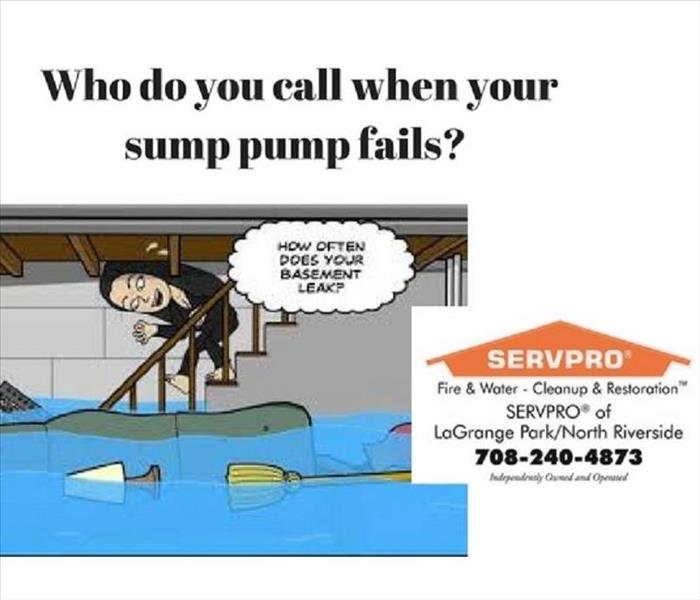 It doesn’t take a huge flood to cause thousands of dollars in damage.
It doesn’t take a huge flood to cause thousands of dollars in damage.
What is a sump pump? A sump pump is a pump used to remove water that has accumulated in a water-collecting sump basin, commonly found in the basement of homes. The majority of residential sump pumps will turn on automatically from a pressure sensor or float activator. The pressure sensor activates as water builds up and creates more pressure than air which prompts the pump to turn on. The float activator has a ball that floats on top of the water, moving the arm as the water level rises. Once the motor activates, the fan will begin to turn moving the water outside the basement.
The American Society of Home Inspectors actually did a study that showed more than 60% of American homes suffer from underground wetness or water damage. It doesn’t take a huge flood to cause thousands of dollars in damage. It takes very little standing water and very little time for mold and mildew to take over and create problems.
If you have water damage to your home due to a failure with your sump pump, give SERVPRO of LaGrange Park/ North Riverside a call at 708-240-4873. We are always here to help!
How To Prevent Mold In Your Bathroom
6/12/2017 (Permalink)
The bathroom is a very common place in your home that can have mold growth. This is the one room that has the most moisture content at any given time. Without proper ventilation, and clean up after a shower, it is very easy for mold to grow.
According to the website family handyman, the following are the best tips to prevent mold growth in your bathroom.
- First, after a bath or a shower, squeegee water off the shower walls. ...
- Second, run your bath fans during your bath or shower and for a half hour after to flush out moisture. ...
- Third, if you have tile, seal the grout lines annually with a standard grout sealer to waterproof them.
If you are having issues with mold growth in your home or commercial property, SERVPRO of LaGrange Park/North Riverside is here to help. Give us a call at 708-240-4873.
What Causes A Sewer Back Up?
6/12/2017 (Permalink)
Sewage back ups are very unfortunate events that can happen in any home or commercial property. What causes this type of water damage anyway? Well, typically there are three main categories that a sewer back up happens: damaged sewer pipes, clogs, and tree roots in the sewer system. Let's look at these three areas a bit closer.
- Clogging: Typically if you only have one area of your home that experiences a backup, like a tub or a sink, then there is typically a clog and can be fixed with cleaning the drain. However, if you have the backup in several areas of your home, then there is a blockage at the main or the private that is causing the issue. Unless the blockage is removed, the overflow will continue and will damage your entire home or business area.
- Tree Roots: The roots of large trees in the proximity of a sewer line can often cause severe problems. They can literally grow into the pipes and cause holes and blockages or they may wrap around the sewer line and crush it.
- Damaged Sewer Lines: Older properties with older sewer lines that have not been upgraded can have broken or collapsed lines. All the pipes and sewers in older homes were built using cast iron and clay which can wear off with time, get rusty, and easily break down. Present day plastic sewer lines cannot cause such problems simply because they don’t rust.
Sewage backups are not only hazardous to your health, but they can cause a great amount of structural damage to your home. If you experience a sewage back up do not attempt to flush the toilet. Do not use harsh chemicals to attempt to clean out the drain. This can actually cause more damage and make things worse. Open your windows to let fresh air in. It is also very important to keep pets and children away from the affected area. However, the most important thing to do, is to call for professional help.
SERVPRO of LaGrange Park/North Riverside is here to help with all your water damage needs. We are open 24/7/365 to help. Call us at 708-240-4873.
When Your Commercial Property Has Damage, Who Do You Trust?
6/12/2017 (Permalink)
There are over seven million small businesses in the U.S., ranging from construction firms to grocery stores to home-based businesses. According to the U.S. Small Business Administration, as many as one in four businesses that suffer some kind of major disaster do not reopen afterward.
According to the National Fire Prevention Association, U.S. fire departments responded to about 3,300 office property fires per year between 2007 and 2011. Those fires resulted in about $112 million in property damage each year, and most were in business offices, and happened during business hours. 90% of fires were large enough to activate sprinklers, which were effective 88% of the time.
The NFPA also has statistics specific to manufacturing facilities. According to their research, there are about 37,000 fires at industrial or manufacturing facilities each year, resulting in 18 deaths, 279 injuries, and $1 billion in property damage. Heating equipment and stop tools were the leading cause, sparking 28 percent of the fires. Mechanical failure or malfunction caused 24 percent of the fires.
If your commercial property has experience a fire, and or water damage, ever minute you are offline is money down the drain. Call SERVPRO of LaGrange Park/North Riverside to get your business back up and running.
What Happens To Drywall When It Gets Wet?
6/12/2017 (Permalink)
Wet walls and insulation will hold moisture for a long time. This means that mold can form inside the wall. If your drywall has started to mold, you will need to replace all or part of it. It may lose its structural integrity, becoming soft and weak. mold begins to grow in 24 to 48 hours. The key to not having your wet drywall mold, is speedy drying. While drywall is pretty sturdy, when it’s exposed to water for too long it can get damaged and will require replacement.
If you have experienced water damage to your home, SERVPRO of LaGrange Park/North Riverside is here to make it "Like it never even happened" Give us a call at 708-240-4873 for all your restoration needs.
Fire Safety for kids
6/9/2017 (Permalink)
Would you know what to do if a fire started in your home? Would your kids? According to NFPA, in 2013, 334 children died in home fires. Eighty-seven percent of all fire-related deaths are due to home fires, which spread rapidly and can leave families as little as two minutes to escape once an alarm sounds. Fires are not just a problem in the United States. In 2008, nearly 61,000 children around the world died due to a fire or burn.
Kids Health has some great tips for parents to review with their families about fire safety.
- Working smoke alarms reduce the chances of dying in a fire by nearly 50 percent. They are a critical first step for staying safe, but in order to be effective, they have to be working properly. For the best protection, install smoke alarms on every level of your home and in every sleeping area.
- Teach kids never to play with matches and lighters. Make a habit of placing these items up and away from young children.
- Create and practice a home fire escape plan with two ways out of every room in case of a fire. Get a stopwatch and time how fast your family can escape. The kids will love it.
- Children should know how to respond to the sound of a smoke alarm. Teach them to get low and get out when they hear it. A child who is coached properly ahead of time will have a better chance to be safe.
- Use common sense in the kitchen. Limit distractions when cooking and don’t leave a hot oven or stove top unattended.
- Blow out candles before you leave the room or before you go to sleep.
In the event of a fire in your home, follow these safety tips to keep your family safe. Then after all family members are taken care of, and the fire department has cleared your home, call SERVPRO of LaGrange Park/North Riverside at 708-240-4873. We are always here to help!
Know When To Stop Drop and Roll
6/9/2017 (Permalink)
"Stop, drop, and roll” is used when clothing catches fire. It is very important we teach our children the dangers of fire, and what to do if an article of their clothing catches on fire.
The NFPA, teaches the following method:
-Stop where you are.
- Drop to the ground and cover your eyes and mouth with your hands.
- Roll over and over and back and forth until the flames are out.
- Get help from a grown-up who will cool the burn and get medical help.
The NFPA also emphasizes that we need to teach our children DO NOT RUN!
eMediaWorks also has a wonderful video that you can show your children to teach them how to "Stop, Drop, & Roll". Please watch this video with your family, and educate them on the importance of fire safety Stop, Drop, and Roll.
SERVPRO of LaGrange Park/North Riverside is always here to help. If you have a fire in your home of business give us a call at 708-240-4873.
Tornadoes Fact and Fiction
6/7/2017 (Permalink)
The Websters Dictionary defines a tornado : "A tornado is as a rotating, funnel-shaped cloud that extends from a thunderstorm to the ground with whirling winds that can reach 300 mph. Damage paths of tornadoes can be in excess of one mile wide and 50 miles long."
According to the study done by The Weather Channel. Each year in the U.S., 1,200 tornadoes on average kill 60 people, injure 1,500, and cause roughly $400 million in damages, putting long-term average tornado losses on par with hurricanes.
There are many misconceptions in regards to tornadoes. Here are some facts from tornadofacts.net
<h2myths">Tornado Safety Related Myths
- Southwest corner of your home/building/shelter is the safest location - In 1887 John P. Finley wrote a book on his observations of his tornado research. While he published some ground breaking information on tornadoes he also helped created this tornadoes myth. John believed that tornadoes only traveled in a northeast direction and that derby they created would be carried in the direction of its propagation. The 1997 F5 Jarrell tornado is a prime example of his misconceptions since that tornado moved in a south-southwesterly direction. It's recommended that you always seek shelter in the lowest floor of a building, preferably under an I-beam or staircase, regardless of the type of building you're in.
- Open all the windows in your home when a tornado warning is issued - This is an extremely dangerous myth because it takes away critical minutes that could be used to reach shelter. It used to be widely believed that you needed to open your windows during a tornado to equalize pressure and prevent your house from exploding. A violent tornado will only have a 10% drop in pressure which isn't anywhere near enough to cause your home to explode. Ignore your windows and seek shelter immediately when a tornado warning is issued.
- A highway overpass is an excellent tornado shelter - This myth gained huge traction in 1991 when a TV crew survived a tornado unharmed by sheltering under a overpass in El Dorado, KS. This event had nationwide coverage with video of the event and that helped perpetuate this myth to a dangerously high status. The conclusion for scientific evidence from the Oklahoma outbreak in 1999 actual proved that overpasses are actually one of the worst places to seek shelter during a violent tornado; mostly due to the wind tunnel effect that can accelerate flying derby speed even during weak tornadoes.
- You can outrun a tornado via a vehicle - The theory behind this myth is a vehicle can travel faster than the average tornado, but the key phrase is average. There is no way for someone to know the travel and wind speed of a tornado just by looking at it. Plus the flooding, hail, and flying derby from a tornado can put someone in a vehicle in danger. The official directive from the National Weather Service is if you spot a tornado nearby to abandon your vehicle and seek shelter in a nearby building, culvert or ditch.
- A brick or stone building can protect me from a tornado - While a brick or stone building can provide better protection during tornado a violent only can easily turn a brick or stone building into a pile of rubble. It's recommended that you always seek shelter in the lowest floor of a building, preferably under an I-beam or staircase, regardless of the type of building you're in.
- If a tornado isn't coming directly towards me I'm safe - In the past it was common belief that a tornado would only travel in a northeasterly direction. While it's true that most tornadoes will move northeast this is most due to the direction the storm is traveling. Tornadoes are erratic, unpredictable, and can come from any direction. A prime example is the 1997 F5 tornadoes that struck Jarrell, TX which traveled southwest.
When a major storm hits, it may overwhelm local restoration companies. SERVPRO of La Grange Park / North Riverside can scale our resources by accessing the equipment and personnel of 1,700 Franchises. We can also access Disaster Recovery Teams that specialize in major storms and catastrophic events.
50 % of Commercial Properties Do Not Reopen After A Disaster
6/6/2017 (Permalink)
Disasters strike everyday, and 50% of commercial properties do not reopen afterwards. Is your commercial property ready? If you have a pipe break or a malfunction with your sprinkler system, do you know who to call for the water damage? If you have a fire, who do you call after the fire department leaves? SERVPRO of LaGrange Park/North Riverside, that's who. There is no job too big for SERVPRO. We specialize in flooding and storm damage restoration, the cornerstone of our business. We have extensive water damage and storm restoration training that allows us to get your home back to normal quickly.
La Grange Park, IL Flooding and Storm Damage Cleanup and Restoration | SERVPRO of La Grange Park / North Riverside
When a major storm hits, it may overwhelm local restoration companies. SERVPRO of La Grange Park / North Riverside can scale our resources by accessing the equipment and personnel of 1,700 Franchises.
Facts about Flooding
6/6/2017 (Permalink)
Every year, every state in the us is affected by flash floods. Floods are the number one, weather related killer in the US as well.
According to The Weather Channel,
"A Flood (commonly called river flood) is a high flow or overflow of water from a river or similar body of water, occurring over a period of time too long to be considered a flash flood.
Flooding is caused in a variety of ways. Winter or spring rains, coupled with melting snows, can fill river basins too quickly. Torrential rains from decaying hurricanes or other tropical systems can also produce river flooding. The Mississippi River Flood of 1993 was caused by repeated heavy rain from thunderstorms over a period of weeks.
Flash Floods are quick-rising floods usually occurring as the result of heavy rains over a short period of time, often only several hours or even less.
They can also be caused by ice jams on rivers in conjunction with a winter or spring thaw, or occasionally even a dam break. The constant influx of water finally causes a treacherous overflow to begin, powerful enough to sweep vehicles away, roll boulders into roadways, uproot trees, level buildings, and drag bridges off their piers. Most frightening is the rapidity with which the water rises.
Coastal Flooding occurs when strong onshore winds push water from an ocean, bay or inlet onto land. This can take the form of storm surges associated with tropical storms and hurricanes, or can be associated with non-tropical storms such as "nor'easters."
SERVPRO of LaGrange Park/North Riverside specializes in flooding and storm damage restoration, the cornerstone of our business. We have extensive water damage and storm restoration training that allows us to get your home back to normal quickly.
Tornadoes, Hurricanes, & Floods, Oh My!
6/6/2017 (Permalink)
As we enter the busy storm season, we want you to know that SERVPRO of LaGrange Park/North Riverside has your recovery in our best interest. We strive to do what is needed and necessary to help bring you and your family back together in the safety of your home. There is no job too big or too small that SERVPRO of LaGrange Park/North Riverside will not be there to help. La Grange Park, IL Flooding and Storm Damage Cleanup and Restoration | SERVPRO of La Grange Park / North Riverside
When a major storm hits, it may overwhelm local restoration companies. SERVPRO of La Grange Park / North Riverside can scale our resources by accessing the equipment and personnel of 1,700 Franchises. We can also access Disaster Recovery Teams that specialize in major storms and catastrophic events.
Importance of gutter maintenance
6/5/2017 (Permalink)
According to our friends at Farmers Insurance, "Cleaning out your gutters is very important. If you’re seeing lots of leaves, birds’ nests, sticks, and whatnot up there, your gutters may not be doing the job you hired them for. And on a rainy day, a clogged gutter can send water spilling into your home’s foundation, through the roof, or down to your basement. That could cause some serious water damage! So next time you’re doing some seasonal cleaning, make sure those gutters are clean. And if your gutters are too high, be safe and get a professional to check them."
Fortunately, gutter cleaning usually is a job you can do yourself, and most homes require only twice-yearly cleanings. Clogged, overflowing gutters can be worse than no gutters at all. They can lead to wet basements, rot and leaks at your roof's edge, and damaged siding. If climbing ladders isn't a safe or comfortable choice for you, call a professional. Your homeowners association (if you have one) can likely offer a referral, and many window washers provide gutter cleaning, too.
If you have water damage in your home or commercial property, give us a call at 708-240-4873. We are always here to help!
Summer Fire Safety Tips
6/1/2017 (Permalink)
Summer is here, and for many of us that means s'mores roasting on the fire pit, and supper cooking on the BBQ grill. However, it should also mean that we are taking a look at some summer time fire safety as well.
The American Red Cross has some simple safety tips for every family to consider:
- Always supervise a barbecue grill when in use.
You don’t want to burn that cheeseburger that’s waiting for you!
- Never grill indoors – not in the house, camper, tent, or any enclosed area.
Take advantage of the beautiful weather and cook outside.
- Make sure everyone, including the pets, stays away from the grill.
Your guests might be hungry but they still have to wait until the food is off the grill to get their hands on it!
- Keep the grill out in the open, away from the house, the deck, tree branches, or anything that could catch fire.
Keep the party going and use these safety precautions while cooking.
- Use the long-handled tools especially made for cooking on the grill to keep the chef safe.
Provide the chef with the right tools to keep their hands safe so they can participate in the post-barbecue volleyball game.
Here's to a safe and happy summer from your friends at SERVPRO of LaGrange Park/North Riverside.
What Mold Needs To Grow
6/1/2017 (Permalink)
According to the Healthy Indoor Air Research Center at the University of Illinois, "Mold spores are everywhere, and they grow on any organic surface, given the right conditions. For growth, they require organic matter for food, moisture, warmth, and oxygen. To prevent mold growth, keep all surfaces clean and dry, and provide plenty of ventilation."
Mold spores need moist or damp areas to grow and reproduce. Watch for flooding, leaky pipes or windows, etc. Also excess moisture in the bathrooms, kitchens, and laundry rooms are prime areas for mold growth.
Mold spores need food – in the literal sense as well as other materials
Mold spores thrive in temperatures 32 and 120 degrees Fahrenheit. Temperatures from about 70 – 90 degrees are the most conducive for mold growth. Chances of mold growth are heightened greatly between those temperatures.
Favorable Conditions for Mold
Michael Pugliese, author of The Homeowner’s Guide to Mold, also offers 3 tips describing favorable conditions for mold growth:
- A relative Humidity of roughly 50% or higher
A good preventative measure would be to purchase a hygrometer to measure humidity levels in your home.
Avoid developing piles of rags, clothing or other mold food sources.
This explains why overly “tight” homes designed for energy efficiency can have mold problems.
If you have mold in your home, please give SERVPRO of LaGrange Park/North Riverside a call at 708-240-4873.
Is efflorescence a health risk?
6/1/2017 (Permalink)
According to The Masonry Institute of America, Efflorescence is the white chalky powder that you might find on the surface of a concrete or brick wall. It can be a cosmetic issue, or it can be an indication of moisture intrusion that could lead to major structural and indoor air quality issues. Efflorescence (which means "to flower out" in French) is the dissolved salts deposited on the surface of a porous material hat are visible after the evaporation of the water.
Porous materials like brick, stone, concrete, and wood have the ability to wick up water. If the water that contains salt, once the water evaporates from the building materials it leaves behind efflorescence.
Efflorescence can often be confused with mold. However, not to worry, this is not something that is toxic or harmful.
The best way to remove efflorescence, is by acid washing the area. After the wash is complete, neutralize the area with baking soda. You want to make sure to neutralize the area because acid residue can be harmful to plants and animals.
If you have efflorescence that you would like to have looked at, and cleaned up we are here to help. Give us a call at 708-240-4873.
What happens after your Chicago area fire?
6/1/2017 (Permalink)
We all know that for an emergency you call 911, but what happens after the fire department leaves and you have a damaged home or business? You call SERVPRO of LaGrange Park/North Riverside, that's what you do! We are here to help you 24/7/365. Give us a call at 708-240-4873 for all your fire and water emergency needs.
Fires can leave behind soot and smoke that needs to be cleaned. SERVPRO of LaGrange Park/North Riverside is here to help! Cleaning up after soot and smoke is no small task, but our trained staff will be able to clean your home or commercial property and return it to you just "Like it never even happened." We are here to help 24/7/365 for all your restoration needs.
SERVPRO of LaGrange Park/North Riverside Fire Continuing Education Class
5/31/2017 (Permalink)
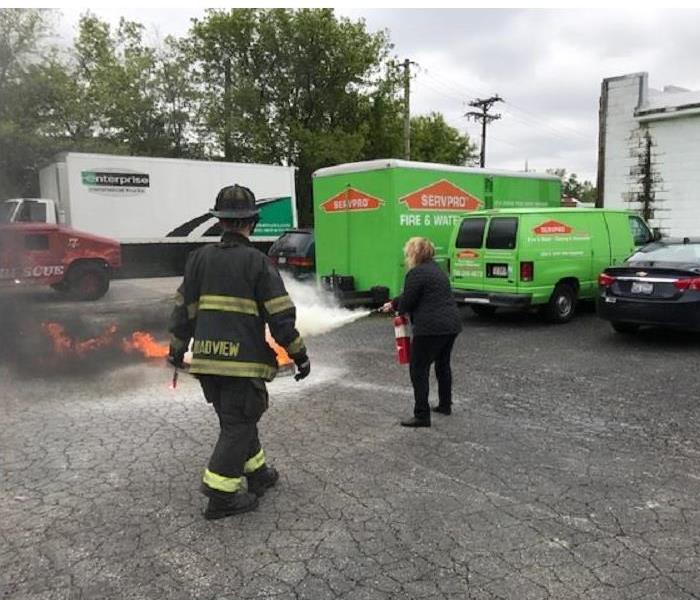 Fire Inspector, Anthony Monks provides hands on training for fire extinguishers and their proper use.
Fire Inspector, Anthony Monks provides hands on training for fire extinguishers and their proper use.
On May 24, 2017 SERVPRO of LaGrange Park/North Riverside hosted a continuing education class for our insurance agents on fire damage to home and commercial properties.
The Broadview Fire Department was also onsite to give a demonstration on fire extinguishers and their proper use. Fire Inspector, Anthony Monks, did an amazing job with the hands on demonstration. Each agent had the opportunity to put out a fire that was closely monitored by the fire inspector.
Like us on Facebook for more pictures and video from this class and all our other activities:
https://www.facebook.com/SPLagrangePKNRiverside/?pnref=lhc
If you have a fire in your home, remember to call SERVPRO of LaGrange Park/North Riverside at 708-240-4873. We are "Faster to Any Size Disaster"!
Hurricane Preparation
5/30/2017 (Permalink)
88% of deaths from hurricanes and tropical storms are due to the water, not wind according to The Weather Channel. According to the National Hurricane Center, storm surge, rainfall flooding, high surf, and deaths just offshore (within 50 nautical miles of the coast) combined for 88 percent of all deaths in the U.S. from hurricanes, tropical storms or tropical depressions from 1963 to 2012. The storm surge, the rise in water levels from the tropical winds piling water toward the coast just before and during landfall.is considered the most deadly part of a hurricane.
Knowing that the water is the most dangerous part of the hurricane, we encourage you to create a plan and share the plan with your family. Here are some tips from ready.gov:
Prepare
- Talk About Hurricanes —Spend time with your family discussing why hurricanes occur. Explain that a hurricane is a natural event and not anyone’s fault. Use simple words that even young children can understand.
- Know Your Risk —Find out if you live in a hurricane evacuation area. Assess your risks from a storm surge, flooding or wind damage that may accompany a hurricane.
- Practice Evacuation Drills — Practice your family evacuation plan so that, during an emergency, you can evacuate quickly and safely.
- Learn Your Caregivers' Disaster Plan — If your child’s school or child care center is in an area at risk from hurricanes, find out how its emergency plans address hurricanes. Ask about evacuation plans and if you would be required to pick up your children from the site or from another location.
- Stay Informed — Use a NOAA Weather Radio or listen to a local station on a portable, battery-powered radio or television. Be ready to act if a Hurricane Warning is issued.
During a Hurricane
- Evacuate If Instructed To Do So —Evacuate if told to do so by local authorities or if you feel unsafe. If advised to evacuate, avoid flooded roads and watch for washed-out bridges. Local officials may close certain roads, especially near the coast, when effects of the hurricane reach the coast.
- Stay Indoors, If Not Evacuated — If you are not advised to evacuate, or are unable to do so safely, stay indoors, away from windows, skylights and doors. Continue to monitor weather reports and do not go outside until the storm has passed.
After a Hurricane
- Return Home Only When Authorities indicate It’s Safe — Listen for updates and instructions from local officials.
- Avoid Flood Waters — Water may be electrically charged from downed or underground lines. Avoid walking and driving through flood waters as well due to the fact just 6 inches of moving water is enough to knock you down. Fast moving water can also sweep your car away in the flow of the stream.
- Photograph The Damage To Your Property — By photographing your property, you can help assist with your insurance claim. This also helps assist the adjustor assigned to your claim to determine the coverage to your loss.
Hurricanes are a very serious, and can be deadly. SERVPRO of LaGrange Park/North Riverside would like to encourage you to make a family plan to keep your loved ones safe.
Does Your Home Have A Mold Problem?
5/30/2017 (Permalink)
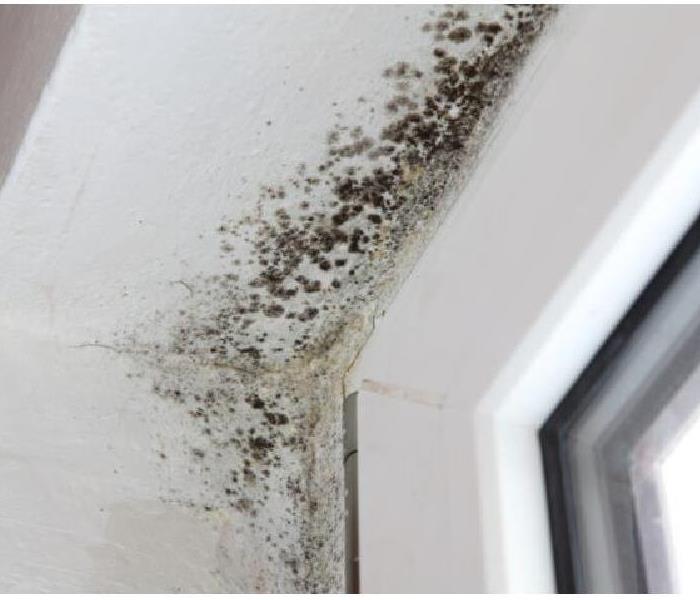 Mold can spread through a home in as little as 48 hours.
Mold can spread through a home in as little as 48 hours.
Microscopic mold spores naturally occur almost everywhere, both outdoors and indoors. This makes it impossible to remove all mold from a home or business. Therefore, mold remediation reduces the mold spore count back to its natural or baseline level. Some restoration businesses advertise “mold removal” and even guarantee to remove all mold, which is a fallacy. Consider the following mold facts:
- Mold is present almost everywhere, indoors and outdoors.
- Mold spores are microscopic and float along in the air and may enter your home through windows, doors, or AC/heating systems or even hitch a ride indoors on your clothing or a pet.
- Mold spores thrive on moisture. Mold spores can quickly grow into colonies when exposed to water. These colonies may produce allergens and irritants.
- Before mold remediation can begin, any sources of water or moisture must be addressed. Otherwise, the mold may return.
- Mold often produces a strong, musty odor and can lead you to possible mold problem areas.
- Even higher-than-normal indoor humidity can support mold growth. Keep indoor humidity below 45 percent.
If your home or business has a mold problem, we can inspect and assess your property and use our specialized training, equipment, and expertise to remediate your mold infestation.
If You See Signs of Mold, Call Us Today – 708-240-4873.
Smoke and Soot Cleanup
5/30/2017 (Permalink)
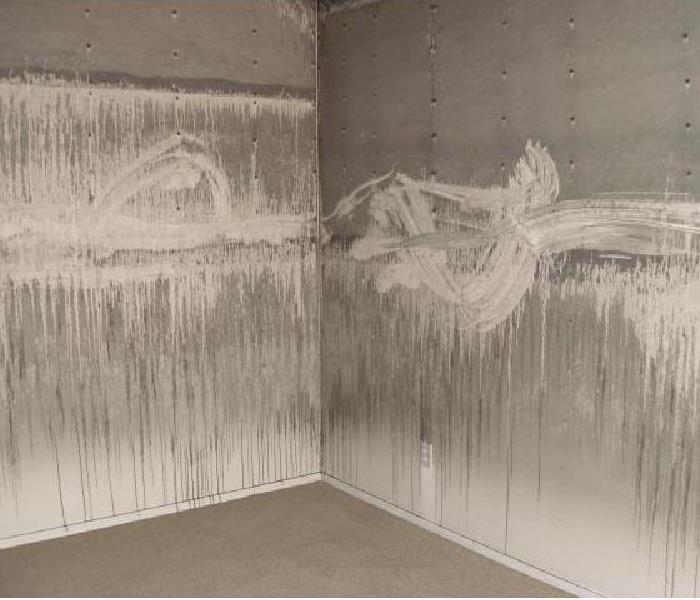 Smoke and Soot Damage Can Cause a Pervasive Odor in Your Home.
Smoke and Soot Damage Can Cause a Pervasive Odor in Your Home.
Smoke and soot is very invasive and can penetrate various cavities within your home, causing hidden damage and odor. Our smoke damage expertise and experience allows us to inspect and accurately assess the extent of the damage to develop a comprehensive plan of action.
Smoke and soot facts:
- Hot smoke migrates to cooler areas and upper levels of a structure.
- Smoke flows around plumbing systems, seeping through the holes used by pipes to go from floor to floor.
- The type of smoke may greatly affect the restoration process.
Different Types of Smoke
There are two different types of smoke–wet and dry. As a result, there are different types of soot residue after a fire. Before restoration begins, SERVPRO of LaGrange Park/North Riverside will test the soot to determine which type of smoke damage occurred. The cleaning procedures will then be based on the information identified during pretesting. Here is some additional information:
Wet Smoke – Plastic and Rubber
- Low heat, smoldering, pungent odor, sticky, smeary. Smoke webs are more difficult to clean.
Dry Smoke – Paper and Wood
- Fast burning, high temperatures, heat rises therefore smoke rises.
Protein Fire Residue – Produced by evaporation of material rather than from a fire
- Virtually invisible, discolors paints and varnishes, extreme pungent odor.
Our Fire Damage Restoration Services
Since each smoke and fire damage situation is a little different, each one requires a unique solution tailored for the specific conditions. We have the equipment, expertise, and experience to restore your fire and smoke damage. We will also treat your family with empathy and respect and your property with care.
Have Questions about Fire, Smoke, or Soot Damage?
Call Us Today – 708-240-4873.
Is your commercial property ready for whatever happens?
5/5/2017 (Permalink)
According to the U.S. Small Business Administration, as many as one in four businesses that suffer some kind of major disaster do not reopen afterward. According to the National Fire Prevention Association, U.S. fire departments responded to about 3,300 office property fires per year between 2007 and 2015. Those fires resulted in about $112 million in property damage each year, and most were in business offices.
The NFPA also has statistics specific to manufacturing facilities. According to their research, there are about 37,000 fires at industrial or manufacturing facilities each year, resulting in 18 deaths, 279 injuries, and $1 billion in property damage. Heating equipment and stop tools were the leading cause sparking 28 percent of the fires. Mechanical failure or malfunction caused 24 percent of the fires.
Floods are the #1 natural disaster in the United States. Every business in every state is at risk of water damage from floods. In the past 3 years all 50 states have experienced flash flooding causing damage to businesses as well as homes.
We offer an Emergency Readiness Plan that literally puts getting help after a fire or water damage at your finger tips. The Ready Plan is an emergency preparedness tool for home and business owners, property managers, risk managers and facility management. It allows for the creation of an Emergency Ready Profile™ containing critical facility information to help speed up response time.
You need a restoration company that is going to not only help you get your company back on their feet, but also work with your insurance company. SERVPRO of LaGrange Park/North Riverside is here for your business and commercial property. We are here to help! Call us today at 708-240-4876 to discuss all your fire and water restoration needs or to create an Emergency Readiness Plan for your business.
How to clean up after exposure to MRSA
3/27/2017 (Permalink)
Let’s start off with the question, what is MRSA? According to Mayo Clinic, it is an infection caused by a type of staph bacteria that's become resistant to many of the antibiotics used to treat ordinary staph infections. There are two distinct types of MRSA, HA-MRSA and CA-MRSA.
HA-MRSA occur in people who have been in a hospital setting, nursing home, or dialysis centers. HA-MRSA is typically found in those patients that have undergone an invasive procedure, had artificial joints implanted, or have intravenous tubing. Hospitalized patients taking antibiotics that lower the normal flora levels gives the MRSA virus the advantage. Whereas patients in hospitals have breaks in their skin (surgical wounds, intravenous lines (IVs), and catheters) that can allow bacteria to enter underlying tissues or the bloodstream, according to MN Health Department.
CA-MRSA is occurs in the general healthy public, and often begins as a painful skin boil. According to the Mayo Clinic, it is spread by skin-to-skin contact. At-risk populations include groups such as high school wrestlers, child care workers and people who live in crowded conditions. Studies done at Mayo Clinic found that those with CA-MRSA tend to be younger, school aged patients.
Cleaning up after MRSA, the EPA has found that spraying or fogging rooms or surfaces with disinfectants will prevent MRSA infections more effectively than the targeted approach of cleaning frequently touched surfaces and any surfaces that have been exposed to infections. “Shared equipment that comes into direct skin contact should be cleaned after each use and allowed to dry. Equipment, such as helmets and protective gear, should be cleaned according to the equipment manufacturers’ instructions to make sure the cleaner will not harm the item.” Center of Disease Control
Laundry items should be washed on very hot temperatures. Bleach should also be used if possible. These items should also be laundered separately to keep the infection for spreading. The CDC recommends washing bed linens daily until the infection is gone. Avoiding having someone in bed with the infected person will also lower the chance of the infection spreading.
The best way to prevent the spread of MRSA is to have all affected areas cleaned. Prevention for HA-MRSA, according to the Mayo Clinic, the patients are quarantined, visitors and staff are required to wear protective garments and must follow strict hand hygiene procedures. Contaminated surfaces and laundry items are to be properly disinfected daily.
Those that come in contact with HA-MRSA, according to the CDC can do the following to prevent the spread of the infection:
- Wash your hands. Careful hand washing remains your best defense against germs. Scrub hands briskly for at least 15 seconds, then dry them with a disposable towel and use another towel to turn off the faucet. Carry a small bottle of hand sanitizer containing at least 62 percent alcohol for times when you don't have access to soap and water.
- Keep wounds covered.Keep cuts and abrasions clean and covered with sterile, dry bandages until they heal. The pus from infected sores may contain MRSA, and keeping wounds covered will help prevent the bacteria from spreading.
- Keep personal items personal.Avoid sharing personal items such as towels, sheets, razors, clothing and athletic equipment. MRSA spreads on contaminated objects as well as through direct contact.
- Shower after athletic games or practices.Shower immediately after each game or practice. Use soap and water. Don't share towels.
- Sanitize linens.If you have a cut or sore, wash towels and bed linens in a washing machine set to the hottest water setting (with added bleach, if possible) and dry them in a hot dryer. Wash gym and athletic clothes after each wearing.
SERVPRO of LaGrange Park/North Riverside provides cleaning at schools for mats, helmets, and other sports equipment that are often forgotten to sanitize. We also can come into your home and do a deep clean, sanitize, and fogging of all affected areas that may have come into contact with MRSA infection. Give us a call at 708-240-4873, and we will be happy to discuss how we can assist in your home, school, or business.
Things you should know about mold
1/27/2017 (Permalink)
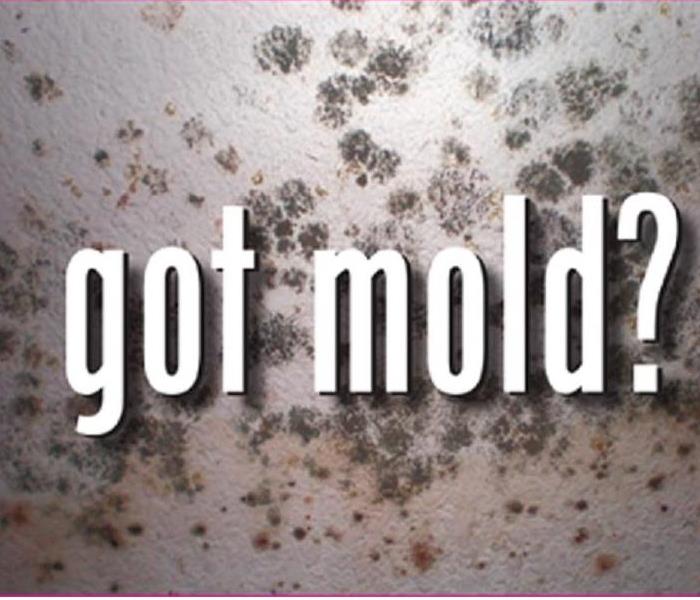
According to the EPA the ten things you should know about mold:
1. Potential health effects and symptoms associated with mold exposures include allergic reactions, asthma and other respiratory complaints.
2. There is no practical way to eliminate all mold and mold spores in the indoor environment; the way to control indoor mold growth is to control moisture.
3. If mold is a problem in your home or school, you must clean up the mold and eliminate sources of moisture.
4. Fix the source of the water problem or leak to prevent mold growth.
5. Reduce indoor humidity (to 30-60%) to decrease mold growth by:
• Venting bathrooms, dryers and other moisture-generating sources to the outside
• Using air conditioners and de-humidifiers
• Increasing ventilation
• Using exhaust fans whenever cooking, dishwashing and cleaning
6. Clean and dry any damp or wet building materials and furnishings within 24-48 hours to prevent mold growth.
7. Clean mold off hard surfaces with water and detergent, and dry completely. Absorbent materials such as ceiling tiles, that are moldy, may need to be replaced.
8. Prevent condensation: Reduce the potential for condensation on cold surfaces (i.e., windows, piping, exterior walls, roof, or floors) by adding insulation.
9. In areas where there is a perpetual moisture problem, do not install carpeting (i.e., by drinking fountains, by classroom sinks, or on concrete floors with leaks or frequent condensation).
10. Molds can be found almost anywhere; they can grow on virtually any substance, providing moisture is present. There are molds that can grow on wood, paper, carpet, and foods.
It is the water that you do not see that causes the most damage to your home and business. Water contains bacteria that can cause mold, rot, and other unseen damage.
Allergic reaction to mold are common, however, asthma attacks, skin and eye irritation, and coughing attacks are also common. Those with special health concerns should consult their doctor if they are concerned about mold exposure. Symptoms that may seem to occur from mold exposure may be due to other causes, such as bacterial or viral infections or other allergies.
In order to control mold, you have to control the moisture in a building. Once you detect water, acting promptly is the key to controlling mold. You need to get the water infiltration stopped and cleaned within 24-48 hours.
The IICRC (Institute of Inspection, Cleaning and Restoration Certification) gives several good tips on how to prevent mold.
• Repairing plumbing leaks and leaks in the building structure as soon as possible.
• Looking for condensation and wet spots. Fix source(s) of moisture incursion problem(s) as soon as possible.
• Preventing moisture from condensing by increasing surface temperature or reducing the moisture level in the air (humidity). To increase surface temperature, insulate or increase air circulation. To reduce the moisture level in the air, repair leaks, increase ventilation (if outside air is cold and dry), or dehumidify (if outdoor air is warm and humid).
• Keeping HVAC drip pans clean, flowing properly, and unobstructed.
• Performing regularly scheduled building/ HVAC inspections and maintenance, including filter changes.
• Maintaining indoor relative humidity below 70% (25 - 60%, if possible).
• Venting moisture-generating appliances, such as dryers, to the outside where possible.
• Venting kitchens (cooking areas) and bathrooms according to local code requirements.
• Cleaning and drying wet or damp spots as soon as possible, but no more than 48 hours after discovery.
• Providing adequate drainage around buildings and sloping the ground away from building foundations. Follow all local building codes.
• Pinpointing areas where leaks have occurred, identifying the causes, and taking preventive action to ensure that they do not reoccur.
It is impossible to rid your home or business of mold spores. Some mold spores can travel through the air and in dust, however if there is no moisture present, there can be no mold growth. Remember, if you clean up the mold, but do not fix the water problem, then the mold problem will continue to come back. That is where SERVPRO is here to help. Should you suspect mold in your home or business, contact our office at 708-240-4873.
Ice dam’s, what are they?
1/3/2017 (Permalink)
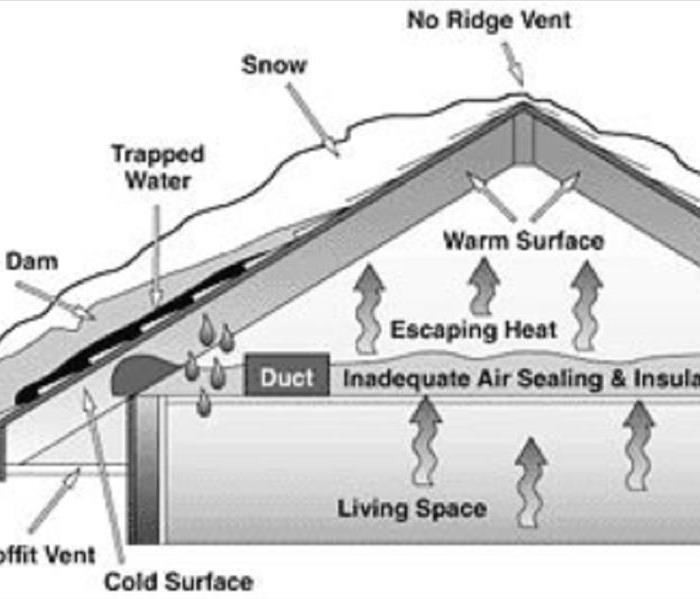 How ice dam's are formed.
How ice dam's are formed.
What is an ice dam?
An ice dam is a wall of ice that forms at the edge of the roof, typically at the gutters or soffit, and prevents melting snow from draining off.
What causes ice dams?
For an ice dam to form, 3 things must be present:
1) Snow on the roof
2) Higher portions of the roof’s external surface must be above 32°F
3) Lower surfaces must be below 32°F
So how do you fix an ice damn?
There are several fixes, but only 1 cure to fixing an ice damn: a combination of better sealing, insulation, and venting in the attic and eaves.
One way to fix an ice dam is to take a box fan into the attic and aim it at the underside of the roof where water is actively leaking in. This targeted dose of cold air will freeze the water. Seal all points where warm air leaks from the living space into the spaces immediately below the roof sheathing.
You can also purchase a roof rake and remove the snow from the front of your roof. This is a very good way to remove ice and snow if you live in a one story home. However, if the snow is heavy and wet, it can be difficult to remove the snow with the rake.
You can also insulate the living space well enough to prevent conduction and convection of heat through the ceiling
Safety, Safety, Safety
Hacking away at ice dams with a hammer, chisel, or shovel is bad for your roofing and dangerous for you. And throwing salt on them will do more to harm to your plantings than to the ice. Instead, tap lightly with a blunt mallet. This is slow, dangerous work, so hire someone experienced at roofing. Even if you do it safely, the chunks of ice can take pieces of shingle with them.
There is a cure for ice dam's:
1. Seal all points where warm air leaks from the living space into the spaces immediately below the roof sheathing.
2. Insulate the living space well enough to prevent conduction and convection of heat through the ceiling.
3. Vent the space between the insulation and the roof sheathing, so any heat that does leak through is carried away.
Remember, if an ice dam gets big enough, the water can back flow into your home. This can cause many different types of damage to your walls, ceilings, and insulation. If the ice dam gets too big it can also pull the shingles off the roof.
Should you find ice dam damage to your home, we are here to help. Give SERVPRO of LaGrange Park/North Riverside a call at 708-240-4873, and we will be happy to help with all your water damage needs.
Why clean your ducts?
12/13/2016 (Permalink)
Often people ask, why should we get our ducts clean? The simple answer is because they get dirty. When you consider the air ducts are the lungs of your home, it is necessary to do all you possibly can to keep your HVAC system running smoothly. One out of every six people who suffer from allergies does so because of the direct relationship to the fungi and bacteria in the air duct systems. (American Society of Heat, Ref., Ac. Engineers) Cleaning the air ducts in your home helps people with allergies, the elderly, young children, people with asthma, and people with other respiratory conditions breathe better. When you consider the dust, pet dander, smoke, mold, and even dust from work done in your home can be found in your duct work, keeping clean ducts are necessary for your health. Your HVAC system cycles all the air through your home 5-7 times per day. No wonder the ducts need cleaned!
The US Department of Energy states, 25 to 40 percent of the energy used for heating or cooling a home is wasted. Contaminants in the heating and cooling system cause it to work harder and shorten the life of your system. Although filters are used, the heating and cooling system still gets dirty through normal use. 90% of failed HVAC systems are caused by dust and dirt. The HAVAC Inspection, Cleaning, & Restoration Association says “When an HVAC system is clean, it doesn’t have to work as hard to maintain the temperature you desire. As a result, less energy is used, leading to improved cost-effectiveness”
Let SERVPRO of LaGrange Park/North Riverside help you protect your home, and your loved ones. Call us at 708-240-4873 to schedule your duct cleaning.
Frozen pipe prevention
12/12/2016 (Permalink)
Frozen pipes are a sure way to water damage in your home, but how do you prevent frozen pipes in the winter? Our friends at American Family Insurance share some great tips on keeping your pipes from freezing.
The best way to prevent your home’s pipes from freezing is to keep them from being exposed to the cold. Here’s how:
- Cover exposed pipes in crawl spaces or attics with insulation sleeves.
- Re-route pipes to an inside wall.
- Use caulking to seal cracks in the foundation or walls that let cold air in.
- Disconnect garden hoses and turn off the water supply to spigots.
- Keep cabinet doors open below your sinks to allow warm air in.
Other ways you can winterize your home from frozen pipes remove all the hoses from the outside water supply. Once you have drained and stored the hose away, open up the outside valve. This will allow the remaining water to drain and allows the pipe to expand without breaking. You should also consider a pipe sleeve to install over the outside water line to insulate and keep ice from forming.
The American Red Cross gives great ideas on preventative action during cold weather to consider to keep your pipes from freezing as well.
- Keep garage doors closed if there are water supply lines in the garage.
- Open kitchen and bathroom cabinet doors to allow warmer air to circulate around the plumbing. Be sure to move any harmful cleaners and household chemicals up out of the reach of children.
- When the weather is very cold outside, let the cold water drip from the faucet served by exposed pipes. Running water through the pipe - even at a trickle - helps prevent pipes from freezing.
- Keep the thermostat set to the same temperature both during the day and at night. By temporarily suspending the use of lower nighttime temperatures, you may incur a higher heating bill, but you can prevent a much more costly repair job if pipes freeze and burst.
- If you will be going away during cold weather, leave the heat on in your home, set to a temperature no lower than 55° F.
There are many way to keep your home safe from winter pipe breaks. Please feel free to reach out to SERVPRO of LaGrange Park/North Riverside at 708-240-4873 if you need any help with your home.
Tips for holiday fire safety
11/30/2016 (Permalink)
Per the National Fire Protection Association, nearly 47,000 fires occur during the winter holidays claiming more than 500 lives, causing more than 2,200 injuries, and costing $554 million in property damage. The National Fire Protection Association also states that on average, one of every 22 home fires started by Christmas trees result in death.
www.redcross.org/homefires, has several good home safety tips for the holidays to keep your home safe. We at SERVPRO LaGrange Park/North Riverside wanted to share some of those tips with you to ensure a safe holiday season.
- Place Christmas trees, candles, and other holiday decorations at least three feet away from heat sources like fireplaces, portable heaters, radiators, heat vents and candles.
- Purchase flame retardant metallic or artificial trees. If you purchase a real tree, make sure that it has fresh, green needles that aren’t easily broken. Keep live trees as moist as possible by giving them plenty of water.
- Make sure that light strings and other holiday decorations are in good condition. Do not use anything with frayed electrical cords and always follow the manufacturer’s instructions.
- Always unplug tree and holiday lights before leaving home or going to bed.
- Never use lit candles to decorate a tree. Always extinguish candles before leaving the room orgoing to bed.
- Use only sturdy tree stands designed not to tip over. Keep curious pets and children away from Christmas trees.
- Keep anything that can catch on fire—pot holders, oven mitts, wooden utensils, paper or plastic bags, food packaging, and towels or curtains—away from your stove top.
- Designate one person to walk around your home to make sure that all candles and smoking materials are properly extinguished after guests leave.
The following video also shares other great ideas to keep in mind this holiday season.
Holiday Fire Safety
Have a safe and wonderful holiday season from your friends at SERVPRO LaGrange Park/North Riverside






 24/7 Emergency Service
24/7 Emergency Service
